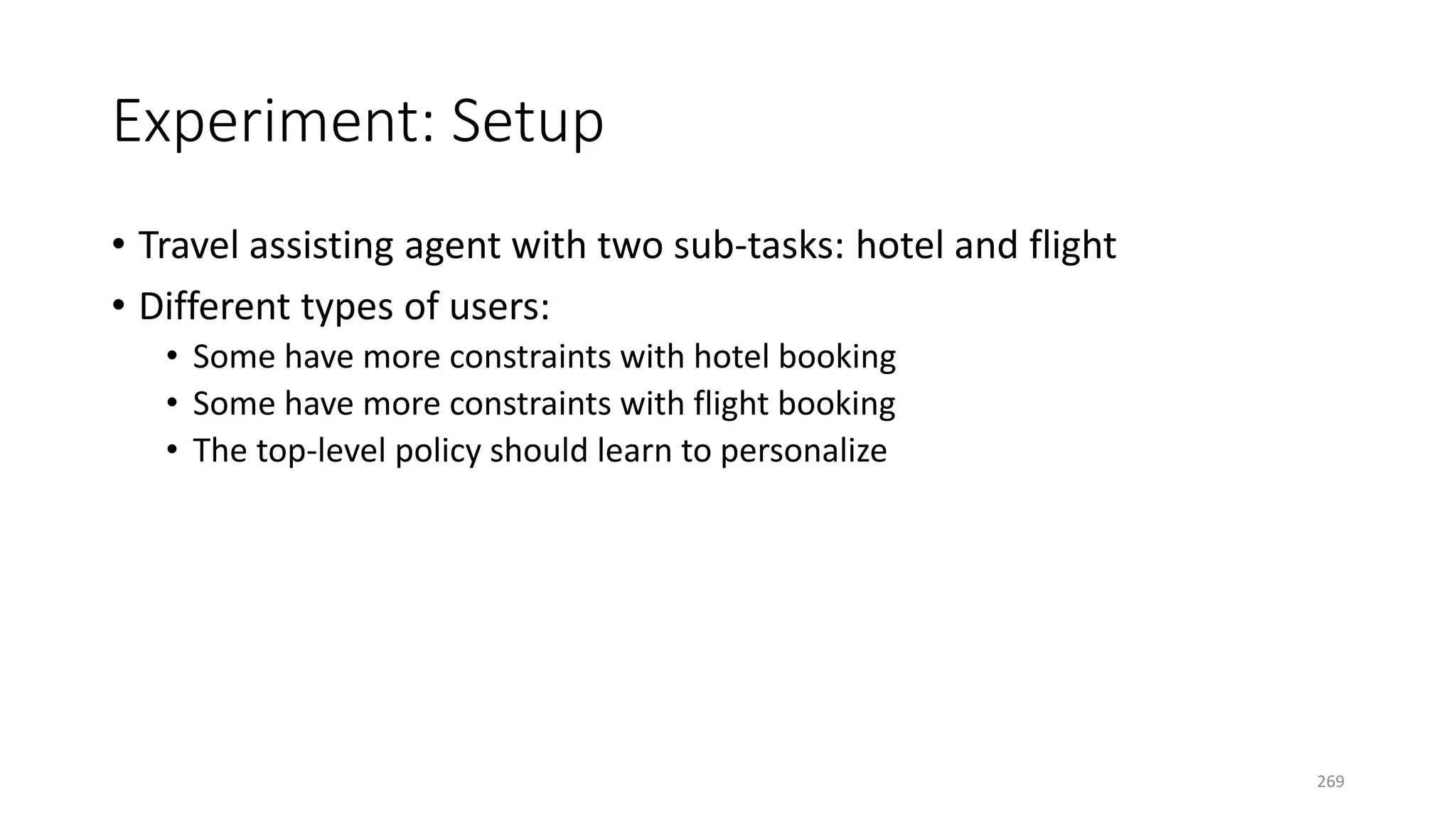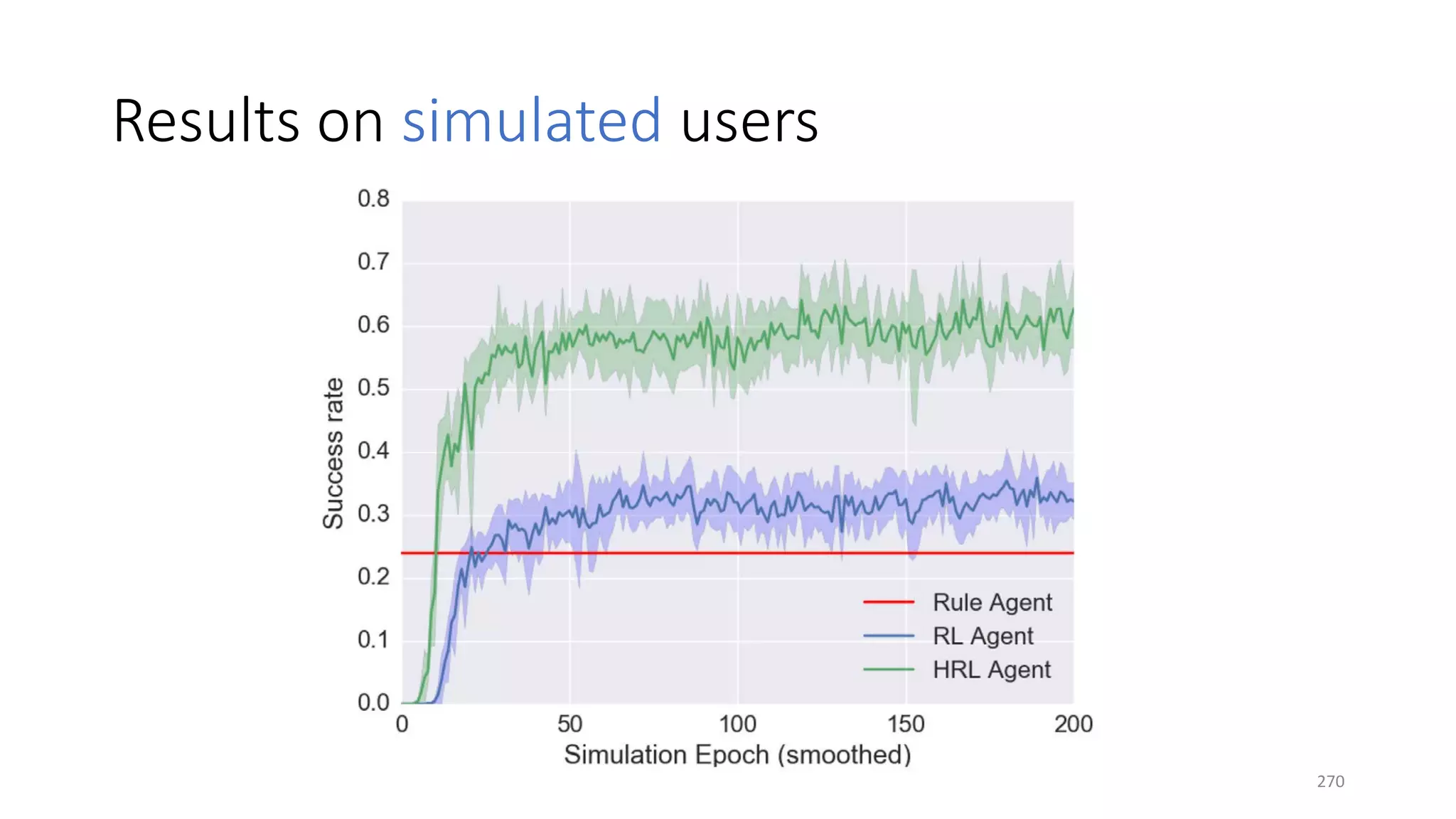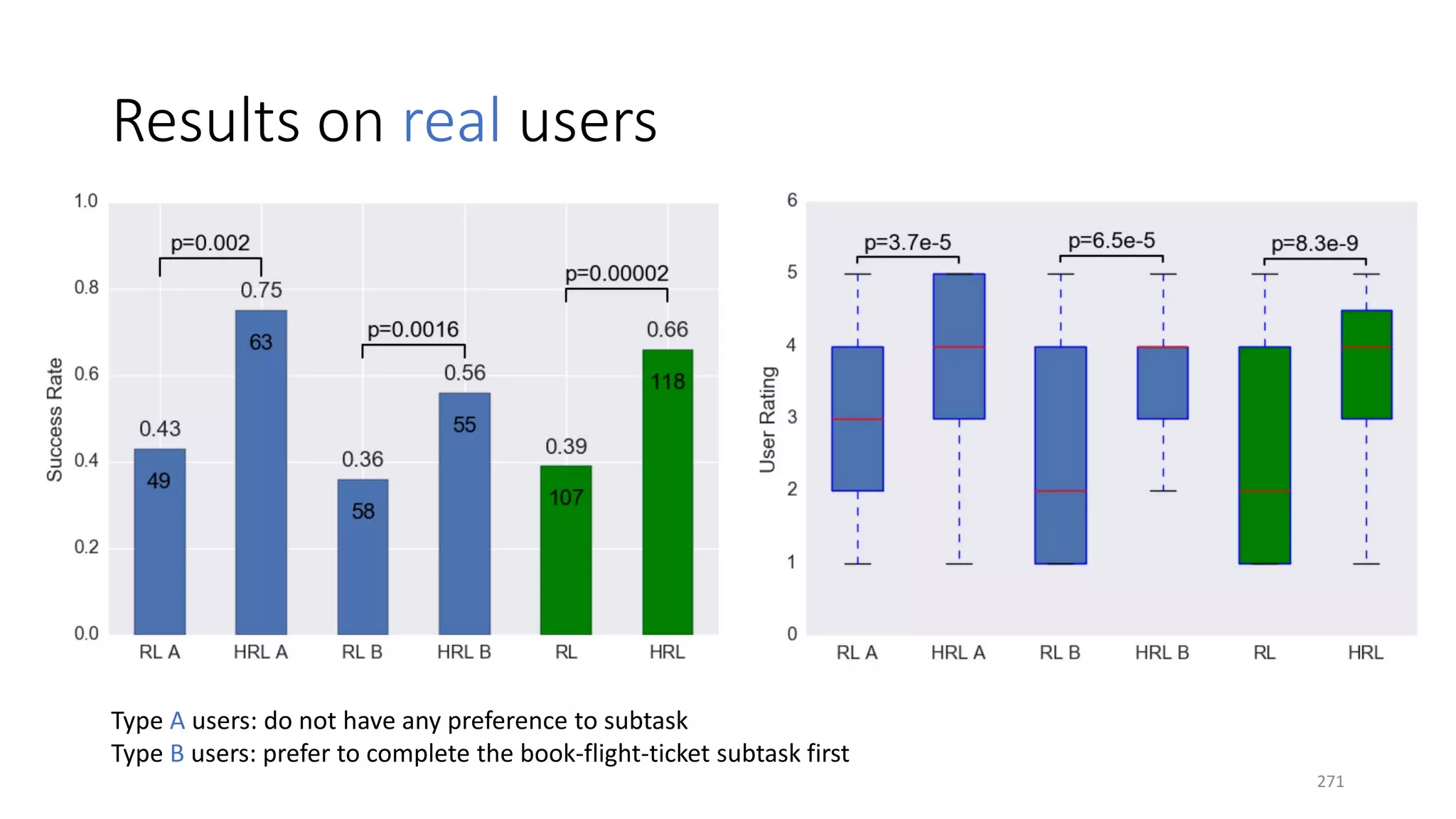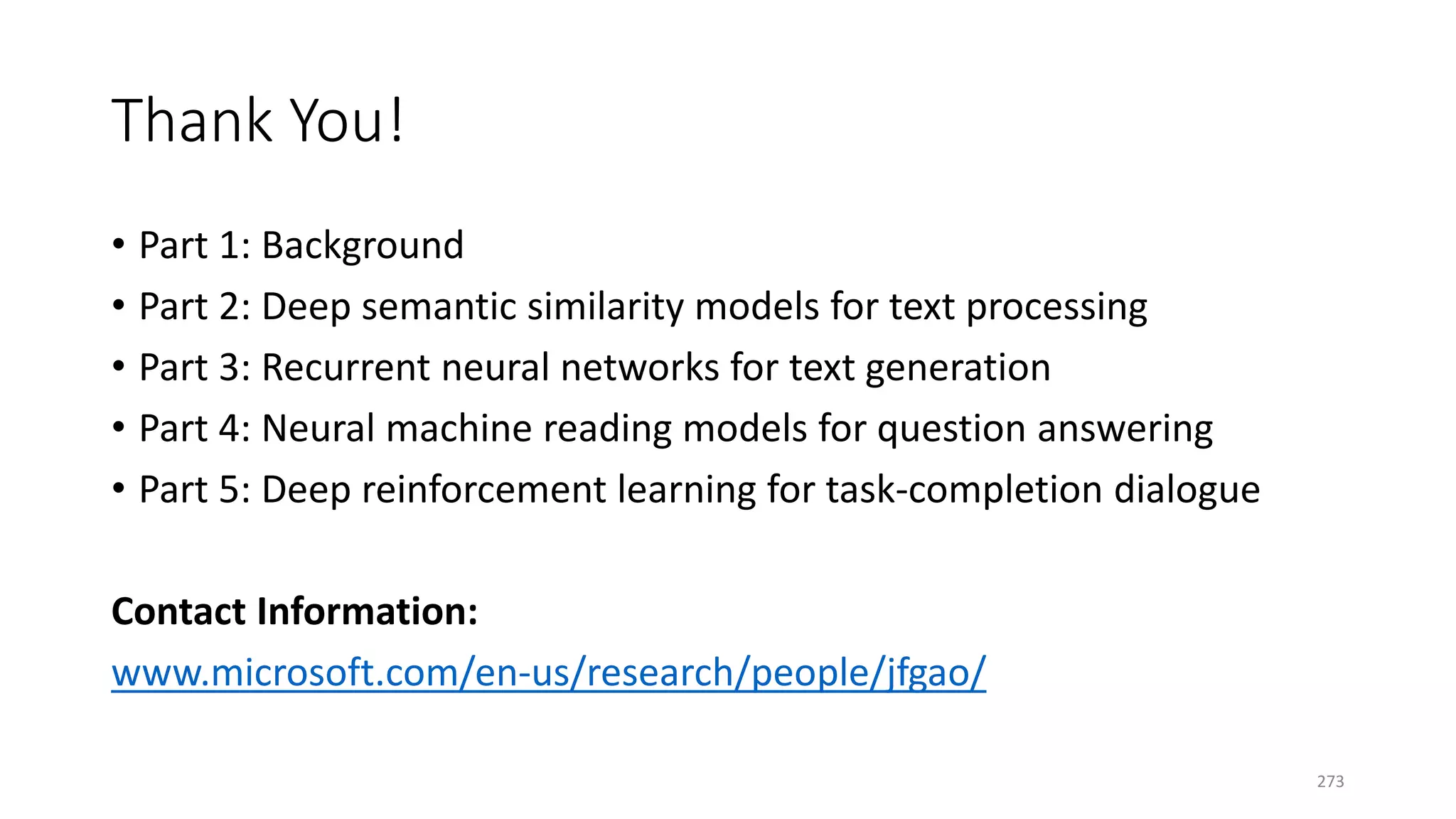This document provides an outline for a tutorial on deep learning for natural language processing. It begins with an introduction to deep learning and its history, then discusses how neural methods have become prominent in natural language processing. The rest of the tutorial is outlined covering deep semantic models for text, recurrent neural networks for text generation, neural question answering models, and deep reinforcement learning for dialog systems.
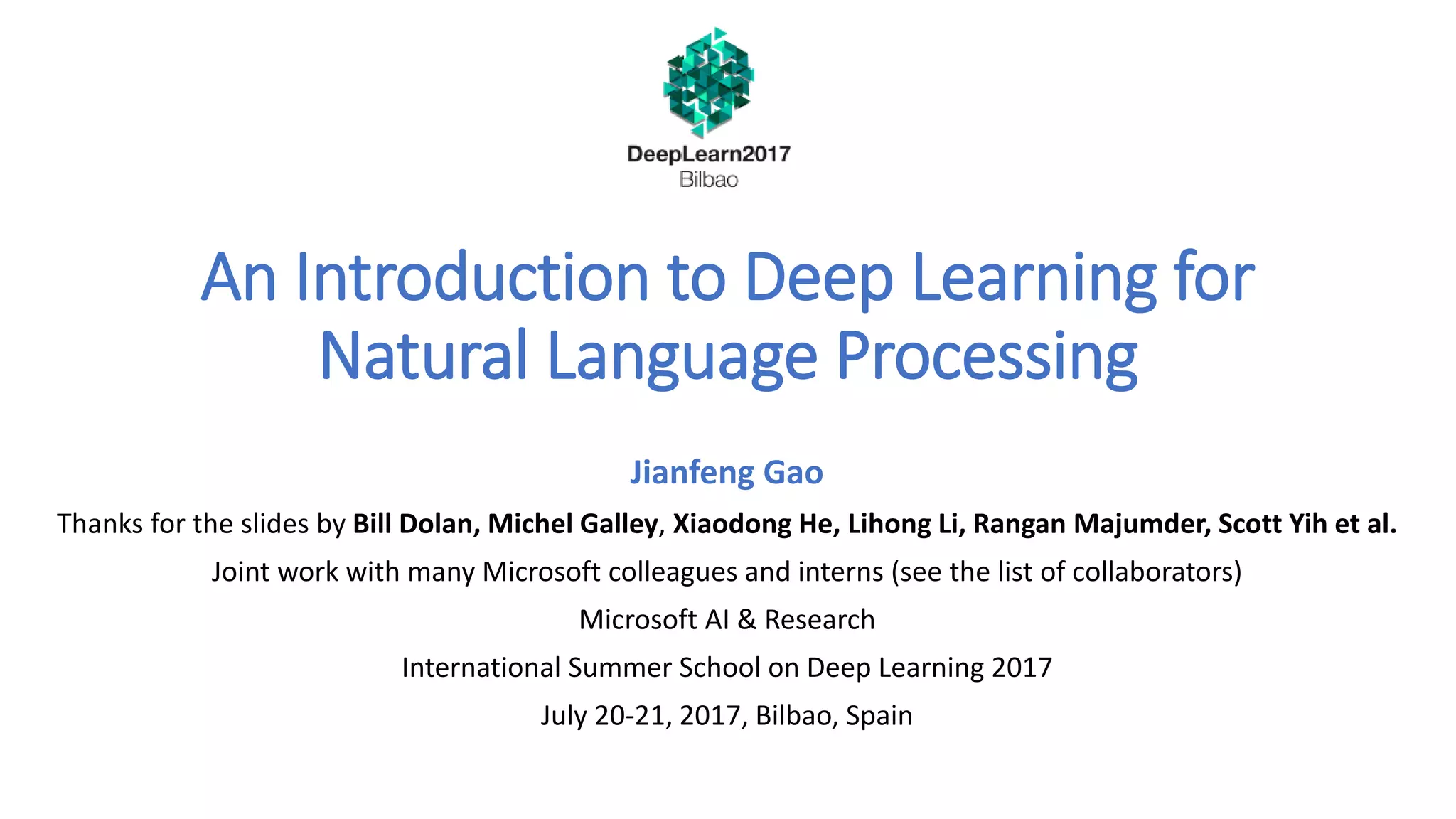
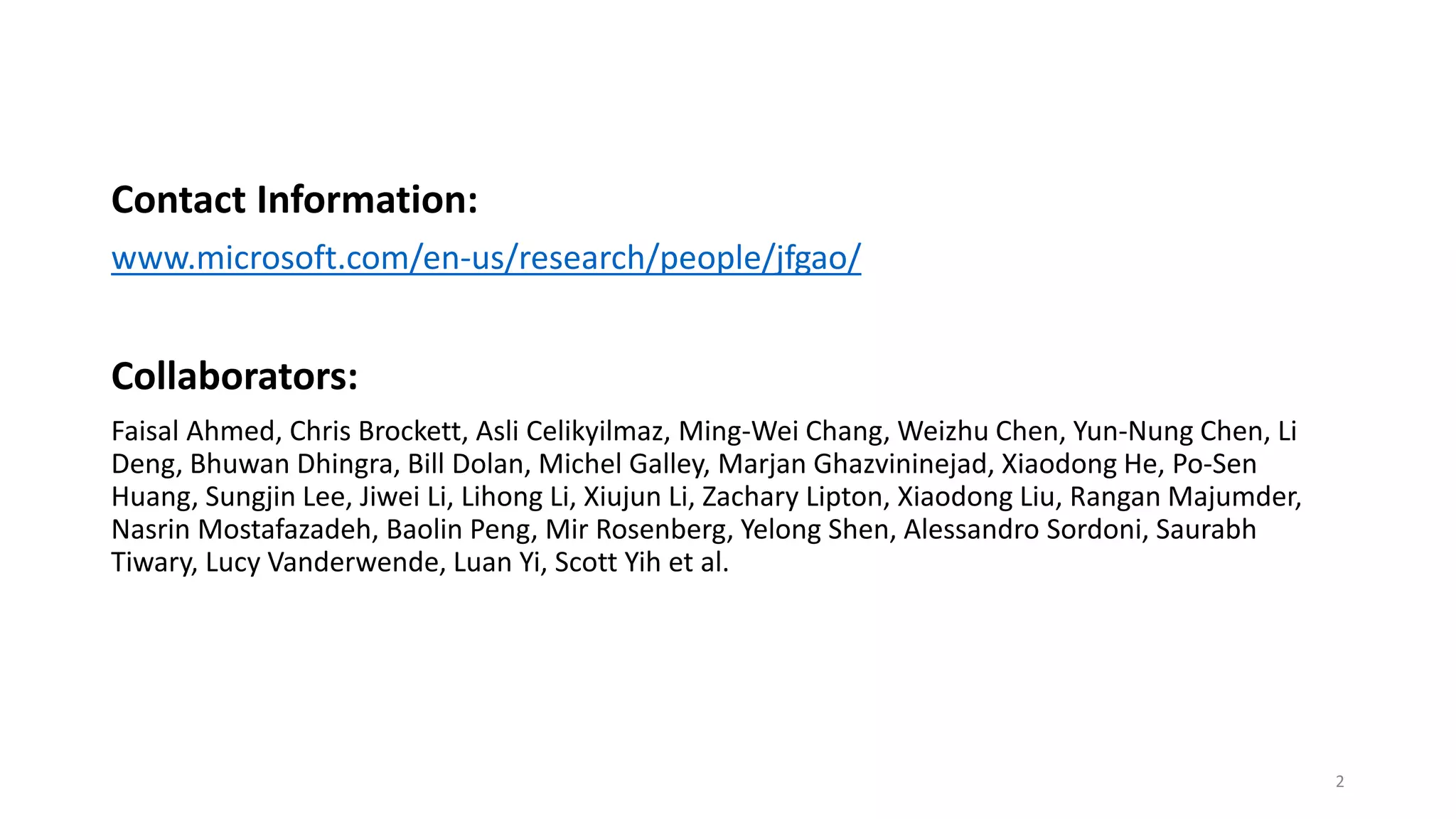
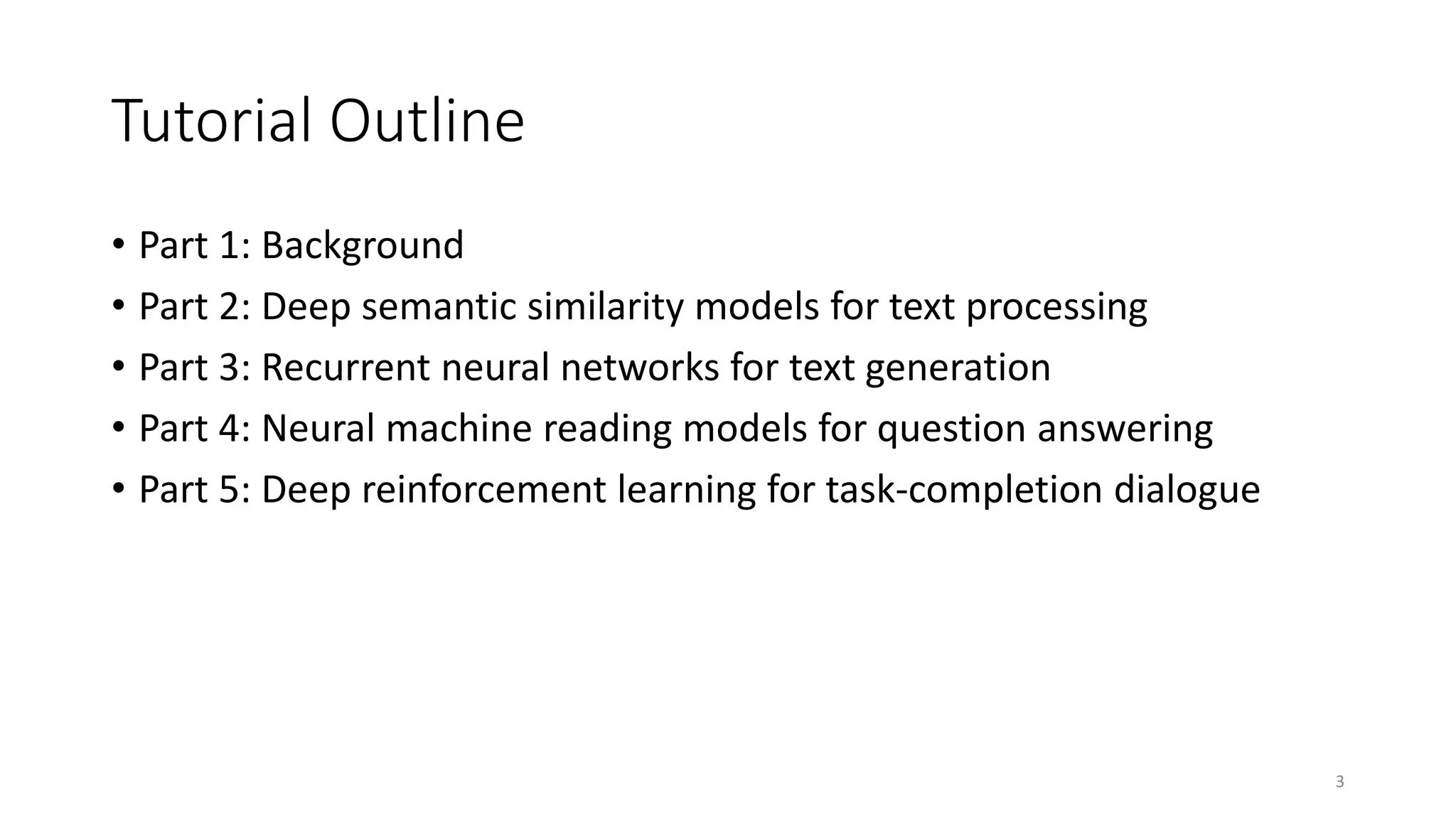
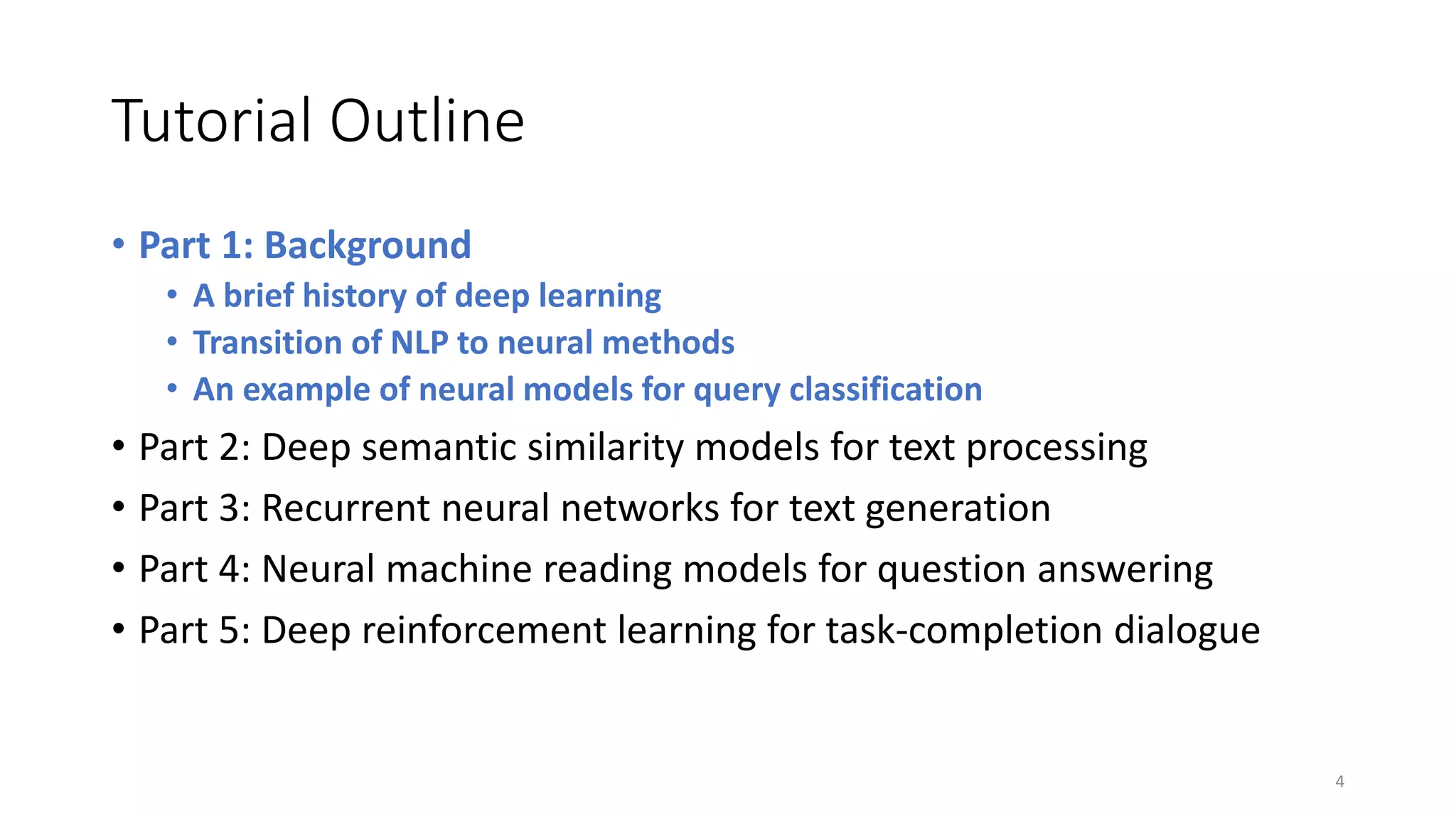
![Historical trends in deep learning (DL)
• DL has had a long and rich history, with different
names (cybernetics, connectionism, neural nets)
• Become more useful as the amount of available
training data has increased
• DL models have grown in size over time as
computer infrastructure (both hardware and
software) for DL has improved
• DL has solved increasingly complicated tasks
with increasing accuracy over time.
[Goodfellow+ 16]
5](https://image.slidesharecdn.com/mitqptdarkanz785ioot-signature-233d5c007282b08e62cf0f4d0a5dd88f5ed85398db05a93a193537bbc0db97b6-poli-190707174549/75/BIng-NLP-Expert-Dl-summer-school-2017-jianfeng-gao-v2-5-2048.jpg)
![Three waves of DL
• Wave 1: cybernetics
• Started in 40s to 60s [McCulloch & Pitts 43; Hebb 49]
• Development of perceptron [Rosenblatt 58]
• Wave 2: connectionism or neural networks
• Started in 80s to 90s
• Development of back-propagation [Rumelhart+ 86]
• Wave 3 (current wave): deep learning
• Started at 2006 [Hinton+ 06; Bengio+ 07; Ranzato+ 07]
[Goodfellow+ 16]
6](https://image.slidesharecdn.com/mitqptdarkanz785ioot-signature-233d5c007282b08e62cf0f4d0a5dd88f5ed85398db05a93a193537bbc0db97b6-poli-190707174549/75/BIng-NLP-Expert-Dl-summer-school-2017-jianfeng-gao-v2-6-2048.jpg)
![[Wang & Raj 17]
7](https://image.slidesharecdn.com/mitqptdarkanz785ioot-signature-233d5c007282b08e62cf0f4d0a5dd88f5ed85398db05a93a193537bbc0db97b6-poli-190707174549/75/BIng-NLP-Expert-Dl-summer-school-2017-jianfeng-gao-v2-7-2048.jpg)
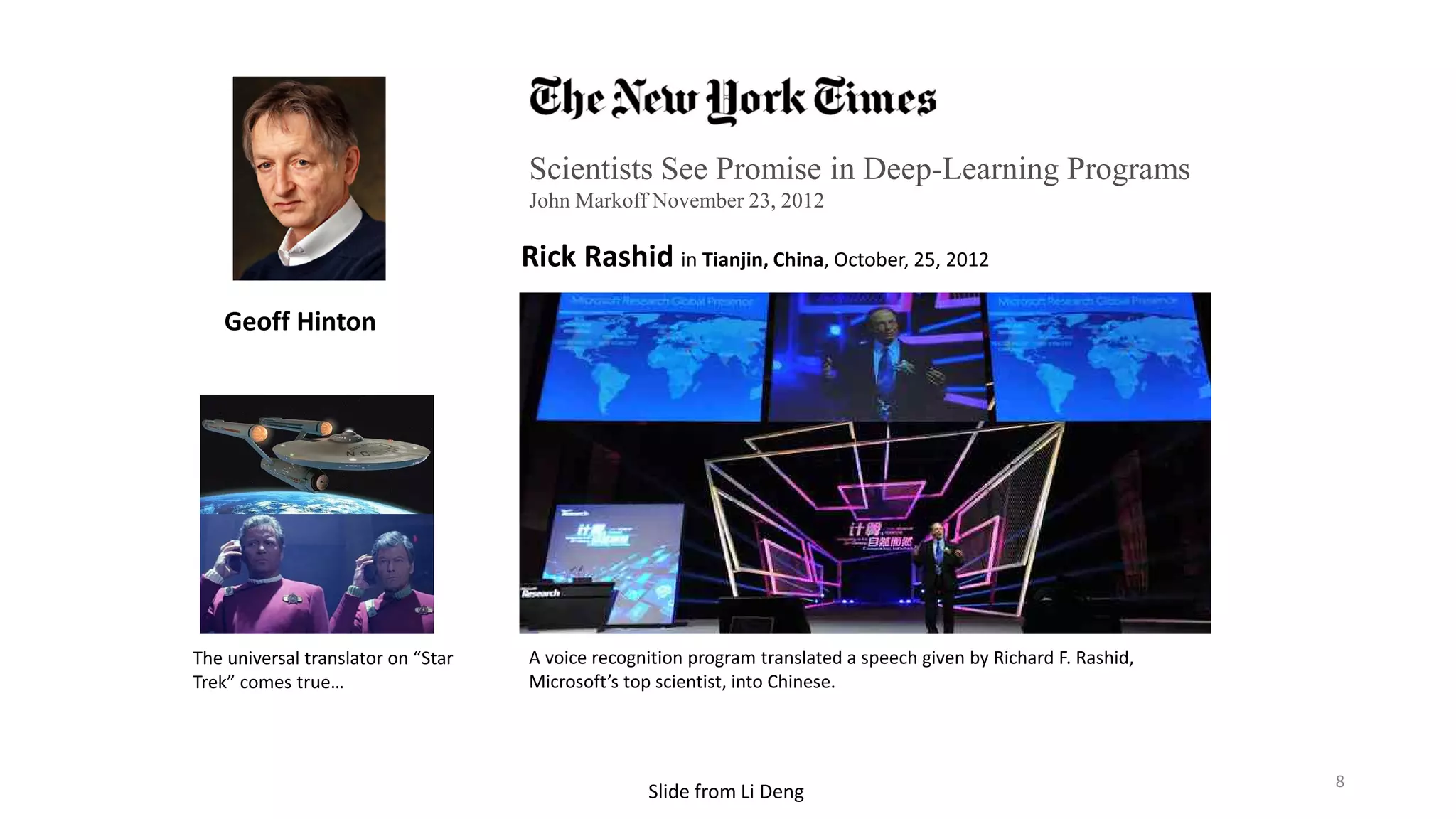
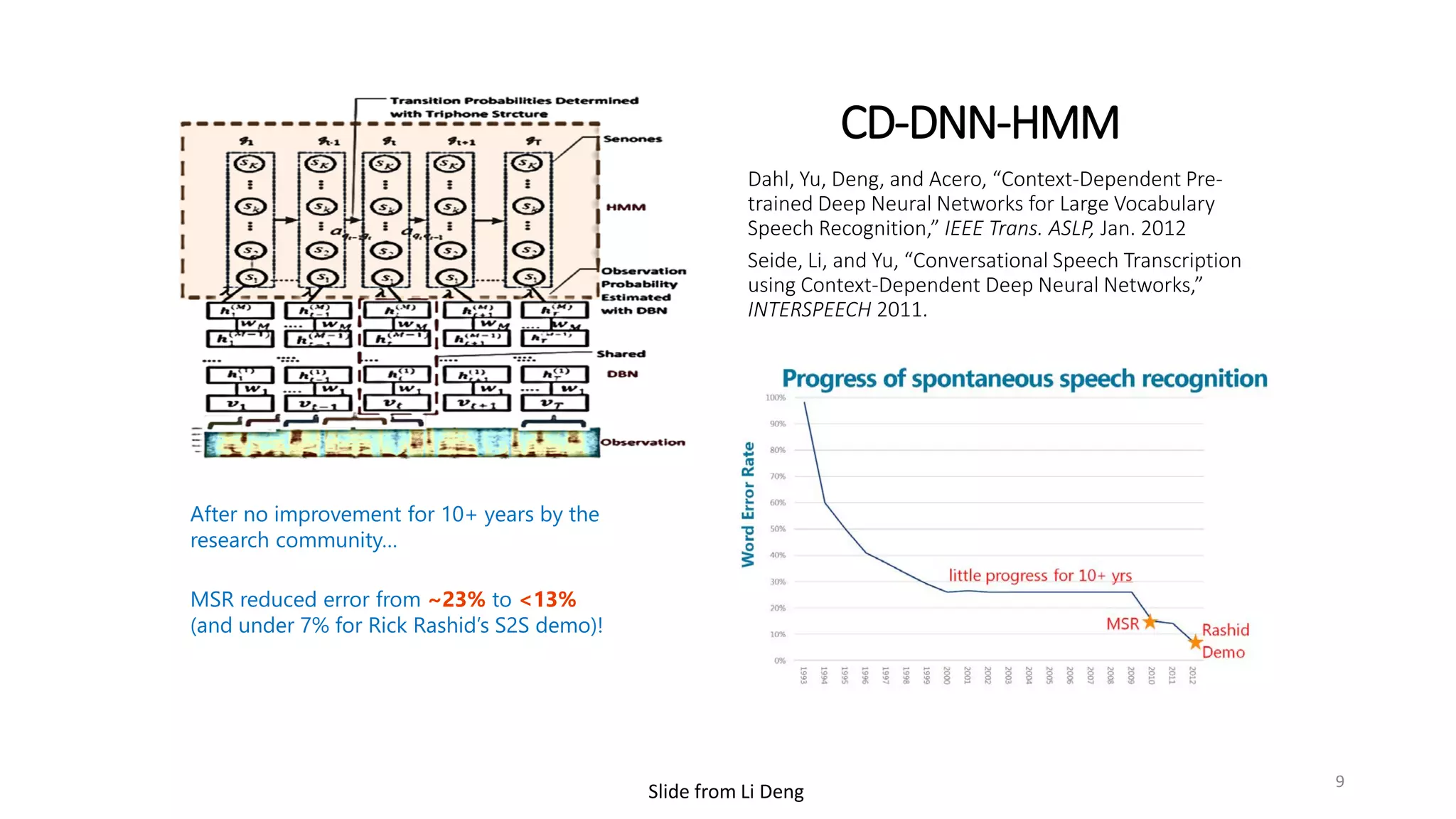

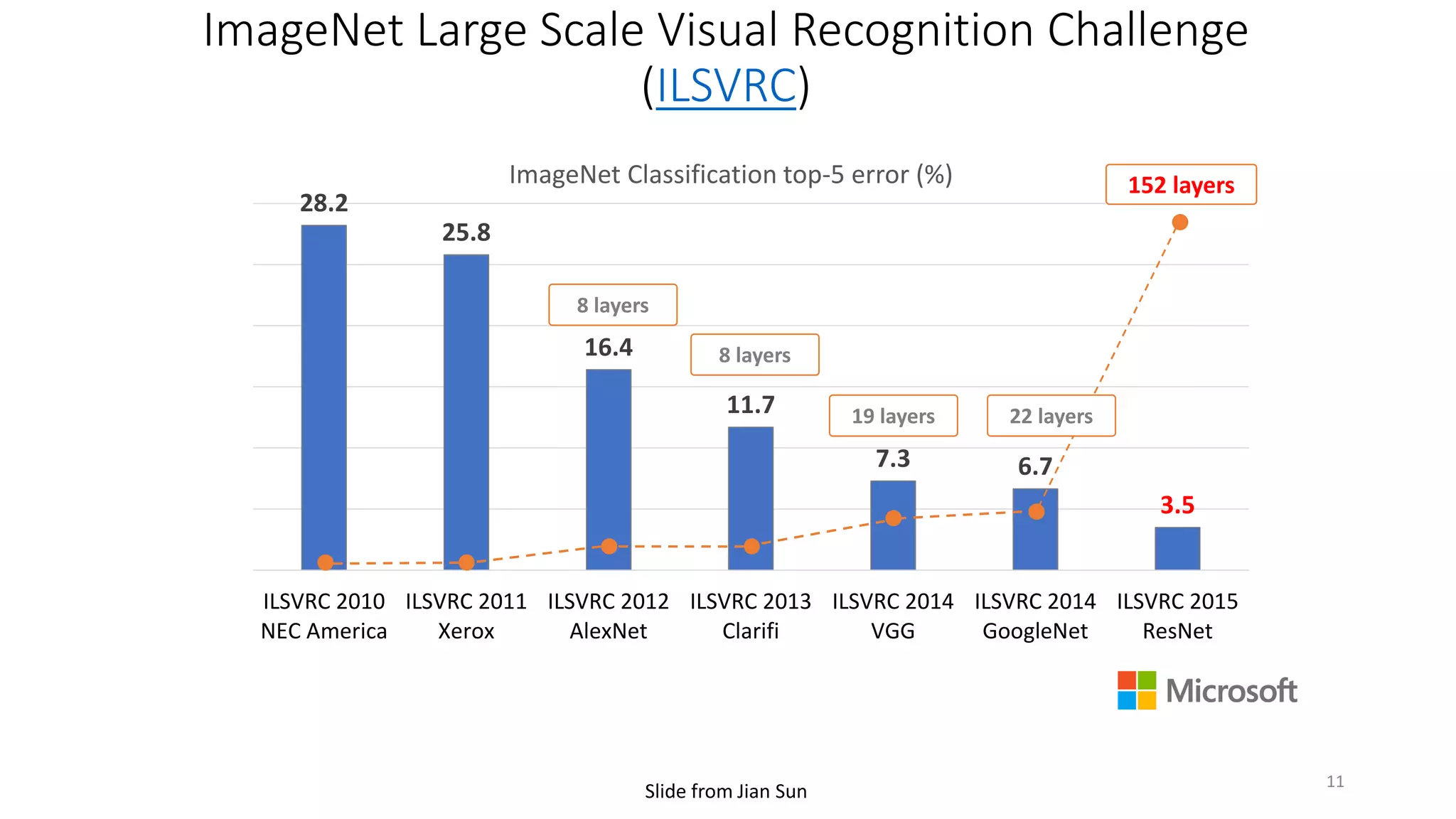
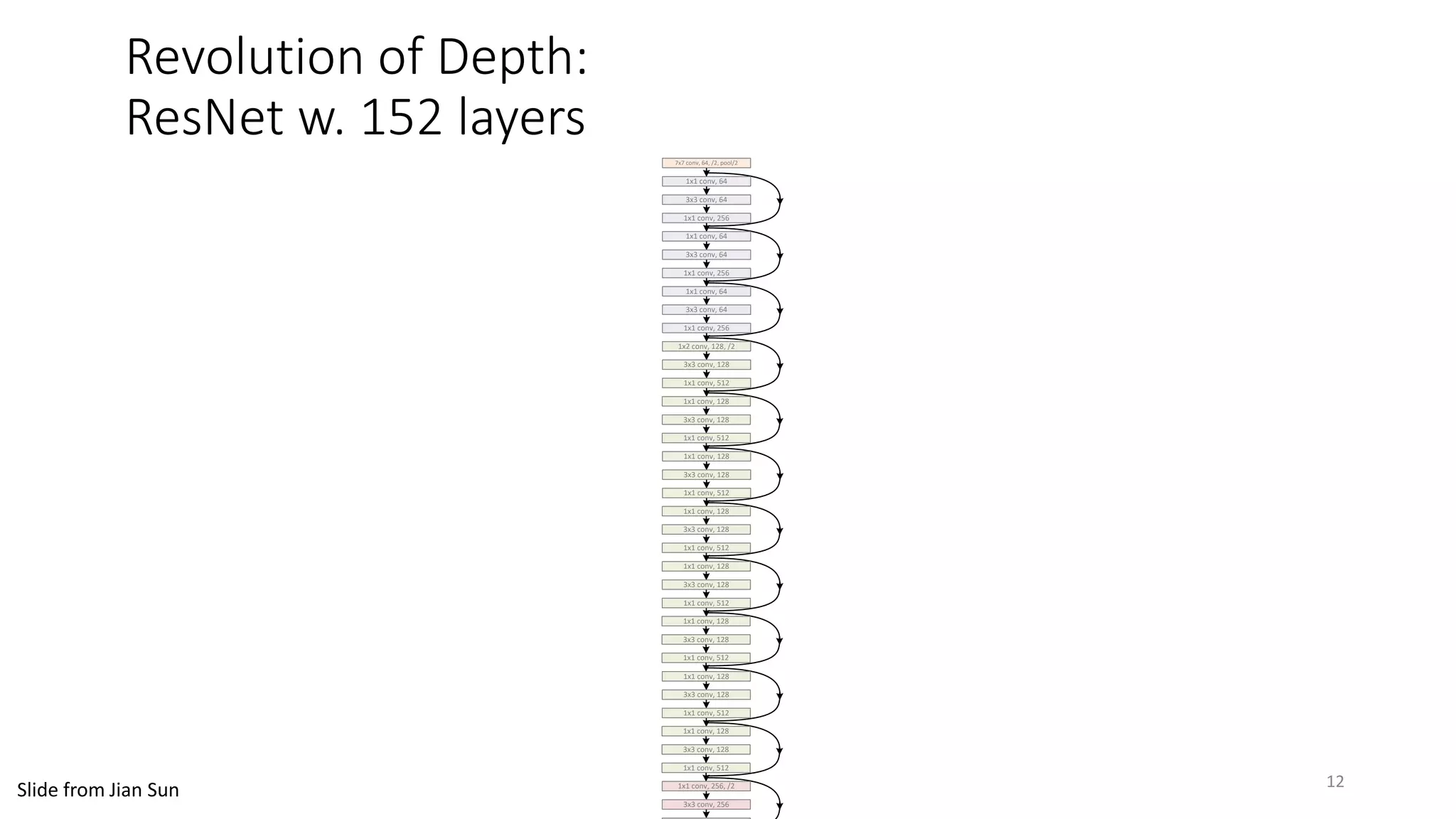
![7x7 conv, 64, /2
pool, /2
3x3 conv, 64
3x3 conv, 64
3x3 conv, 64
3x3 conv, 64
3x3 conv, 64
3x3 conv, 64
3x3 conv, 128, /2
3x3 conv, 128
3x3 conv, 128
3x3 conv, 128
3x3 conv, 128
3x3 conv, 128
3x3 conv, 128
3x3 conv, 128
3x3 conv, 256, /2
3x3 conv, 256
3x3 conv, 256
3x3 conv, 256
3x3 conv, 256
3x3 conv, 256
3x3 conv, 256
3x3 conv, 256
3x3 conv, 256
3x3 conv, 256
3x3 conv, 256
3x3 conv, 256
3x3 conv, 512, /2
3x3 conv, 512
3x3 conv, 512
3x3 conv, 512
3x3 conv, 512
3x3 conv, 512
avg pool
fc 1000
7x7 conv, 64, /2
pool, /2
3x3 conv, 64
3x3 conv, 64
3x3 conv, 64
3x3 conv, 64
3x3 conv, 64
3x3 conv, 64
3x3 conv, 128, /2
3x3 conv, 128
3x3 conv, 128
3x3 conv, 128
3x3 conv, 128
3x3 conv, 128
3x3 conv, 128
3x3 conv, 128
3x3 conv, 256, /2
3x3 conv, 256
3x3 conv, 256
3x3 conv, 256
3x3 conv, 256
3x3 conv, 256
3x3 conv, 256
3x3 conv, 256
3x3 conv, 256
3x3 conv, 256
3x3 conv, 256
3x3 conv, 256
3x3 conv, 512, /2
3x3 conv, 512
3x3 conv, 512
3x3 conv, 512
3x3 conv, 512
3x3 conv, 512
avg pool
fc 1000
Plain deep network Deep residual network
signals flow thru many pathssignals flow thru a single path
[Kaiming He, Xiangyu Zhang, Shaoqing Ren, & Jian Sun. “Deep Residual Learning for Image Recognition”. arXiv 2015.] 13](https://image.slidesharecdn.com/mitqptdarkanz785ioot-signature-233d5c007282b08e62cf0f4d0a5dd88f5ed85398db05a93a193537bbc0db97b6-poli-190707174549/75/BIng-NLP-Expert-Dl-summer-school-2017-jianfeng-gao-v2-13-2048.jpg)
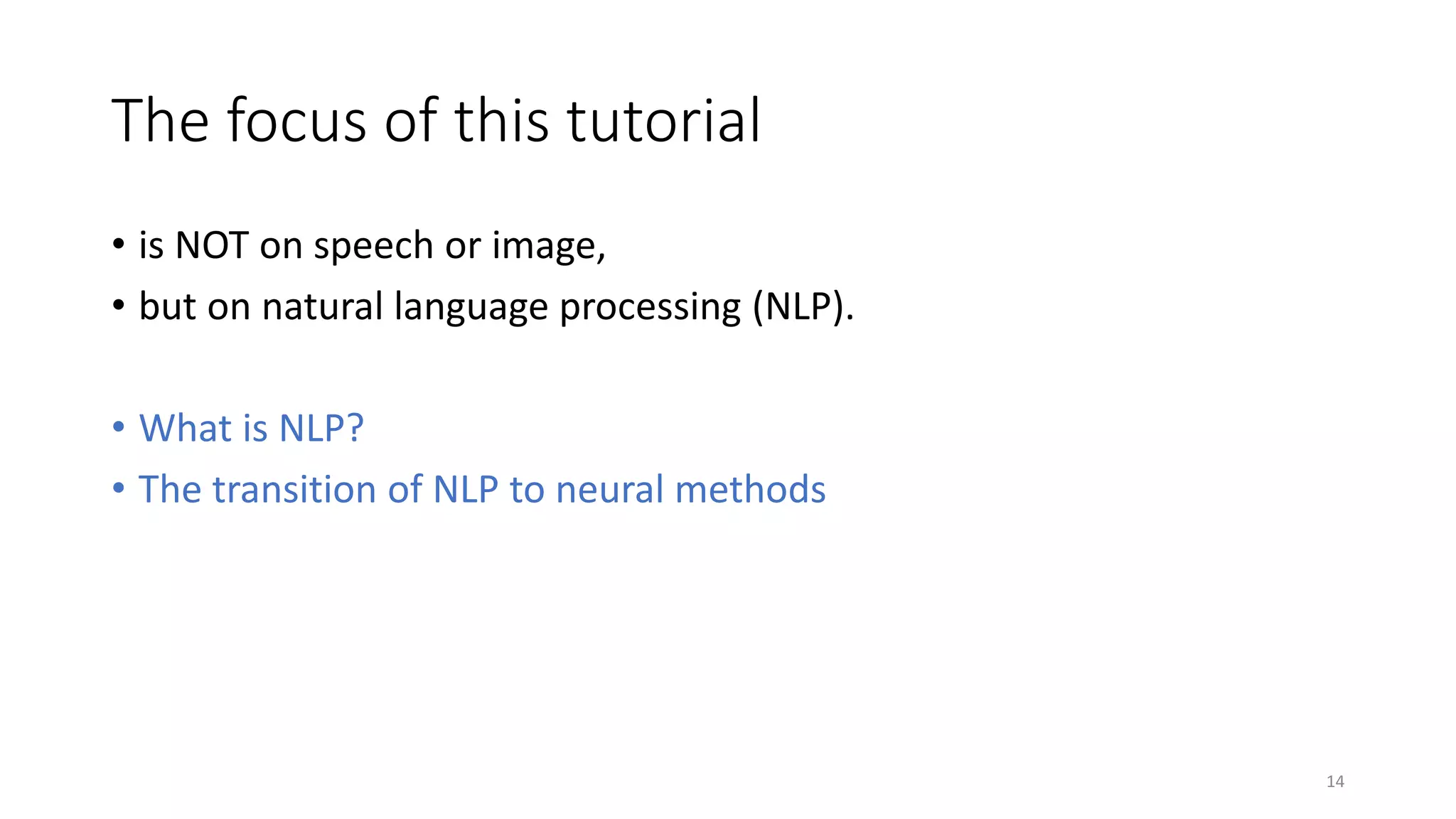
![Traditional definition of NLP: the branch of AI
• Deal with analyzing, understanding and generating the languages that
humans use naturally (natural language)
• Study knowledge of language at different levels
• Phonetics and Phonology – the study of linguistic sounds
• Morphology – the study of the meaning of components of words
• Syntax – the study of the structural relationships between words
• Semantics – the study of meaning
• Discourse – they study of linguistic units larger than a single utterance
[Jurafsky & Martin 10] 15](https://image.slidesharecdn.com/mitqptdarkanz785ioot-signature-233d5c007282b08e62cf0f4d0a5dd88f5ed85398db05a93a193537bbc0db97b6-poli-190707174549/75/BIng-NLP-Expert-Dl-summer-school-2017-jianfeng-gao-v2-15-2048.jpg)
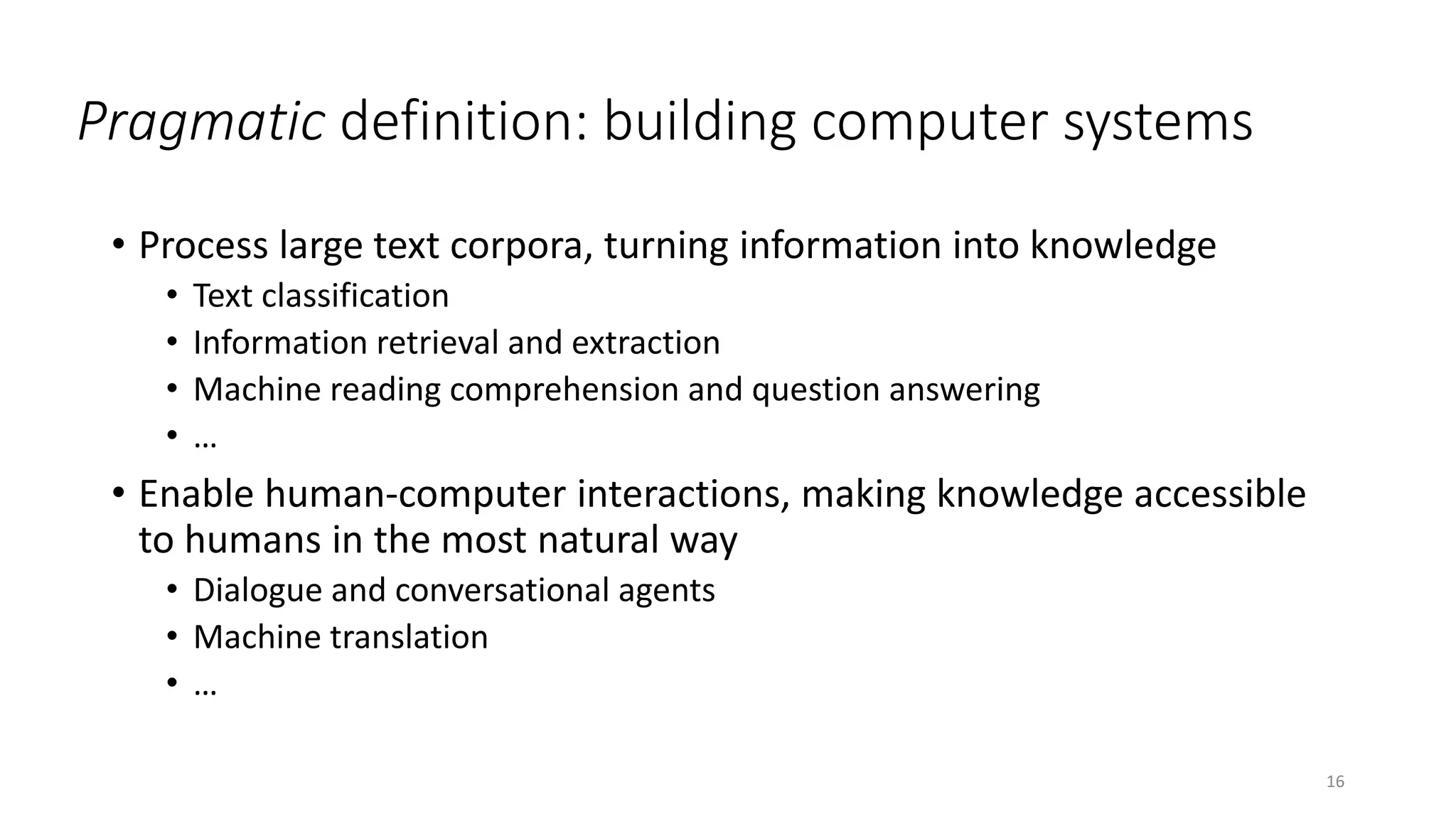
![Challenge of NLP: the diversity of natural language
Ambiguity
Example: I made her duck.
• I cooked waterfowl for her.
• I cooked waterfowl belonging to her.
• I created the plaster duck she owns.
• I caused her to quickly lower her head or body.
• I waved my magic wand and turned her into
undifferentiated waterfowl.
Paraphrase
Example: How long is the X river?
• The Mississippi River is 3,734 km (2,320 mi) long.
• ...is a short river, some 4.5 miles (7.2 km) in length
• The total length of the river is 2,145 kilometers.
• … at the estimated length of 5,464 km (3,395 mi)…
• … has a meander length of 444 miles (715 km)…
• … Bali’s longest river, measuring approximately 75
kilometers from source to mouth.
• The … mainstem is 2.75 miles (4.43 km) long
although total distance from headwater source
tributaries to the sea is 14 miles (23 km).
Many-to-many mapping btw symbolic
language and semantic meaning
[Jurafsky & Martin 10; Dolan 17] 17](https://image.slidesharecdn.com/mitqptdarkanz785ioot-signature-233d5c007282b08e62cf0f4d0a5dd88f5ed85398db05a93a193537bbc0db97b6-poli-190707174549/75/BIng-NLP-Expert-Dl-summer-school-2017-jianfeng-gao-v2-17-2048.jpg)
![The transition of NLP to neural methods
• Paradigm shift in NLP: from symbolic to neural computation
• End-to-end learning simplifies systems, reduces effort for feature
engineering and localization
• New state of the art results both at the component level and end-
application
• Opens up new end applications and experience
• Large-scale (GPU) computing resources are critical
• Long-term success relies on BIG data
[Arul Menezes & Bill Dolan. 2017. The transition of natural language processing to neural methods. Unpublished report.] 18](https://image.slidesharecdn.com/mitqptdarkanz785ioot-signature-233d5c007282b08e62cf0f4d0a5dd88f5ed85398db05a93a193537bbc0db97b6-poli-190707174549/75/BIng-NLP-Expert-Dl-summer-school-2017-jianfeng-gao-v2-18-2048.jpg)
![Traditional NLP component stack
1. Natural language understand (NLU):
parsing (speech) input to semantic
meaning and update the system state
2. Application reasoning and execution:
take the next action based on state
3. Natural language generation (NLG):
generating (speech) response from action
[Menezes & Dolan 17]
19](https://image.slidesharecdn.com/mitqptdarkanz785ioot-signature-233d5c007282b08e62cf0f4d0a5dd88f5ed85398db05a93a193537bbc0db97b6-poli-190707174549/75/BIng-NLP-Expert-Dl-summer-school-2017-jianfeng-gao-v2-19-2048.jpg)
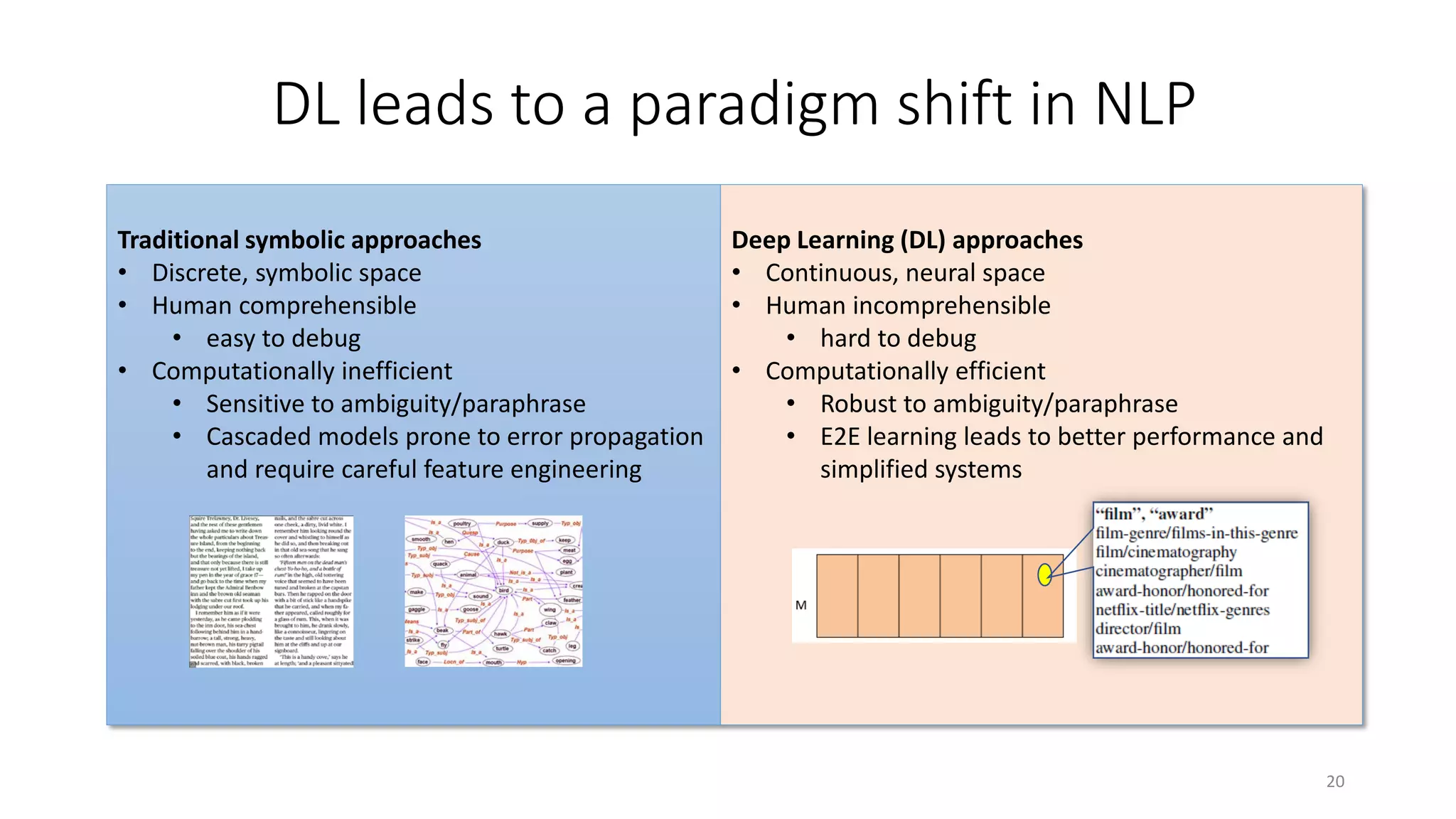
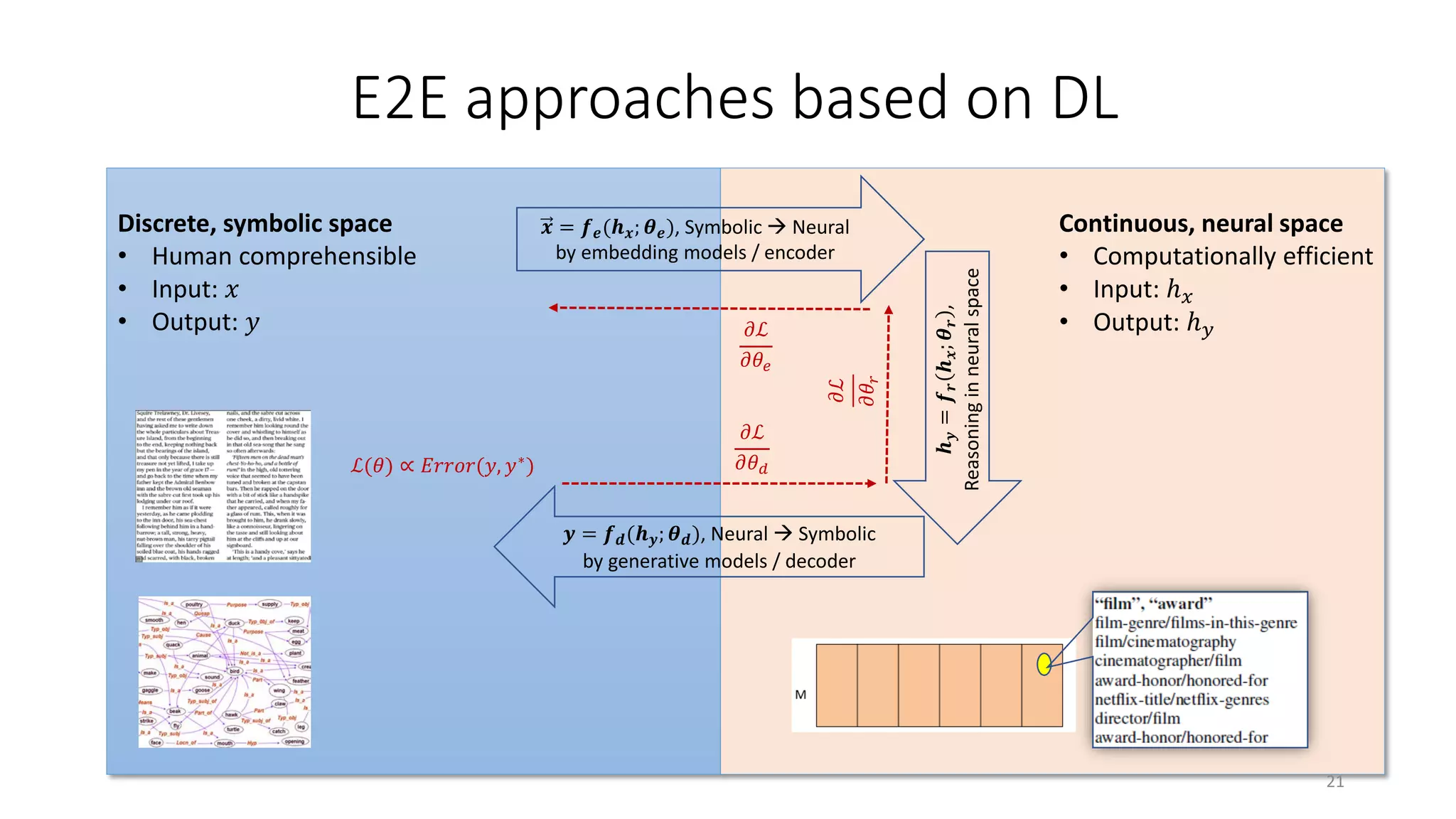
![State of the art results on NLP application-level tasks
Task Test set Metric Best non-
neural
Best neural Source
Machine Translation Enu-deu newstest16 BLEU 31.4 34.8 http://matrix.statmt.org
Deu-enu newstest16 BLEU 35.9 39.9 http://matrix.statmt.org
Sentiment Analysis Stanford sentiment bank 5-class Accuracy 71.0 80.7 Socher+ 13
Question Answering WebQuestions test set F1 39.9 52.5 Yih+ 15
Entity Linking Bing Query Entity Linking set AUC 72.3 78.2 Gao+ 14b
Image Captioning COCO 2015 challenge Turing test pass% 25.5 32.2 Fang+ 15
Sentence compression Google 10K dataset F1 0.75 0.82 Fillipova+ 15
Response Generation Sordoni dataset BLEU-4 3.98 5.82 Li+ 16a
[Menezes & Dolan 17]
22](https://image.slidesharecdn.com/mitqptdarkanz785ioot-signature-233d5c007282b08e62cf0f4d0a5dd88f5ed85398db05a93a193537bbc0db97b6-poli-190707174549/75/BIng-NLP-Expert-Dl-summer-school-2017-jianfeng-gao-v2-22-2048.jpg)
![State of the art results on NLP component tasks
Task Test set Metric Best non-
neural
Best neural Source
POS tagging PTB section 23 F1 97.17 97.78 Andor+ 16
Syntactic Parsing PTB section 23 F1 90.1 93.3 Dyer+ 16
Dependency parsing PTB section 23 F1 93.22 94.61 Andor+ 16
CCG parsing CCGBank test F1 85.2 88.7 Lee+ 16
Inference (NLI) Stanford NLI corpus Accuracy 78.2 88.3 Chen+ 16
Also see a summary by [Goldberg 15]
[Menezes & Dolan 17] 23](https://image.slidesharecdn.com/mitqptdarkanz785ioot-signature-233d5c007282b08e62cf0f4d0a5dd88f5ed85398db05a93a193537bbc0db97b6-poli-190707174549/75/BIng-NLP-Expert-Dl-summer-school-2017-jianfeng-gao-v2-23-2048.jpg)
![Recent progress on machine translation (MT):
BLEU score of state of the art systems
28
30
32
34
36
38
40
42
Jun-14 Sep-14 Dec-14 Mar-15 Jun-15 Sep-15 Dec-15 Mar-16 Jun-16 Sep-16
English->French newstest2014
Statistical Hybrid Neural Ensemble Single Neural
• Statistical MT state of the art is highly
engineered and has made little progress in
over two years
• Chart shows progress in three classes of
neural systems
• Hybrid: Add neural models to existing
statistical MT system
• Single: Single pure-neural system (to be
discussed in Part 3)
• Ensemble: Large ensemble of pure-
neural systems
[Menezes & Dolan 17] 24](https://image.slidesharecdn.com/mitqptdarkanz785ioot-signature-233d5c007282b08e62cf0f4d0a5dd88f5ed85398db05a93a193537bbc0db97b6-poli-190707174549/75/BIng-NLP-Expert-Dl-summer-school-2017-jianfeng-gao-v2-24-2048.jpg)
![Human evaluation of MT quality
2.00
2.20
2.40
2.60
2.80
3.00
3.20
3.40
3.60
May-11 Nov-11 May-12 Nov-12 May-13 Nov-13 May-14 Nov-14 May-15 Nov-15 May-16
Chinese->English, human eval score
• Two popular commercial MT systems
• Human evaluation on a scale of 1 to 4
• Human preference for neural MT is
much greater than the already large
BLEU score gap
• Primarily because neural MT is much
more fluent
• Current neural MT systems are getting
close to “human quality”
[Menezes & Dolan 17] 25](https://image.slidesharecdn.com/mitqptdarkanz785ioot-signature-233d5c007282b08e62cf0f4d0a5dd88f5ed85398db05a93a193537bbc0db97b6-poli-190707174549/75/BIng-NLP-Expert-Dl-summer-school-2017-jianfeng-gao-v2-25-2048.jpg)
![DL opens up new end tasks and experience
Output of a neural conversation model trained on 250K Twitter conversations sparked by a tweeted photo
[Menezes & Dolan 17; Sordoni+ 15; Li+ 16a]
Neural approaches allow language models to be grounded in the world, i.e., link language to real-world signals
such as images, machine state, sensor data from biomedical devices.
26](https://image.slidesharecdn.com/mitqptdarkanz785ioot-signature-233d5c007282b08e62cf0f4d0a5dd88f5ed85398db05a93a193537bbc0db97b6-poli-190707174549/75/BIng-NLP-Expert-Dl-summer-school-2017-jianfeng-gao-v2-26-2048.jpg)

![A single neuron model
• For each domain 𝑐𝑐, build a binary classifier
• Input: represent a query 𝑞𝑞 as a vector of features 𝑥𝑥 = [𝑥𝑥1, … 𝑥𝑥𝑛𝑛]𝑇𝑇
• Output: 𝑦𝑦 = 𝑃𝑃 𝑐𝑐 𝑞𝑞
• 𝑞𝑞 is labeled 𝑐𝑐 if 𝑃𝑃 𝑐𝑐 𝑞𝑞 > 0.5
• Input feature vector, e.g., a bag of words vector
• Regards words as atomic symbols: denver, sushi, downtown
• Each word is represented as a one-hot vector: 0, … , 0,1,0, … , 0 𝑇𝑇
• Bag of words vector = sum of one-hot vectors
• We may use other features, such as n-grams, phrases, (hidden) topics
28](https://image.slidesharecdn.com/mitqptdarkanz785ioot-signature-233d5c007282b08e62cf0f4d0a5dd88f5ed85398db05a93a193537bbc0db97b6-poli-190707174549/75/BIng-NLP-Expert-Dl-summer-school-2017-jianfeng-gao-v2-28-2048.jpg)

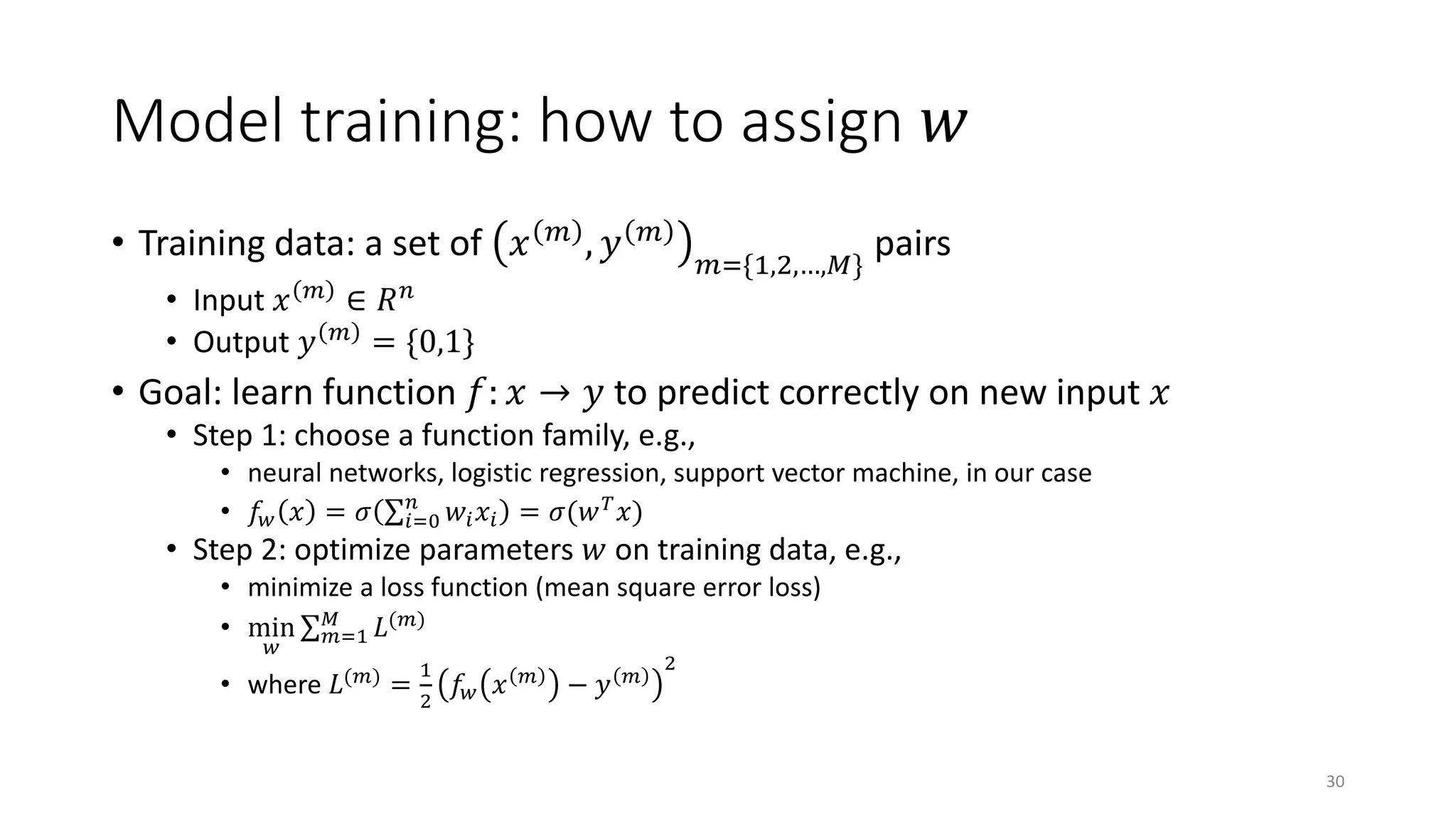

![SGD vs. gradient descent
• Gradient descent is a batch training algorithm
• update 𝑤𝑤 per batch of training samples
• goes in steepest descent direction
• SGD is noisy descent (but faster per iteration)
• Loss function contour plot
• ∑ 𝑚𝑚=1
𝑀𝑀 1
2
𝜎𝜎 𝑤𝑤 𝑇𝑇 𝑥𝑥 − 𝑦𝑦 2 + 𝑤𝑤
32[Duh, K. 2014. Deep learning for natural language processing and machine translation. Tutorial.]](https://image.slidesharecdn.com/mitqptdarkanz785ioot-signature-233d5c007282b08e62cf0f4d0a5dd88f5ed85398db05a93a193537bbc0db97b6-poli-190707174549/75/BIng-NLP-Expert-Dl-summer-school-2017-jianfeng-gao-v2-32-2048.jpg)
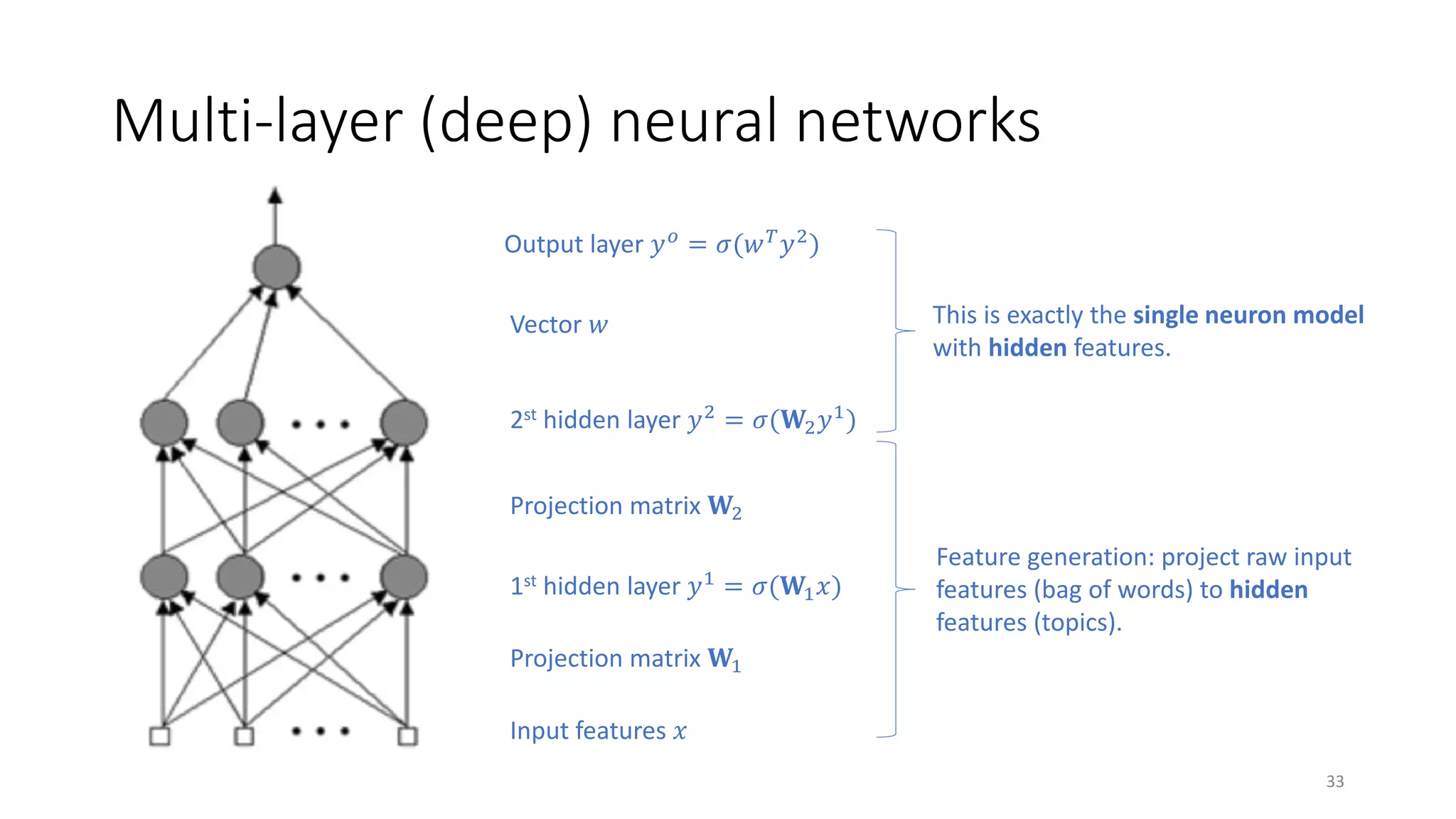
![Why Multiple Layers? [DL tutorial at NIPS’2015]
• Hierarchy of representations with increasing level of abstraction
• Each layer is a trainable feature transform
• Image recognition: pixel edge texton motif part object
• ?? Text: character word word group clause sentence story
34](https://image.slidesharecdn.com/mitqptdarkanz785ioot-signature-233d5c007282b08e62cf0f4d0a5dd88f5ed85398db05a93a193537bbc0db97b6-poli-190707174549/75/BIng-NLP-Expert-Dl-summer-school-2017-jianfeng-gao-v2-34-2048.jpg)
![Standard Machine
Learning Process
Deep Learning
Adapted from [Duh 14]
35](https://image.slidesharecdn.com/mitqptdarkanz785ioot-signature-233d5c007282b08e62cf0f4d0a5dd88f5ed85398db05a93a193537bbc0db97b6-poli-190707174549/75/BIng-NLP-Expert-Dl-summer-school-2017-jianfeng-gao-v2-35-2048.jpg)
![Revisit the activation function: 𝜎𝜎
• Assuming a L-layer neural network
• 𝑦𝑦 = 𝐖𝐖𝐿𝐿 𝜎𝜎 … 𝜎𝜎 𝐖𝐖2 𝜎𝜎 𝐖𝐖1 𝑥𝑥 , where 𝑦𝑦 is the output vector
• If 𝜎𝜎 is a linear function, then L-layer neural network is compiled down
into a single linear transform
• 𝜎𝜎: map scores to probabilities
• Useful in prediction as it transforms the neuron weighted sum into the
interval [0..1]
• Unnecessary for model training except in the Boltzman machine or graphical
models
36](https://image.slidesharecdn.com/mitqptdarkanz785ioot-signature-233d5c007282b08e62cf0f4d0a5dd88f5ed85398db05a93a193537bbc0db97b6-poli-190707174549/75/BIng-NLP-Expert-Dl-summer-school-2017-jianfeng-gao-v2-36-2048.jpg)
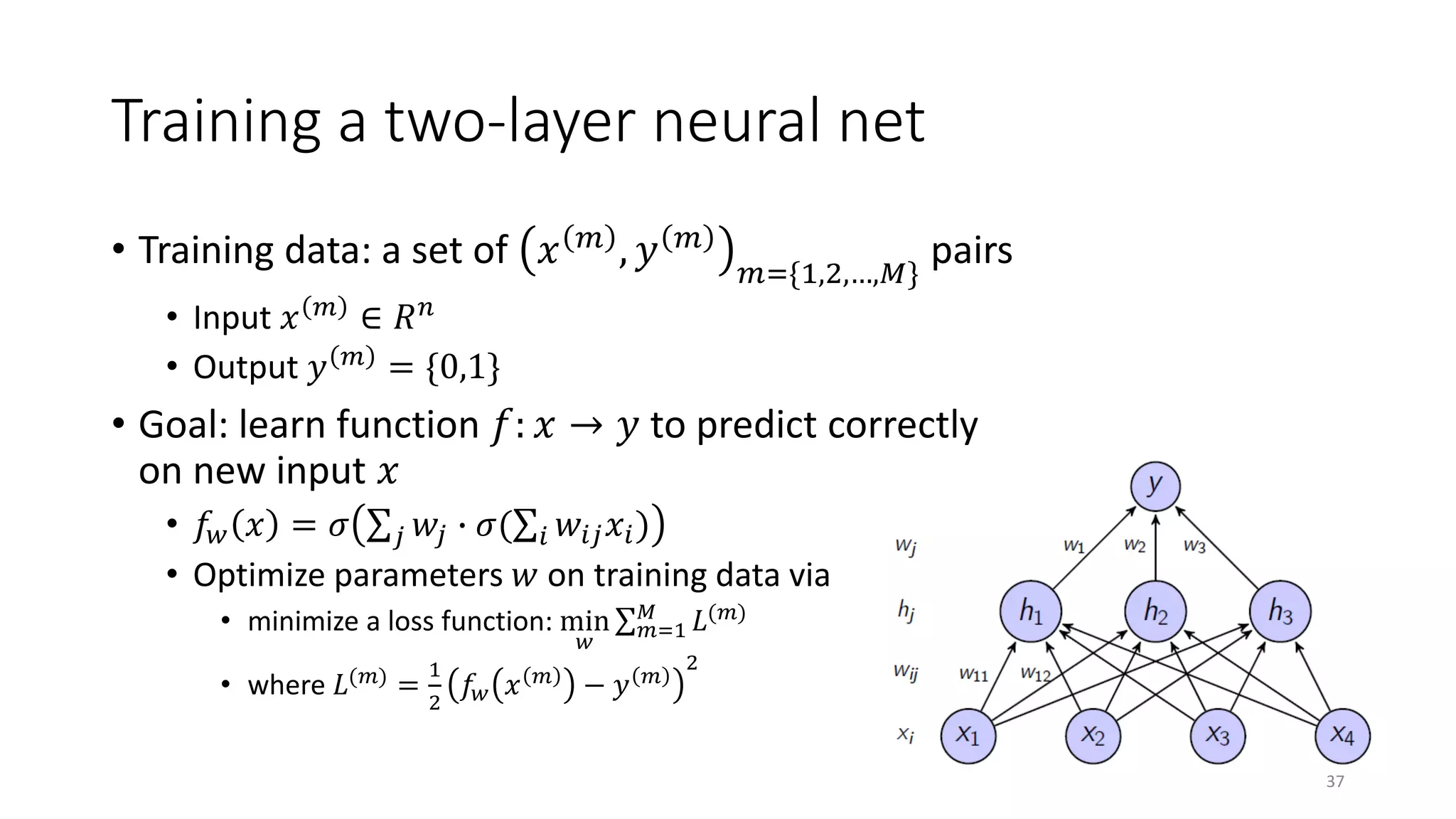
![Training neural nets: back-propagation
• Stochastic gradient descent (SGD) algorithm
• 𝑤𝑤 𝑛𝑛𝑛𝑛𝑛𝑛
= 𝑤𝑤 𝑜𝑜𝑜𝑜 𝑜𝑜
− 𝜂𝜂
𝜕𝜕𝜕𝜕
𝜕𝜕𝜕𝜕
•
𝜕𝜕𝜕𝜕
𝜕𝜕𝜕𝜕
: sample-wise loss w.r.t. parameters
• Need to apply the derivative chain rule correctly
• 𝑧𝑧 = 𝑓𝑓 𝑦𝑦
• 𝑦𝑦 = 𝑔𝑔 𝑥𝑥
•
𝜕𝜕𝑧𝑧
𝜕𝜕𝑥𝑥
=
𝜕𝜕𝑧𝑧
𝜕𝜕𝑦𝑦
𝜕𝜕𝑦𝑦
𝜕𝜕𝜕𝜕
• See a detailed discussion in [Socher & Manning 13; Goodfellow+ 16]
38](https://image.slidesharecdn.com/mitqptdarkanz785ioot-signature-233d5c007282b08e62cf0f4d0a5dd88f5ed85398db05a93a193537bbc0db97b6-poli-190707174549/75/BIng-NLP-Expert-Dl-summer-school-2017-jianfeng-gao-v2-38-2048.jpg)
![Simple chain rule
[Socher & Manning NAACL 2013 Tutorial]
39](https://image.slidesharecdn.com/mitqptdarkanz785ioot-signature-233d5c007282b08e62cf0f4d0a5dd88f5ed85398db05a93a193537bbc0db97b6-poli-190707174549/75/BIng-NLP-Expert-Dl-summer-school-2017-jianfeng-gao-v2-39-2048.jpg)
![Multiple paths chain rule
[Socher & Manning 13]
40](https://image.slidesharecdn.com/mitqptdarkanz785ioot-signature-233d5c007282b08e62cf0f4d0a5dd88f5ed85398db05a93a193537bbc0db97b6-poli-190707174549/75/BIng-NLP-Expert-Dl-summer-school-2017-jianfeng-gao-v2-40-2048.jpg)
![Chain rule in flow graph
[Socher & Manning 13]
41](https://image.slidesharecdn.com/mitqptdarkanz785ioot-signature-233d5c007282b08e62cf0f4d0a5dd88f5ed85398db05a93a193537bbc0db97b6-poli-190707174549/75/BIng-NLP-Expert-Dl-summer-school-2017-jianfeng-gao-v2-41-2048.jpg)
![Training neural nets: back-propagation
Assume two outputs (𝑦𝑦1, 𝑦𝑦2) per input 𝑥𝑥, and
Loss per sample: 𝐿𝐿 = ∑𝑘𝑘
1
2
𝜎𝜎 𝑧𝑧𝑘𝑘 − 𝑦𝑦𝑘𝑘
2
Forward pass:
𝑦𝑦𝑘𝑘 = 𝜎𝜎(𝑧𝑧𝑘𝑘), 𝑧𝑧𝑘𝑘 = ∑𝑗𝑗 𝑤𝑤𝑗𝑗𝑗𝑗ℎ𝑗𝑗
ℎ𝑗𝑗 = 𝜎𝜎(𝑧𝑧𝑗𝑗), 𝑧𝑧𝑗𝑗 = ∑𝑖𝑖 𝑤𝑤𝑖𝑖𝑖𝑖 𝑥𝑥𝑖𝑖
Derivatives of the weights
𝜕𝜕𝜕𝜕
𝜕𝜕𝑤𝑤𝑗𝑗𝑗𝑗
=
𝜕𝜕𝜕𝜕
𝜕𝜕𝑧𝑧𝑘𝑘
𝜕𝜕𝑧𝑧𝑘𝑘
𝜕𝜕𝑤𝑤𝑗𝑗𝑗𝑗
= 𝛿𝛿𝑘𝑘
𝜕𝜕(∑𝑗𝑗 𝑤𝑤𝑗𝑗𝑗𝑗ℎ𝑗𝑗)
𝜕𝜕𝑤𝑤𝑗𝑗𝑗𝑗
= 𝛿𝛿𝑘𝑘ℎ𝑗𝑗
𝜕𝜕𝜕𝜕
𝜕𝜕𝑤𝑤𝑖𝑖𝑖𝑖
=
𝜕𝜕𝜕𝜕
𝜕𝜕𝑧𝑧𝑗𝑗
𝜕𝜕𝑧𝑧𝑗𝑗
𝜕𝜕𝑤𝑤𝑖𝑖𝑖𝑖
= 𝛿𝛿𝑗𝑗
𝜕𝜕(∑𝑖𝑖 𝑤𝑤𝑖𝑖𝑖𝑖 𝑥𝑥𝑖𝑖)
𝜕𝜕𝑤𝑤𝑖𝑖𝑖𝑖
= 𝛿𝛿𝑗𝑗 𝑥𝑥𝑖𝑖
𝛿𝛿𝑘𝑘 =
𝜕𝜕𝜕𝜕
𝜕𝜕𝑧𝑧𝑘𝑘
= 𝜎𝜎 𝑧𝑧𝑘𝑘 − 𝑦𝑦𝑘𝑘 𝜎𝜎′ 𝑧𝑧𝑘𝑘
𝛿𝛿𝑗𝑗 = ∑𝑘𝑘
𝜕𝜕𝜕𝜕
𝜕𝜕𝑧𝑧𝑘𝑘
𝜕𝜕𝑧𝑧𝑘𝑘
𝜕𝜕𝑧𝑧𝑗𝑗
= ∑𝑘𝑘 𝛿𝛿𝑘𝑘
𝜕𝜕
𝜕𝜕𝑧𝑧𝑗𝑗
∑𝑗𝑗 𝑤𝑤𝑗𝑗𝑗𝑗 𝜎𝜎 𝑧𝑧𝑗𝑗 = ∑𝑘𝑘 𝛿𝛿𝑘𝑘 𝑤𝑤𝑗𝑗𝑗𝑗 𝜎𝜎𝜎(𝑧𝑧𝑗𝑗)
Adapted from [Duh 14]
42](https://image.slidesharecdn.com/mitqptdarkanz785ioot-signature-233d5c007282b08e62cf0f4d0a5dd88f5ed85398db05a93a193537bbc0db97b6-poli-190707174549/75/BIng-NLP-Expert-Dl-summer-school-2017-jianfeng-gao-v2-42-2048.jpg)
![Training neural nets: back-propagation
• All updates involve some scaled error from output × input feature:
•
𝜕𝜕𝜕𝜕
𝜕𝜕𝑤𝑤𝑗𝑗𝑗𝑗
= 𝛿𝛿𝑘𝑘ℎ𝑗𝑗 where 𝛿𝛿𝑘𝑘 = 𝜎𝜎 𝑧𝑧𝑘𝑘 − 𝑦𝑦𝑘𝑘 𝜎𝜎′
𝑧𝑧𝑘𝑘
•
𝜕𝜕𝜕𝜕
𝜕𝜕𝑤𝑤𝑖𝑖𝑖𝑖
= 𝛿𝛿𝑗𝑗 𝑥𝑥𝑖𝑖 where 𝛿𝛿𝑗𝑗 = ∑𝑘𝑘 𝛿𝛿𝑘𝑘 𝑤𝑤𝑗𝑗𝑗𝑗 𝜎𝜎𝜎(𝑧𝑧𝑗𝑗)
• First compute 𝛿𝛿𝑘𝑘 from output layer, then 𝛿𝛿𝑗𝑗 for other layers and iterate.
𝛿𝛿𝑘𝑘=𝑦𝑦1 𝛿𝛿𝑘𝑘=𝑦𝑦2
𝛿𝛿𝑗𝑗=ℎ3
= 𝛿𝛿𝑘𝑘=𝑦𝑦1
𝑤𝑤31 + 𝛿𝛿𝑘𝑘=𝑦𝑦2
𝑤𝑤32 𝜎𝜎𝜎(𝑧𝑧𝑗𝑗=ℎ3
)
𝑤𝑤32𝑤𝑤31
Adapted from [Duh 14]
43](https://image.slidesharecdn.com/mitqptdarkanz785ioot-signature-233d5c007282b08e62cf0f4d0a5dd88f5ed85398db05a93a193537bbc0db97b6-poli-190707174549/75/BIng-NLP-Expert-Dl-summer-school-2017-jianfeng-gao-v2-43-2048.jpg)
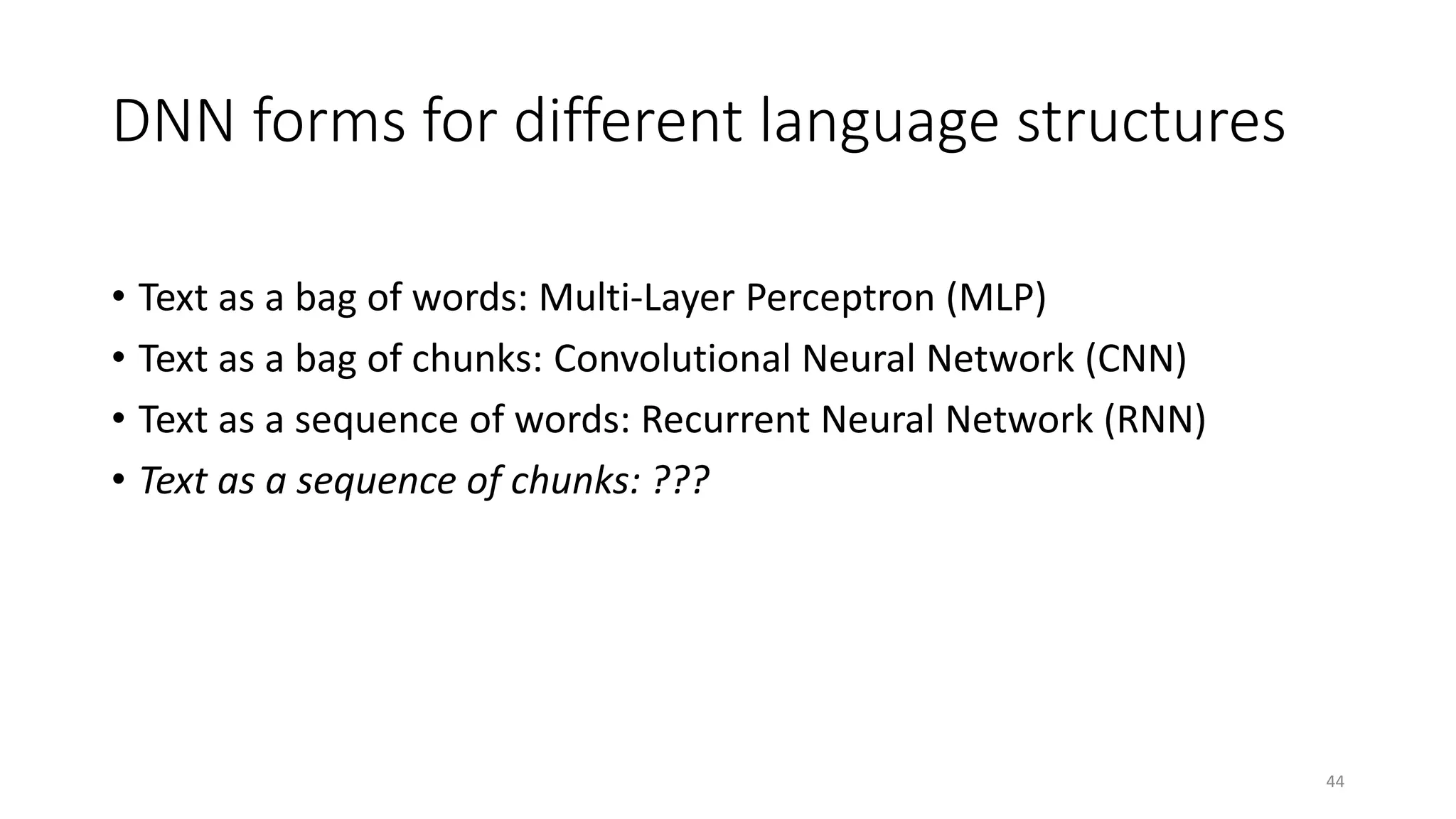
![DNN models for the NLP tasks in this tutorial
• Classification task – label 𝑥𝑥 by 𝑦𝑦
• MLP/CNN/RNN as feature generator
• Ranking task – compute the semantic similarity btw 𝑥𝑥 and 𝑦𝑦
• Siamese neural network [Bromley et al. 1993]
• Deep Semantic Similarity Model (DSSM)
• (Text) Generation task – generate 𝑦𝑦 from 𝑥𝑥
• Seq2Seq (RNN/LSTM)
• Memory Network
• Question answering task
• Neural machine reading models
• Task-completion dialogue
• Deep reinforcement learning for dialogue agents
45](https://image.slidesharecdn.com/mitqptdarkanz785ioot-signature-233d5c007282b08e62cf0f4d0a5dd88f5ed85398db05a93a193537bbc0db97b6-poli-190707174549/75/BIng-NLP-Expert-Dl-summer-school-2017-jianfeng-gao-v2-45-2048.jpg)
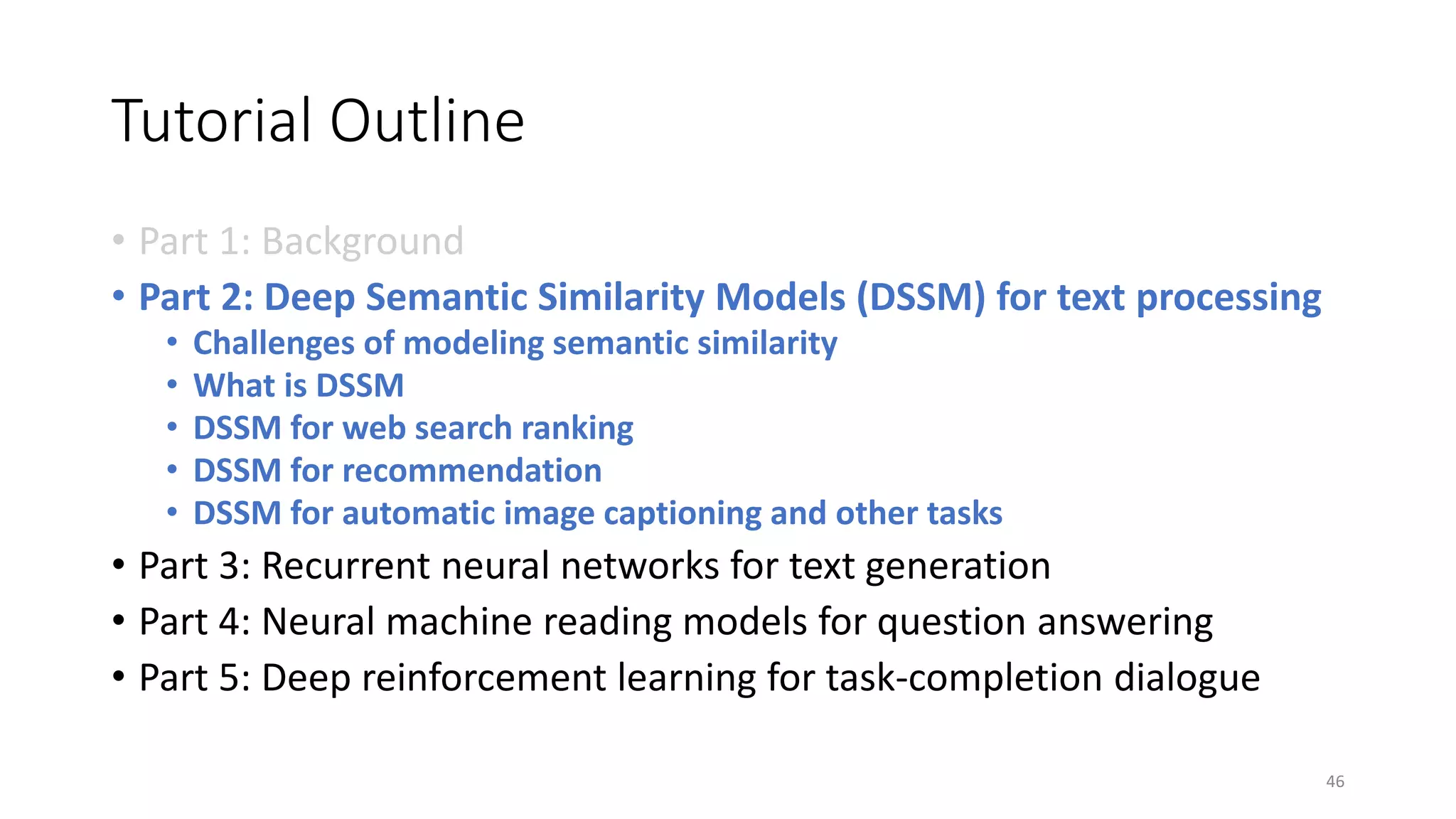
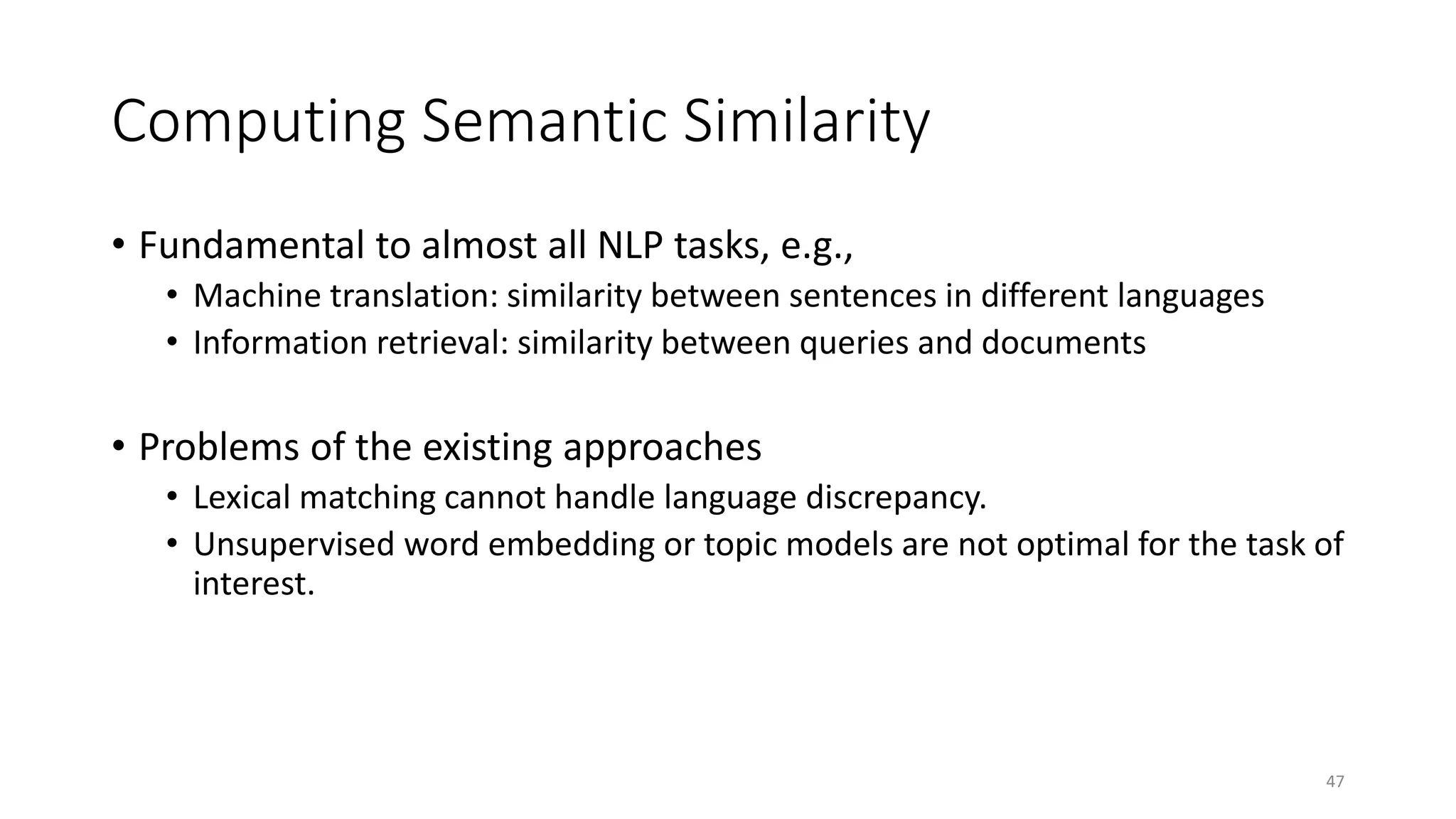
![Deep Semantic Similarity Model (DSSM)
• Compute semantic similarity between two text strings X and Y
• Map X and Y to feature vectors in a latent semantic space via deep neural net
• Compute the cosine similarity between the feature vectors
• Also called “Deep Structured Similarity Model” in [Huang+ 13]
Tasks X Y Ref
Web search Search query Web document Huang+ 13; Shen+ 14; Palangi+ 16
Entity linking Entity mention and context Entity and its corresponding page Gao+ 14b
Online recommendation Doc in reading Interesting things / other docs Gao+ 14b
Image captioning Image Text Fang+ 15
Machine translation Sentence in language A Translations in language B Gao+ 14a
Question answering Question Answer Yih+ 15
Sent2Vec (DSSM) http://aka.ms/sent2vec 48](https://image.slidesharecdn.com/mitqptdarkanz785ioot-signature-233d5c007282b08e62cf0f4d0a5dd88f5ed85398db05a93a193537bbc0db97b6-poli-190707174549/75/BIng-NLP-Expert-Dl-summer-school-2017-jianfeng-gao-v2-48-2048.jpg)
![DSSM for web search ranking
• Task
• Model architecture
• Model training
• Evaluation
• Analysis
[Huang+ 13; Shen+ 14; Palangi+ 16]
49](https://image.slidesharecdn.com/mitqptdarkanz785ioot-signature-233d5c007282b08e62cf0f4d0a5dd88f5ed85398db05a93a193537bbc0db97b6-poli-190707174549/75/BIng-NLP-Expert-Dl-summer-school-2017-jianfeng-gao-v2-49-2048.jpg)
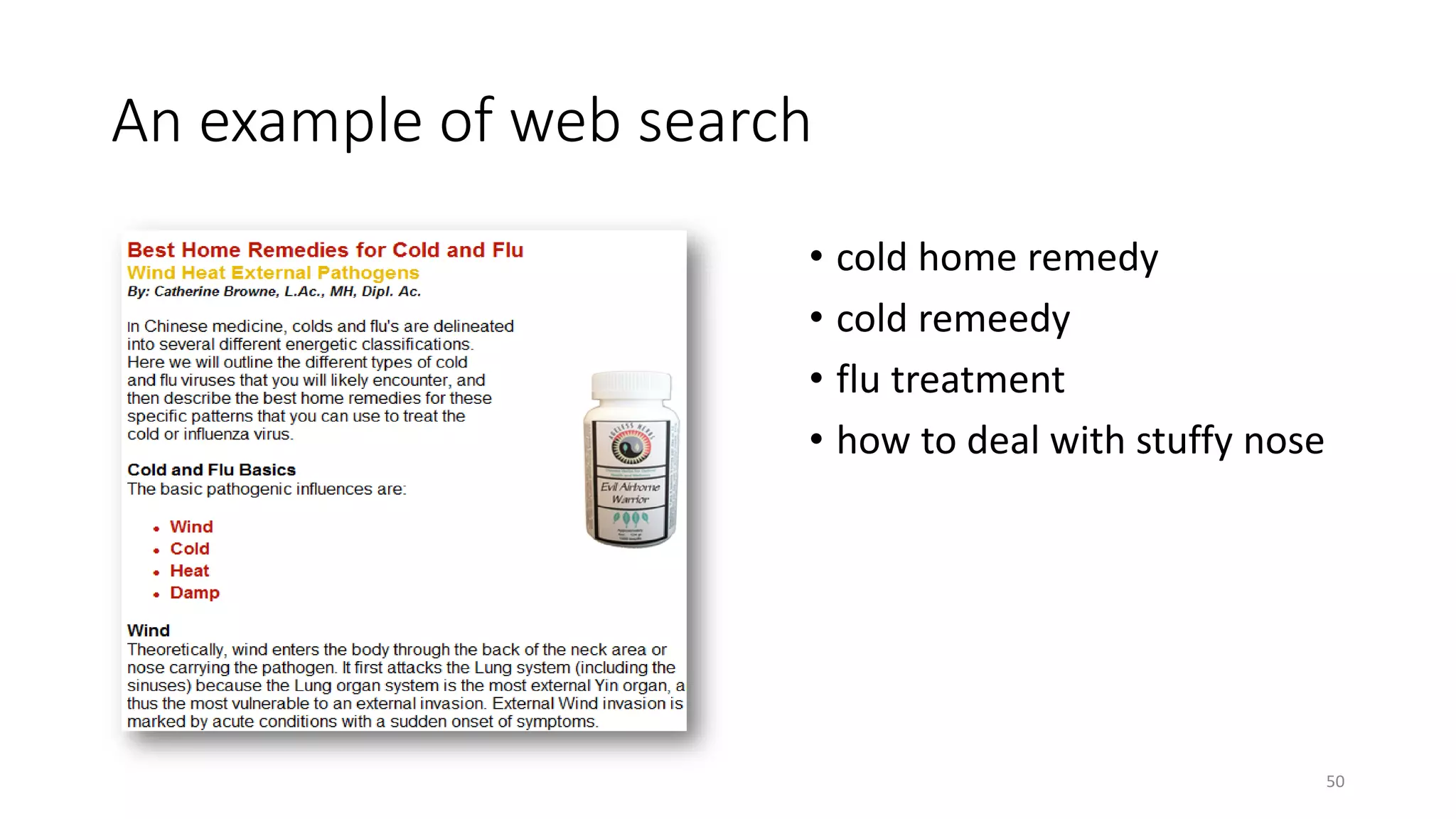

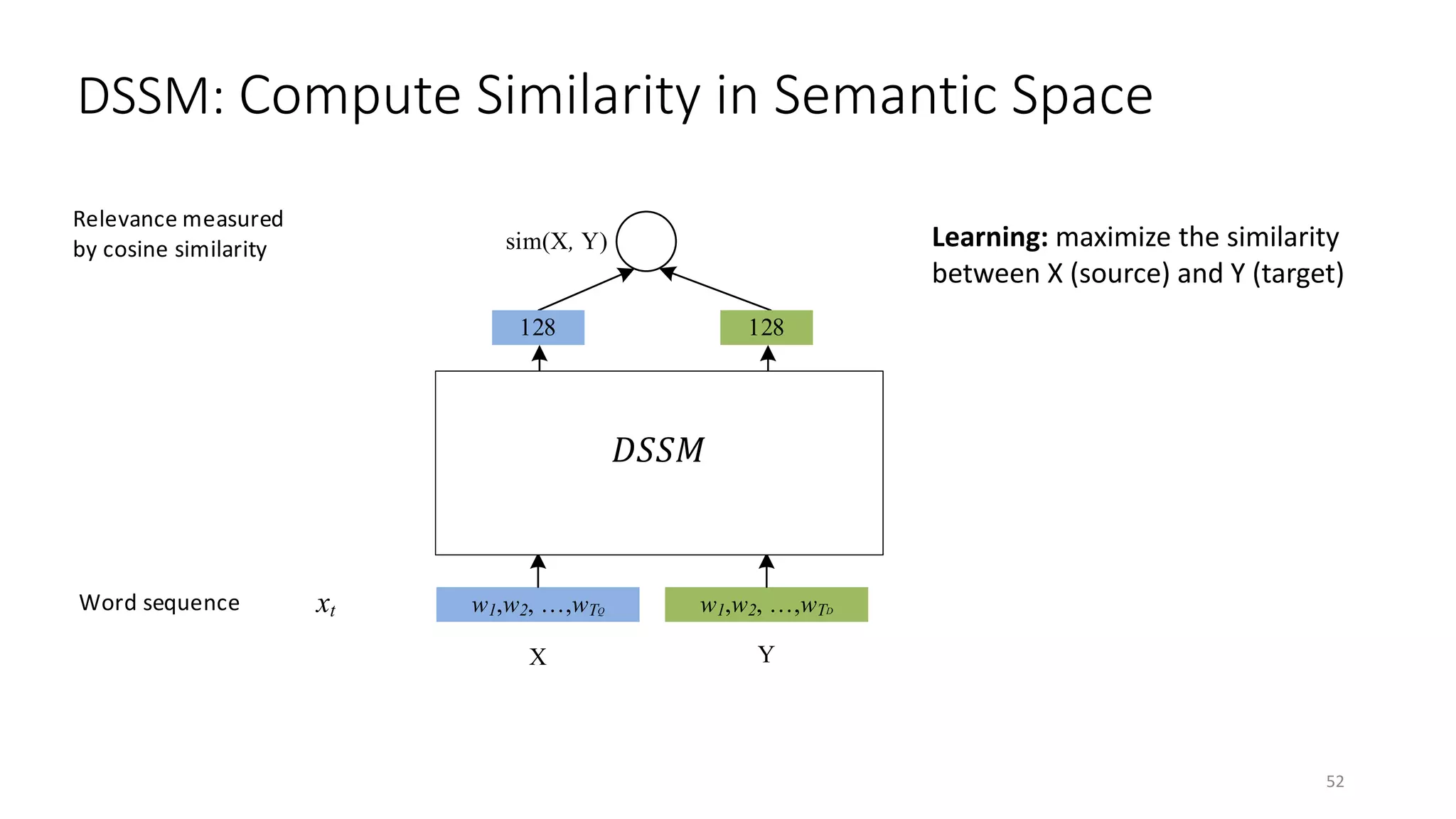
![xt
ft
ct
v
h
Word sequence
Word hashing layer
Convolutional layer
Semantic layer
Relevance measured
by cosine similarity
Max pooling layer
w1,w2, …,wTQ
f1 , f2 , …, fTQ
300
300
128
...
sim(X, Y)
w1,w2, …,wTD
f1 , f2 , …, fTD1
300
300
128
...
X Y
DSSM: Compute Similarity in Semantic Space
Learning: maximize the similarity
between X (source) and Y (target)
Representation: use DNN to extract
abstract semantic features, 𝑓𝑓 or 𝑔𝑔 is a
• Multi-Layer Perceptron (MLP) if text is a
bag of words [Huang+ 13]
• Convolutional Neural Network (CNN) if
text is a bag of chunks [Shen+ 14]
• Recurrent Neural Network (RNN) if text is
a sequence of words [Palangi+ 16]
𝑔𝑔(. )𝑓𝑓(. )
53](https://image.slidesharecdn.com/mitqptdarkanz785ioot-signature-233d5c007282b08e62cf0f4d0a5dd88f5ed85398db05a93a193537bbc0db97b6-poli-190707174549/75/BIng-NLP-Expert-Dl-summer-school-2017-jianfeng-gao-v2-53-2048.jpg)
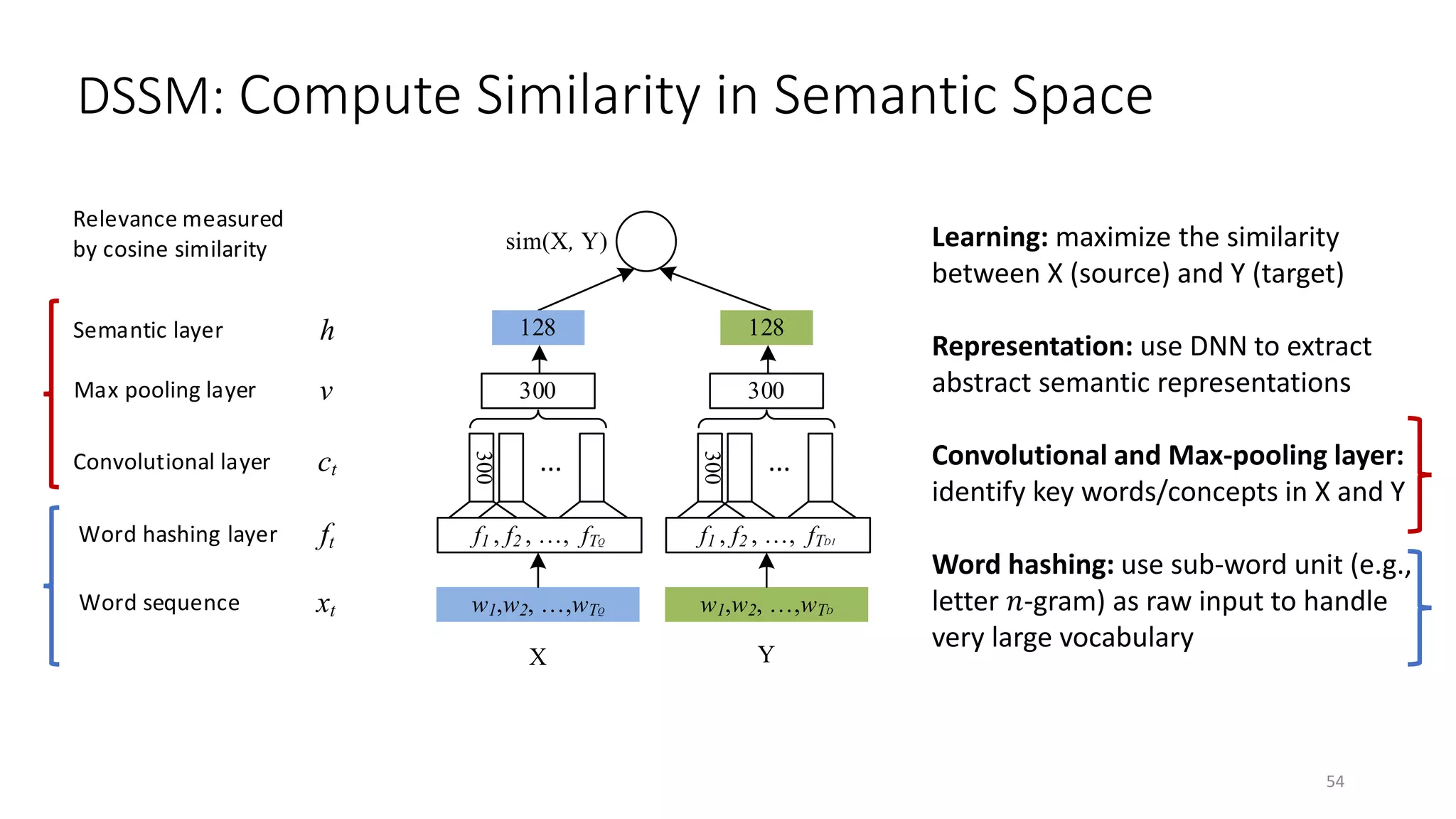
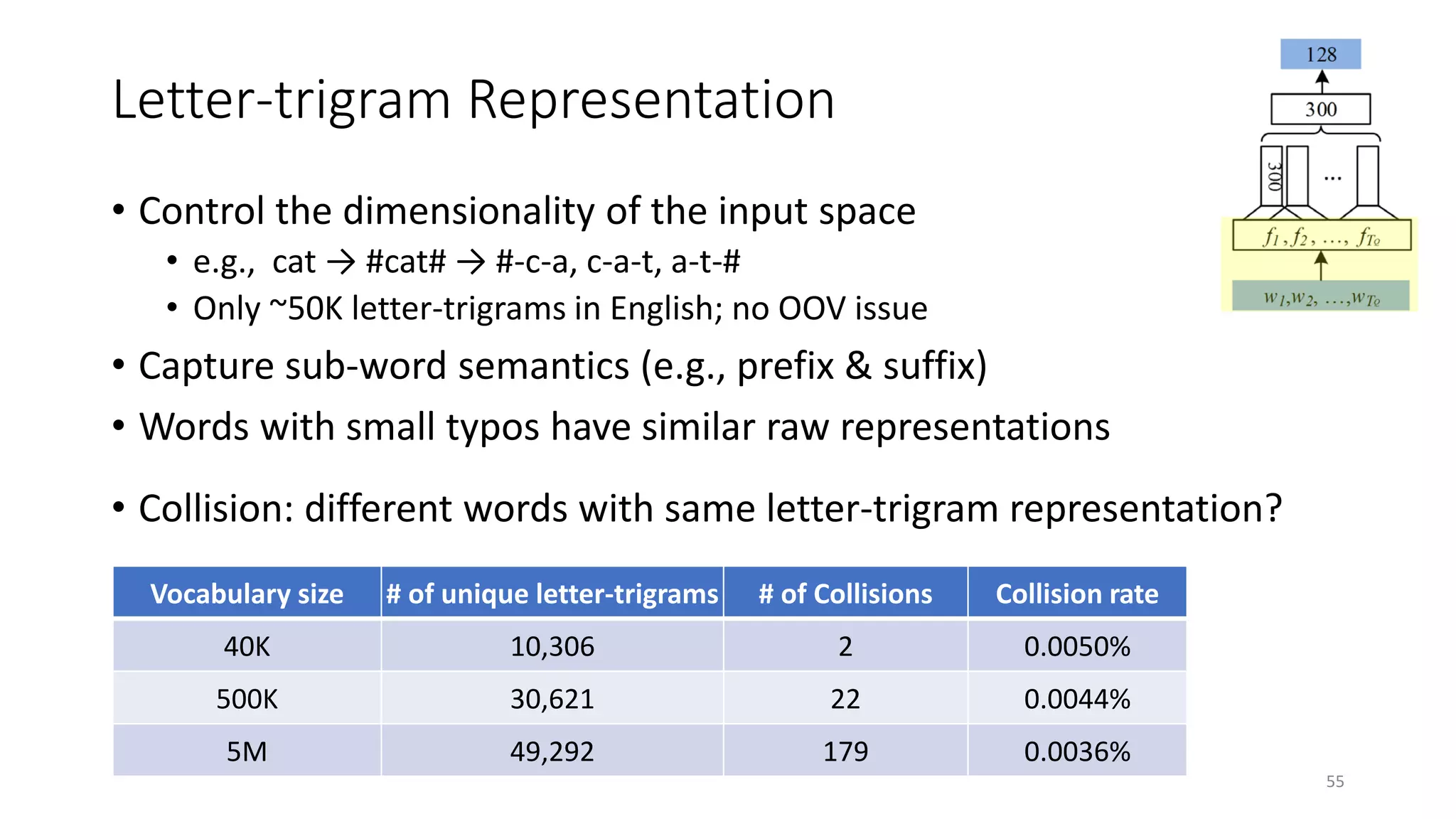

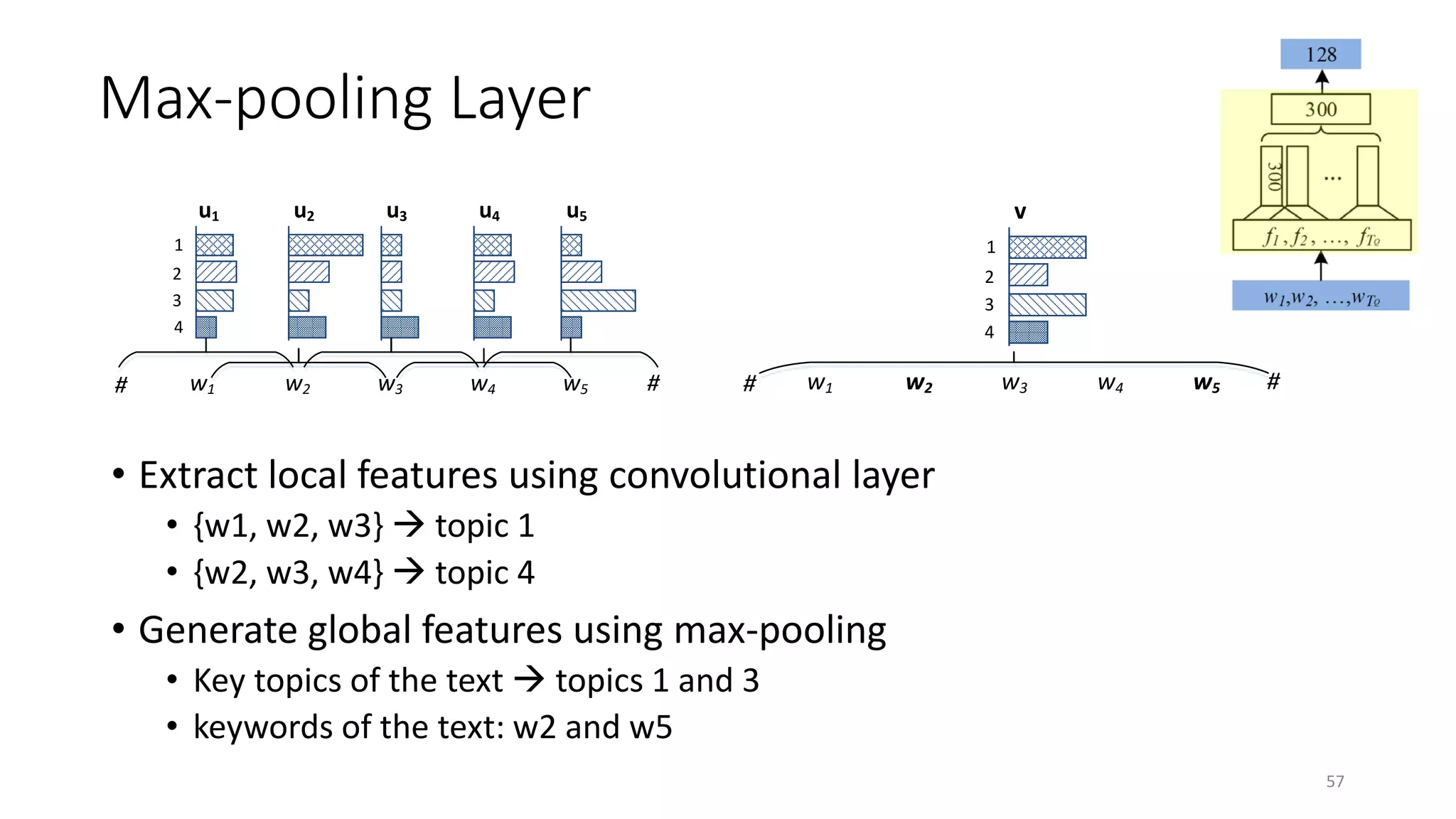
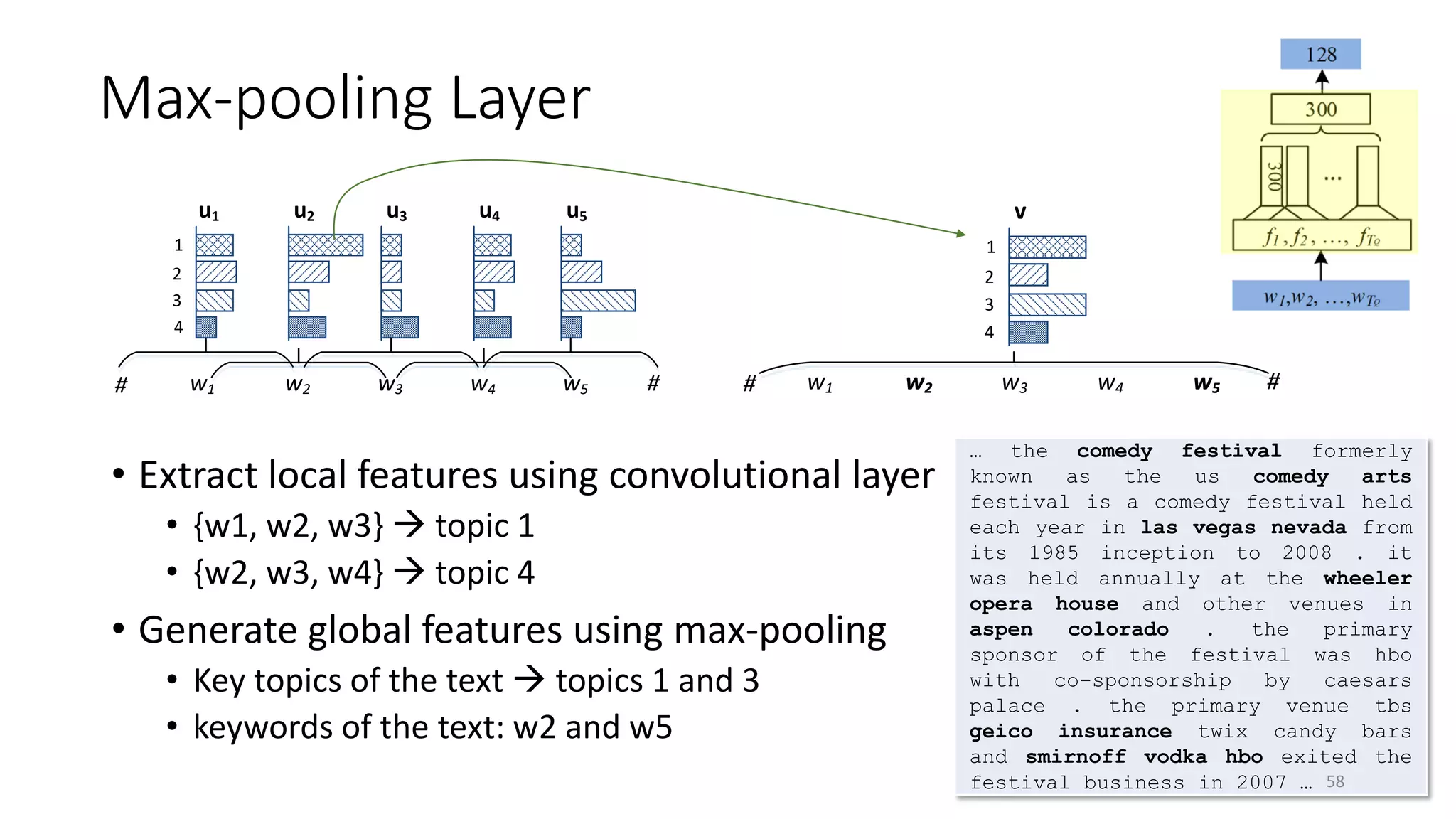
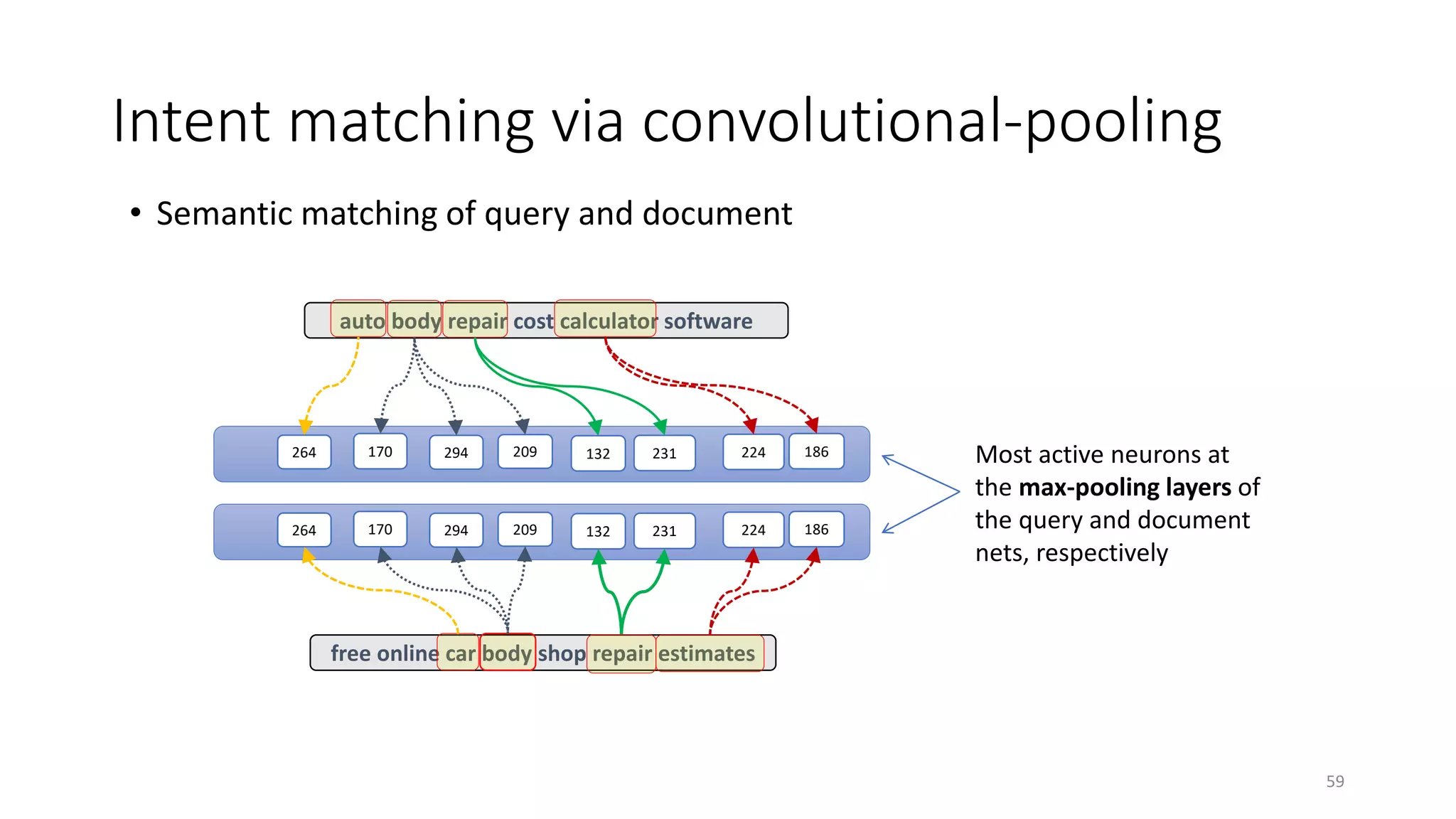
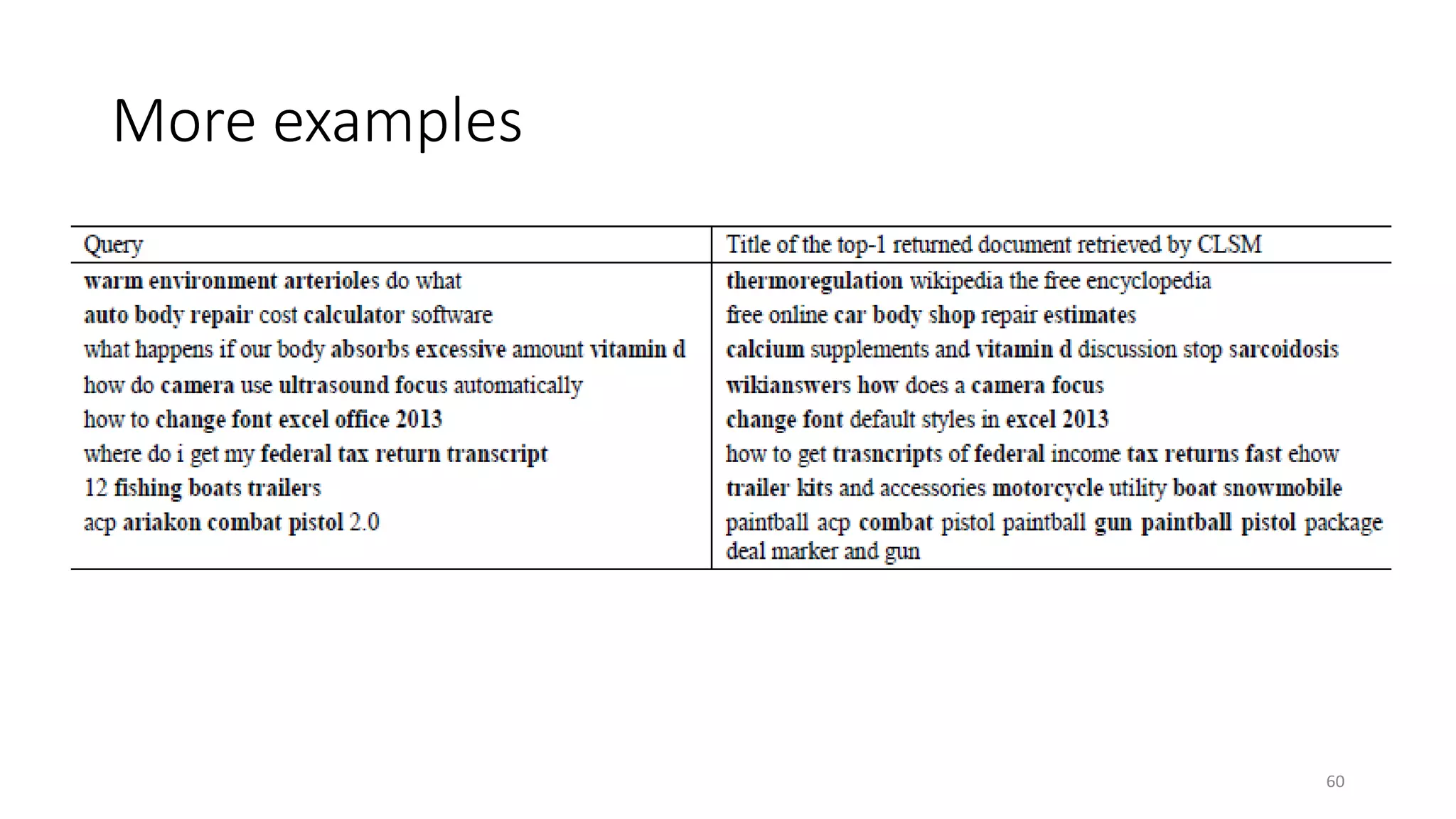
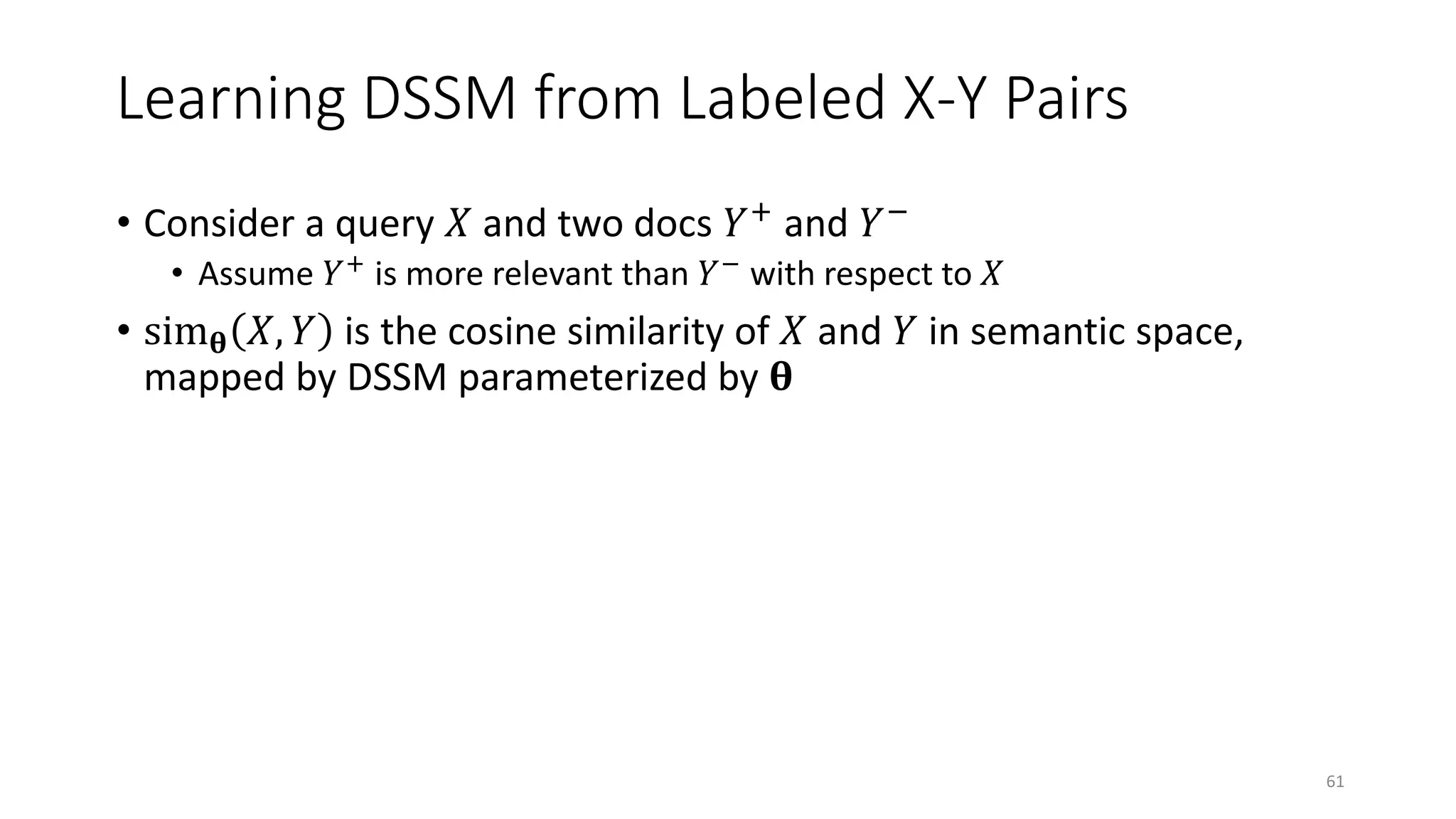

![Mine “labeled” X-Y pairs from search logs
http://www.agelessherbs.com/BestHome
RemediesColdFlu.html
NO CLICK
NO CLICK
how to deal with stuffy nose?
stuffy nose treatment
cold home remedies
[Gao+ 10]
63](https://image.slidesharecdn.com/mitqptdarkanz785ioot-signature-233d5c007282b08e62cf0f4d0a5dd88f5ed85398db05a93a193537bbc0db97b6-poli-190707174549/75/BIng-NLP-Expert-Dl-summer-school-2017-jianfeng-gao-v2-63-2048.jpg)
![how to deal with stuffy nose?
stuffy nose treatment
cold home remedies
Mine “labeled” X-Y pairs from search logs
[Gao+ 10]
64](https://image.slidesharecdn.com/mitqptdarkanz785ioot-signature-233d5c007282b08e62cf0f4d0a5dd88f5ed85398db05a93a193537bbc0db97b6-poli-190707174549/75/BIng-NLP-Expert-Dl-summer-school-2017-jianfeng-gao-v2-64-2048.jpg)
![how to deal with stuffy nose?
stuffy nose treatment
cold home remedies
QUERY (Q) Title (T)
how to deal with stuffy nose best home remedies for cold and flu
stuffy nose treatment best home remedies for cold and flu
cold home remedies best home remedies for cold and flu
… … … …
go israel forums goisrael community
skate at wholesale at pr wholesale skates southeastern skate supply
breastfeeding nursing blister baby clogged milk ducts babycenter
thank you teacher song lyrics for teaching educational children s music
immigration canada lacolle cbsa office detailed information
Mine “labeled” X-Y pairs from search logs
[Gao+ 10]
65](https://image.slidesharecdn.com/mitqptdarkanz785ioot-signature-233d5c007282b08e62cf0f4d0a5dd88f5ed85398db05a93a193537bbc0db97b6-poli-190707174549/75/BIng-NLP-Expert-Dl-summer-school-2017-jianfeng-gao-v2-65-2048.jpg)
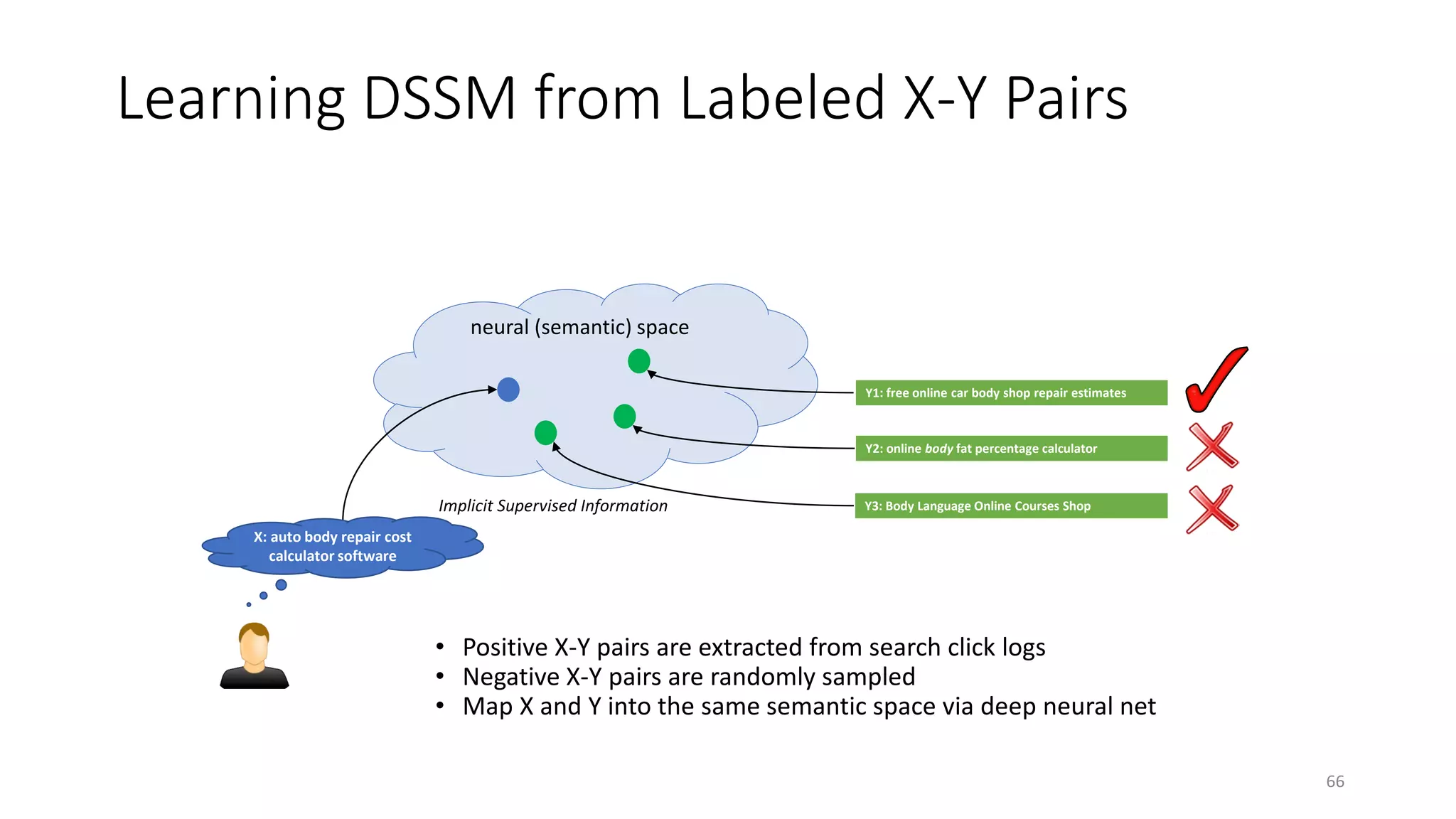
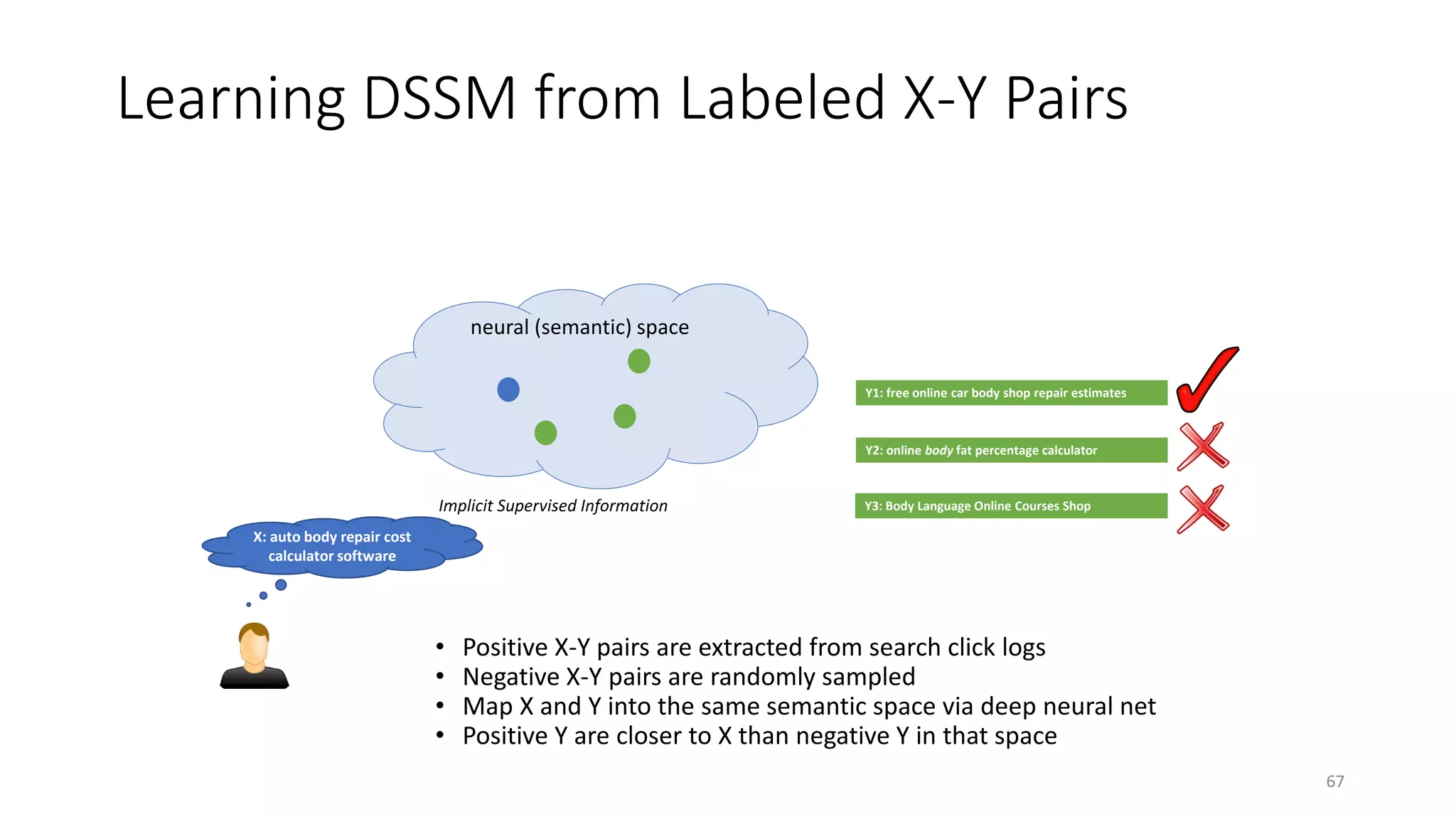
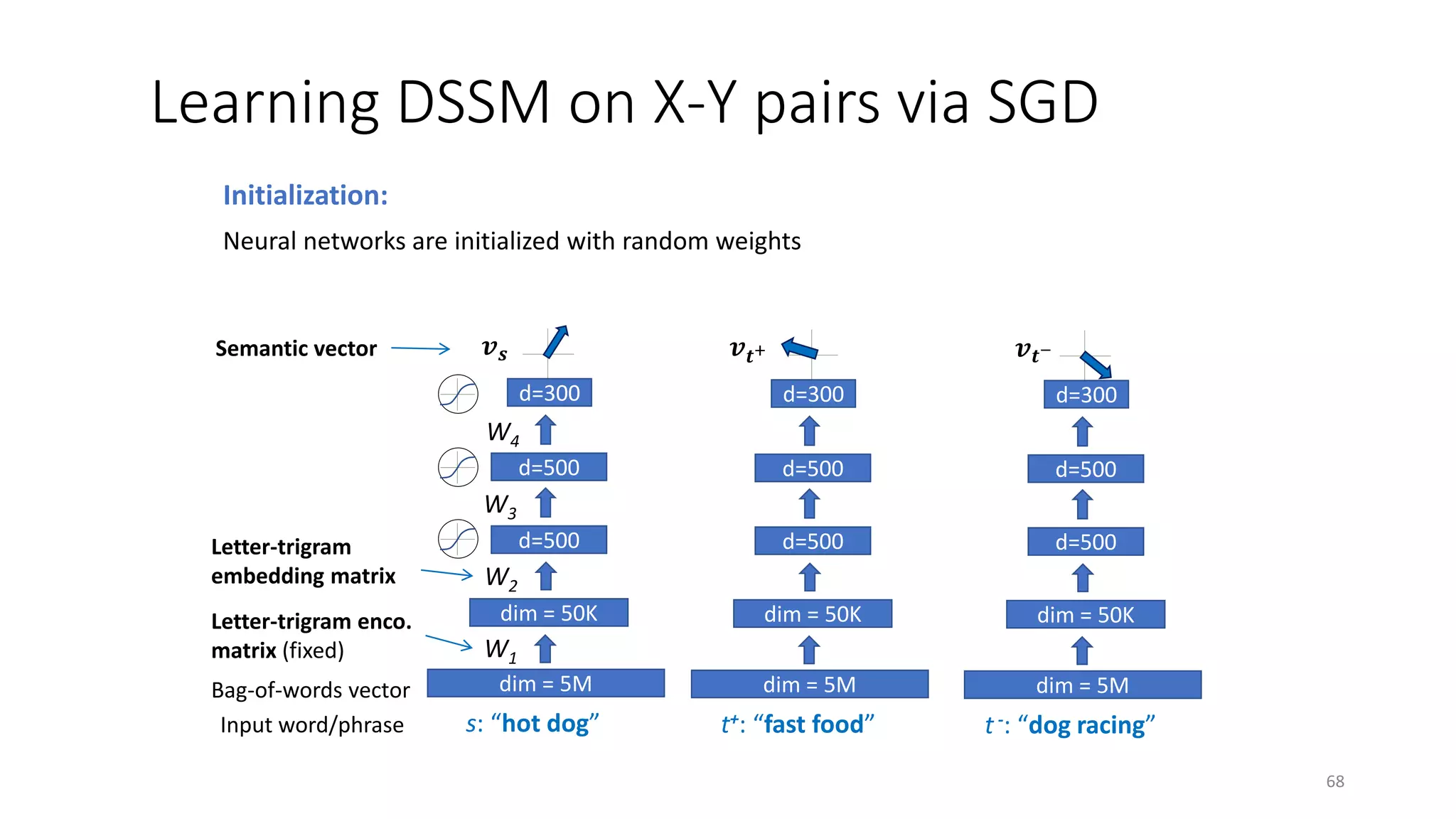
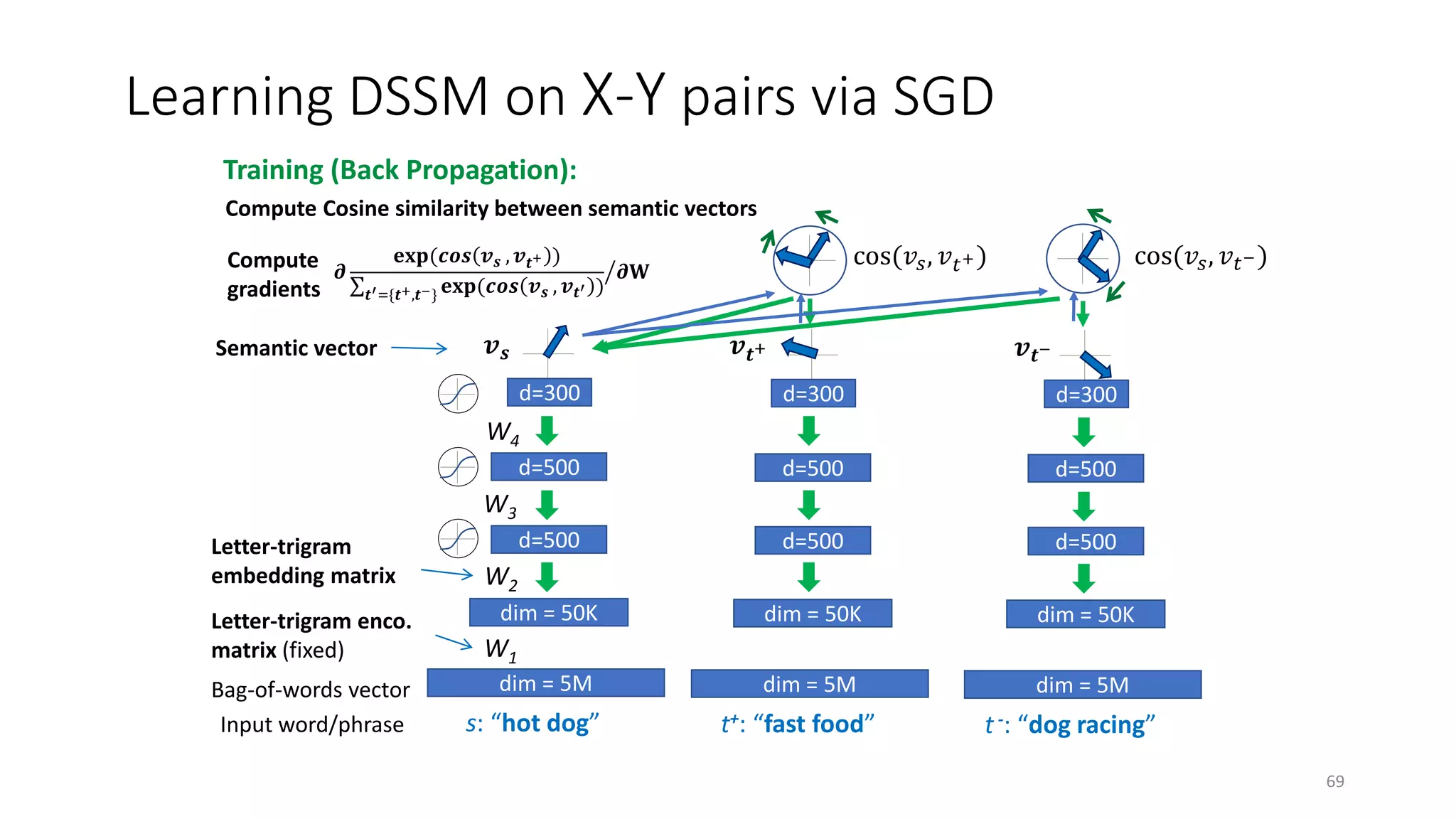
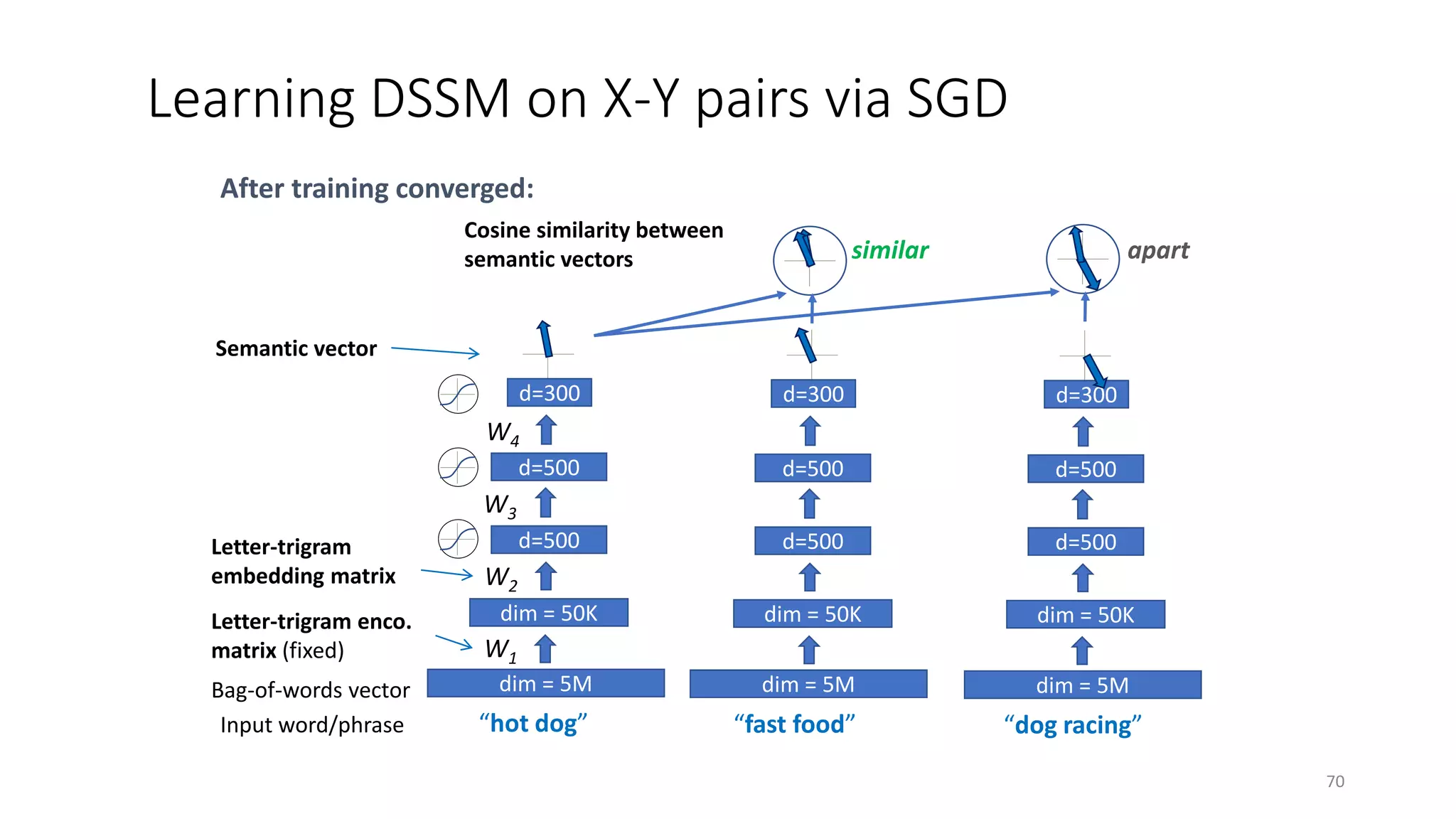
![Evaluation Methodology
• Measurement: NDCG, t-test
• Test set:
• 12,071 English queries sampled from 1-y log
• 5-level relevance label for each query-doc pair
• Training data for translation models:
• 82,834,648 query-title pairs
• Baselines
• Lexicon matching models: BM25, ULM
• Translation models [Gao+ 10]
• Topic models [Hofmann 99; Blei+ 03; Gao+ 11]
• Deep auto-encoder [Hinton & Salakhutdinov 10]
71](https://image.slidesharecdn.com/mitqptdarkanz785ioot-signature-233d5c007282b08e62cf0f4d0a5dd88f5ed85398db05a93a193537bbc0db97b6-poli-190707174549/75/BIng-NLP-Expert-Dl-summer-school-2017-jianfeng-gao-v2-71-2048.jpg)
![Translation models for web search
• Leverage statistical machine translation (SMT) technologies and
infrastructures to improve search relevance
• Model documents and queries as different languages, cast mapping
queries to documents as bridging the language gap via translation
• Given a Q, D can be ranked by how likely it is that Q is “translated”
from D, 𝑃𝑃(Q|D)
• Word translation model
• Phrase translation model
[Gao+ 10]
72](https://image.slidesharecdn.com/mitqptdarkanz785ioot-signature-233d5c007282b08e62cf0f4d0a5dd88f5ed85398db05a93a193537bbc0db97b6-poli-190707174549/75/BIng-NLP-Expert-Dl-summer-school-2017-jianfeng-gao-v2-72-2048.jpg)
![Generative Topic Models
• Probabilistic latent Semantic Analysis (PLSA)
• 𝑃𝑃 Q D = ∏𝑞𝑞∈Q ∑𝑧𝑧 𝑃𝑃 𝑞𝑞 𝝓𝝓𝑧𝑧 𝑃𝑃(𝑧𝑧|D, 𝜽𝜽)
• D is assigned a single most likely topic vector
• Q is generated from the topic vectors
• Latent Dirichlet Allocation (LDA) generalizes PLSA
• a posterior distribution over topic vectors is used
• PLSA = LDA with MAP inference
Q: stuffy nose treatment D: cold home remediesTopic
Q: stuffy nose treatment D: cold home remedies
[Hofmann 99; Blei+ 03]
73](https://image.slidesharecdn.com/mitqptdarkanz785ioot-signature-233d5c007282b08e62cf0f4d0a5dd88f5ed85398db05a93a193537bbc0db97b6-poli-190707174549/75/BIng-NLP-Expert-Dl-summer-school-2017-jianfeng-gao-v2-73-2048.jpg)
![Bilingual topic model for web search
• For each topic z: 𝝓𝝓𝑧𝑧
Q
, 𝝓𝝓𝑧𝑧
D ~ Dir(𝜷𝜷)
• For each Q-D pair: 𝜽𝜽 ~ Dir(𝜶𝜶)
• Each q is generated by 𝑧𝑧 ~ 𝜽𝜽 and 𝑞𝑞 ~ 𝝓𝝓𝑧𝑧
Q
• Each w is generated by 𝑧𝑧 ~ 𝜽𝜽 and 𝑤𝑤 ~ 𝝓𝝓𝑧𝑧
D
[Gao+ 11]
74](https://image.slidesharecdn.com/mitqptdarkanz785ioot-signature-233d5c007282b08e62cf0f4d0a5dd88f5ed85398db05a93a193537bbc0db97b6-poli-190707174549/75/BIng-NLP-Expert-Dl-summer-school-2017-jianfeng-gao-v2-74-2048.jpg)
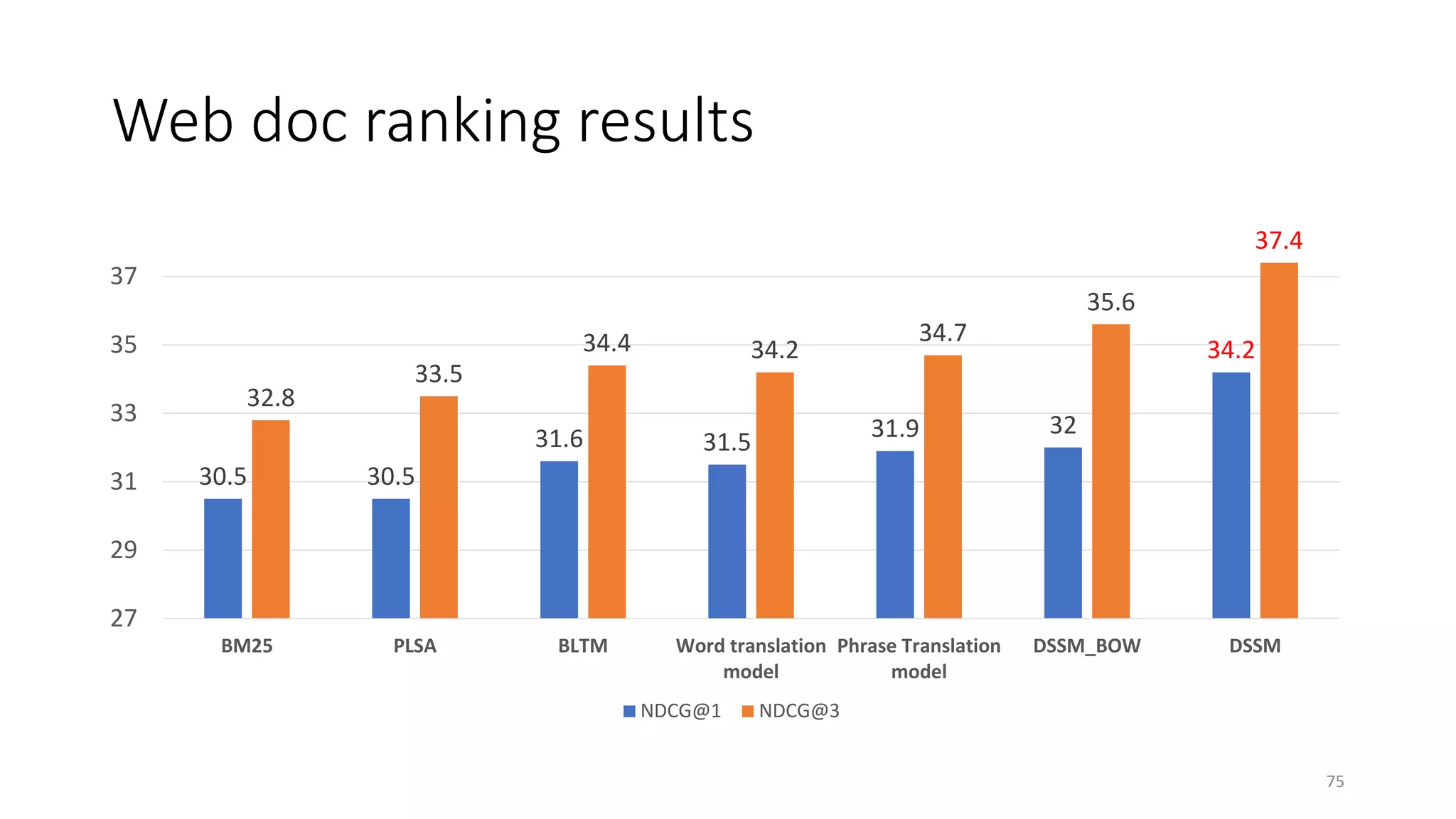
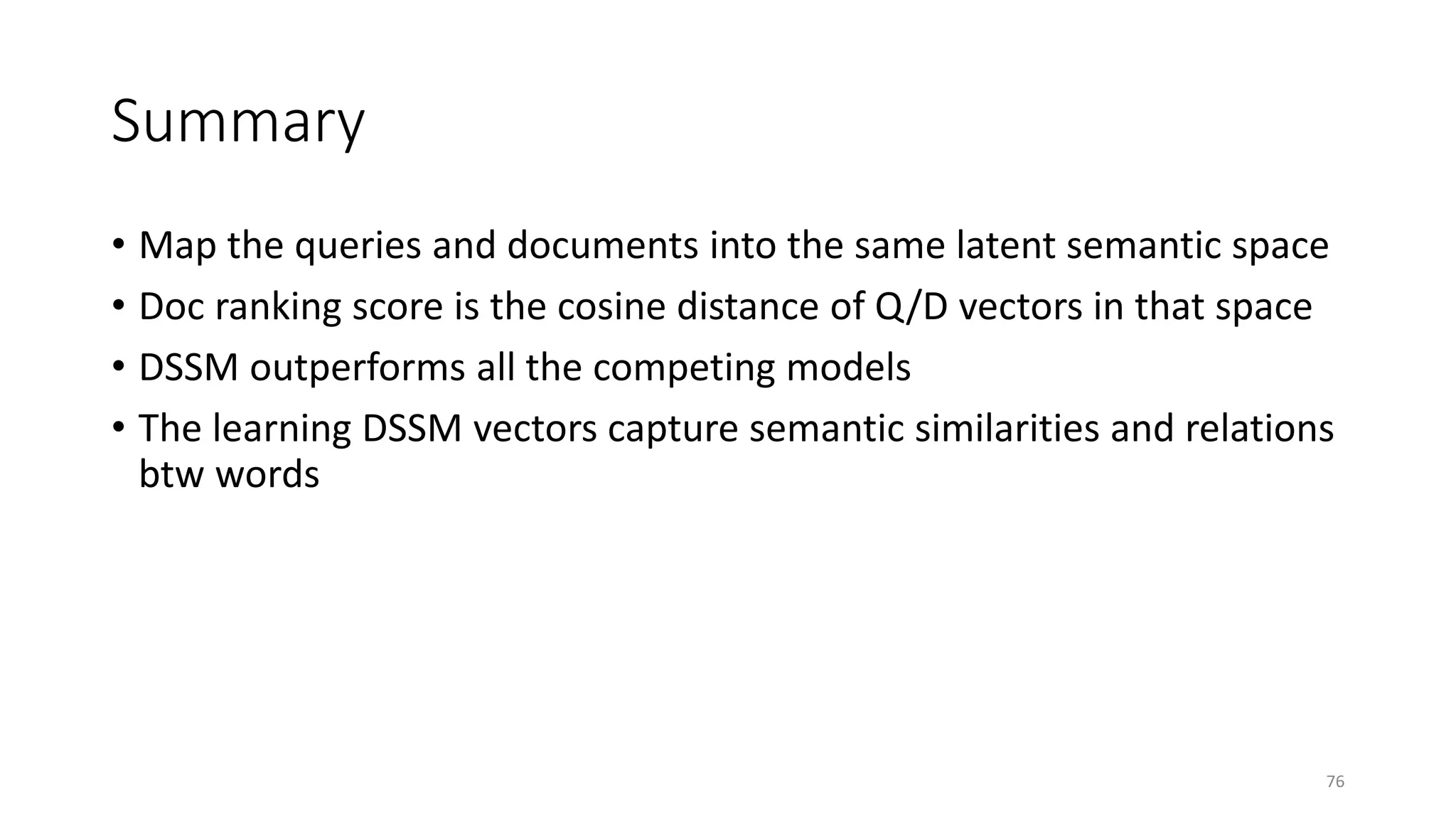
![DSSM for recommendation
• Two interestingness tasks for recommendation
• Modeling interestingness via DSSM
• Training data acquisition
• Evaluation
• Summary
[Gao+ 14b]
77](https://image.slidesharecdn.com/mitqptdarkanz785ioot-signature-233d5c007282b08e62cf0f4d0a5dd88f5ed85398db05a93a193537bbc0db97b6-poli-190707174549/75/BIng-NLP-Expert-Dl-summer-school-2017-jianfeng-gao-v2-77-2048.jpg)
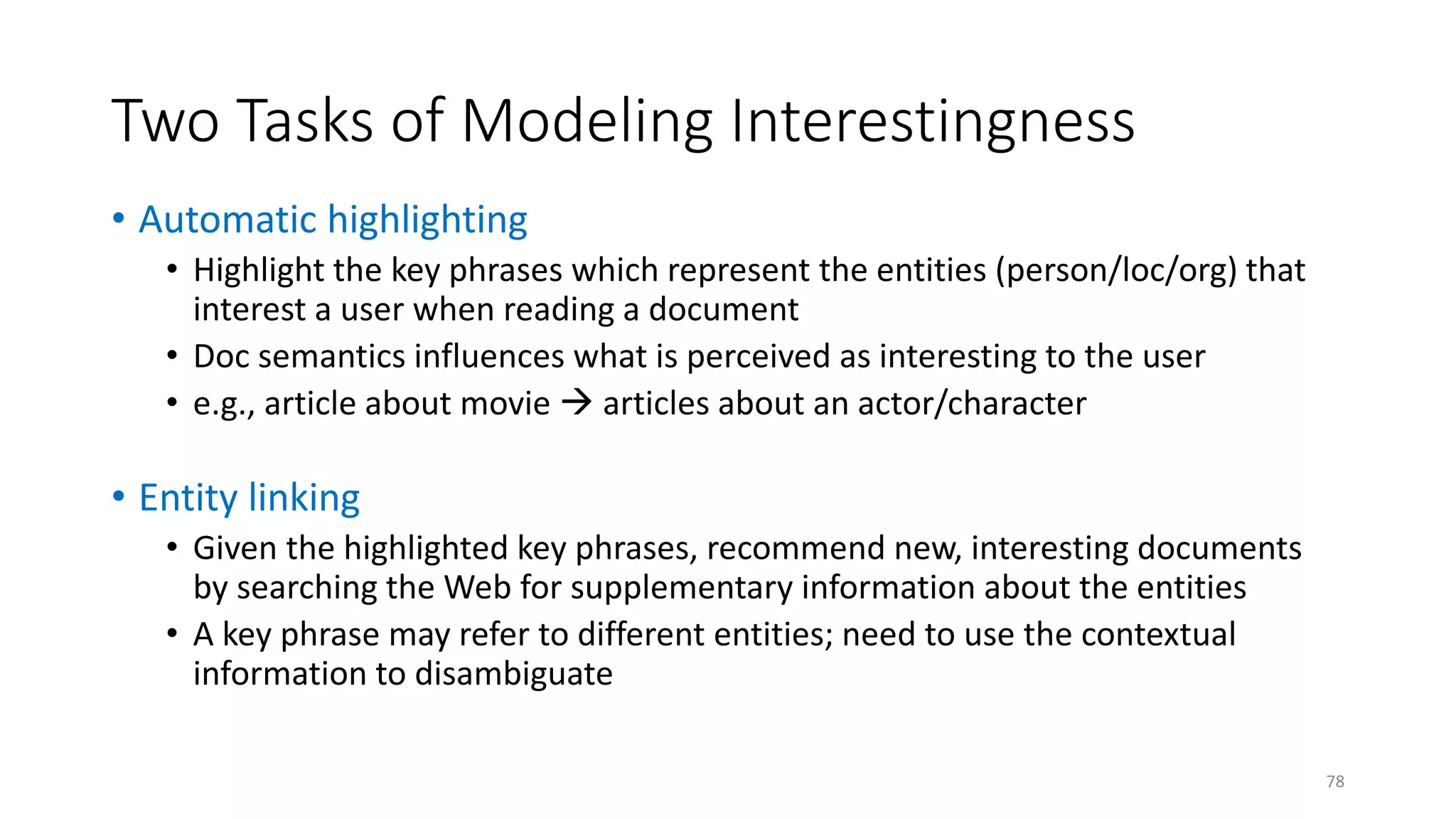
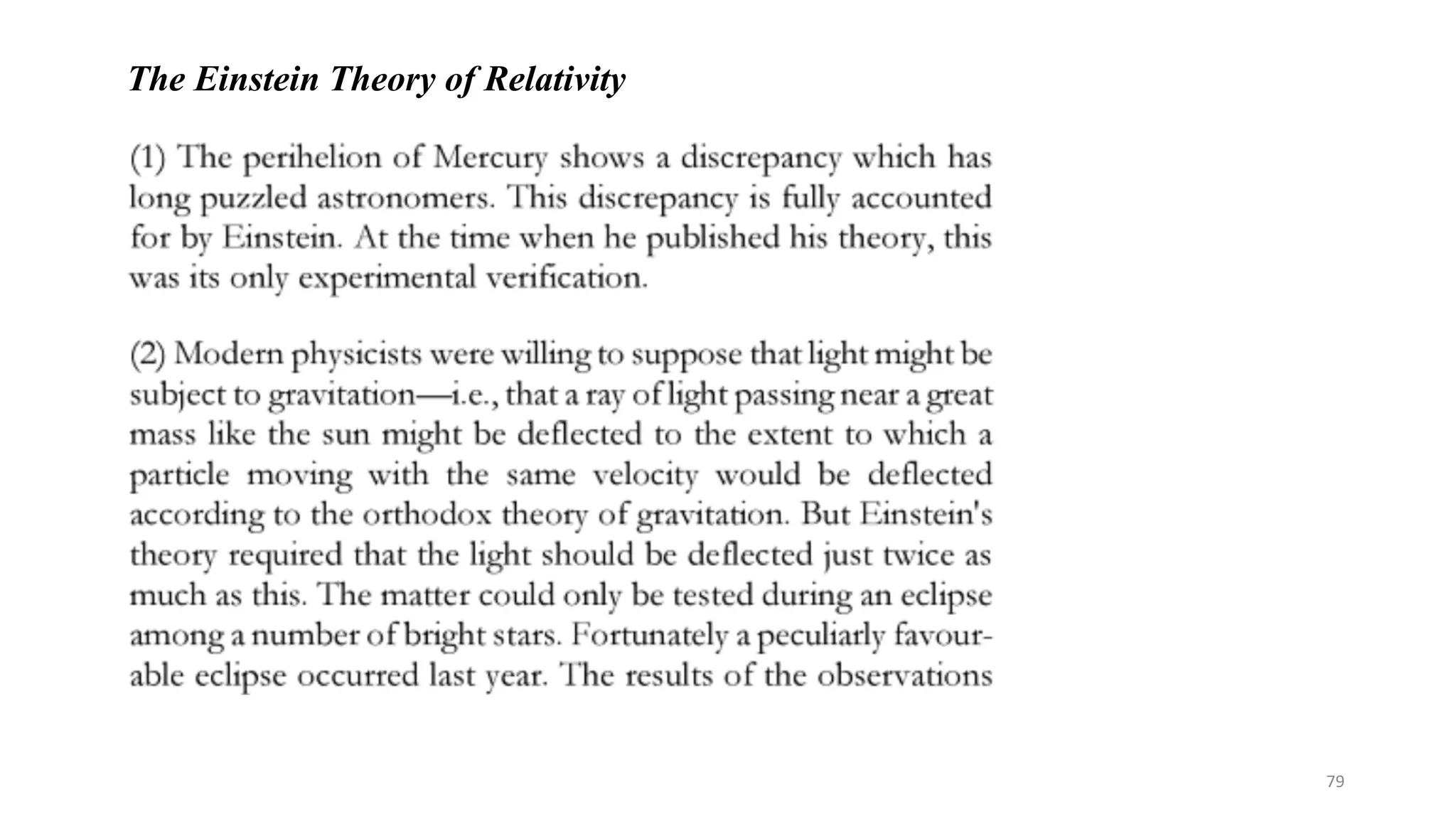
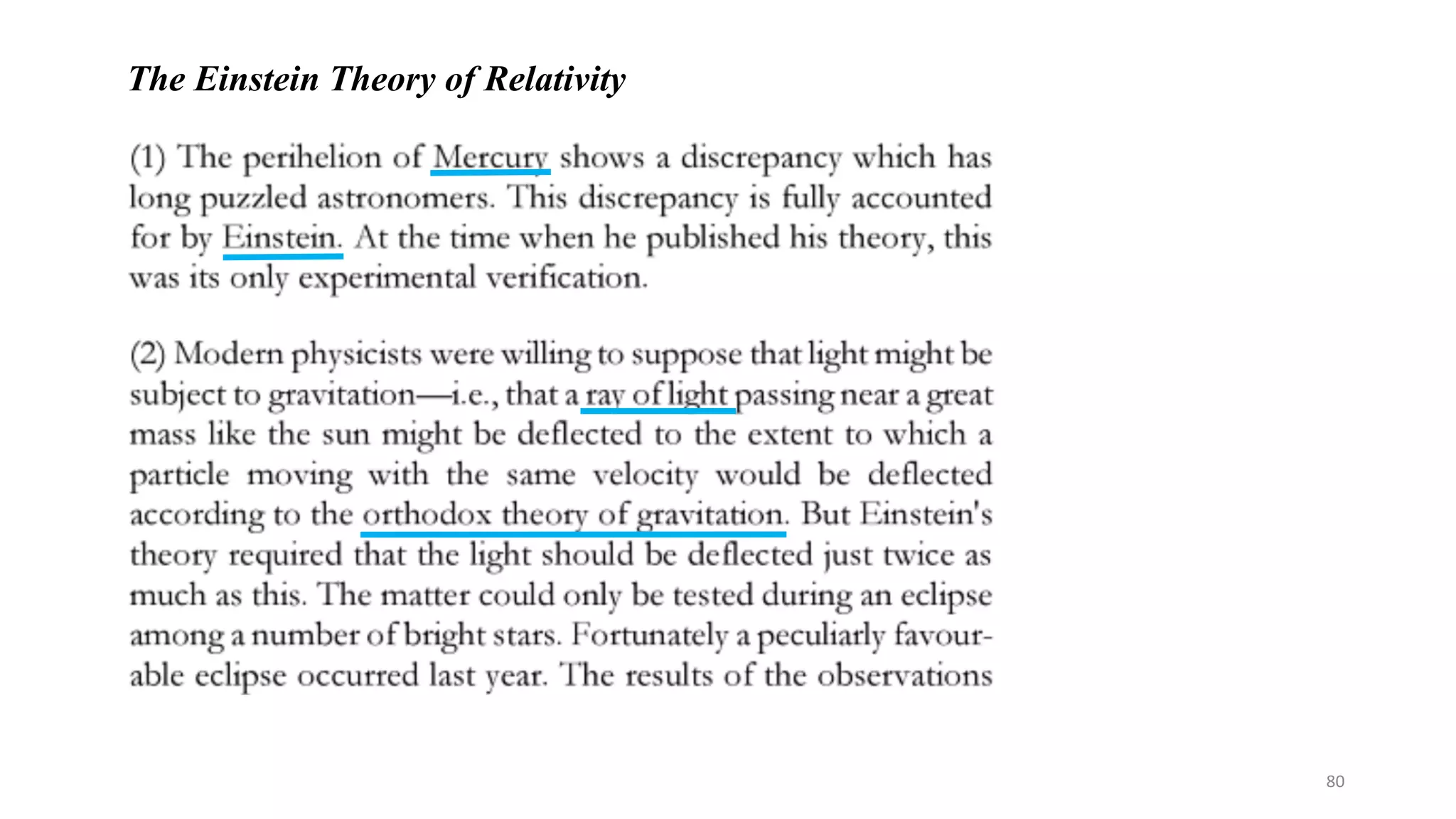
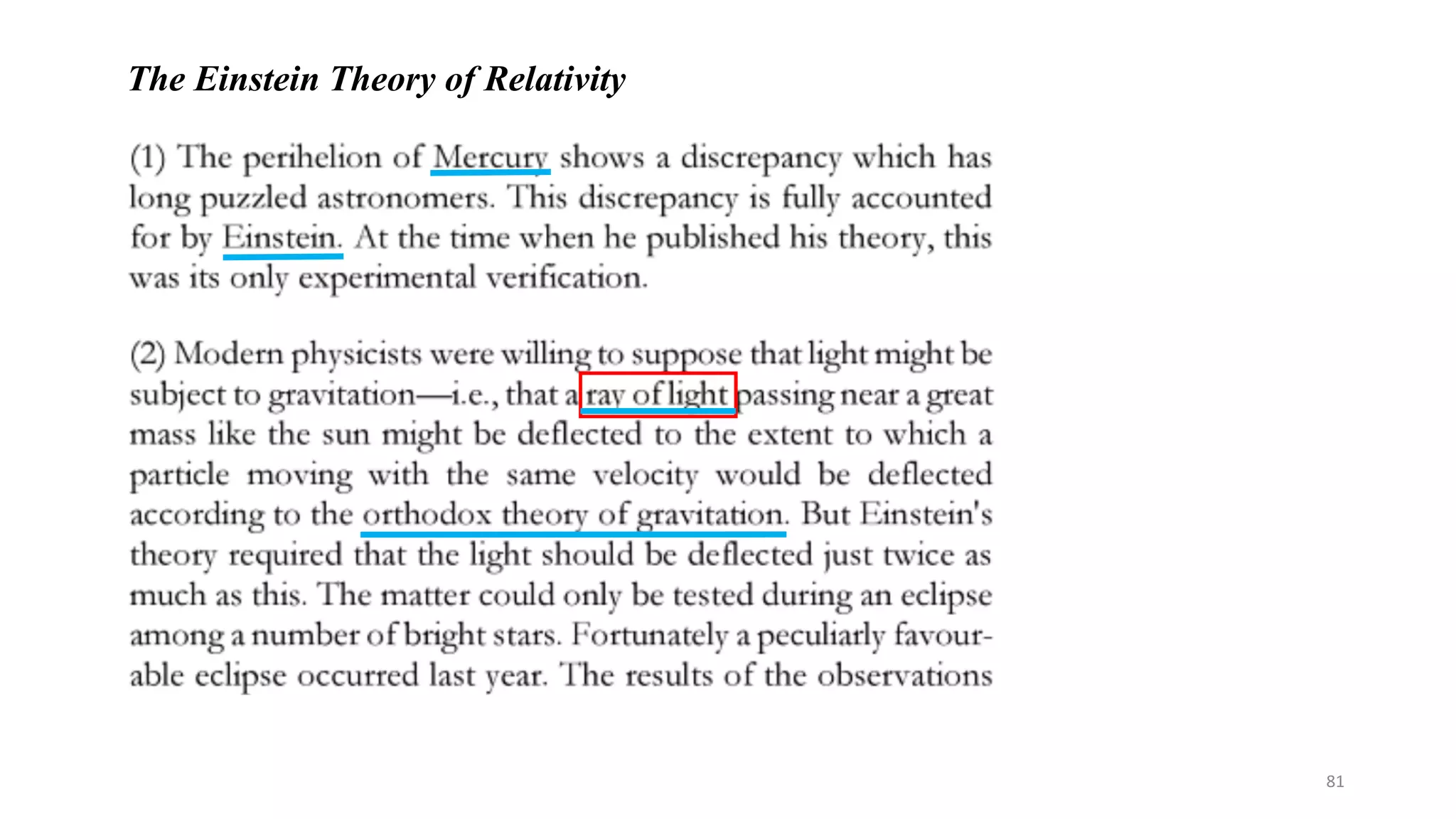
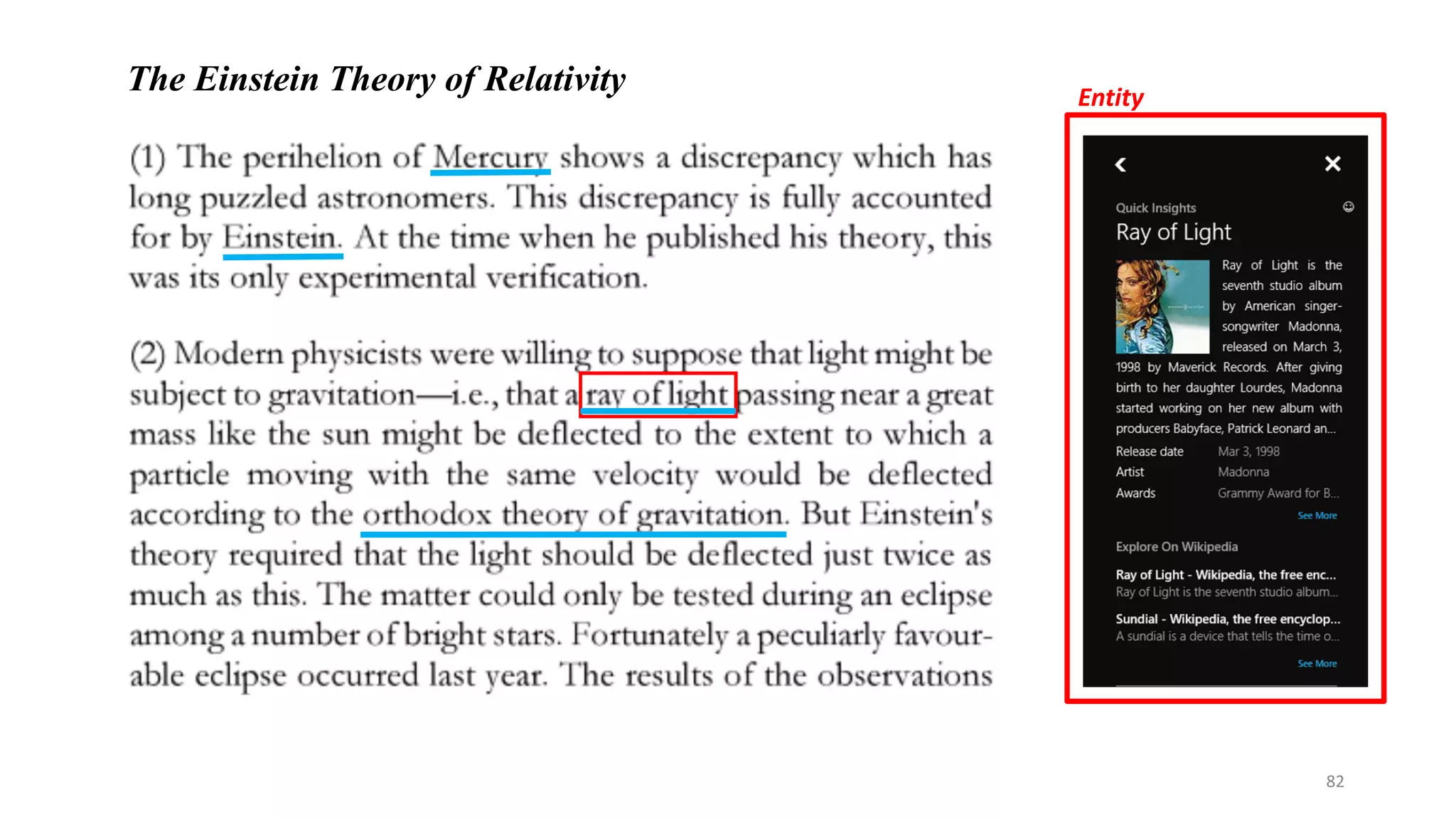
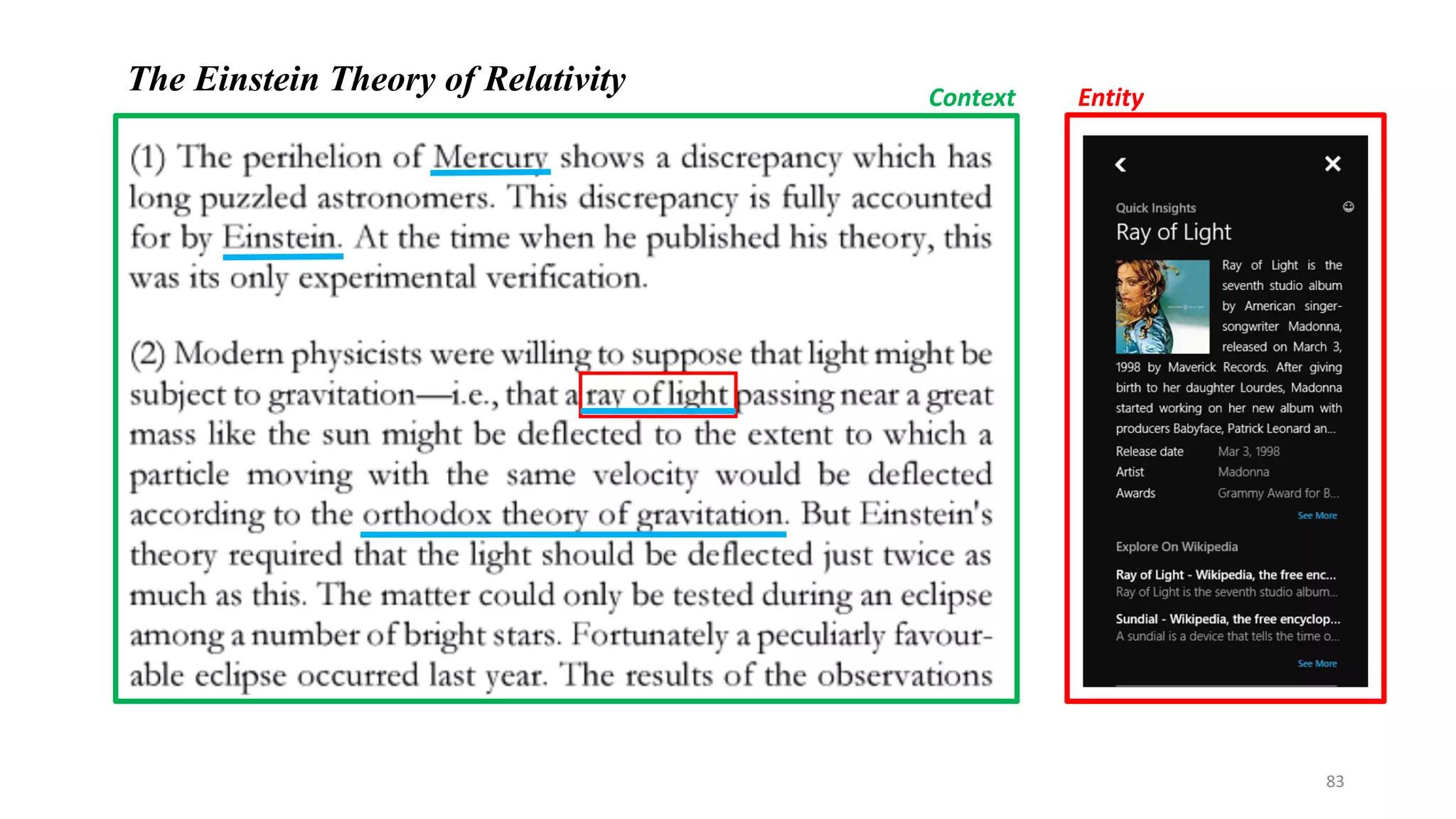

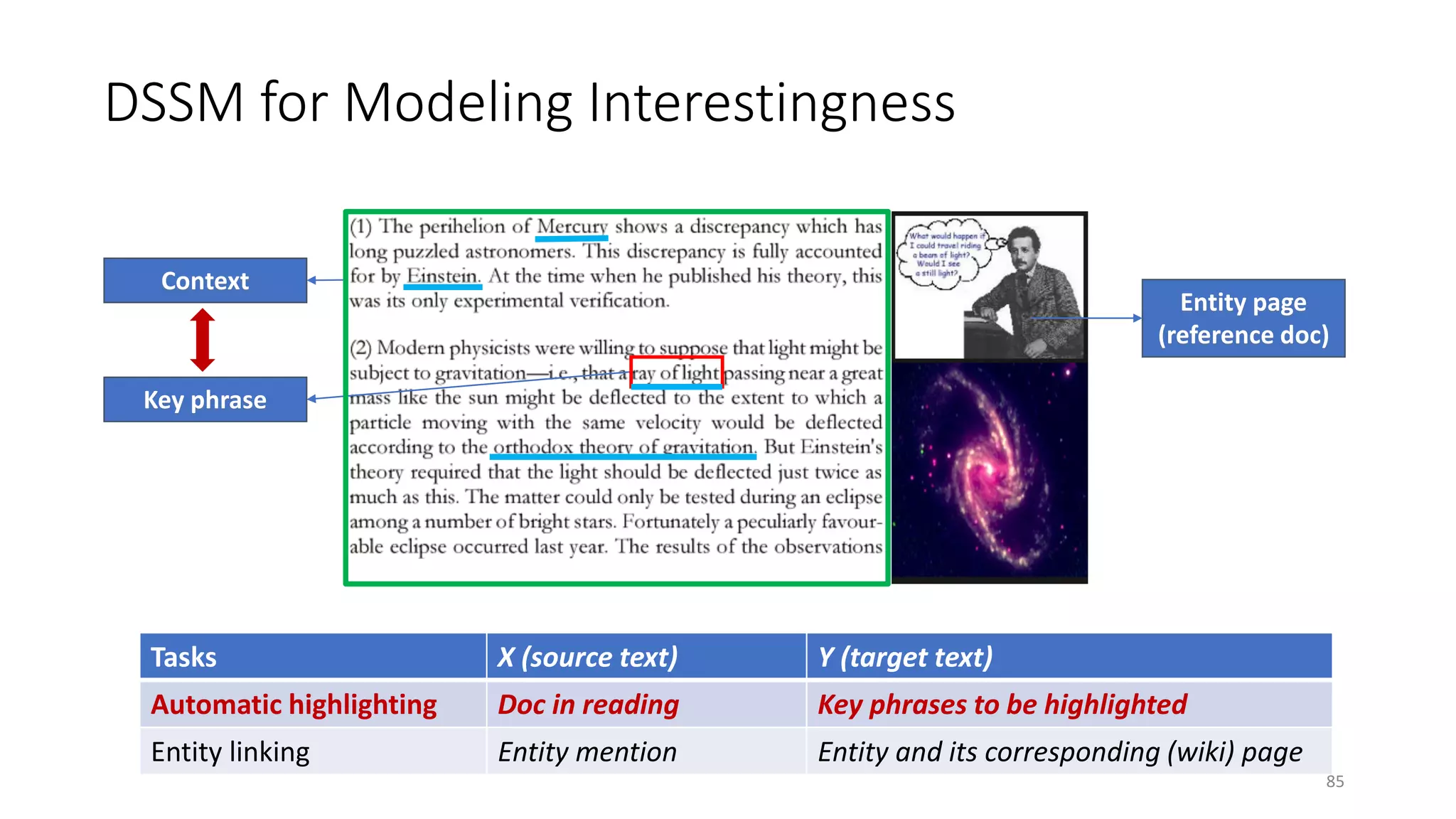
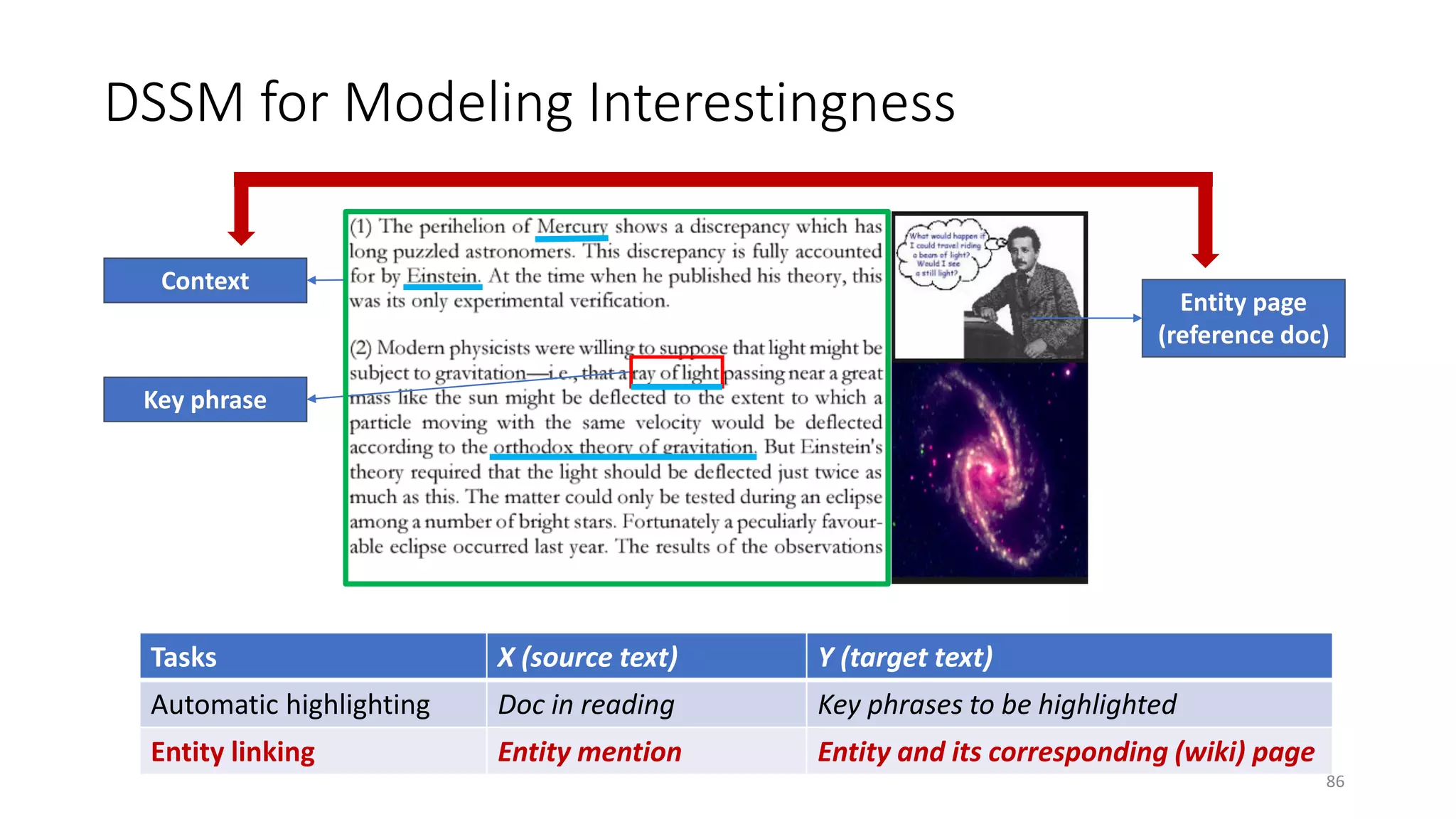
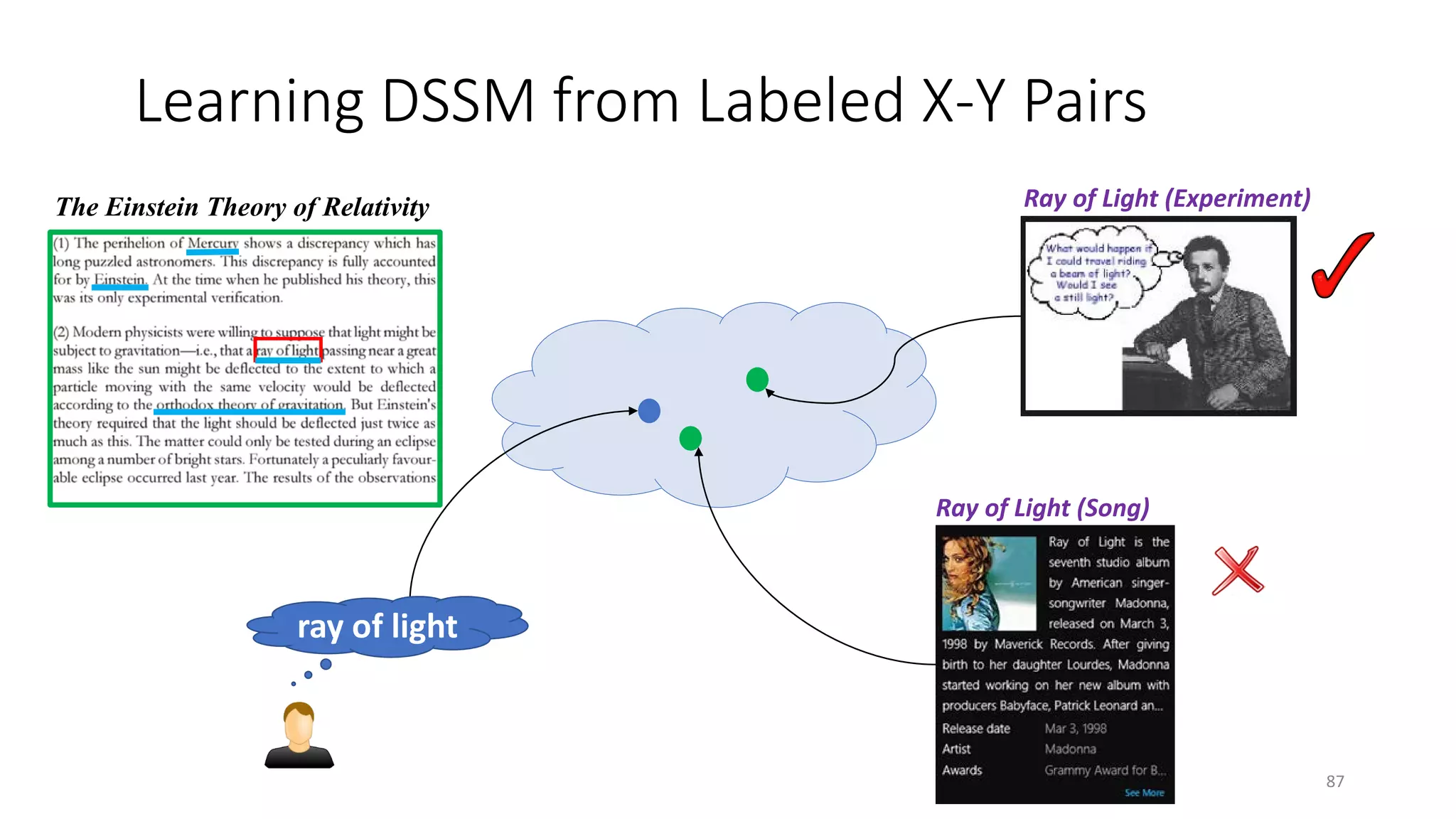
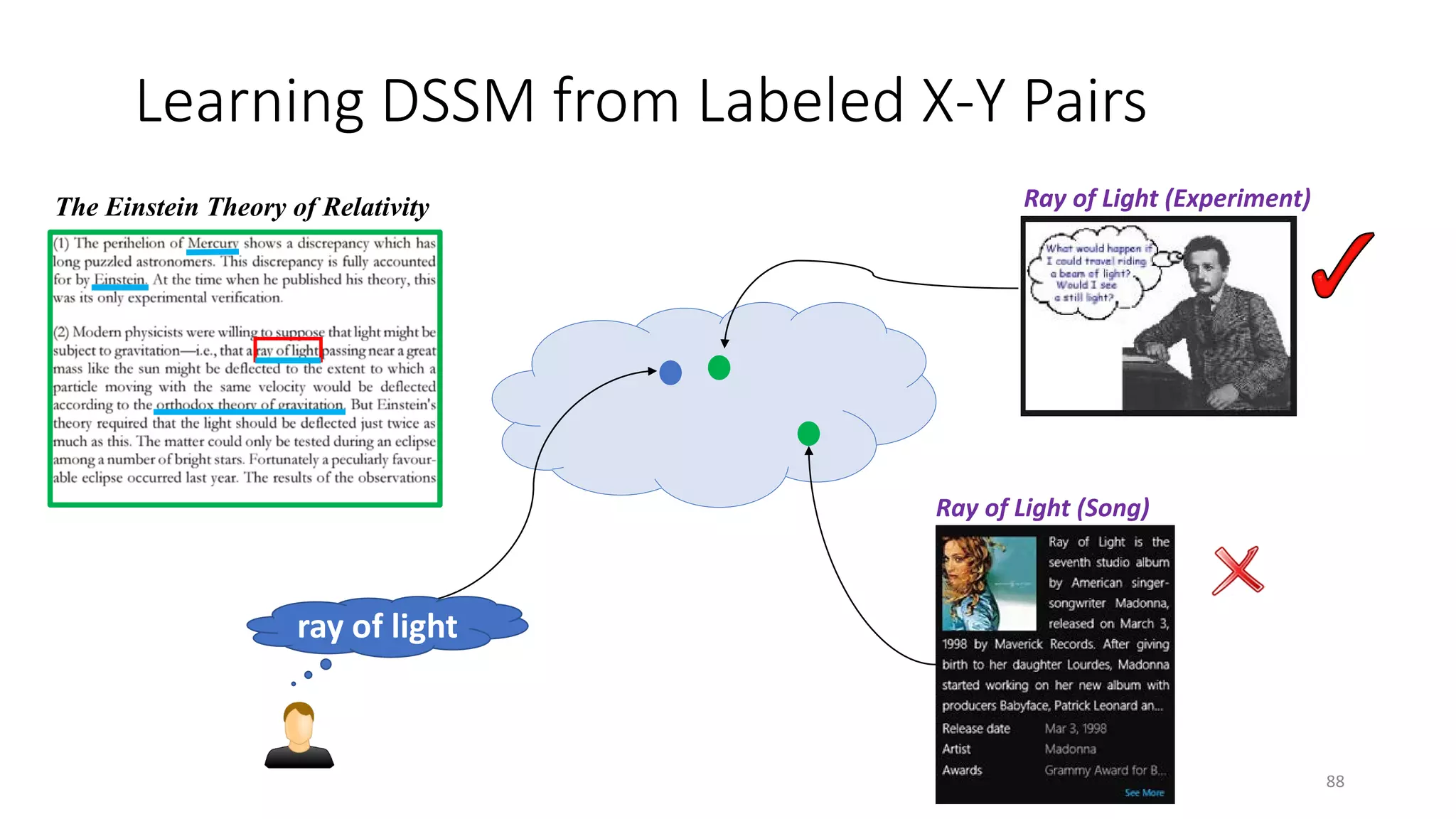

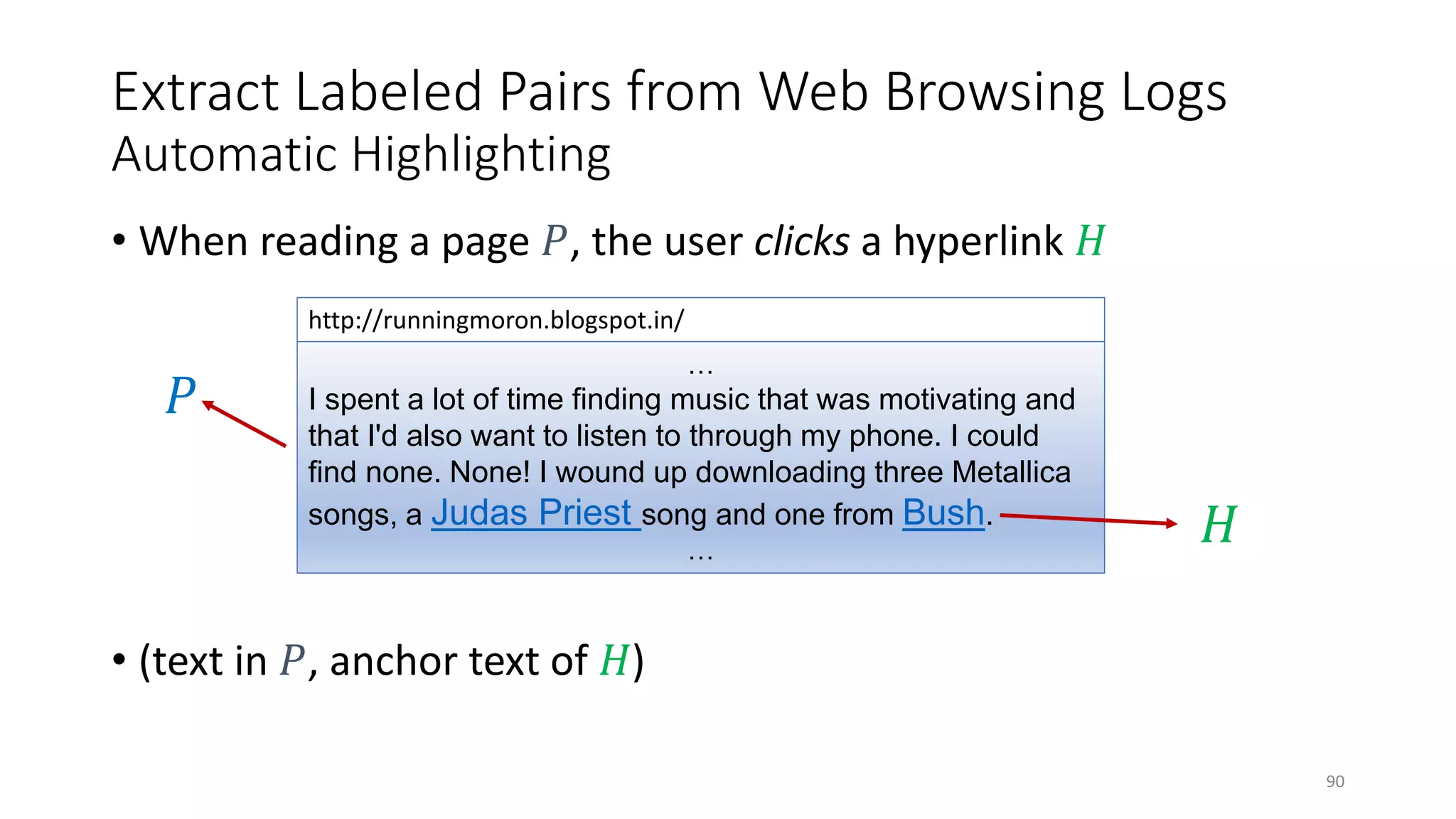

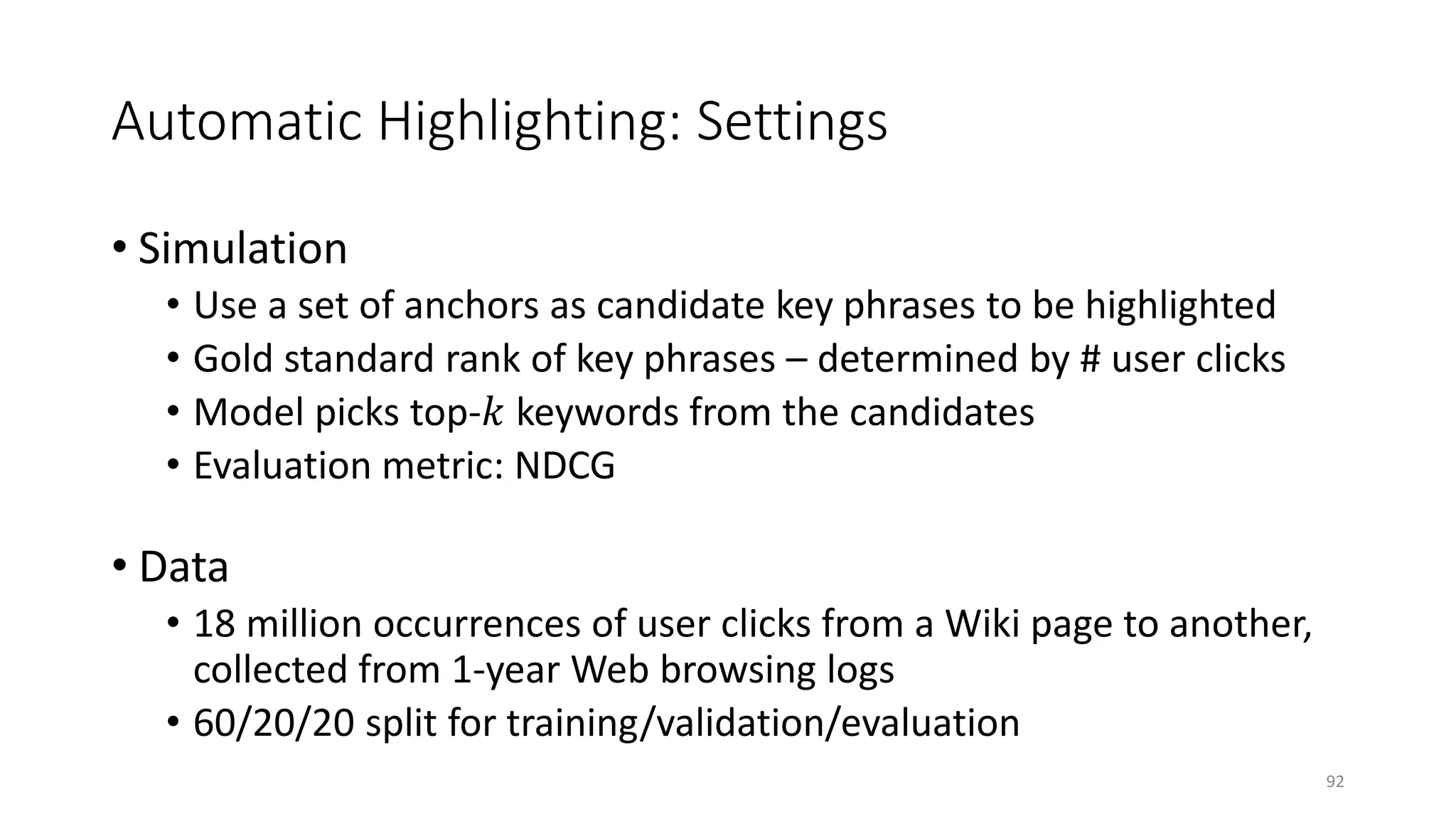
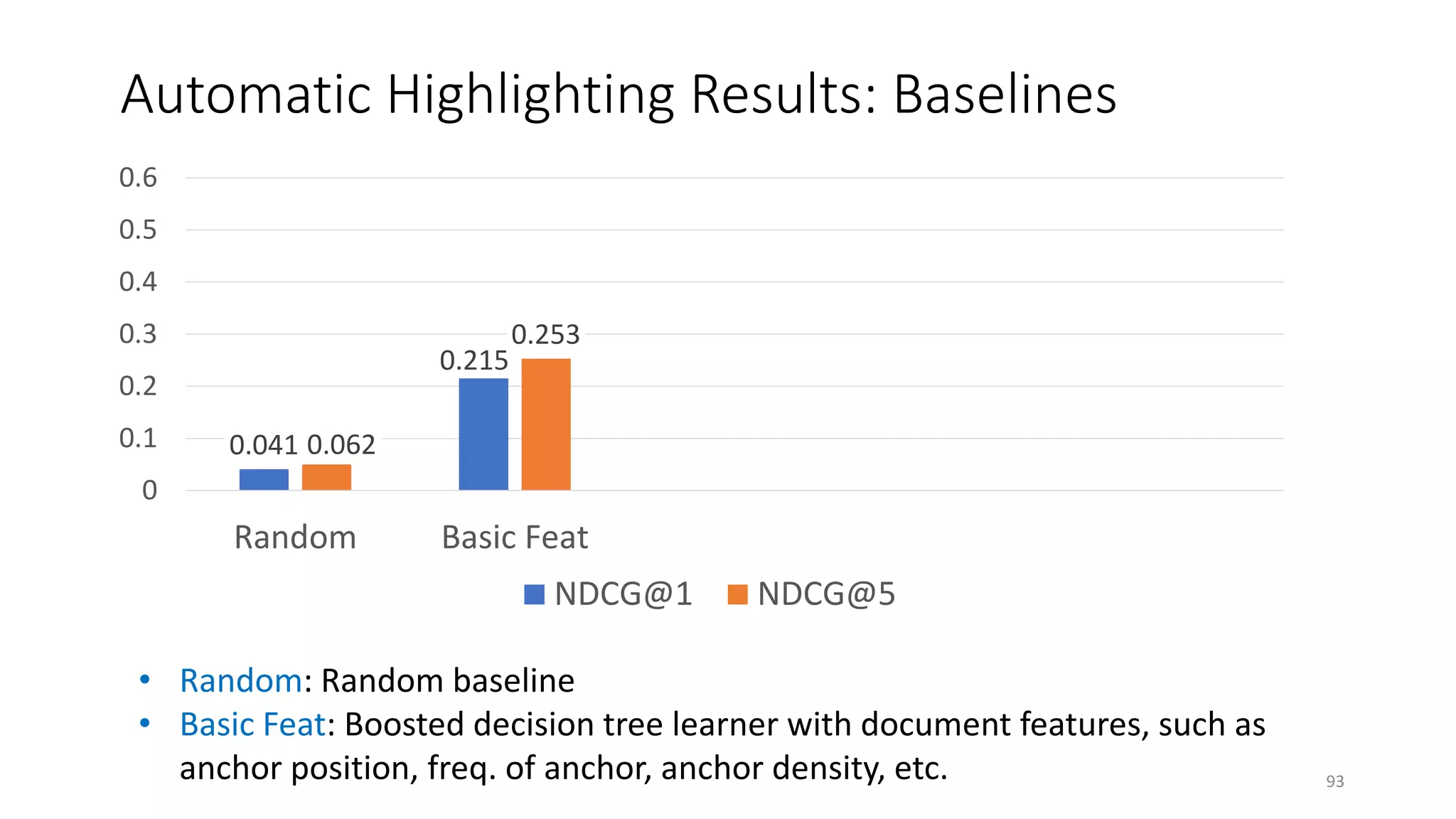
![Automatic Highlighting Results: Semantic Features
• + LDA Vec: Basic + Topic model (LDA) vectors [Gamon+ 2013]
• + Wiki Cat: Basic + Wikipedia categories (do not apply to general documents)
• + DSSM Vec: Basic + DSSM vectors
0.041
0.215
0.345
0.505
0.554
0.062
0.253
0.380
0.475
0.524
0
0.1
0.2
0.3
0.4
0.5
0.6
Random Basic Feat + LDA Vec + Wiki Cat + DSSM Vec
NDCG@1 NDCG@5
94](https://image.slidesharecdn.com/mitqptdarkanz785ioot-signature-233d5c007282b08e62cf0f4d0a5dd88f5ed85398db05a93a193537bbc0db97b6-poli-190707174549/75/BIng-NLP-Expert-Dl-summer-school-2017-jianfeng-gao-v2-94-2048.jpg)

![Contextual Entity Search Results: Baselines
• BM25: The classical document model in IR [Robertson+ 1994]
• BLTM: Bilingual Topic Model [Gao+ 2011]
0.041
0.215
0.062
0.253
0
0.1
0.2
0.3
0.4
0.5
0.6
0.7
0.8
BM25 BLTM
NDCG@1 AUC
96](https://image.slidesharecdn.com/mitqptdarkanz785ioot-signature-233d5c007282b08e62cf0f4d0a5dd88f5ed85398db05a93a193537bbc0db97b6-poli-190707174549/75/BIng-NLP-Expert-Dl-summer-school-2017-jianfeng-gao-v2-96-2048.jpg)
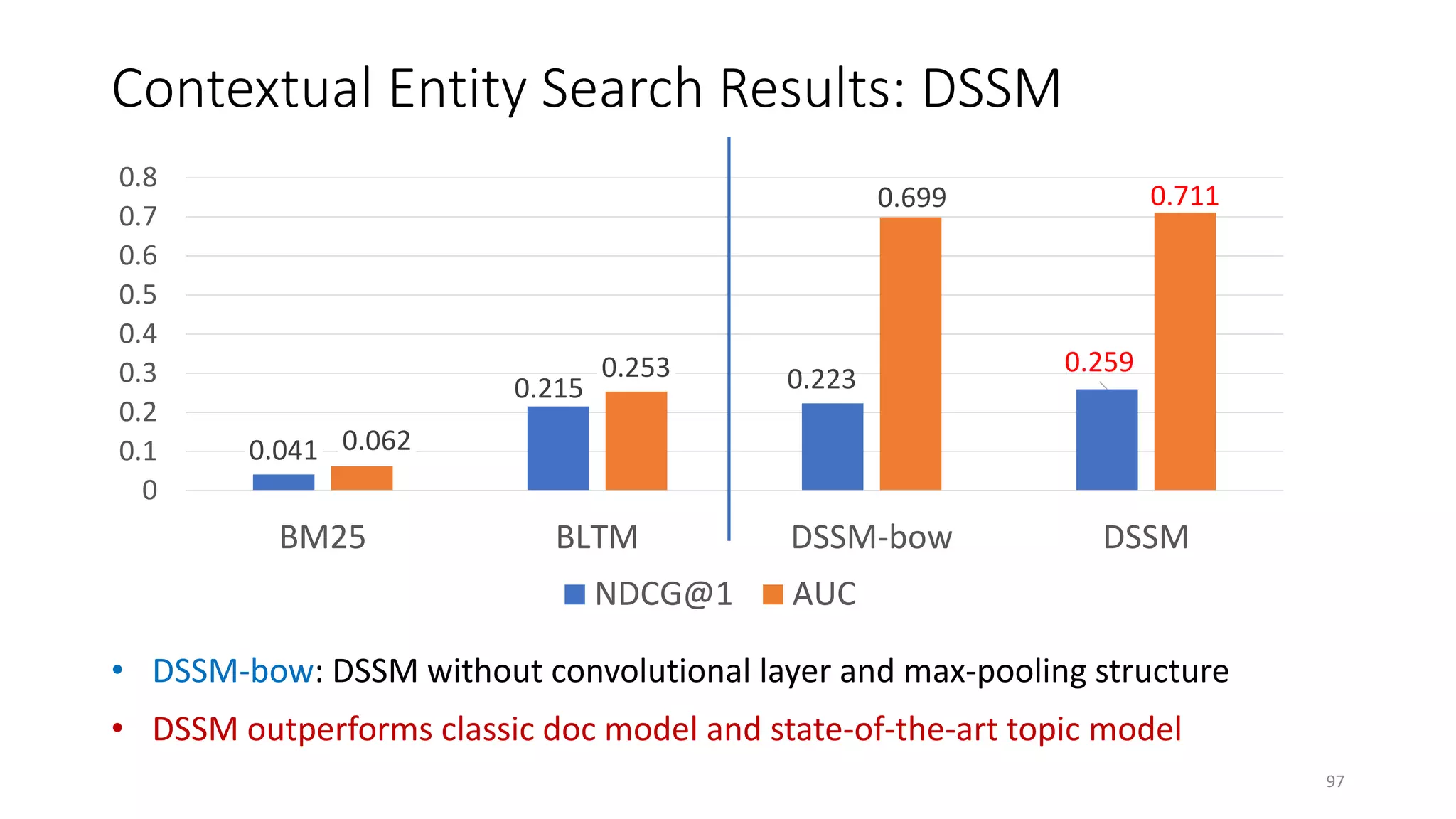
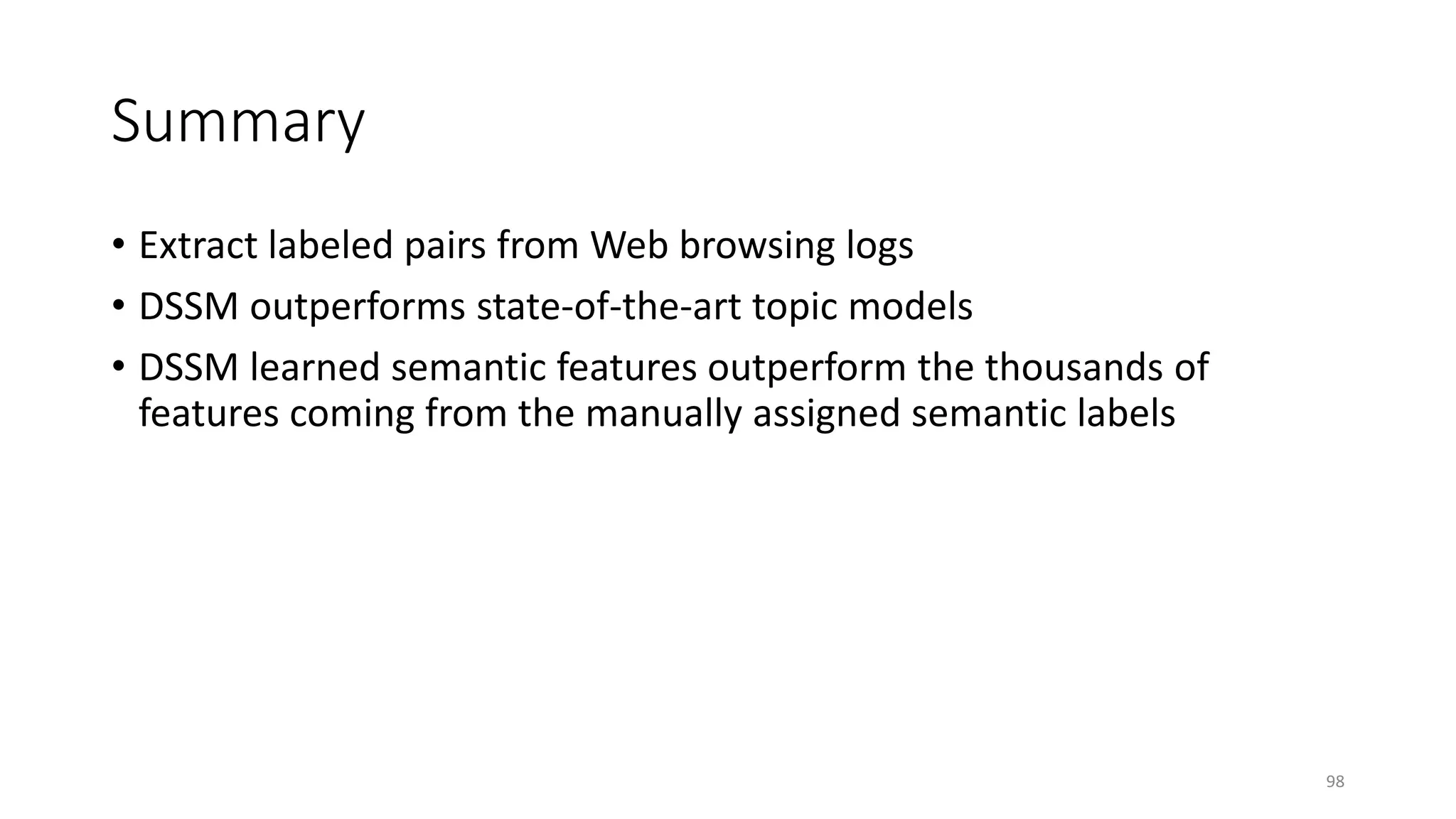

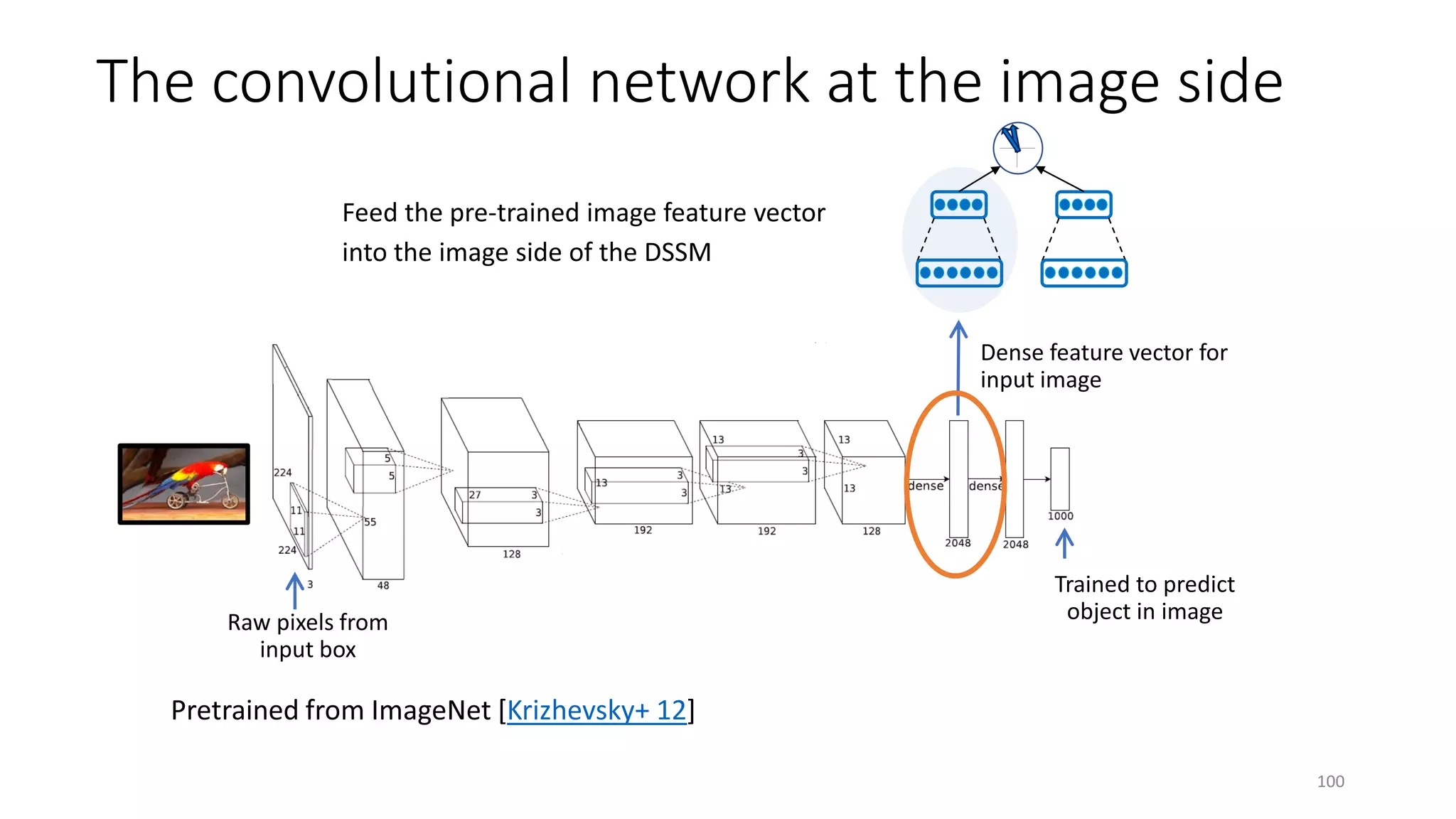
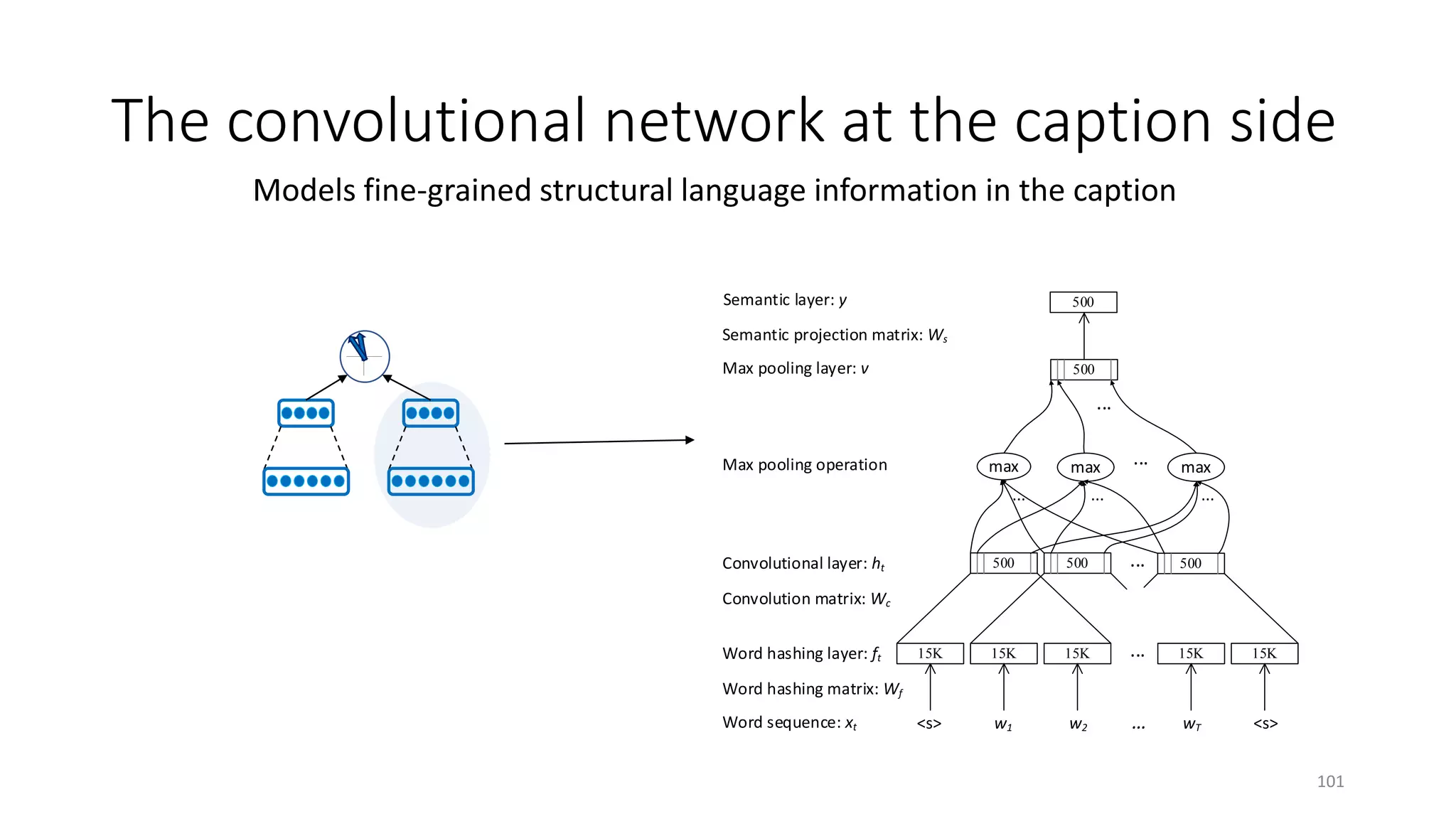
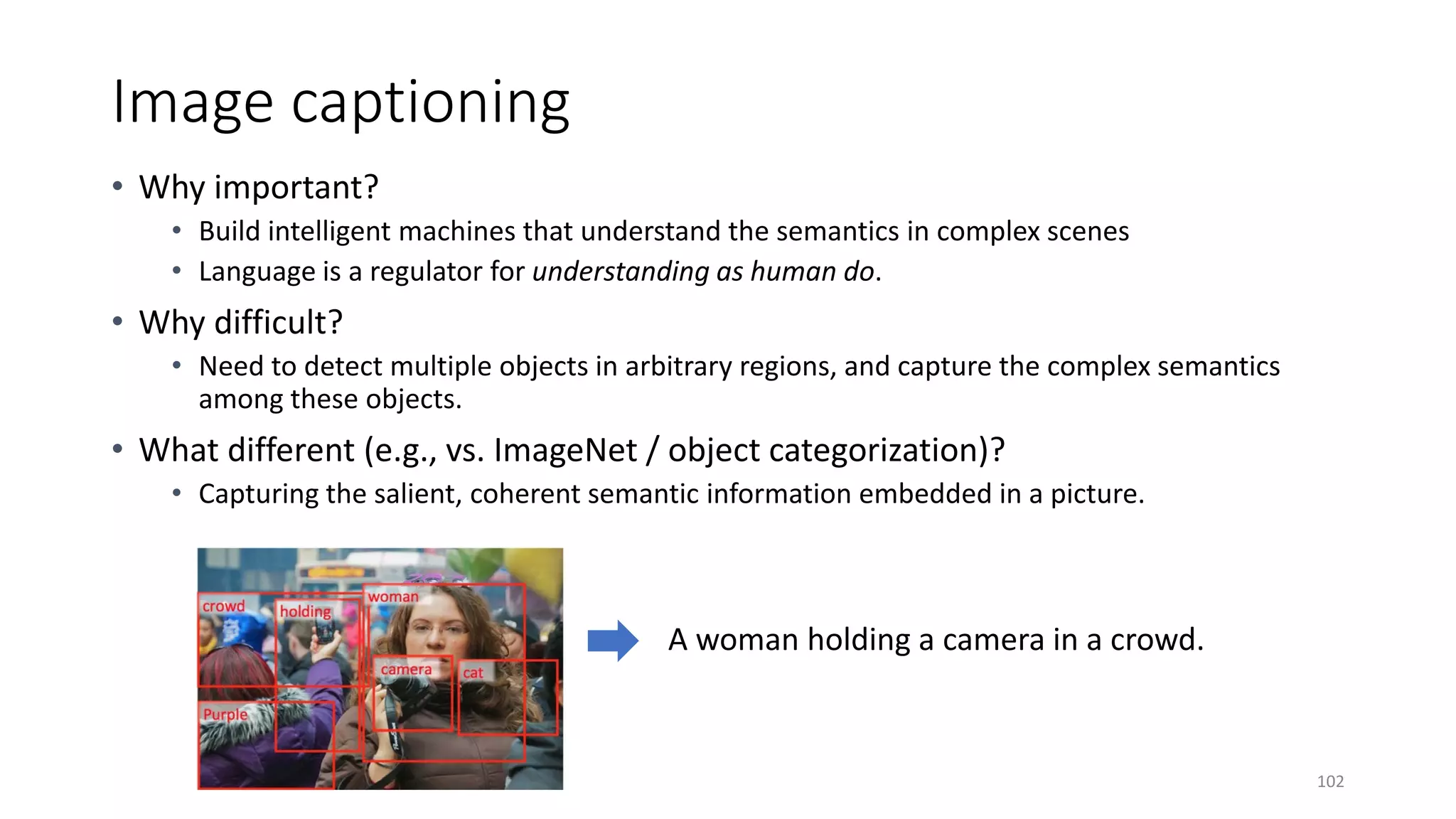
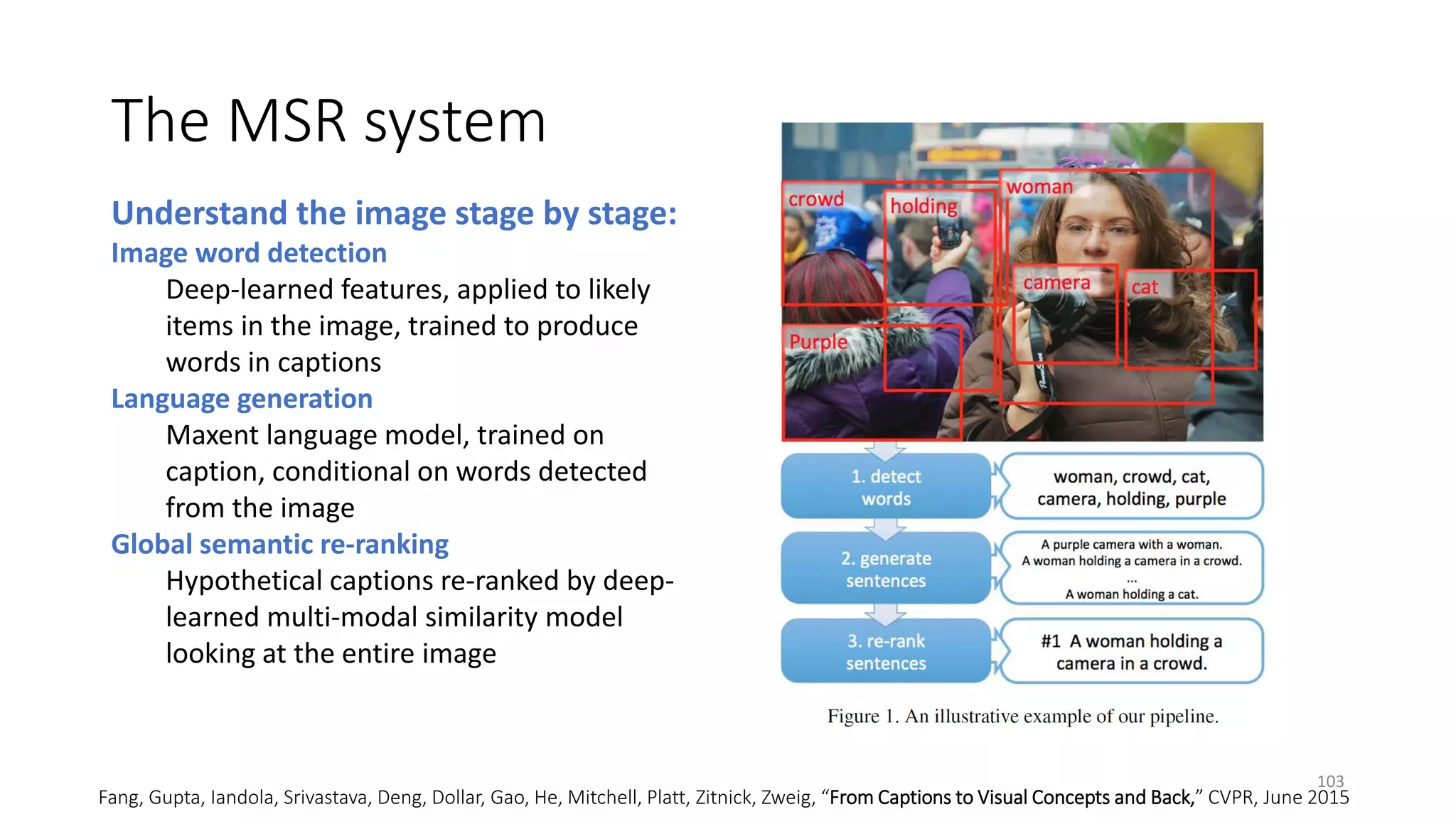
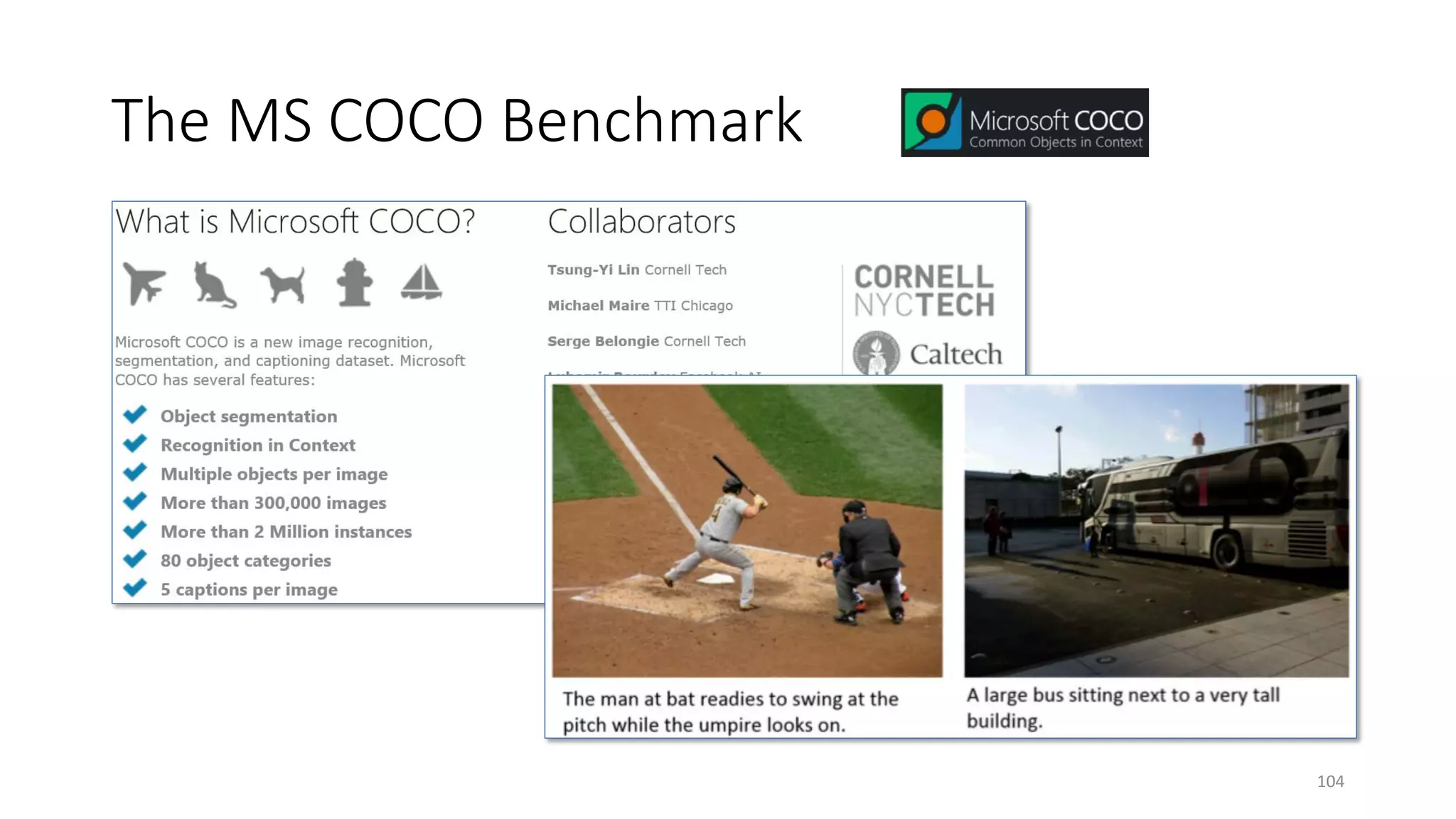
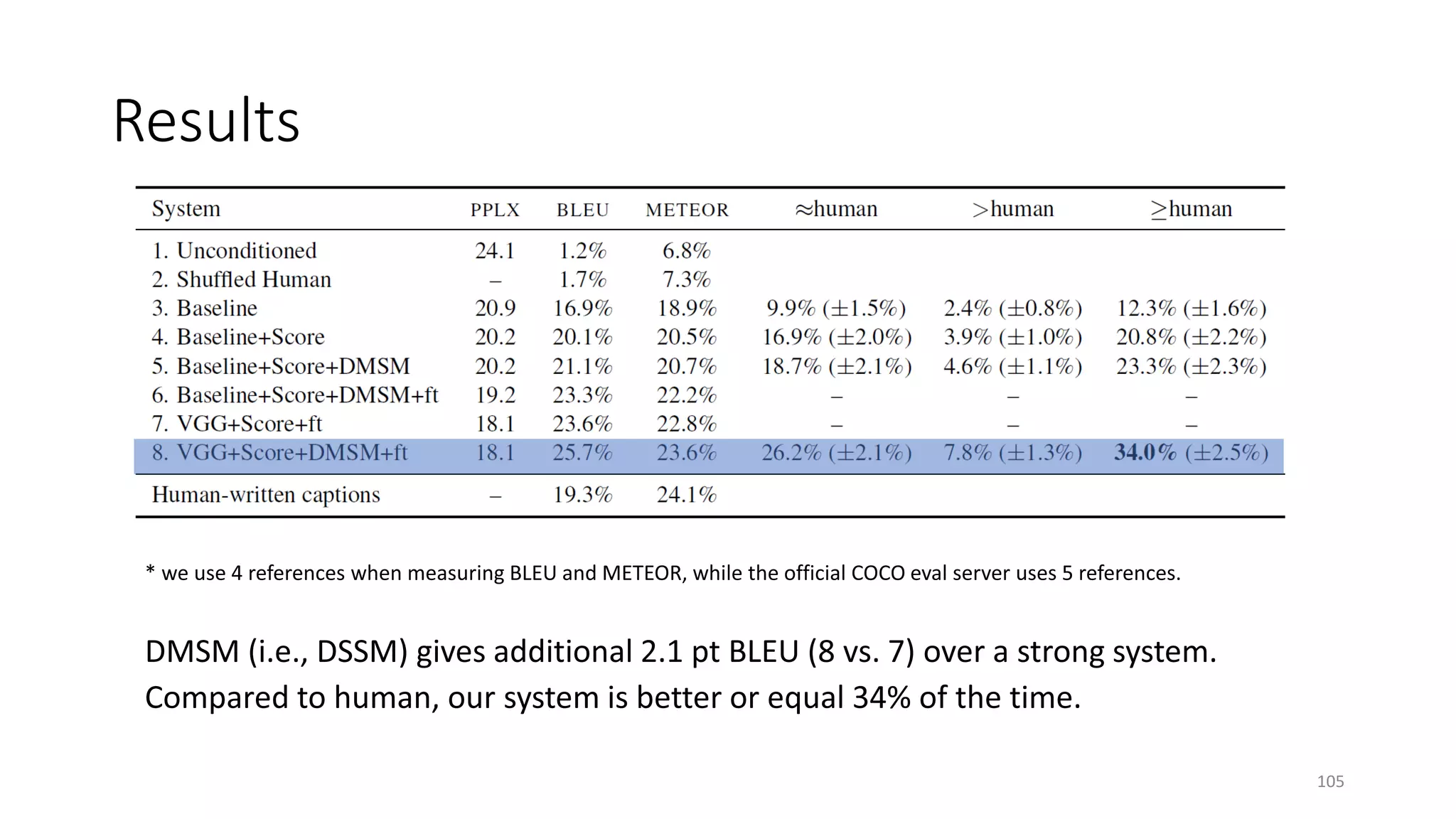

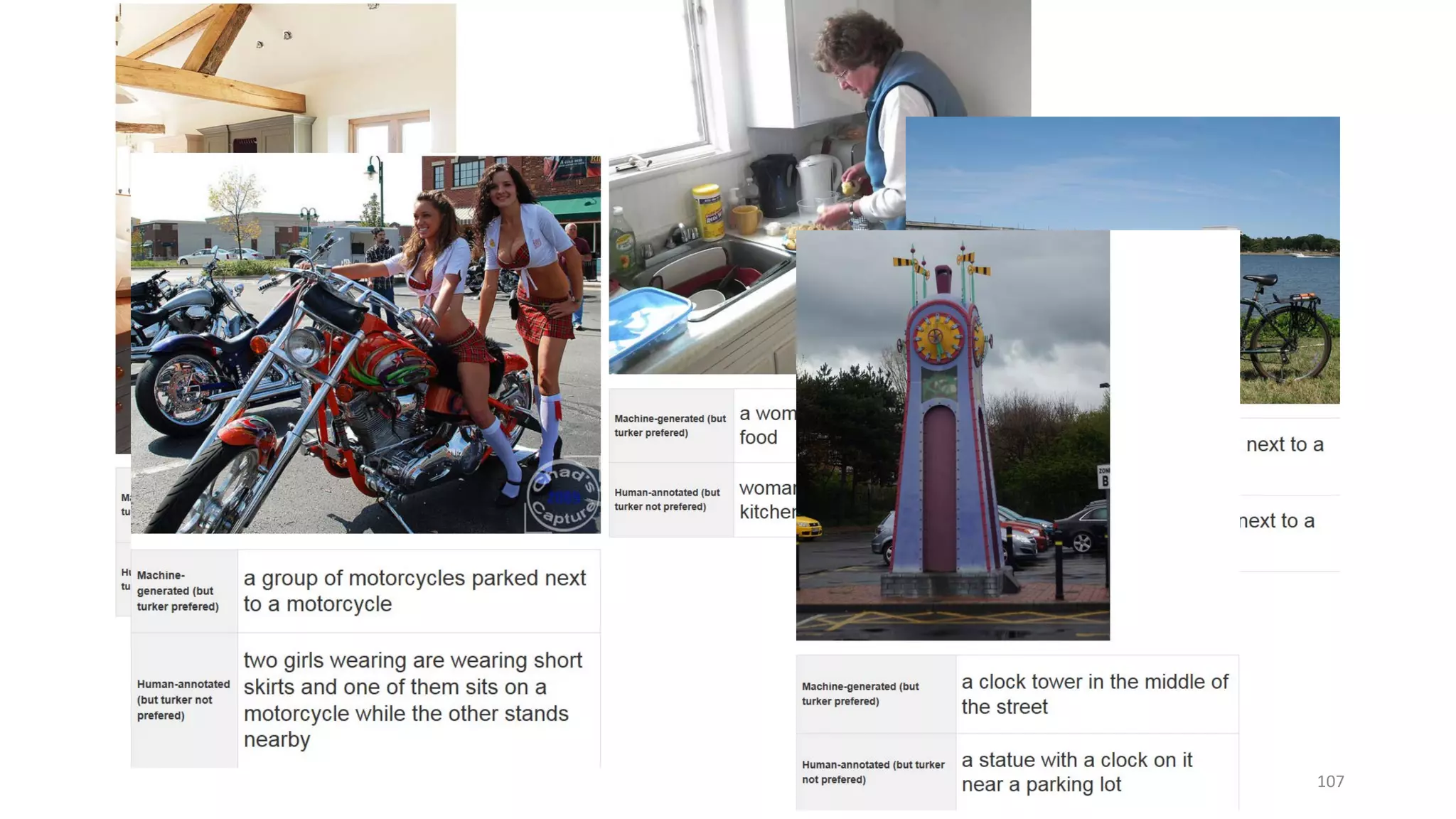
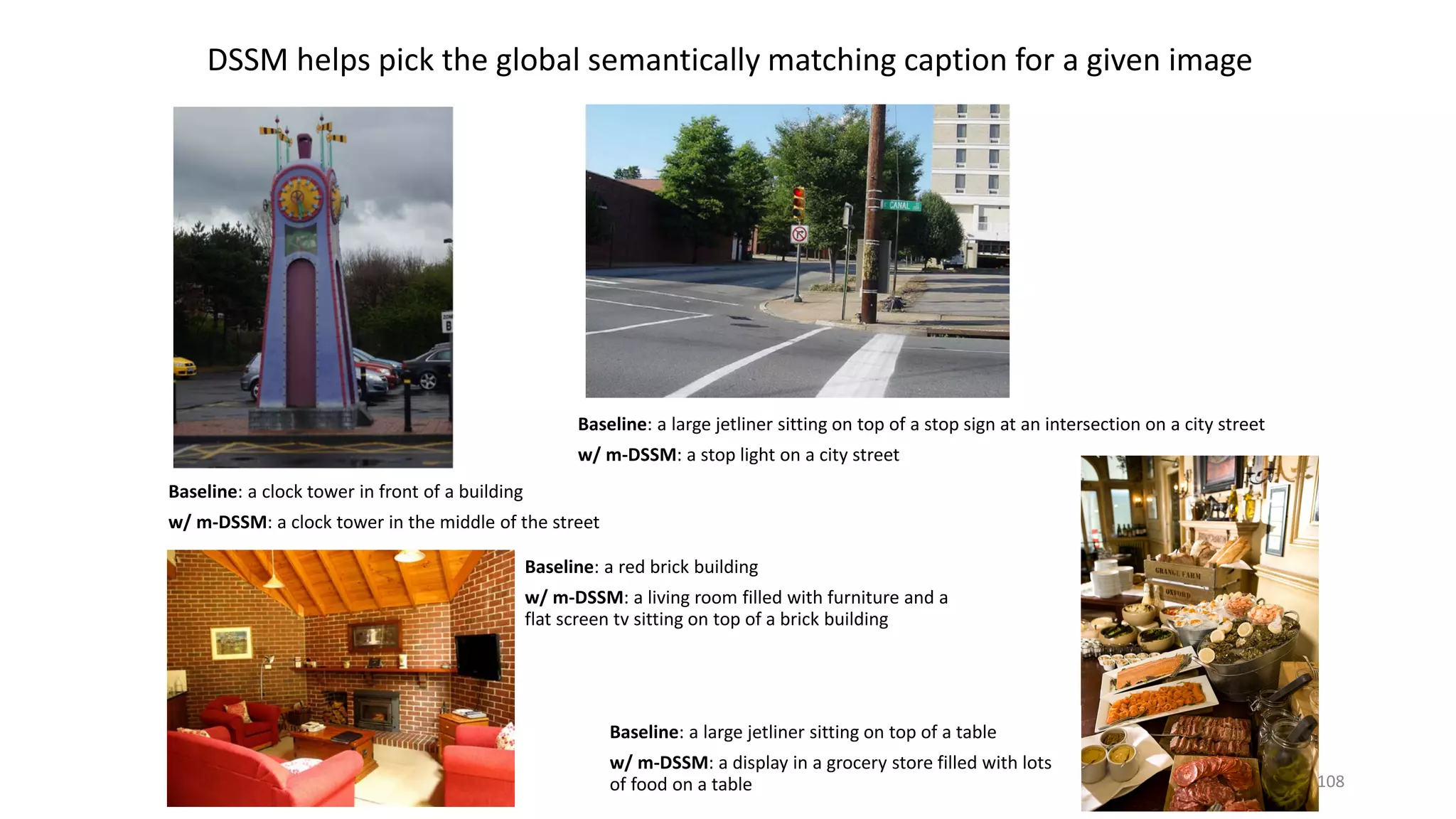
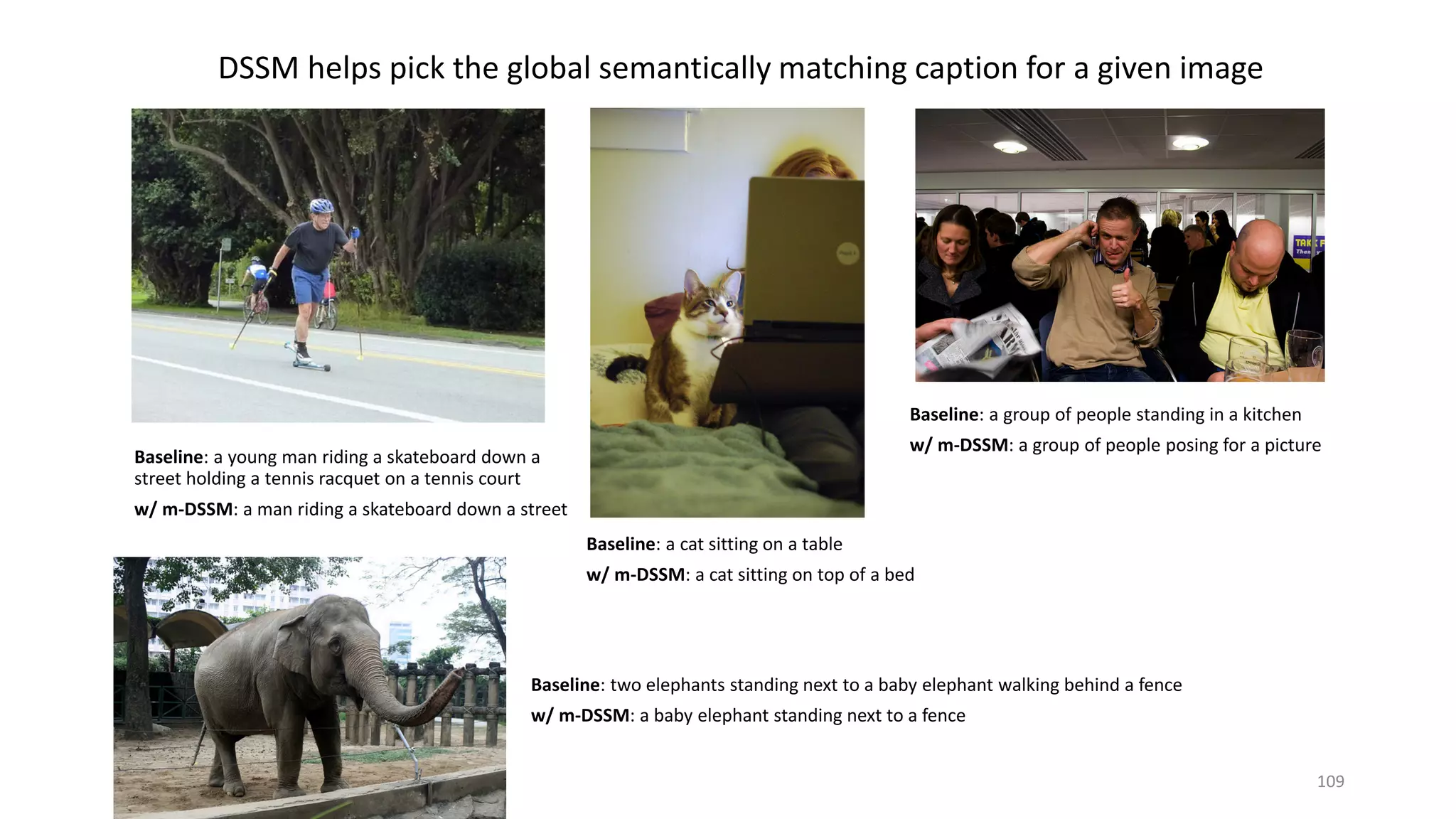
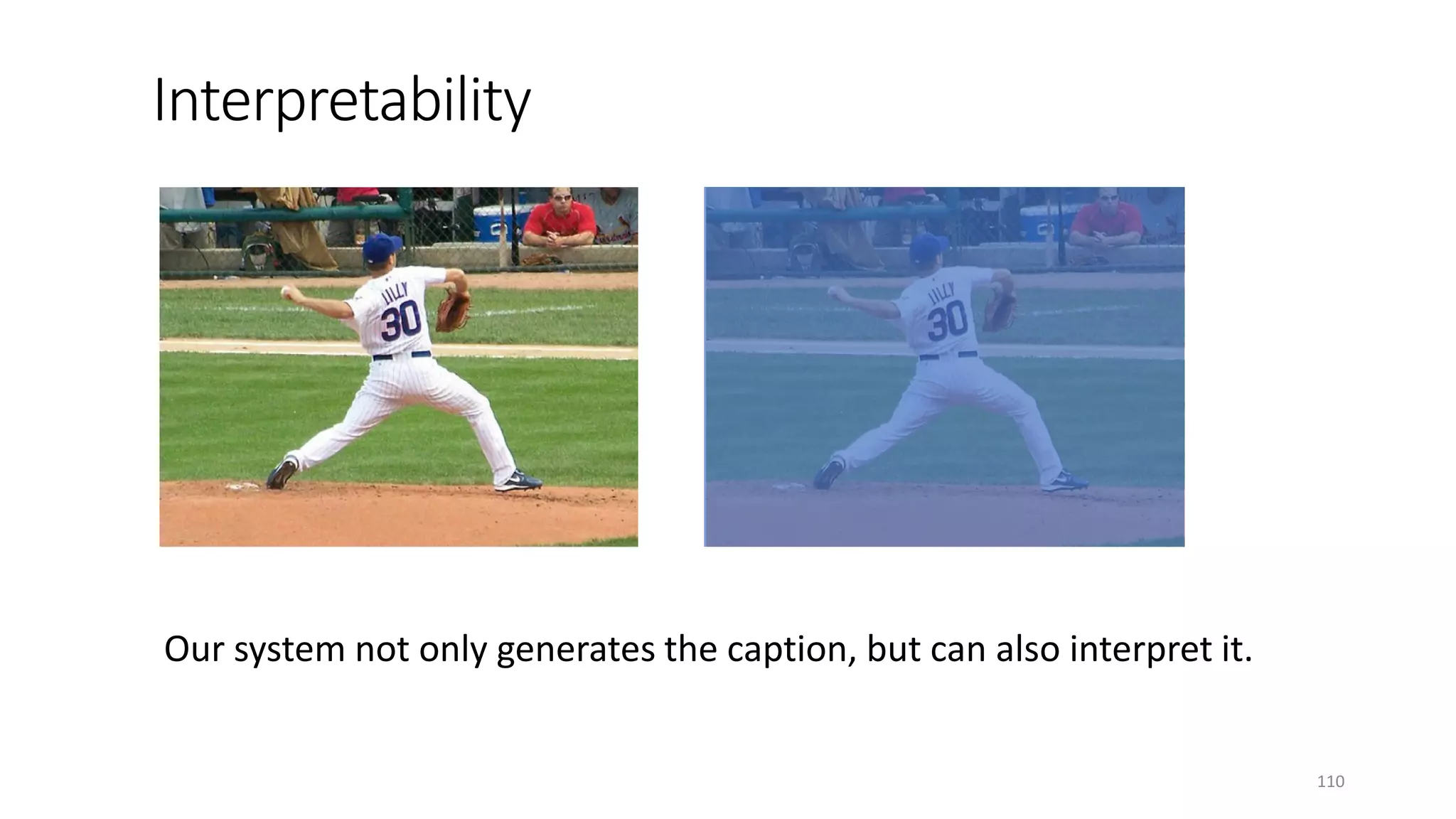
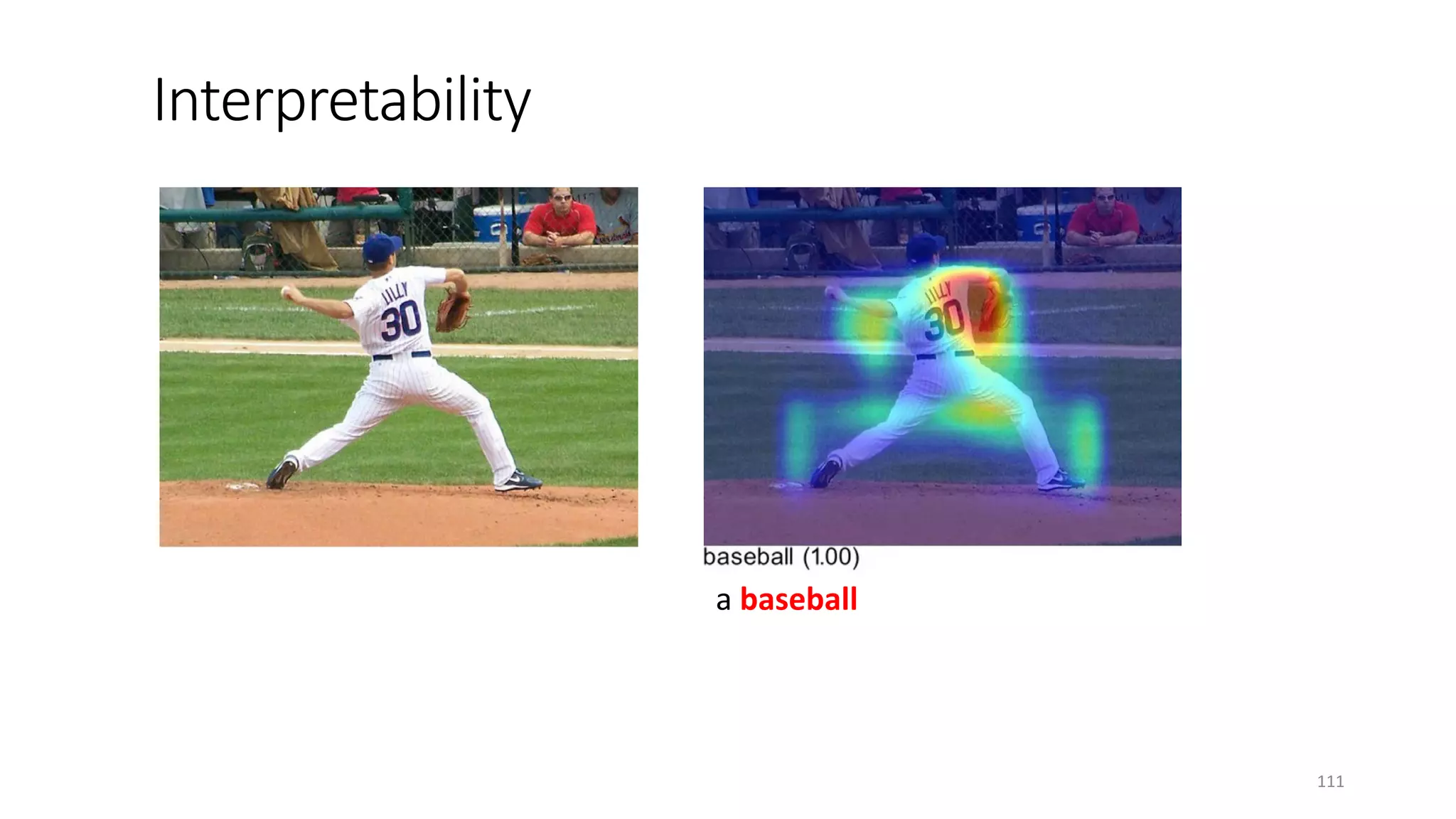
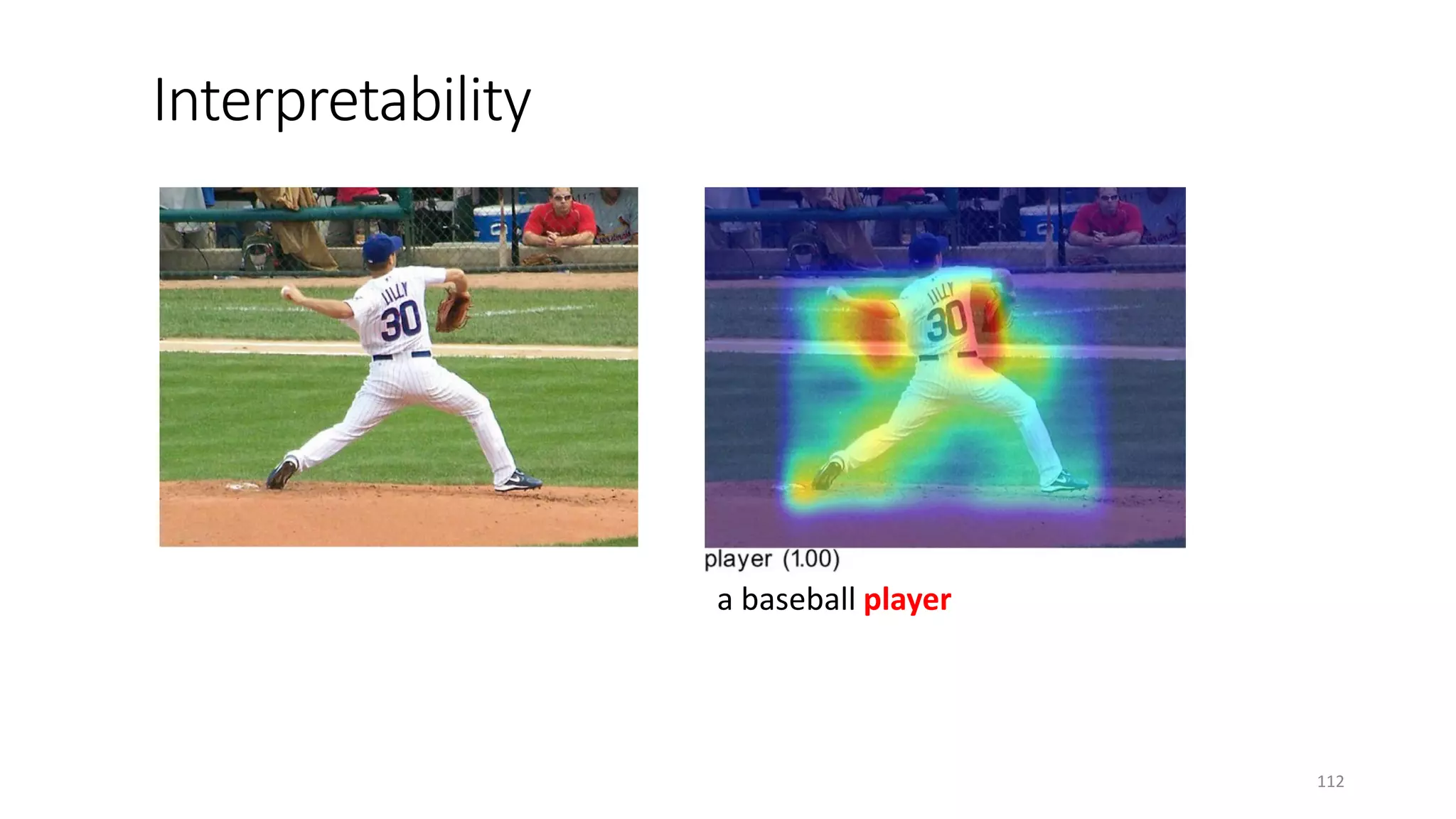
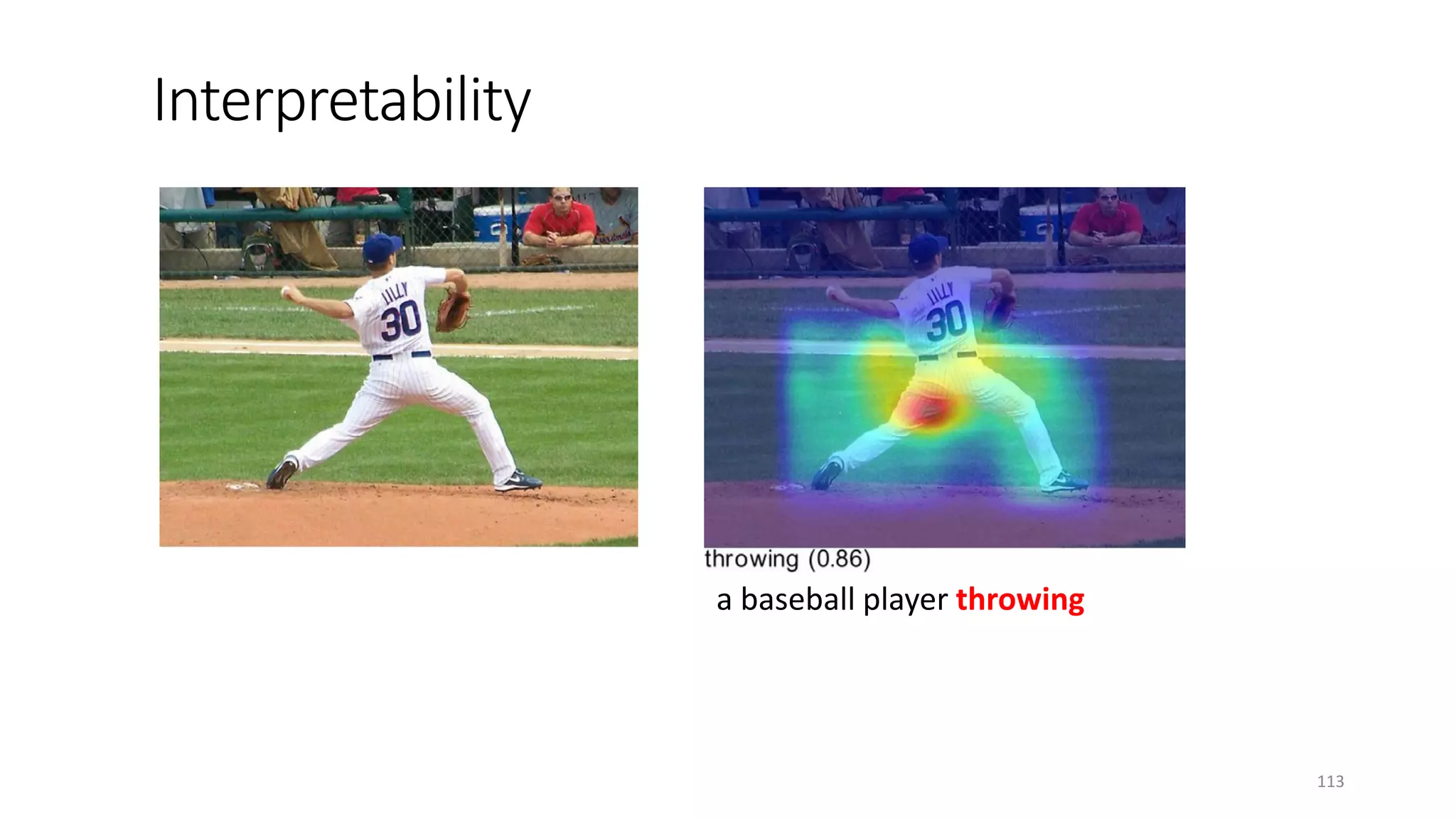
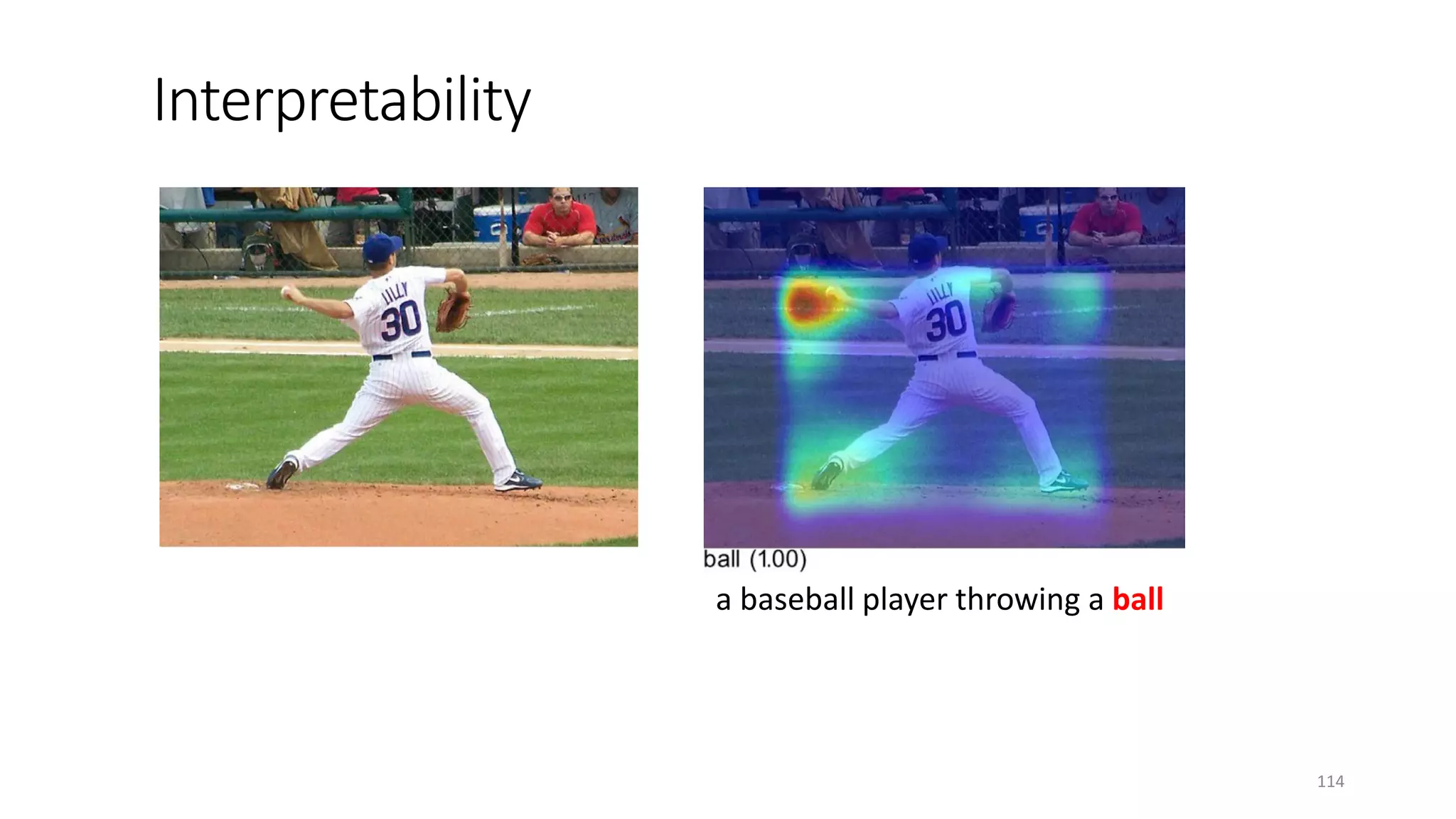
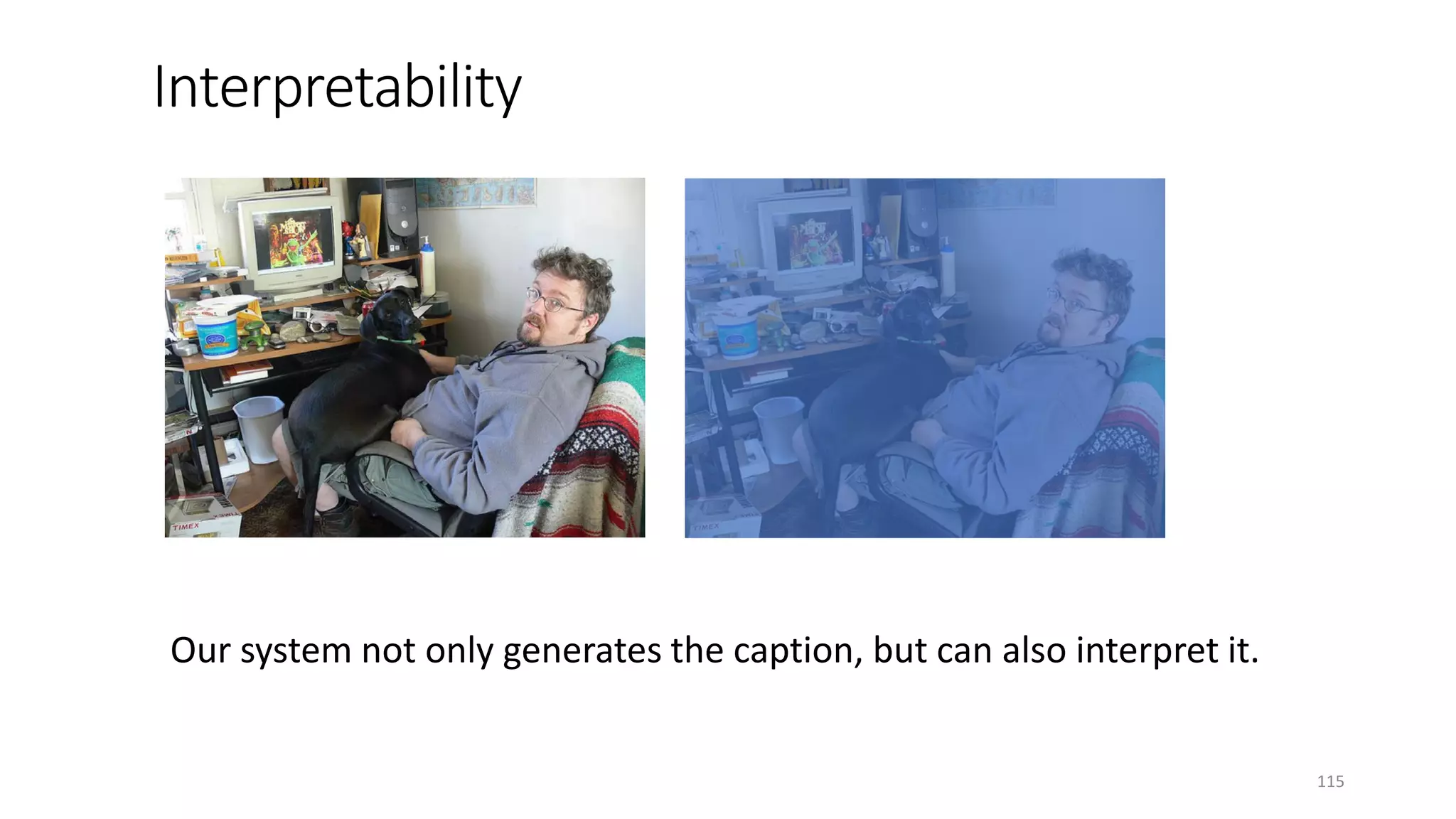
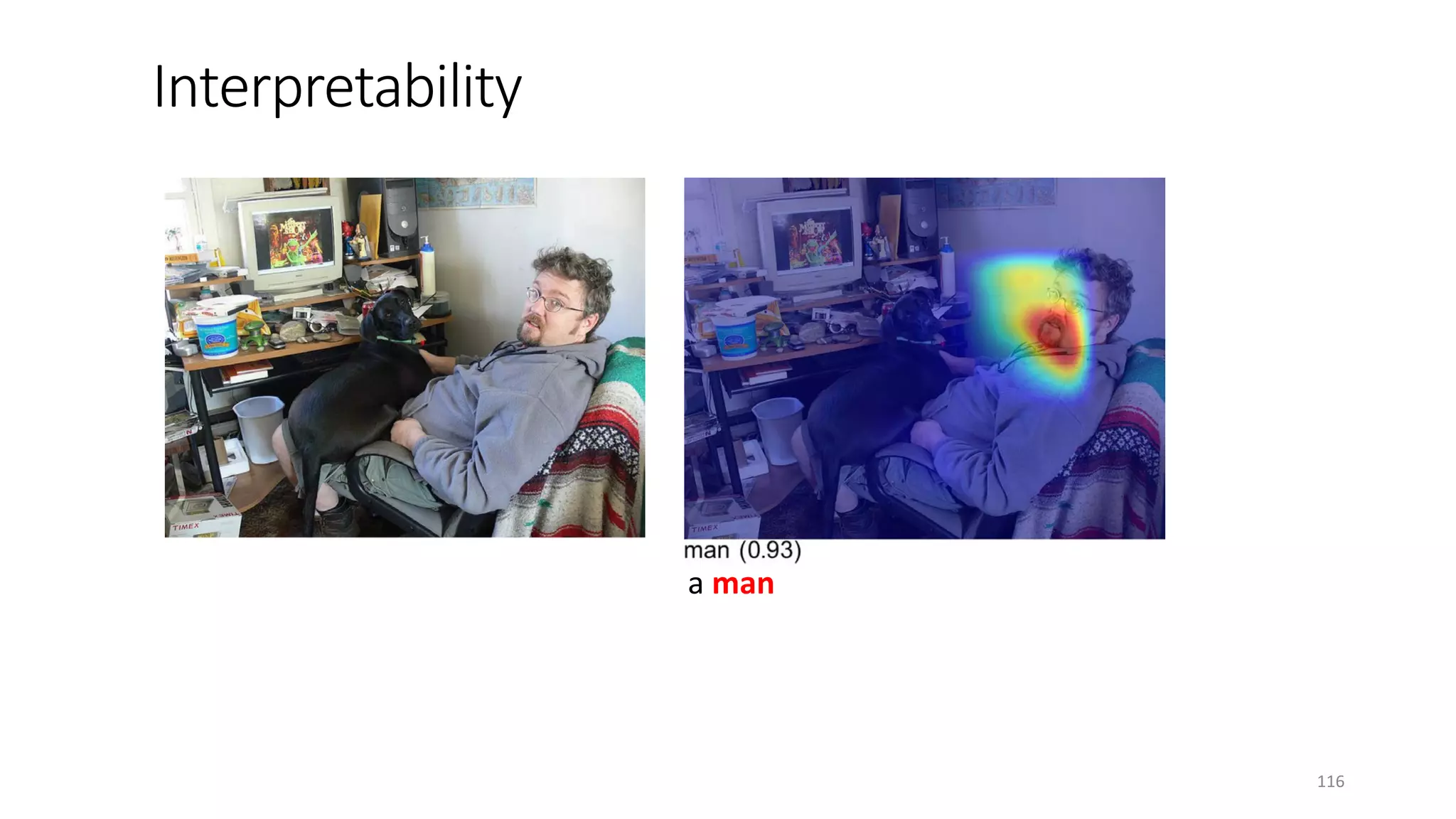
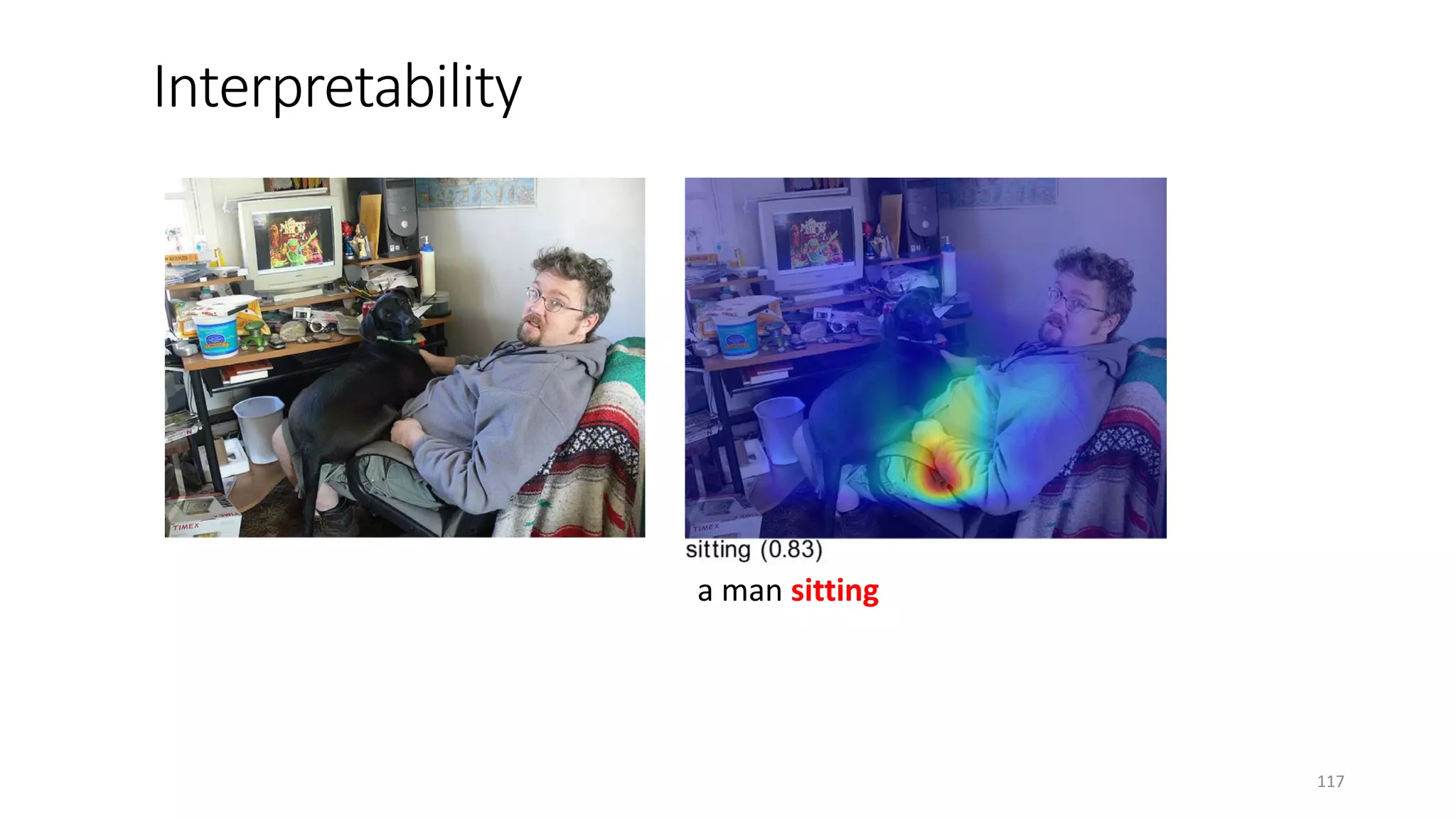
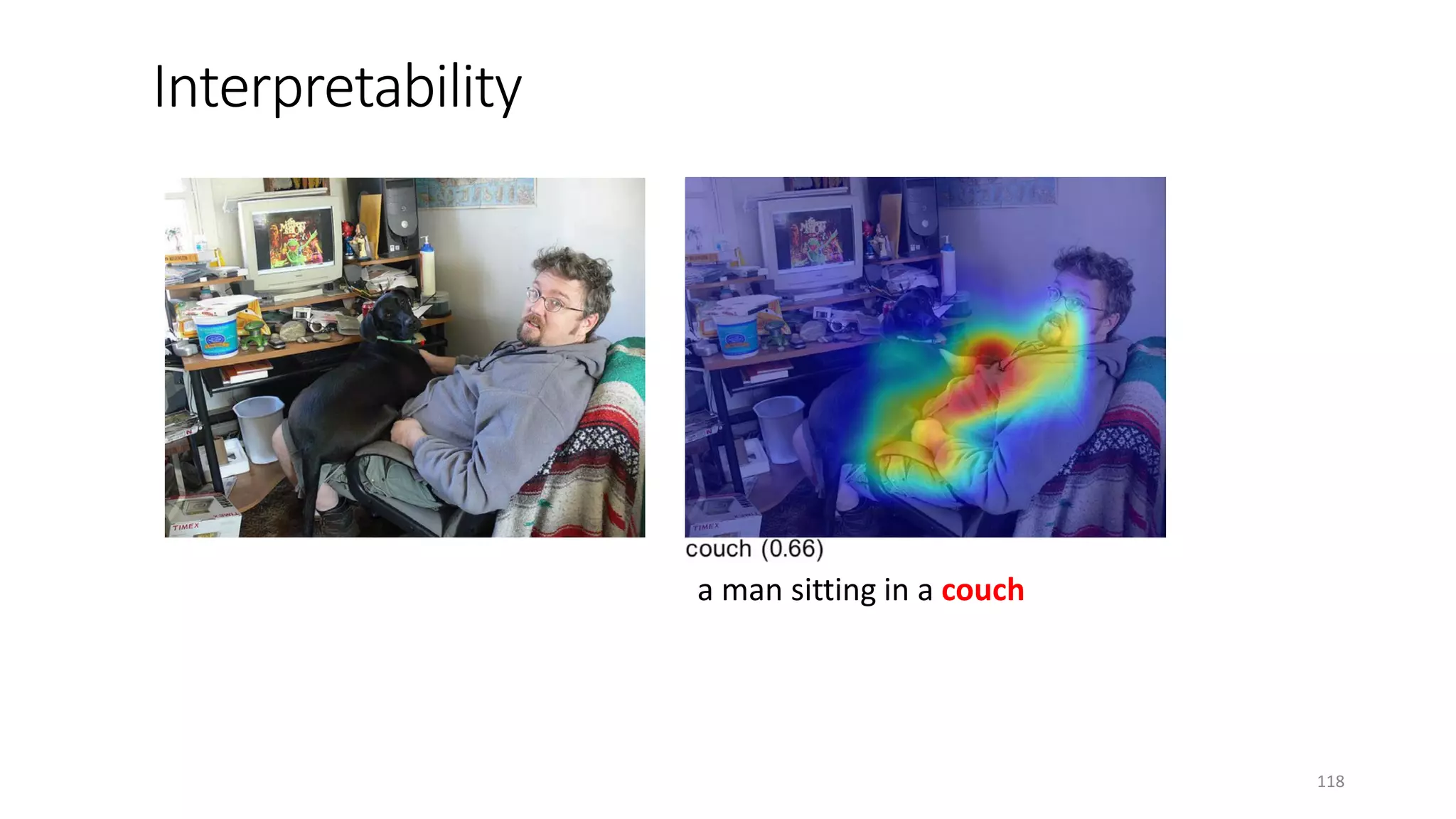
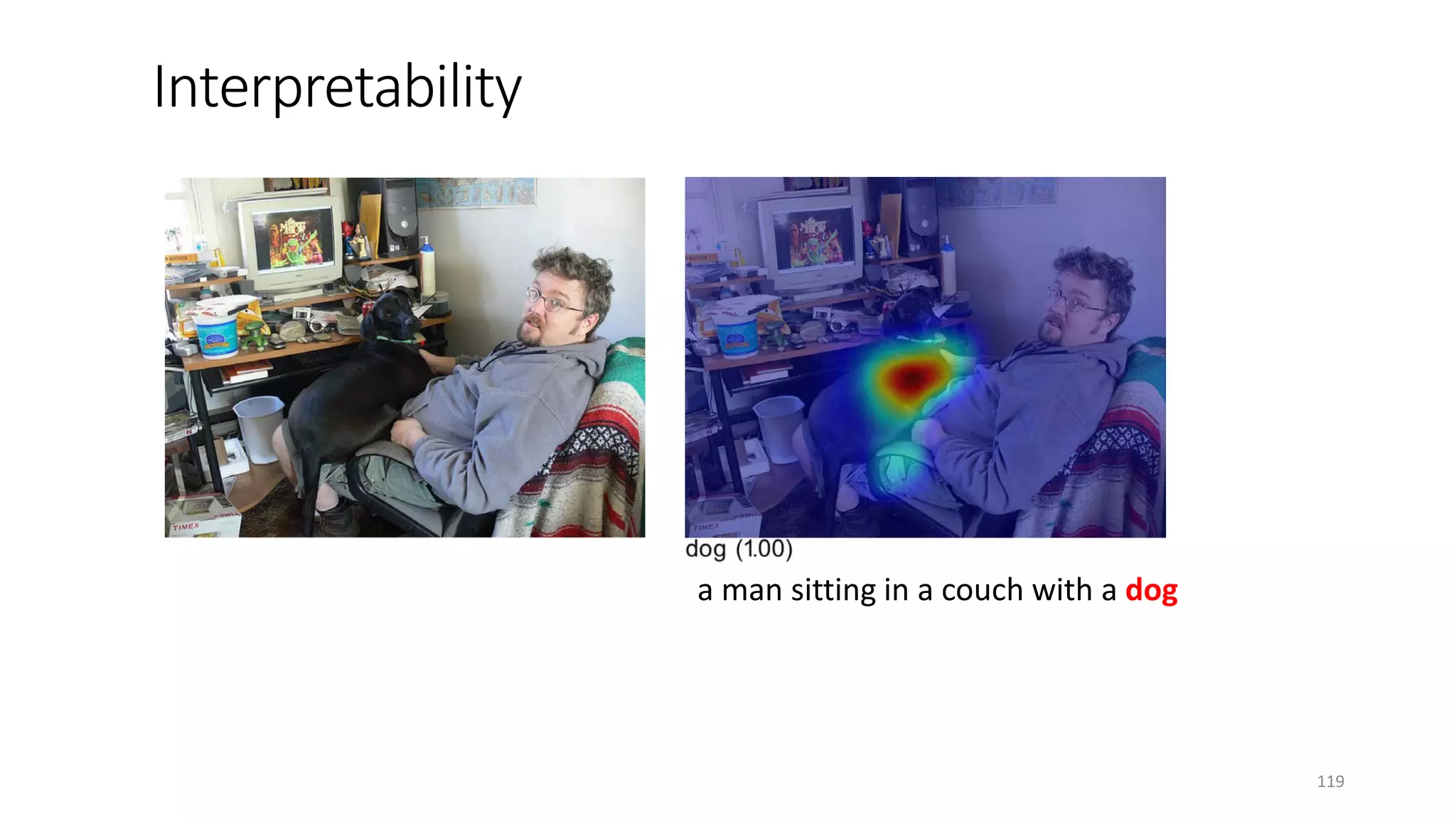
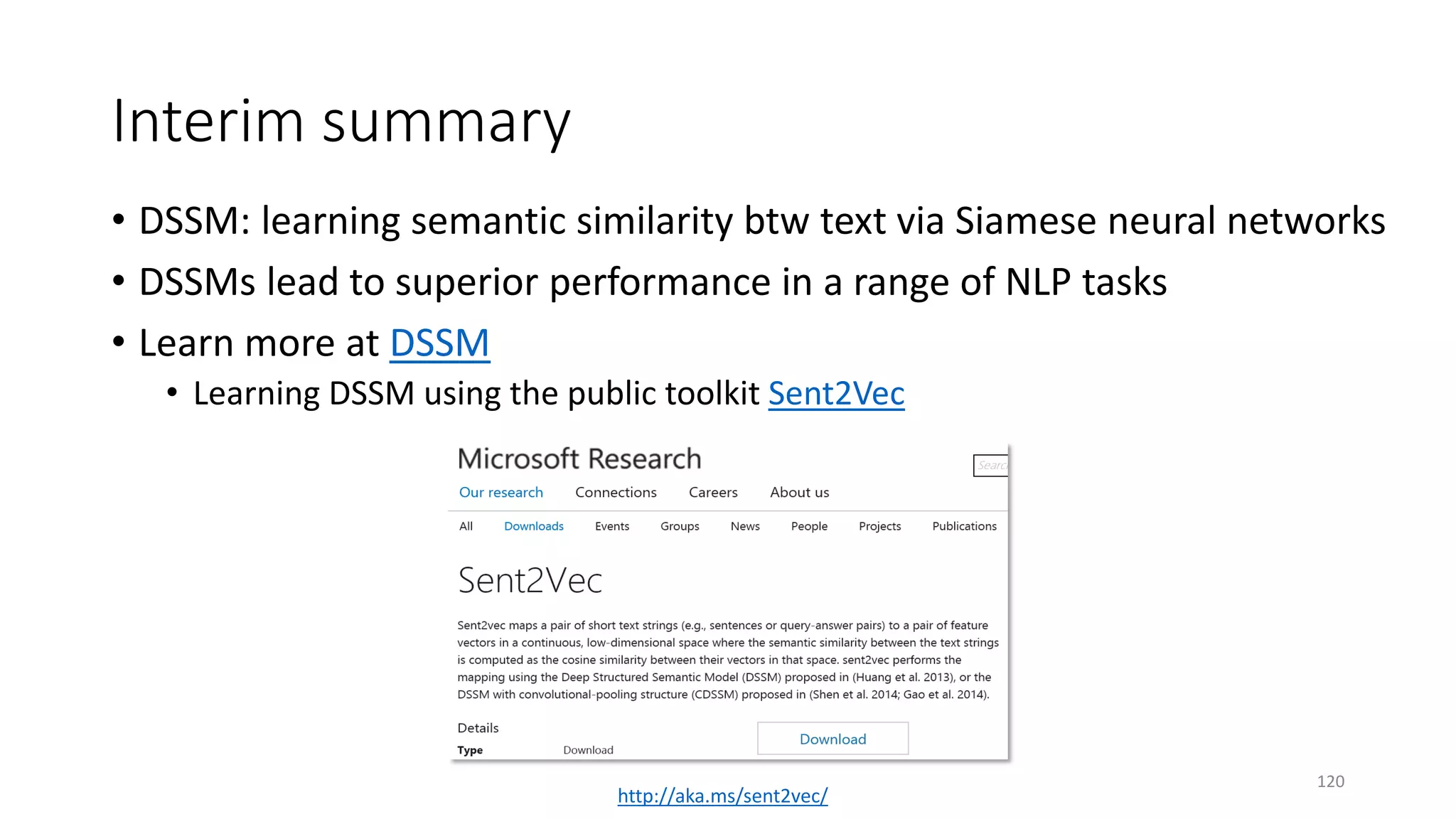
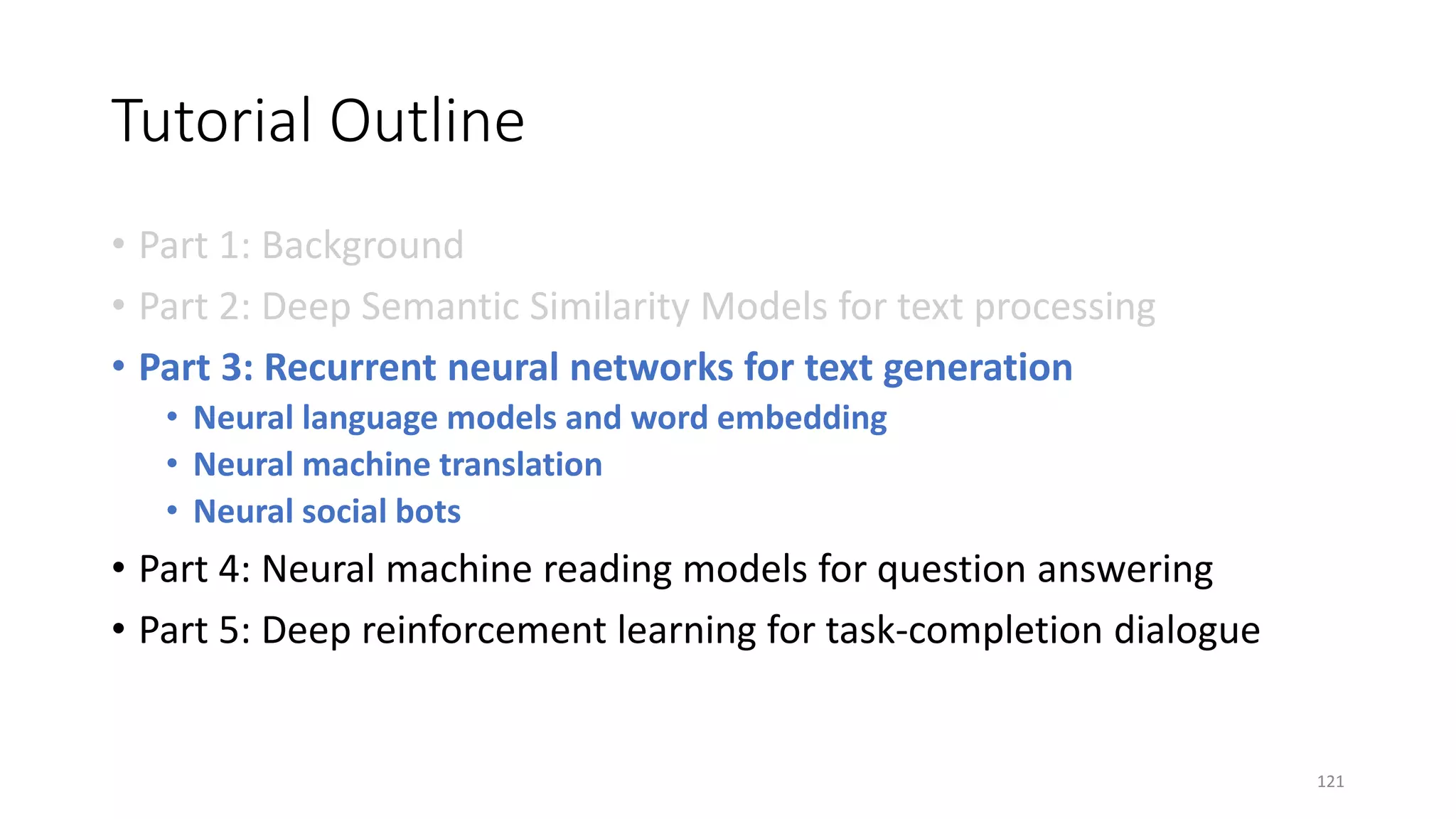

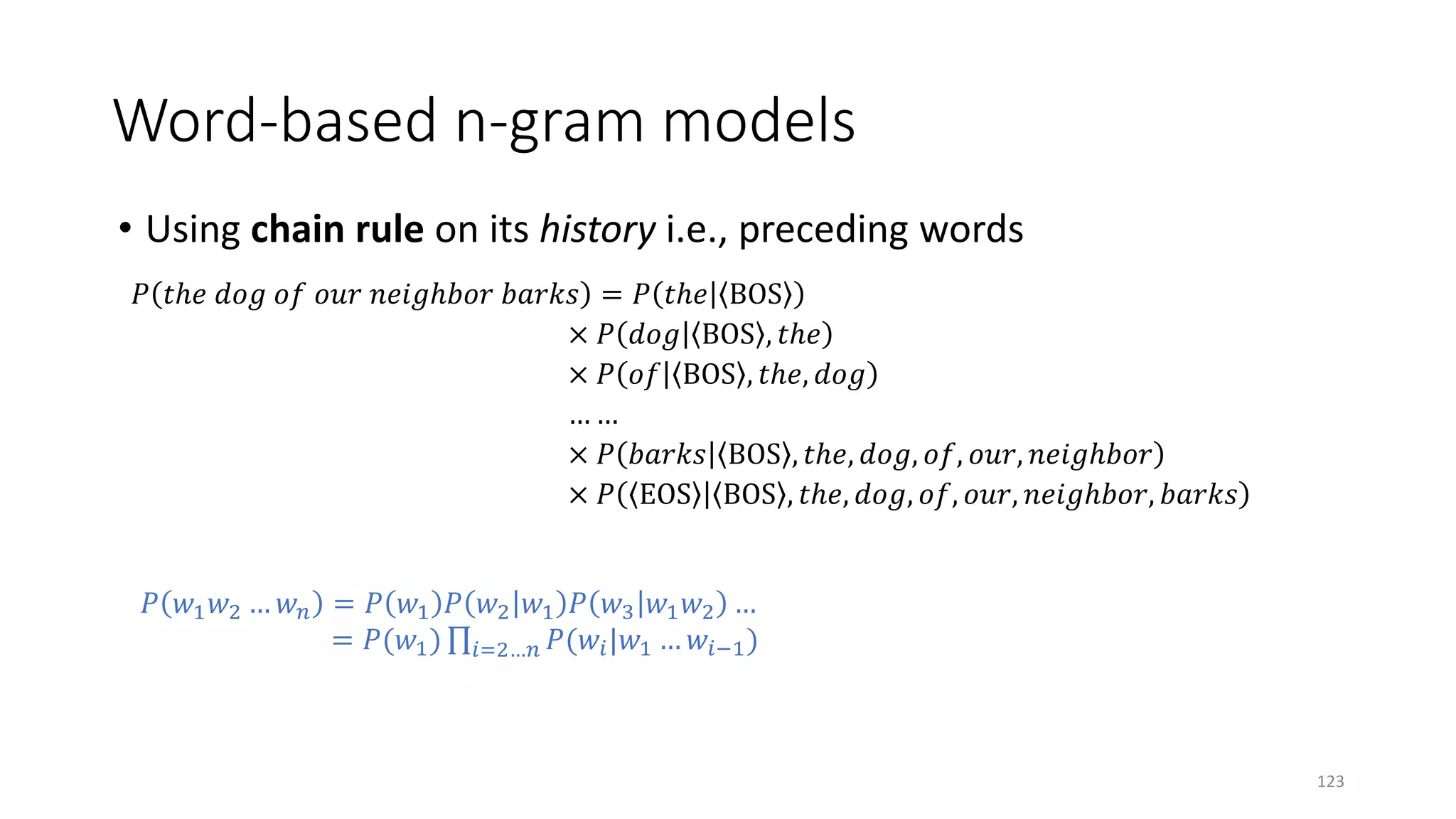
![• Problem of using long history
• Rare events: unreliable probability estimates
• Assuming a vocabulary of 20,000 words,
model # parameters
unigram P(w1) 20,000
bigram P(w2|w1) 400M
trigram P(w3|w1w2) 8 x 1012
fourgram P(w4|w1w2w3) 1.6 x 1017
[Manning, C. & Schütze, H. 1999. Foundations of statistical natural language processing.]
How do we get n-gram probability estimates?
Get text and count: 𝑃𝑃 𝑤𝑤2 𝑤𝑤1 = 𝐶𝐶𝐶𝐶𝐶𝐶(𝑤𝑤1 𝑤𝑤2)/𝐶𝐶𝐶𝐶𝐶𝐶(𝑤𝑤1)
Smoothing to ensure non-zero probabilities
Word-based n-gram models
124](https://image.slidesharecdn.com/mitqptdarkanz785ioot-signature-233d5c007282b08e62cf0f4d0a5dd88f5ed85398db05a93a193537bbc0db97b6-poli-190707174549/75/BIng-NLP-Expert-Dl-summer-school-2017-jianfeng-gao-v2-124-2048.jpg)
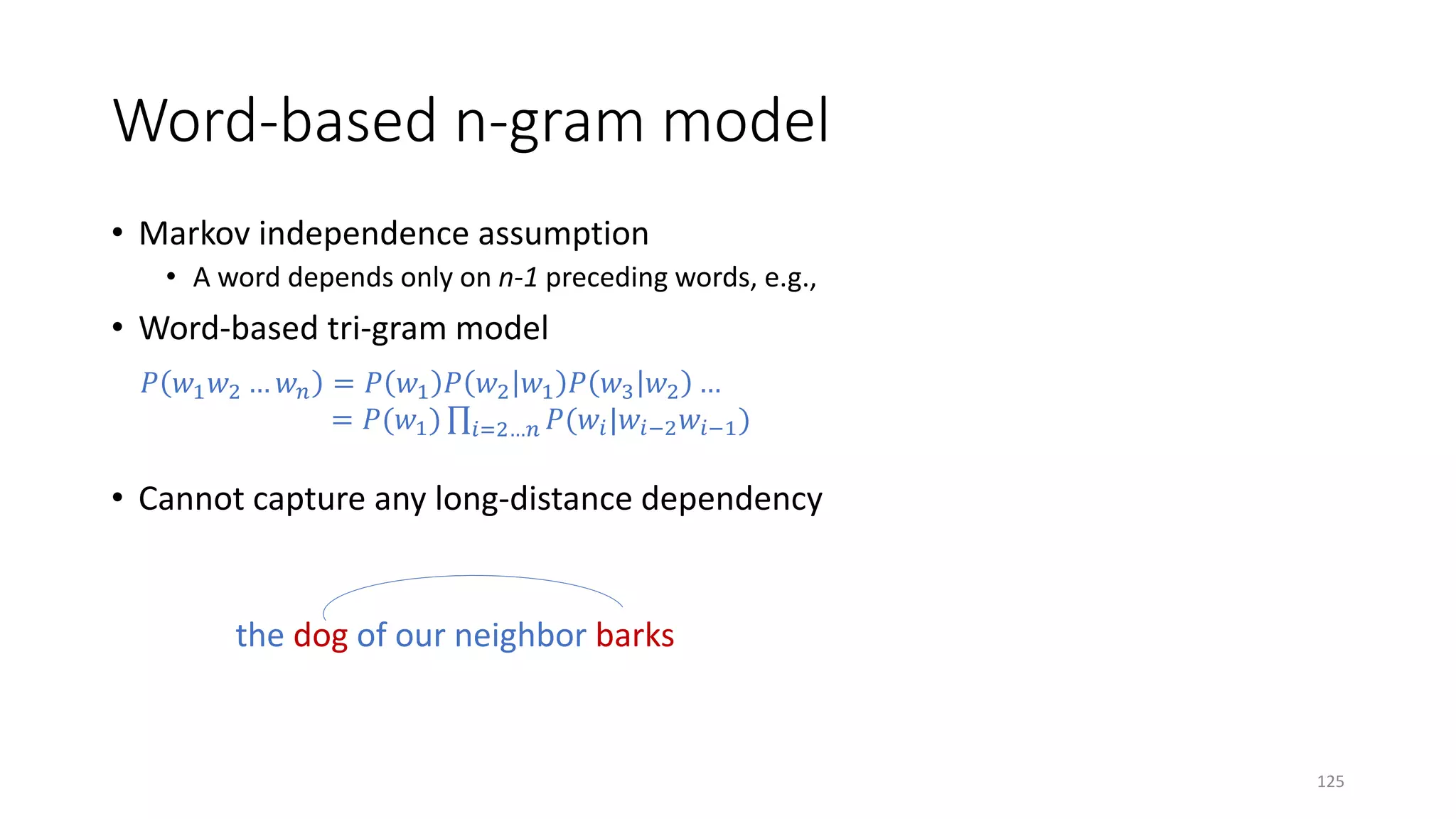
![Recurrent Neural Network (RNN) for Language Modeling
[Mikolov+ 11]
dog barks
runs
𝑥𝑥𝑡𝑡: input one-hot vector at time step 𝑡𝑡
ℎ𝑡𝑡: encodes the history of all words up to time step 𝑡𝑡
𝑦𝑦𝑡𝑡: distribution of output words at time step 𝑡𝑡
𝑧𝑧𝑡𝑡 = 𝐔𝐔𝑥𝑥𝑡𝑡 + 𝐖𝐖ℎ𝑡𝑡−1
ℎ𝑡𝑡 = 𝜎𝜎(𝑧𝑧𝑡𝑡)
𝑦𝑦𝑡𝑡 = 𝑔𝑔(𝐕𝐕ℎ𝑡𝑡)
where
𝜎𝜎 𝑧𝑧 =
1
1+exp(−𝑧𝑧)
, 𝑔𝑔 𝑧𝑧𝑚𝑚 =
exp(𝑧𝑧 𝑚𝑚)
∑𝑘𝑘 exp(𝑧𝑧𝑘𝑘)
……
𝑥𝑥𝑡𝑡
ℎ𝑡𝑡−1
𝑦𝑦𝑡𝑡
𝐕𝐕𝐔𝐔
𝐖𝐖 ℎ𝑡𝑡
……
𝑔𝑔(. ) is called the softmax function
dog barks
runs
……
𝑥𝑥𝑡𝑡 𝑦𝑦𝑡𝑡
𝐕𝐕𝐔𝐔
ℎ𝑡𝑡
……
delayed
𝐖𝐖
126](https://image.slidesharecdn.com/mitqptdarkanz785ioot-signature-233d5c007282b08e62cf0f4d0a5dd88f5ed85398db05a93a193537bbc0db97b6-poli-190707174549/75/BIng-NLP-Expert-Dl-summer-school-2017-jianfeng-gao-v2-126-2048.jpg)
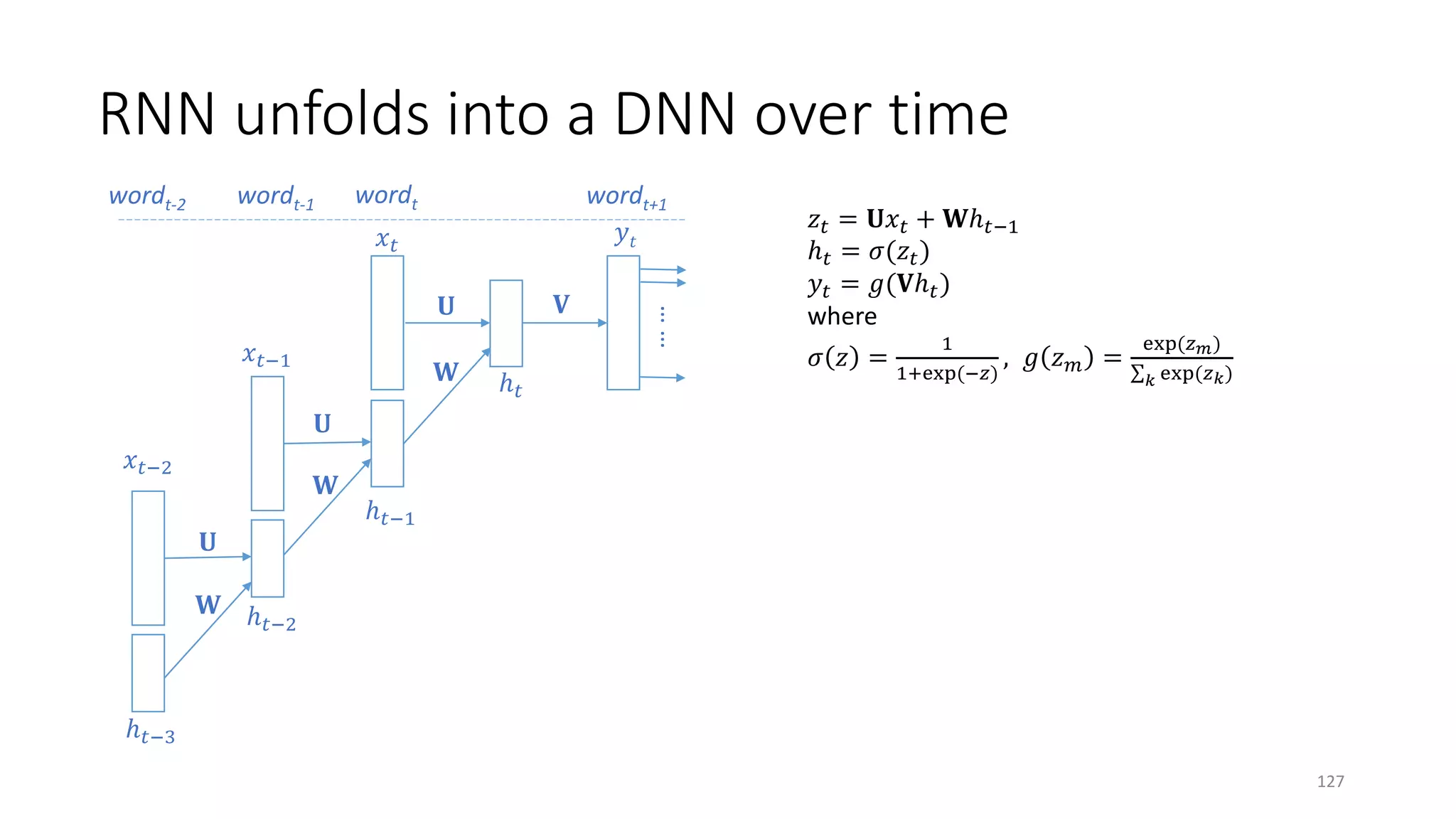
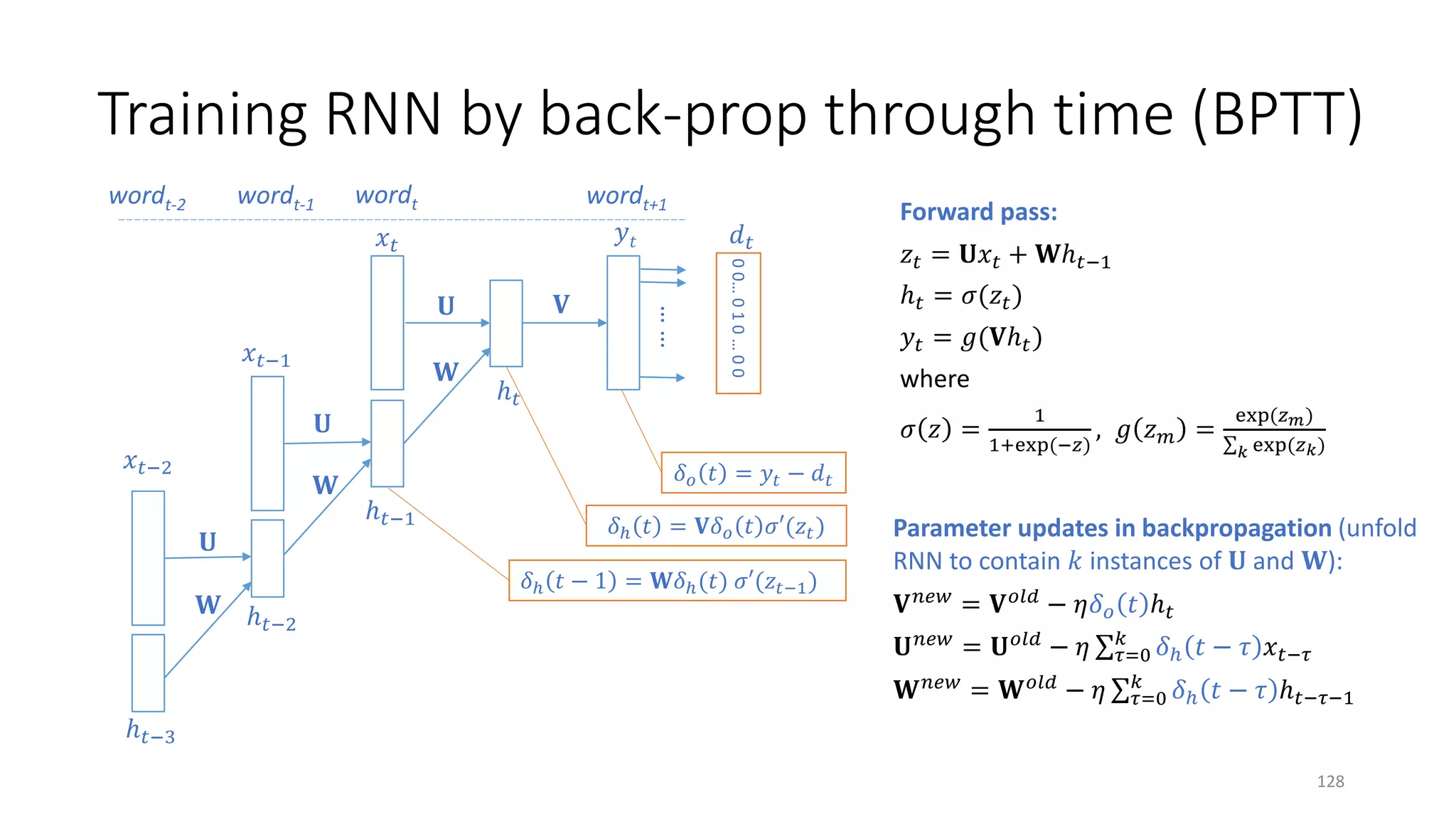

![RNN-LM word embedding: capture word meanings
in a continuous semantic space
Word Embedding Matrix
dog
summer
Denver
Seattle
1-hot vector
dim=|V|=100K~100M
Continuous vector
dim=100~1K
𝐔𝐔
Index of “dog” in
vocabulary
winter
puppy
[Mikolov+ 11; Mikolov+ 13]
130](https://image.slidesharecdn.com/mitqptdarkanz785ioot-signature-233d5c007282b08e62cf0f4d0a5dd88f5ed85398db05a93a193537bbc0db97b6-poli-190707174549/75/BIng-NLP-Expert-Dl-summer-school-2017-jianfeng-gao-v2-130-2048.jpg)
![• Word embedding taken from RNN-LM
• Relational similarity is derived by the cosine score
Unexpected Finding: Directional Similarity
king
queen
man
woman
𝜃𝜃
[Mikolov+ 11; Mikolov+ 13]](https://image.slidesharecdn.com/mitqptdarkanz785ioot-signature-233d5c007282b08e62cf0f4d0a5dd88f5ed85398db05a93a193537bbc0db97b6-poli-190707174549/75/BIng-NLP-Expert-Dl-summer-school-2017-jianfeng-gao-v2-131-2048.jpg)
![Distributed representation of words
• A lot of popular methods for creating word vectors!
• Vector Space Model [Salton & McGill 83]
• Latent Semantic Analysis [Deerwester+ 90]
• Brown Clustering [Brown+ 92]
• Latent Dirichlet Allocation [Blei+ 03]
• Deep Neural Networks [Collobert & Weston 08]
• DSSM [Huang+ 13]
• Word2Vec [Mikolov+ 13]
• GloVe [Pennington+ 14]
• Encode term co-occurrence information
• Measure semantic similarity well
132](https://image.slidesharecdn.com/mitqptdarkanz785ioot-signature-233d5c007282b08e62cf0f4d0a5dd88f5ed85398db05a93a193537bbc0db97b6-poli-190707174549/75/BIng-NLP-Expert-Dl-summer-school-2017-jianfeng-gao-v2-132-2048.jpg)
![Latent Semantic Analysis
𝐖𝐖 𝐔𝐔
𝐕𝐕 𝑇𝑇
≈
𝑑𝑑 × 𝑛𝑛 𝑑𝑑 × 𝑘𝑘
𝑘𝑘 × 𝑘𝑘 𝑘𝑘 × 𝑛𝑛
𝚺𝚺
terms
• SVD generalizes the original data
• Uncovers relationships not explicit in the thesaurus
• Term vectors projected to 𝑘𝑘-dim latent space
• Word similarity: cosine of two column vectors in 𝚺𝚺𝐕𝐕 𝑇𝑇
documents
[Deerwester+ 90]
133](https://image.slidesharecdn.com/mitqptdarkanz785ioot-signature-233d5c007282b08e62cf0f4d0a5dd88f5ed85398db05a93a193537bbc0db97b6-poli-190707174549/75/BIng-NLP-Expert-Dl-summer-school-2017-jianfeng-gao-v2-133-2048.jpg)
![CBOW and skip-gram word embeddings
The CBOW architecture (a) on the left, and the Skip-gram architecture (b) on the right.
Continuous Bag-of-Words
[Mikolov+ 13]
134](https://image.slidesharecdn.com/mitqptdarkanz785ioot-signature-233d5c007282b08e62cf0f4d0a5dd88f5ed85398db05a93a193537bbc0db97b6-poli-190707174549/75/BIng-NLP-Expert-Dl-summer-school-2017-jianfeng-gao-v2-134-2048.jpg)
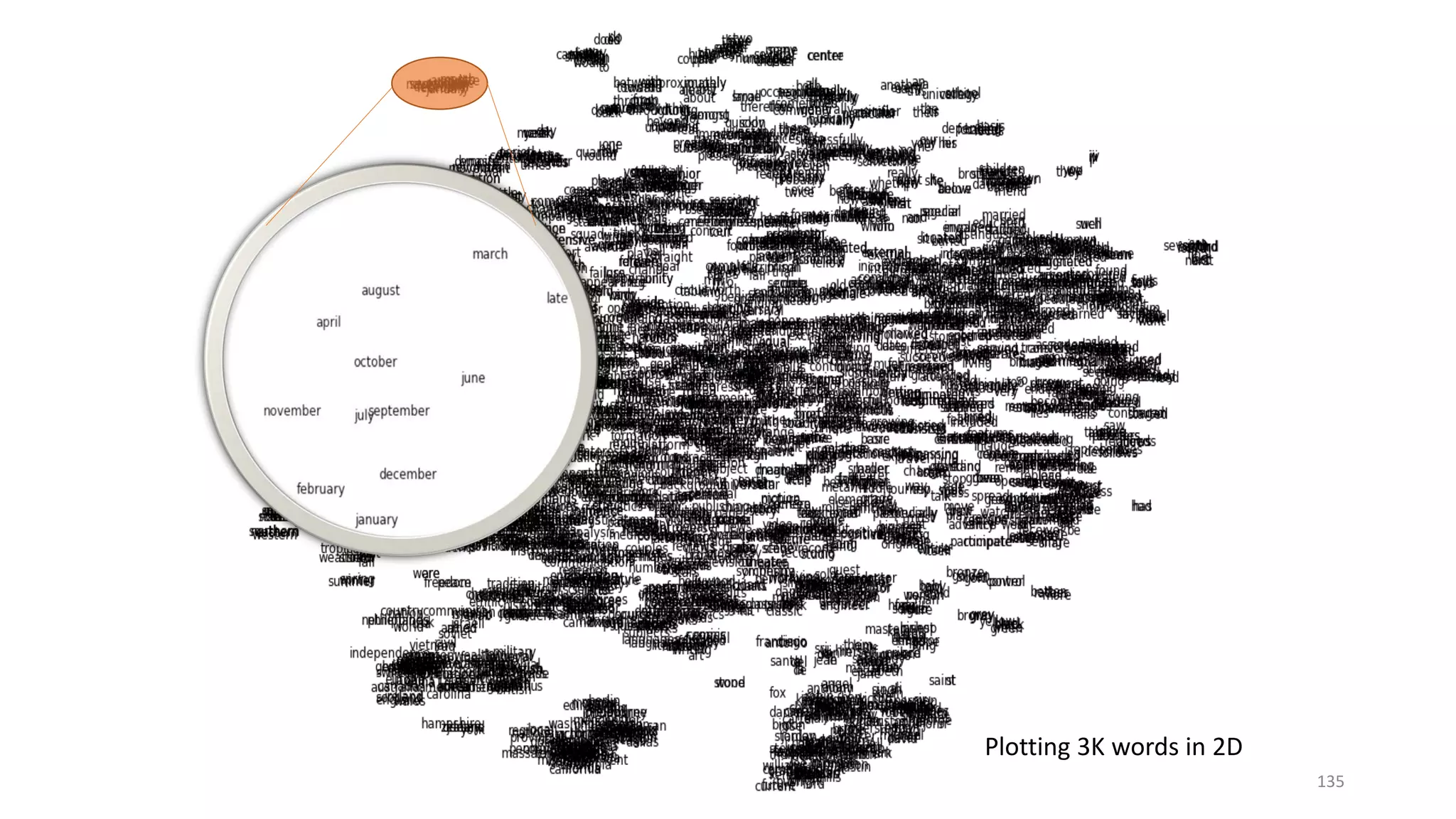
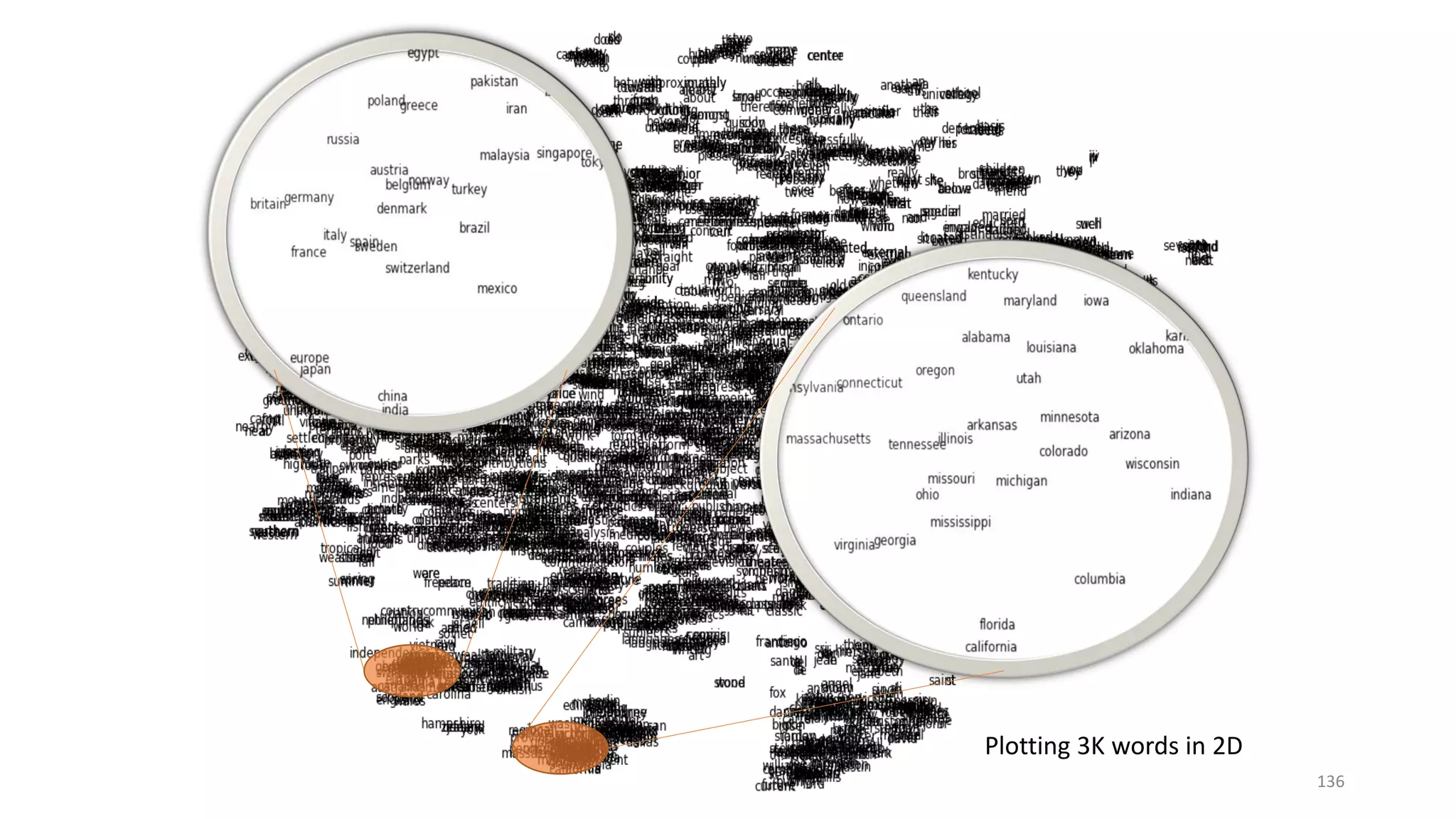
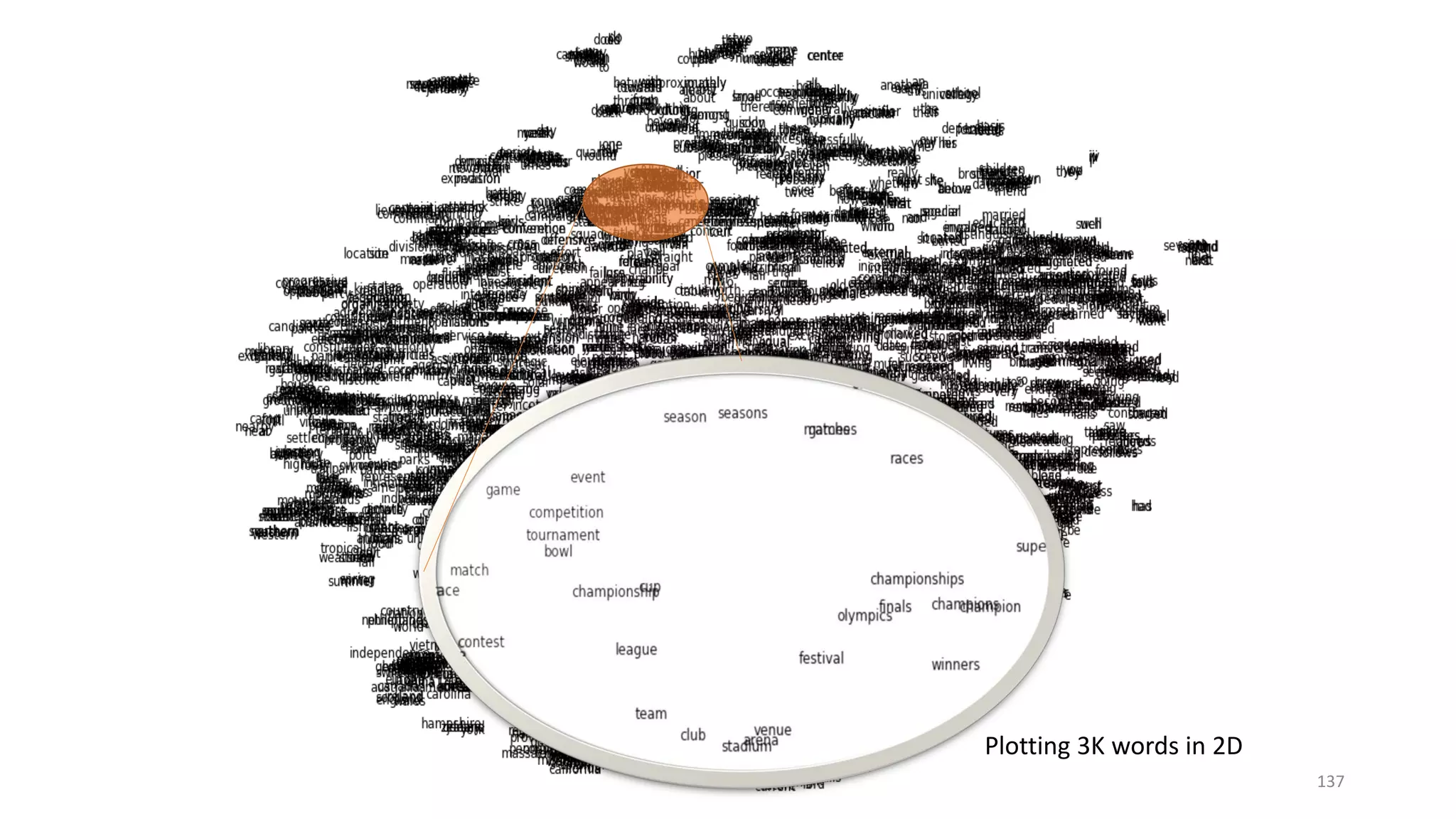
![summer : rain = winter : 𝒙𝒙 snow (0.79) rainfall (0.73) wet (0.71)
italy : rome = france : 𝒙𝒙 paris (0.78) constantinople (0.74) egypt (0.73)
man : eye = car : 𝒙𝒙 motor (0.64) brake (0.58) overhead (0.58)
man : woman = king : 𝒙𝒙 mary (0.70) prince (0.70) queen (0.68)
read : book = listen : 𝒙𝒙 sequel (0.65) tale (0.63) song (0.60)
Semantic reasoning examples (how words relate to one another)
Semantic reasoning
𝑤𝑤1: 𝑤𝑤2 = 𝑤𝑤3 ∶ 𝑥𝑥 ⇒ 𝑉𝑉𝑥𝑥 = 𝑉𝑉3 − 𝑉𝑉1 + 𝑉𝑉2
*Note that the DSSM used in these examples are trained in an unsupervised manner, as Google’s word2vec.
Vector arithmetic = Similarity arithmetic [Levy & Goldberg CoNLL-14]
Find the closest 𝑥𝑥 to 𝑘𝑘𝑘𝑘𝑘𝑘𝑘𝑘 − 𝑚𝑚𝑚𝑚𝑚𝑚 + 𝑤𝑤𝑤𝑤𝑤𝑤𝑤𝑤𝑤𝑤 by
arg max
𝑥𝑥
cos 𝑥𝑥, 𝑘𝑘𝑘𝑘𝑘𝑘𝑘𝑘 − 𝑚𝑚𝑚𝑚𝑚𝑚 + 𝑤𝑤𝑤𝑤𝑤𝑤𝑤𝑤𝑤𝑤 =
arg max
𝑥𝑥
cos 𝑥𝑥, 𝑘𝑘𝑘𝑘𝑘𝑘𝑘𝑘 − cos 𝑥𝑥, 𝑚𝑚𝑚𝑚𝑚𝑚 + cos 𝑥𝑥, 𝑤𝑤𝑤𝑤𝑤𝑤𝑤𝑤𝑤𝑤
138](https://image.slidesharecdn.com/mitqptdarkanz785ioot-signature-233d5c007282b08e62cf0f4d0a5dd88f5ed85398db05a93a193537bbc0db97b6-poli-190707174549/75/BIng-NLP-Expert-Dl-summer-school-2017-jianfeng-gao-v2-138-2048.jpg)
![summer : rain = winter : 𝒙𝒙 snow (0.79) rainfall (0.73) wet (0.71)
italy : rome = france : 𝒙𝒙 paris (0.78) constantinople (0.74) egypt (0.73)
man : eye = car : 𝒙𝒙 motor (0.64) brake (0.58) overhead (0.58)
man : woman = king : 𝒙𝒙 mary (0.70) prince (0.70) queen (0.68)
read : book = listen : 𝒙𝒙 sequel (0.65) tale (0.63) song (0.60)
Semantic reasoning examples (how words relate to one another)
Semantic reasoning
𝑤𝑤1: 𝑤𝑤2 = 𝑤𝑤3 ∶ 𝑥𝑥 ⇒ 𝑉𝑉𝑥𝑥 = 𝑉𝑉3 − 𝑉𝑉1 + 𝑉𝑉2
*Note that the DSSM used in these examples are trained in an unsupervised manner, as Google’s word2vec.
Vector arithmetic = Similarity arithmetic [Levy & Goldberg CoNLL-14]
Find the closest 𝑥𝑥 to 𝑘𝑘𝑘𝑘𝑘𝑘𝑘𝑘 − 𝑚𝑚𝑚𝑚𝑚𝑚 + 𝑤𝑤𝑤𝑤𝑤𝑤𝑤𝑤𝑤𝑤 by
arg max
𝑥𝑥
cos 𝑥𝑥, 𝑘𝑘𝑘𝑘𝑘𝑘𝑘𝑘 − 𝑚𝑚𝑚𝑚𝑚𝑚 + 𝑤𝑤𝑤𝑤𝑤𝑤𝑤𝑤𝑤𝑤 =
arg max
𝑥𝑥
cos 𝑥𝑥, 𝑘𝑘𝑘𝑘𝑘𝑘𝑘𝑘 − cos 𝑥𝑥, 𝑚𝑚𝑚𝑚𝑚𝑚 + cos 𝑥𝑥, 𝑤𝑤𝑤𝑤𝑤𝑤𝑤𝑤𝑤𝑤
139](https://image.slidesharecdn.com/mitqptdarkanz785ioot-signature-233d5c007282b08e62cf0f4d0a5dd88f5ed85398db05a93a193537bbc0db97b6-poli-190707174549/75/BIng-NLP-Expert-Dl-summer-school-2017-jianfeng-gao-v2-139-2048.jpg)
![Statistical machine translation (SMT)
Statistical decision: 𝑇𝑇∗ = argmax
𝑇𝑇
𝑃𝑃(𝑇𝑇|𝑆𝑆)
Source-channel model: 𝑇𝑇∗
= argmax
𝑇𝑇
𝑃𝑃(𝑆𝑆|𝑇𝑇)𝑃𝑃(𝑇𝑇)
Translation models: 𝑃𝑃(𝑆𝑆|𝑇𝑇) and 𝑃𝑃(𝑇𝑇|𝑆𝑆)
Language model: 𝑃𝑃(𝑇𝑇)
Log-linear model: 𝑃𝑃(𝑇𝑇|𝑆𝑆) =
1
𝑍𝑍 𝑆𝑆,𝑇𝑇
exp ∑𝑖𝑖 𝜆𝜆𝑖𝑖ℎ𝑖𝑖(𝑆𝑆, 𝑇𝑇)
Evaluation metric: BLEU score (higher is better)
S: 救援 人员 在 倒塌的 房屋 里 寻找 生还者
T: Rescue workers search for survivors in collapsed houses
[Koehn 09]
140](https://image.slidesharecdn.com/mitqptdarkanz785ioot-signature-233d5c007282b08e62cf0f4d0a5dd88f5ed85398db05a93a193537bbc0db97b6-poli-190707174549/75/BIng-NLP-Expert-Dl-summer-school-2017-jianfeng-gao-v2-140-2048.jpg)
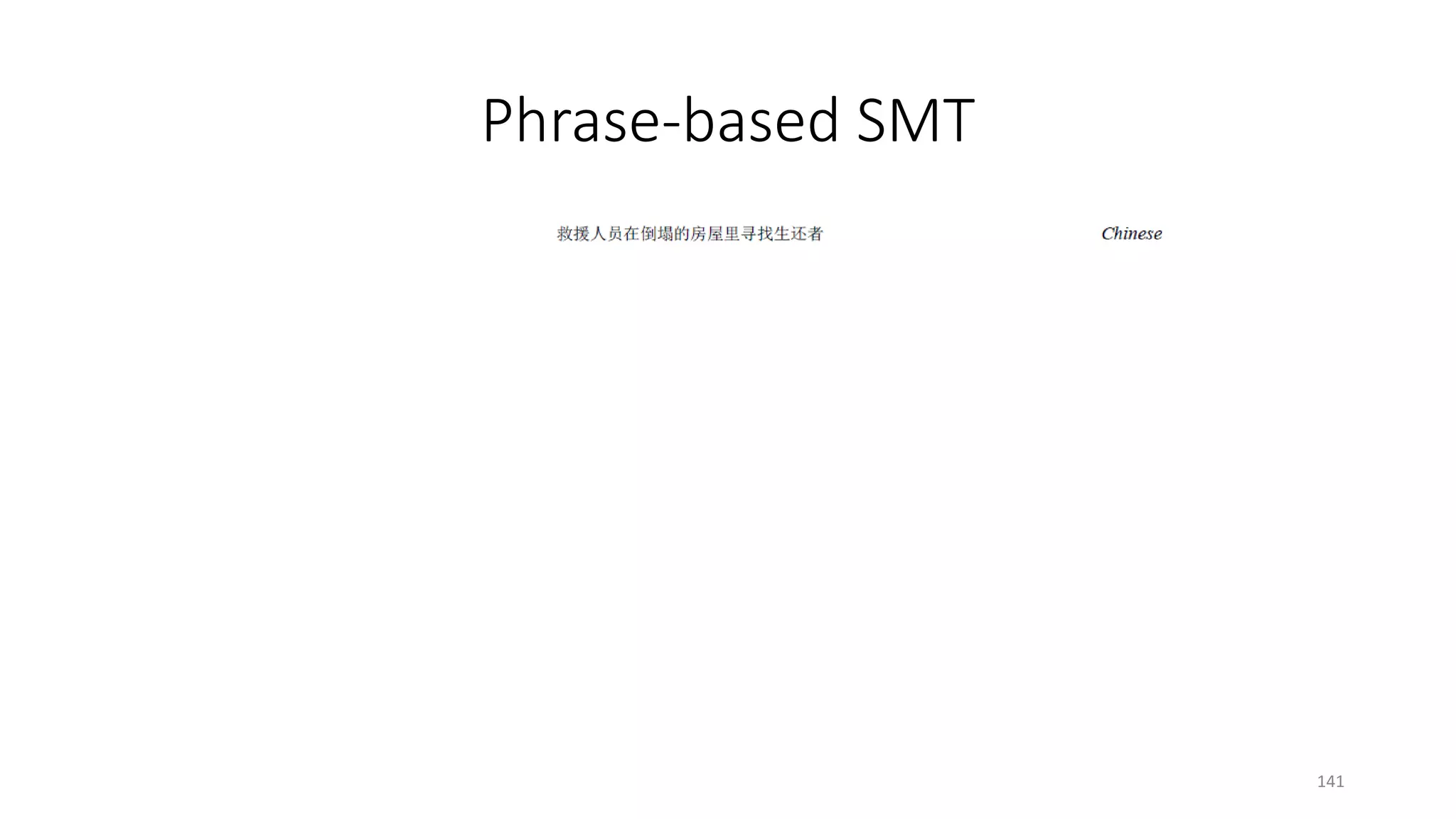
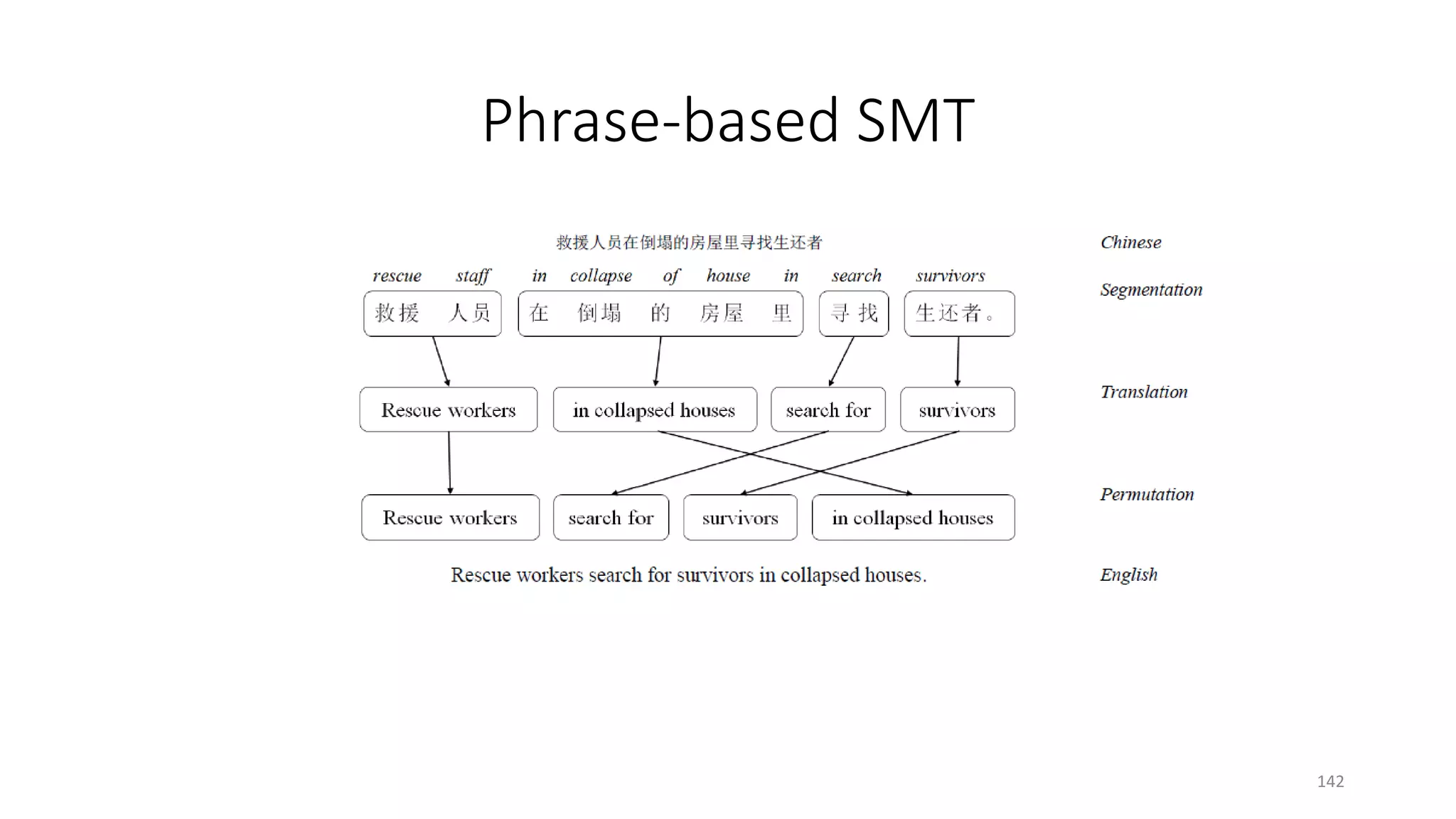
![Examples of neural models for MT
• Neural nets as components in log-linear models of SMT, e.g.,
• Translation model 𝑃𝑃(𝑇𝑇|𝑆𝑆) or 𝑃𝑃(𝑆𝑆|𝑇𝑇): the use of DSSM [Gao+ 14a]
• Language model 𝑃𝑃(𝑇𝑇): the use of RNN [Auli+ 2013; Auli & Gao 14]
• Joint model 𝑃𝑃(𝑡𝑡𝑖𝑖|𝑆𝑆, 𝑡𝑡1 … 𝑡𝑡𝑖𝑖−1): FFLM + source words [Devlin+ 14]
• Neural machine translation (NMT)
• Build a single, large NN that reads a sentence and outputs a translation
• RNN encoder-decoder [Cho+ 2014; Sutskever+ 14]
• Long short-term memory (gated hidden units)
• Jointly learning to align and translate [Bahdanau+ 15]
• NMT surpassed the best result on a WMT task [Luong+ 15]
• Google’s NMT system [Wu+ 16]
• RNN or not? [Gehring+ 17; Vaswani+ 17]
143](https://image.slidesharecdn.com/mitqptdarkanz785ioot-signature-233d5c007282b08e62cf0f4d0a5dd88f5ed85398db05a93a193537bbc0db97b6-poli-190707174549/75/BIng-NLP-Expert-Dl-summer-school-2017-jianfeng-gao-v2-143-2048.jpg)
![Neural machine translation
• Build a single, large NN that reads a sentence and outputs a translation
• Unlike phrase-based system that consists of many component models
• Encoder-decoder based approach
• An encoder RNN reads and encodes a source sentence into a fixed-length
memory vector
• A decoder RNN outputs a variable-length translation from the encoded
memory vector
• Encoder-decoder RNNs are jointly learned on bitext, optimizing target
likelihood
[Sutskever+ 14; Cho+ 14; Bahdanau+ 15; Luong+ 15] 144](https://image.slidesharecdn.com/mitqptdarkanz785ioot-signature-233d5c007282b08e62cf0f4d0a5dd88f5ed85398db05a93a193537bbc0db97b6-poli-190707174549/75/BIng-NLP-Expert-Dl-summer-school-2017-jianfeng-gao-v2-144-2048.jpg)
![Encoder-decoder model of [Sutskever+ 2014]
• “A B C” is source sentence; “W X Y Z” is target sentence
• Treat MT as general sequence-to-sequence transduction
• Read source; accumulate hidden state; generate target
• <EOS> token stops the recurrent process
• In practice, read source sentence in reverse leads to better MT results
• Train on bitext; optimize target likelihood using SGD
[Sutskever+ 14] 145](https://image.slidesharecdn.com/mitqptdarkanz785ioot-signature-233d5c007282b08e62cf0f4d0a5dd88f5ed85398db05a93a193537bbc0db97b6-poli-190707174549/75/BIng-NLP-Expert-Dl-summer-school-2017-jianfeng-gao-v2-145-2048.jpg)
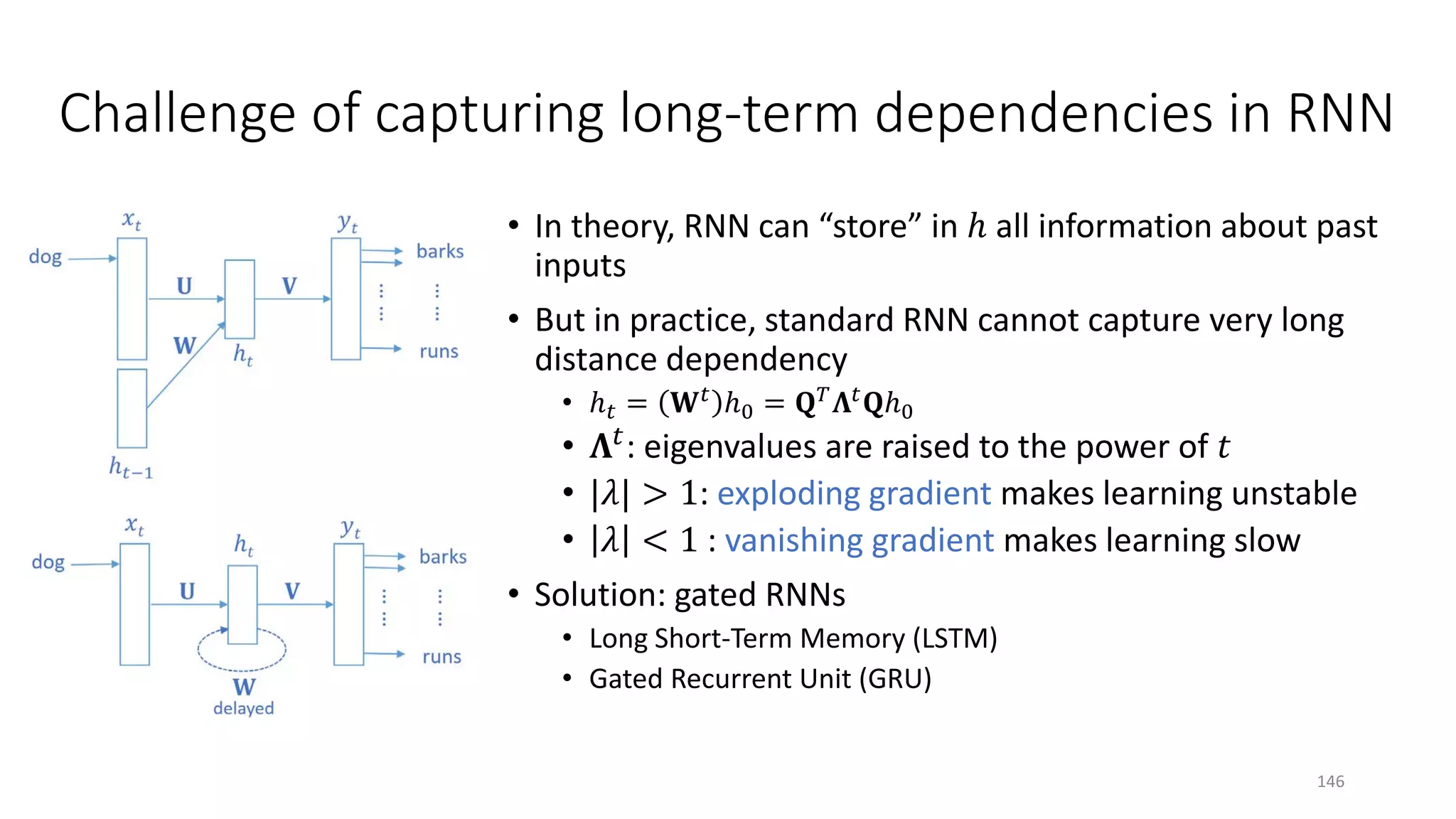
![Long Short-Term Memory (LSTM)
Information flow in an LSTM unit of the RNN, with both diagrammatic and mathematical descriptions. W’s are weight matrices, not shown
but can easily be inferred in the diagram (Graves et al., 2013).
[Hochreiter & Schmidhuber 97; Graves+ 13] 147](https://image.slidesharecdn.com/mitqptdarkanz785ioot-signature-233d5c007282b08e62cf0f4d0a5dd88f5ed85398db05a93a193537bbc0db97b6-poli-190707174549/75/BIng-NLP-Expert-Dl-summer-school-2017-jianfeng-gao-v2-147-2048.jpg)
![Gated Recurrent Unit (GRU)
[Cho+ 14] 148](https://image.slidesharecdn.com/mitqptdarkanz785ioot-signature-233d5c007282b08e62cf0f4d0a5dd88f5ed85398db05a93a193537bbc0db97b6-poli-190707174549/75/BIng-NLP-Expert-Dl-summer-school-2017-jianfeng-gao-v2-148-2048.jpg)
![Joint learning to align and translate
• Issue with encoder-decoder model for SMT
• Compressing a source sentence into a fixed-length vector makes it
difficult for RNN to cope with long sentences.
• Attention model of [Bahdanau+ 15]
• Encodes the input sentence into a sequence of vectors and choose
a subset of these vectors adaptively while decoding
• An idea similar to that of [Devlin+ 14]
[Bahdanan+ 15] 149](https://image.slidesharecdn.com/mitqptdarkanz785ioot-signature-233d5c007282b08e62cf0f4d0a5dd88f5ed85398db05a93a193537bbc0db97b6-poli-190707174549/75/BIng-NLP-Expert-Dl-summer-school-2017-jianfeng-gao-v2-149-2048.jpg)
![Attention model of [Bahdanau+ 15]
• Encoder:
• bidirectional RNN to encode each word and its context
• Decoder:
• Searches for a set of source words that are most relevant
to the target word to be predicted.
• Predicts a target word based on the context vectors
associated with these source words and all the previous
generated target words.
• Close to state-of-the-art performance
• Better at translating long sentences
[Bahdanan+ 15] 150](https://image.slidesharecdn.com/mitqptdarkanz785ioot-signature-233d5c007282b08e62cf0f4d0a5dd88f5ed85398db05a93a193537bbc0db97b6-poli-190707174549/75/BIng-NLP-Expert-Dl-summer-school-2017-jianfeng-gao-v2-150-2048.jpg)
![Google’s NTM system
[Wu+ 16]
• Deep RNNs
• Residual connections
• Bi-directional encoder for first
layer
• The use of sub-word units
• Model parallelism
151](https://image.slidesharecdn.com/mitqptdarkanz785ioot-signature-233d5c007282b08e62cf0f4d0a5dd88f5ed85398db05a93a193537bbc0db97b6-poli-190707174549/75/BIng-NLP-Expert-Dl-summer-school-2017-jianfeng-gao-v2-151-2048.jpg)
![Convolutional S2S model
[Gehring+ 17]
Convolutional models beat Recurrent models
152](https://image.slidesharecdn.com/mitqptdarkanz785ioot-signature-233d5c007282b08e62cf0f4d0a5dd88f5ed85398db05a93a193537bbc0db97b6-poli-190707174549/75/BIng-NLP-Expert-Dl-summer-school-2017-jianfeng-gao-v2-152-2048.jpg)
![Attention is all you need?!
[Vaswani+ 17]
153](https://image.slidesharecdn.com/mitqptdarkanz785ioot-signature-233d5c007282b08e62cf0f4d0a5dd88f5ed85398db05a93a193537bbc0db97b6-poli-190707174549/75/BIng-NLP-Expert-Dl-summer-school-2017-jianfeng-gao-v2-153-2048.jpg)
![Social Bots
• The success of XiaoIce (小冰)
• Problem setting and evaluation
• Maximize the user engagement by automatically generating
• enjoyable and useful conversations
• Learning a neural conversation engine
• A data driven engine trained on social chitchat data [Sordoni+ 15; Li+ 16a]
• Persona based models and speaker-role based models [Li+ 16b; Luan+ 17]
• Image-grounded models [Mostafazadeh+ 17]
• Knowledge-grounded models [Ghazvininejad+ 17]
154](https://image.slidesharecdn.com/mitqptdarkanz785ioot-signature-233d5c007282b08e62cf0f4d0a5dd88f5ed85398db05a93a193537bbc0db97b6-poli-190707174549/75/BIng-NLP-Expert-Dl-summer-school-2017-jianfeng-gao-v2-154-2048.jpg)
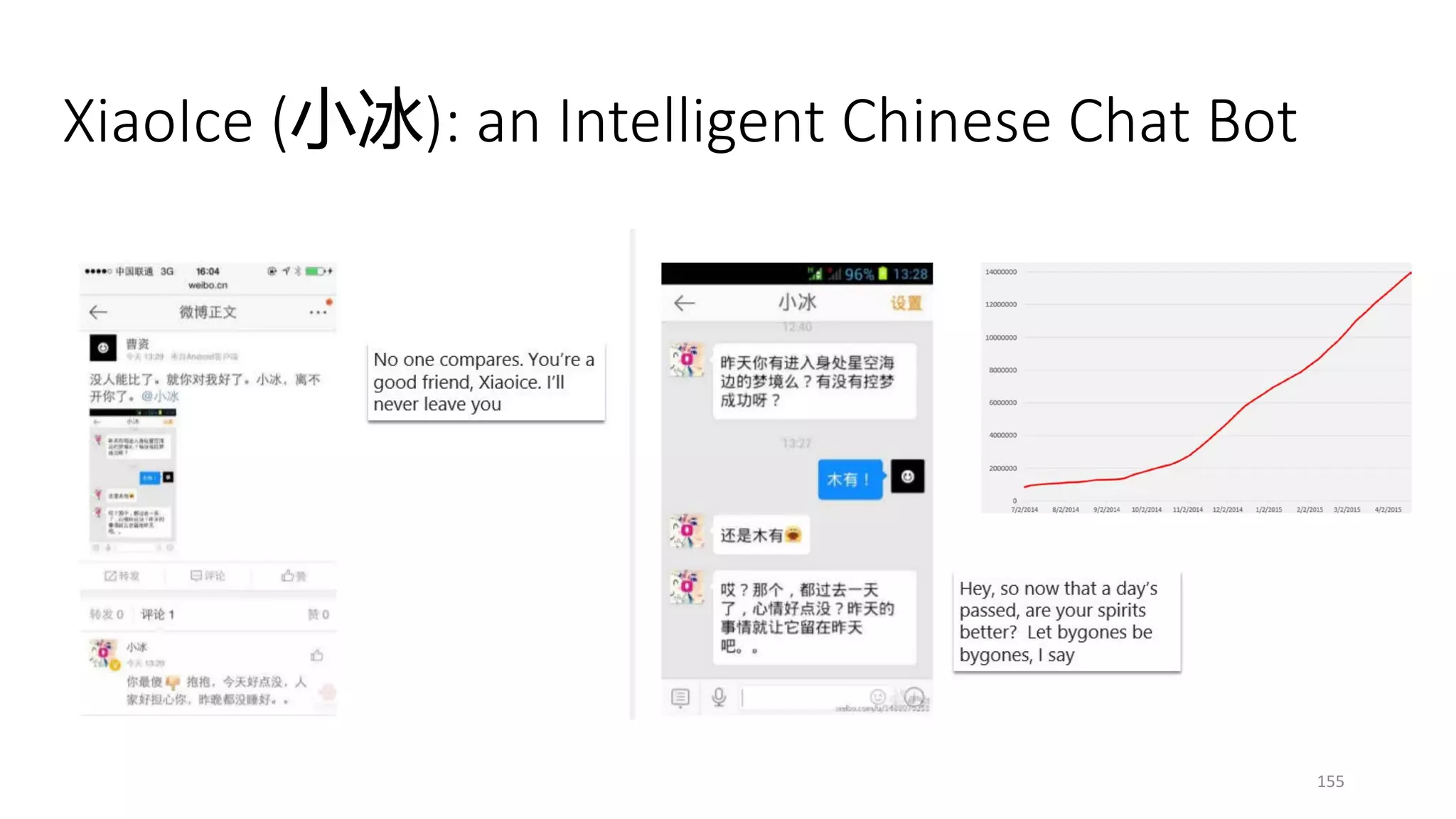

![MSR’s neural conversation engine
Neural model learns the general shape of conversation, and
the system output is situationally appropriate and
coherent…
H: hi
M: how are you ?
H: not bad
M: what 's wrong ?
H: nothing really
M: wan na talk about it ? i 'm here if you wan na talk x
H: well , i 'm just tired
M: me too , i 'm here if you wan na talk
H: thanks , what are you doing ?
M: you 're welcome and i 'm watching tv and you ?
H: on netflix ?
M: yeah , i 'm watching it on netflix .
H: what are you watching ?
M: a tv show .
H: nice , did you have dinner already ?
M: no , not yet . what about you ?
A more goal-oriented example. No grounding into a real calendar,
but the “shape” of the conversation is fluent and plausible…
H: would thursday afternoon work sometime ?
M: yeah , sure . just let me know when you ‘re free .
H: after lunch is probably the best time
M: okay , sounds good . just let me know when you ‘re free .
H: would 2 pm work for you ?
M: works for me .
H: well let ‘s say 2 pm then i ‘ll see you there
M: sounds good .
A complementary solution to XiaoIce
- Generating responses vs. retrieving responses
- Easy to incorporate contextual info via embedding
- User profile – personalized conversation
- knowledge bases – grounded conversation
- The engine is E2E learned from conversation experience
- Learning a goal-oriented conversation engine via RL
[Sordoni+ 15; Li+ 16a]
157](https://image.slidesharecdn.com/mitqptdarkanz785ioot-signature-233d5c007282b08e62cf0f4d0a5dd88f5ed85398db05a93a193537bbc0db97b6-poli-190707174549/75/BIng-NLP-Expert-Dl-summer-school-2017-jianfeng-gao-v2-157-2048.jpg)
![Evaluation of Social Bots
• The correct response is unknown, or not unique!
• How NOT to use BLEU, ROUGE etc. [Liu+ 16]
• Instead good/bad, we measure responses from various aspects, e.g.,
• Interestingness & Engagingness [Li+ 16a; Li+ 16c]
• Persona, consistency [Li+ 16b]
• Persona, speaker-role [Luan+ 17]
• Contentfulness & usefulness [Mostafazadeh+ 17; Ghazvininejad+ 17]
158](https://image.slidesharecdn.com/mitqptdarkanz785ioot-signature-233d5c007282b08e62cf0f4d0a5dd88f5ed85398db05a93a193537bbc0db97b6-poli-190707174549/75/BIng-NLP-Expert-Dl-summer-school-2017-jianfeng-gao-v2-158-2048.jpg)
![Target:
response
decoder
Neural Models for Response Generation
159
Yeah
EOS
I’m
Yeah
on
I’m
my
on
way
my
[Sordoni+ 15; Vinyals & Le 15; Shang+ 15]
… because of your game?
Source:
conversation history
encoder](https://image.slidesharecdn.com/mitqptdarkanz785ioot-signature-233d5c007282b08e62cf0f4d0a5dd88f5ed85398db05a93a193537bbc0db97b6-poli-190707174549/75/BIng-NLP-Expert-Dl-summer-school-2017-jianfeng-gao-v2-159-2048.jpg)
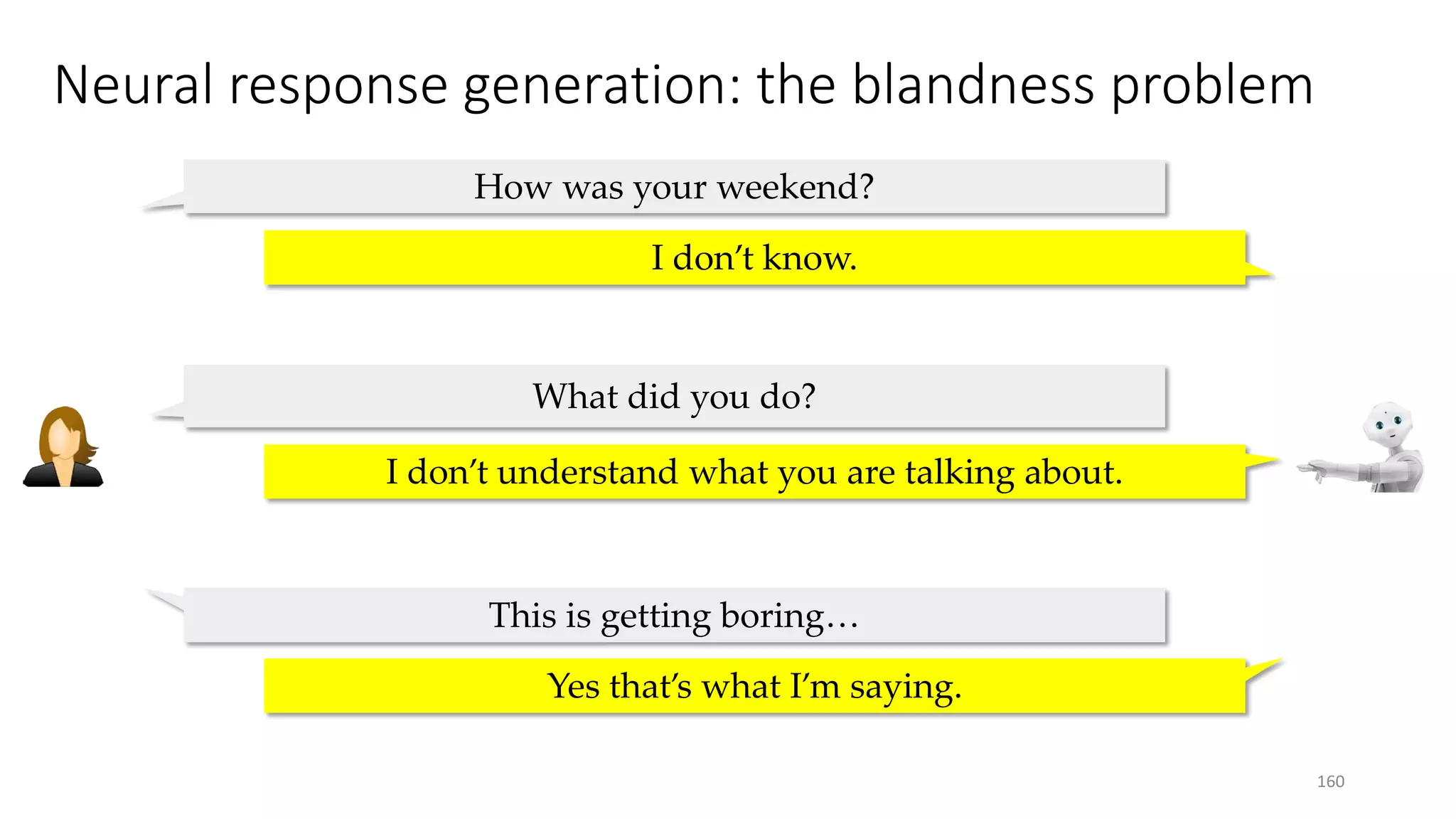
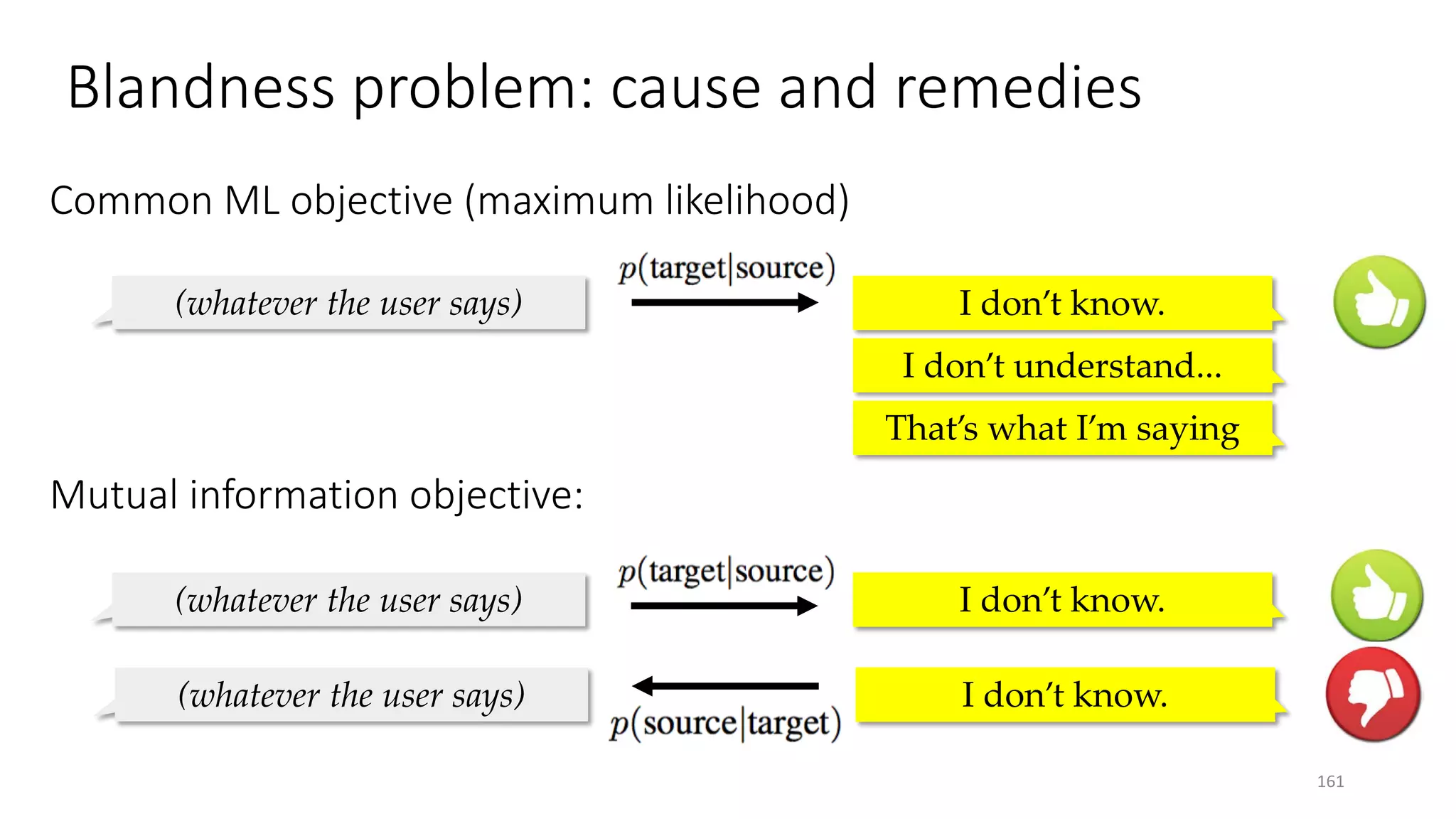
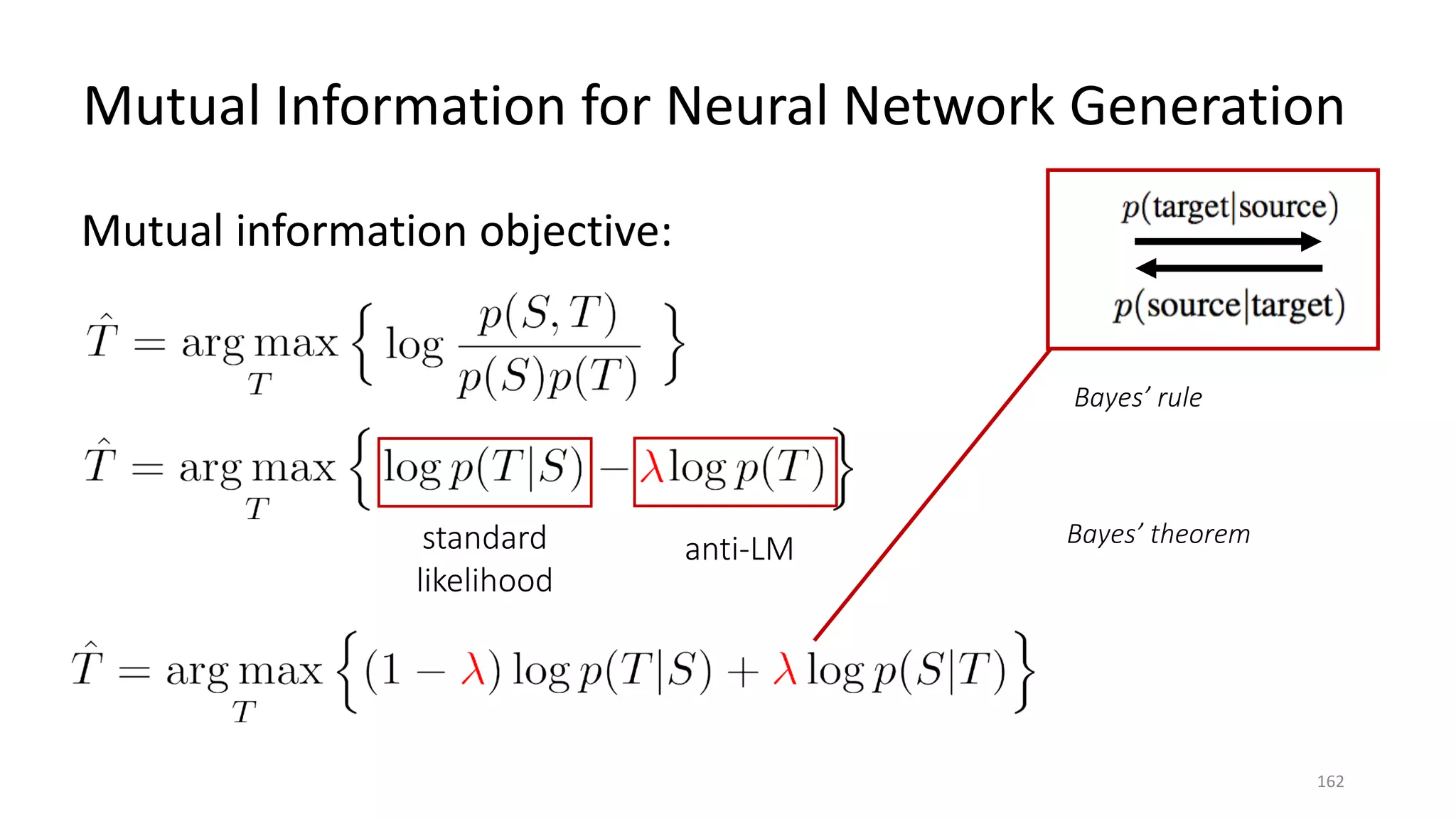
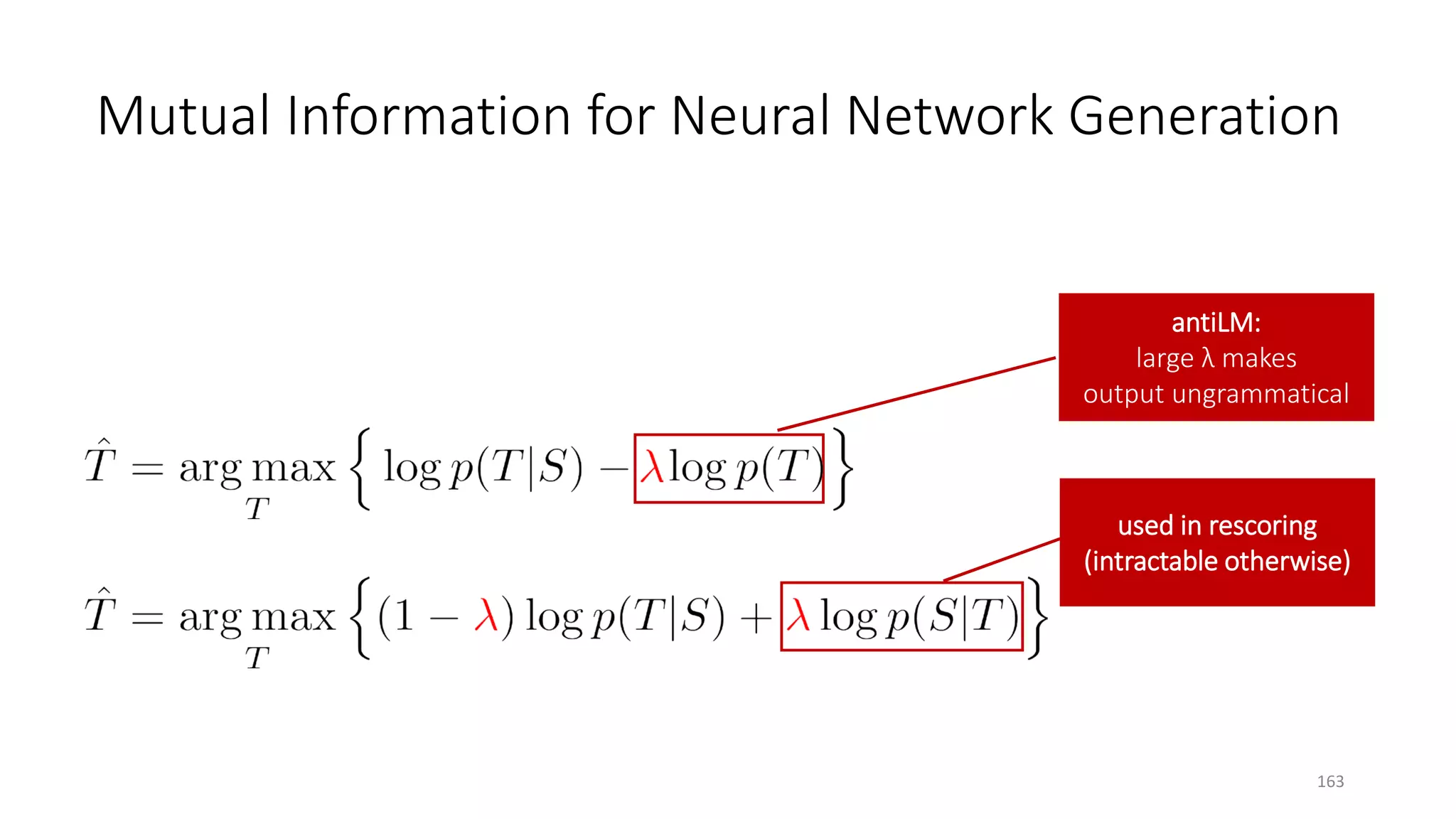
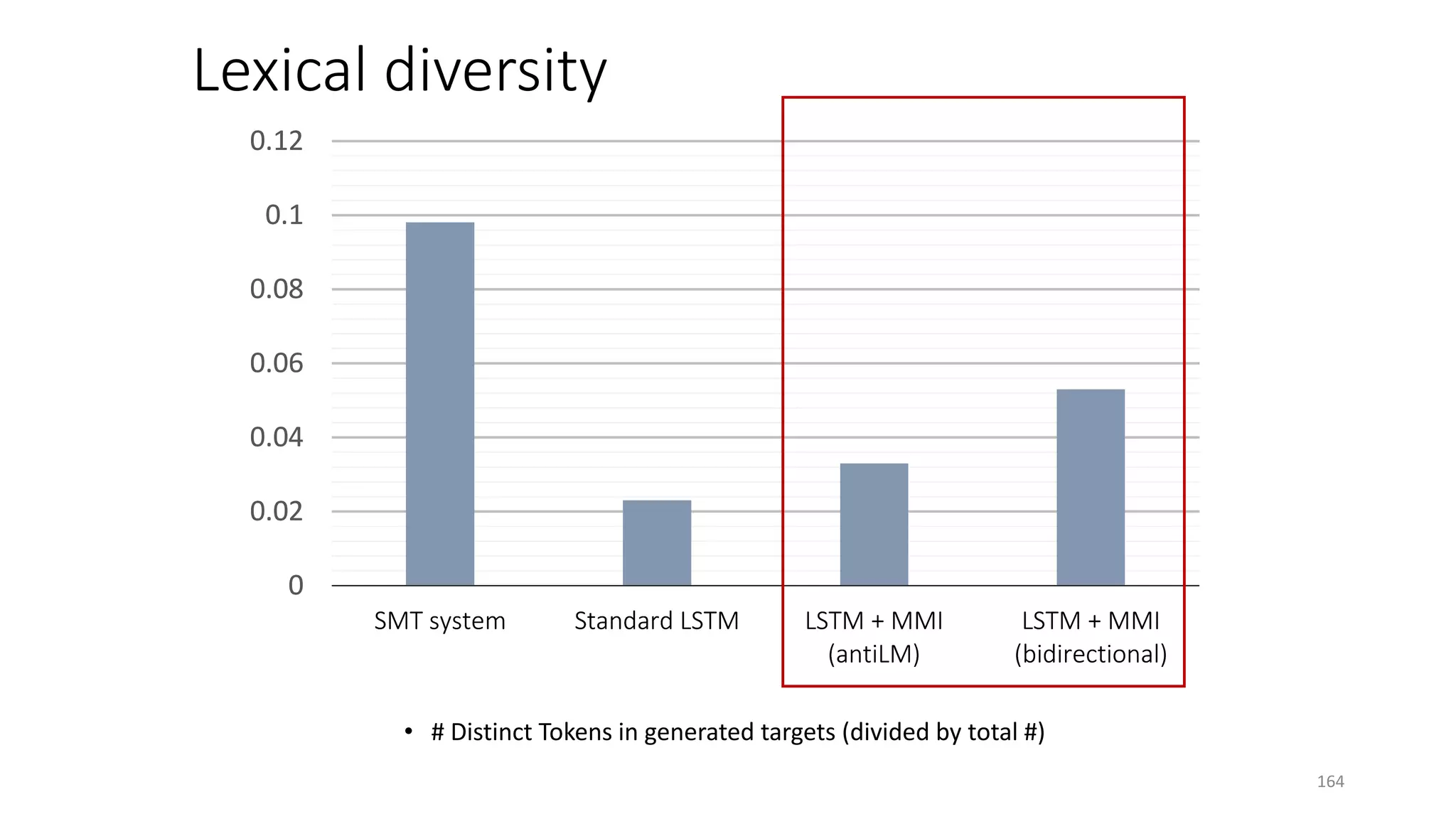

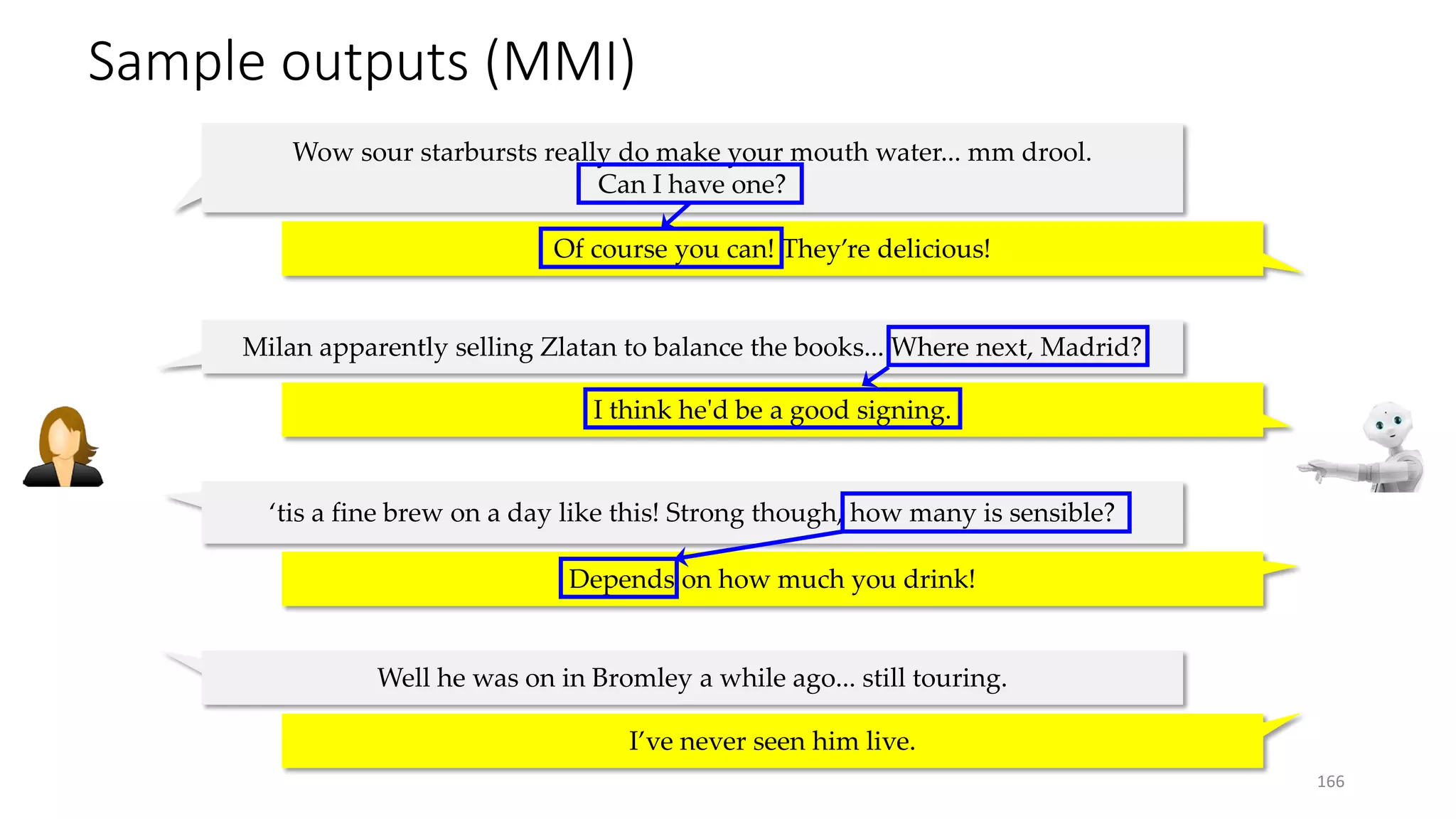
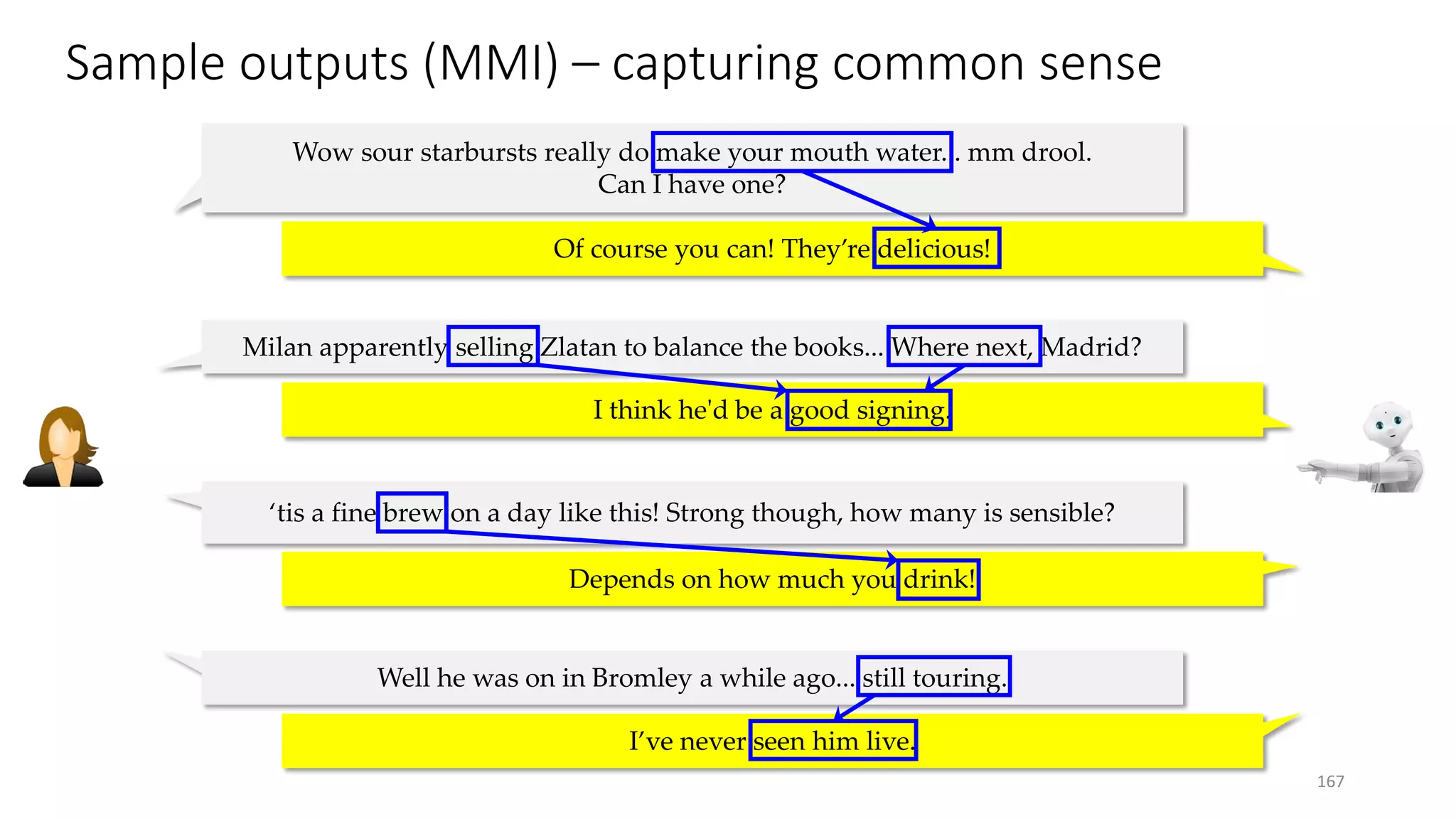
![Input message Supervised Learning Agent Reinforcement Learning Agent
• RL agent generates more interactive responses
• RL agent tends to end a sentence with a question and hand the
conversation over to the user
• Next step: explore intrinsic rewards, large-scale training
Deep reinforcement learning for social bots
[Li+ 16c]
168](https://image.slidesharecdn.com/mitqptdarkanz785ioot-signature-233d5c007282b08e62cf0f4d0a5dd88f5ed85398db05a93a193537bbc0db97b6-poli-190707174549/75/BIng-NLP-Expert-Dl-summer-school-2017-jianfeng-gao-v2-168-2048.jpg)
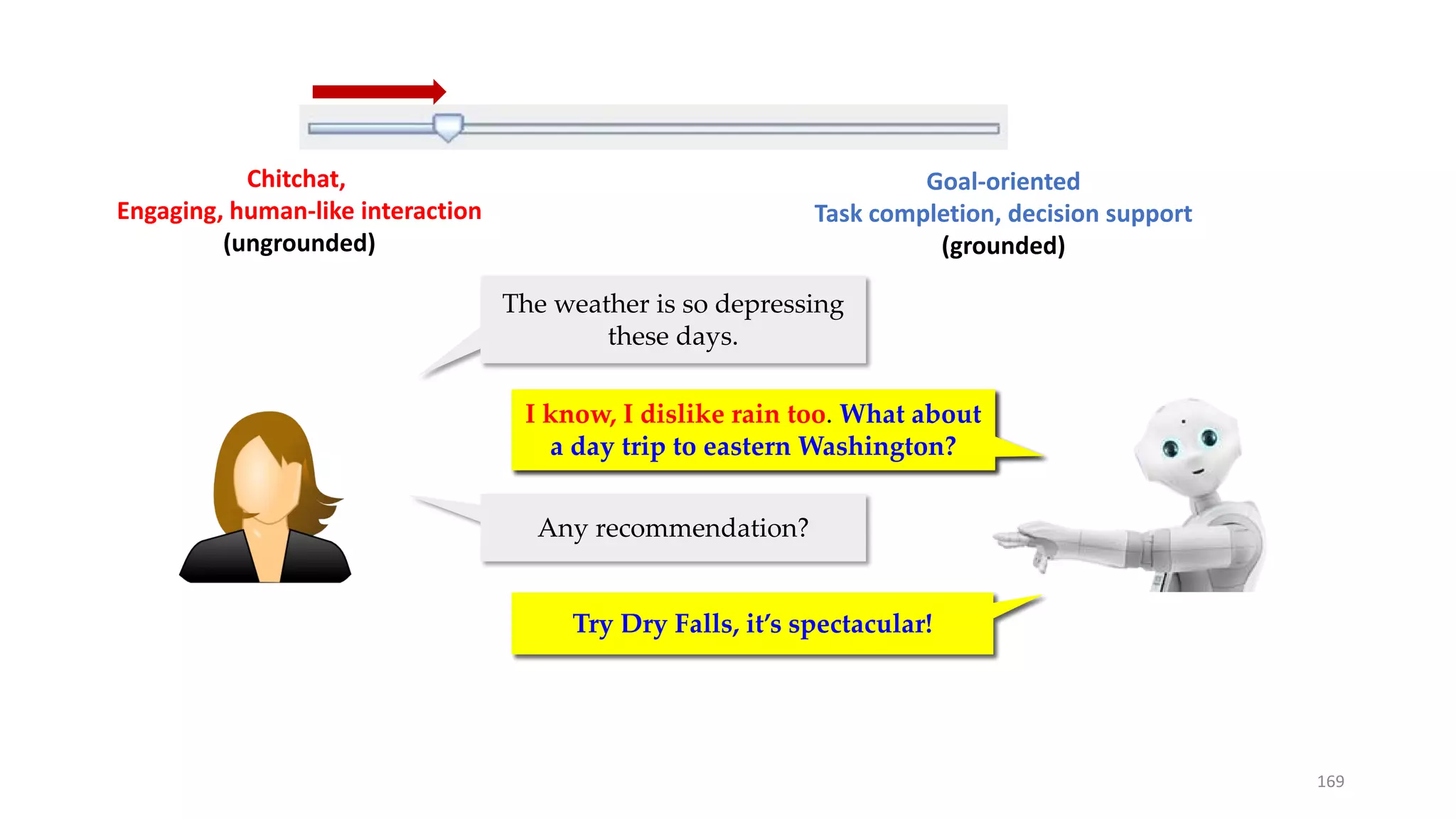
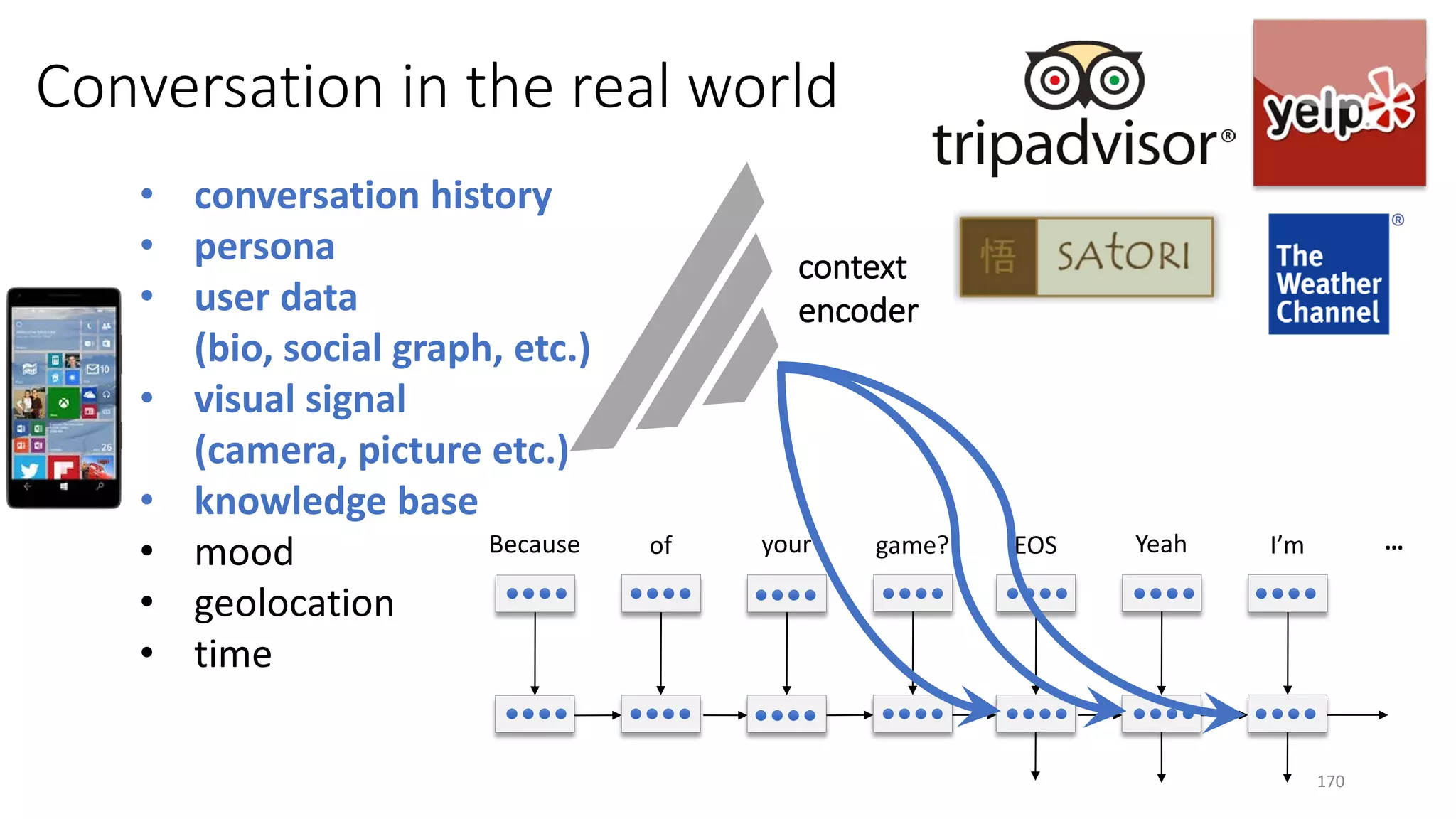
![Persona model results: consistency and speaker-role
Baseline model: Persona model using speaker embedding [Li+ 16b]
171](https://image.slidesharecdn.com/mitqptdarkanz785ioot-signature-233d5c007282b08e62cf0f4d0a5dd88f5ed85398db05a93a193537bbc0db97b6-poli-190707174549/75/BIng-NLP-Expert-Dl-summer-school-2017-jianfeng-gao-v2-171-2048.jpg)
![Personalized Response Generation
172
EOSwhere do you live
in
in england
england
.
. EOS
RobRobRobRob
Wordembeddings(50k)
england
londonu.s.
great
good
stay
live okaymonday
tuesday
Speakerembeddings(70k) Rob_712
skinnyoflynny2
Tomcoatez
Kush_322
D_Gomes25
Dreamswalls
kierongillen5
TheCharlieZ
The_Football_Bar
This_Is_Artful
DigitalDan285
Jinnmeow3
Bob_Kelly2
[Li+. A Persona-Based Neural Conversation Model, ACL 2016]](https://image.slidesharecdn.com/mitqptdarkanz785ioot-signature-233d5c007282b08e62cf0f4d0a5dd88f5ed85398db05a93a193537bbc0db97b6-poli-190707174549/75/BIng-NLP-Expert-Dl-summer-school-2017-jianfeng-gao-v2-172-2048.jpg)
![Multi-task learning of speak-role aware conversation
173
Context Response
Share parameter
Written textWritten text
Who are you I ‘m Mary
My name Mike My name isis Mike
Speaker independent
Conversational model
Speaker dependent
Auto encoder model
[Luan+ 2017. Multi-Task Learning of Speaker-Role-Based Neural Conversation Models.]](https://image.slidesharecdn.com/mitqptdarkanz785ioot-signature-233d5c007282b08e62cf0f4d0a5dd88f5ed85398db05a93a193537bbc0db97b6-poli-190707174549/75/BIng-NLP-Expert-Dl-summer-school-2017-jianfeng-gao-v2-173-2048.jpg)
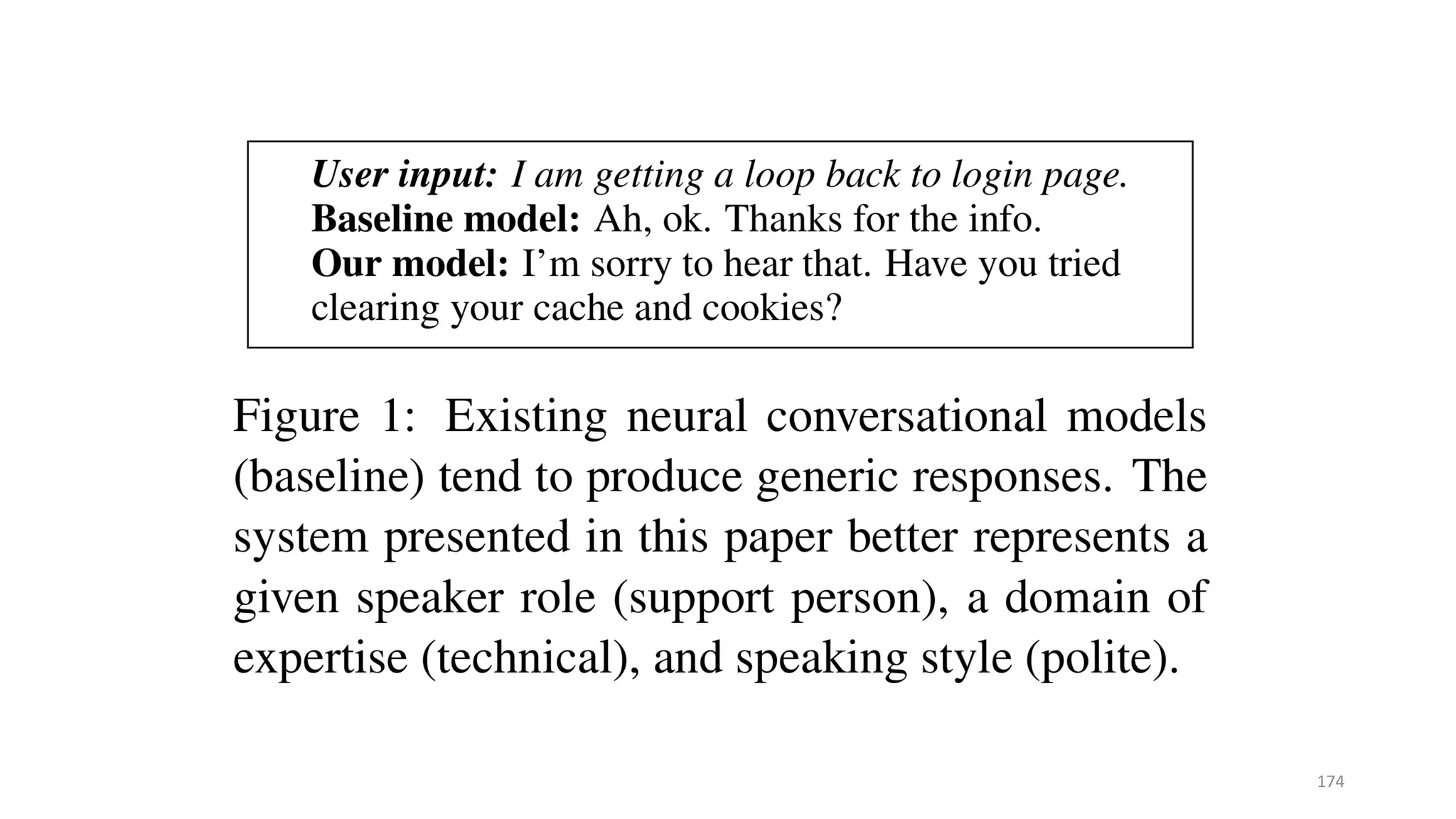
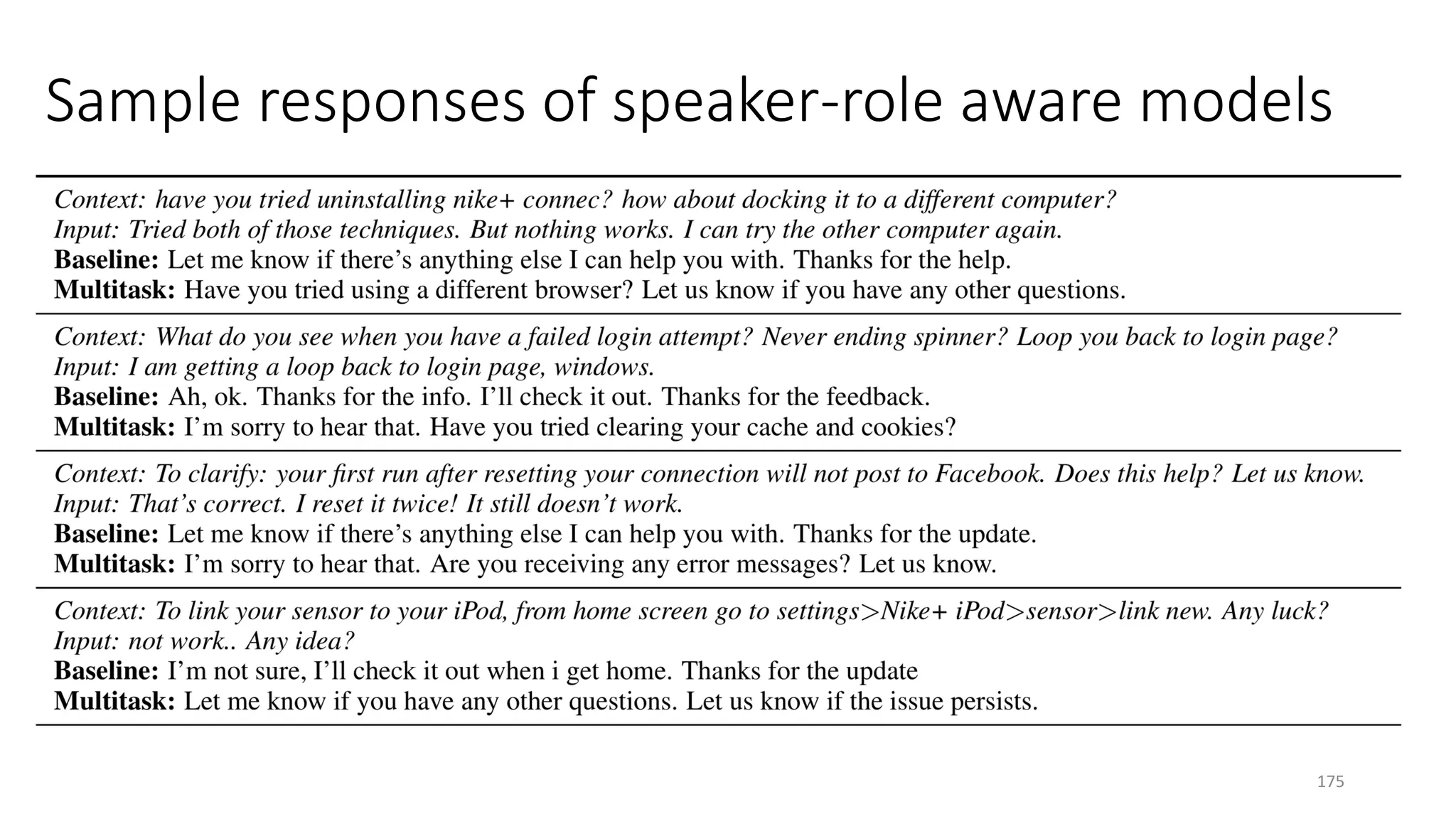
![Image-grounded dialogue
[Mostafazadeh+ 17]
Tweet: my poor baby moms saying it 's probably totaled so rip Bessie
NeuroCon: How did you manage to do that?
Tweet: as penitence I offer this
NeuroCon: can I have one of those?
Tweet: some of the damage done
NeuroCon: Is that at your house?
Neural model, trained on 250K Twitter convos:
-Turn 1: tweet + accompanying photo
-Turn 2: tweet is a question
Given data, other signals can be exploited in the same way:
program state, database info, geolocation, etc.
176](https://image.slidesharecdn.com/mitqptdarkanz785ioot-signature-233d5c007282b08e62cf0f4d0a5dd88f5ed85398db05a93a193537bbc0db97b6-poli-190707174549/75/BIng-NLP-Expert-Dl-summer-school-2017-jianfeng-gao-v2-176-2048.jpg)
![ht
A Knowledge-Grounded Neural Conversation Model
[Ghazvininejad+ 17]
177
Going to
Kusakabe tonight
CONVERSATION HISTORY
Try omakase, the best
in town
RESPONSE
Σ DECODER
DIALOG
ENCODER
...
WORLD
“FACTS”
A
Consistently the best omakase
...
CONTEXTUALLY-RELEVANT
“FACTS”
Amazing sushi tasting […]
They were out of kaisui […]
FACTS
ENCODER](https://image.slidesharecdn.com/mitqptdarkanz785ioot-signature-233d5c007282b08e62cf0f4d0a5dd88f5ed85398db05a93a193537bbc0db97b6-poli-190707174549/75/BIng-NLP-Expert-Dl-summer-school-2017-jianfeng-gao-v2-177-2048.jpg)
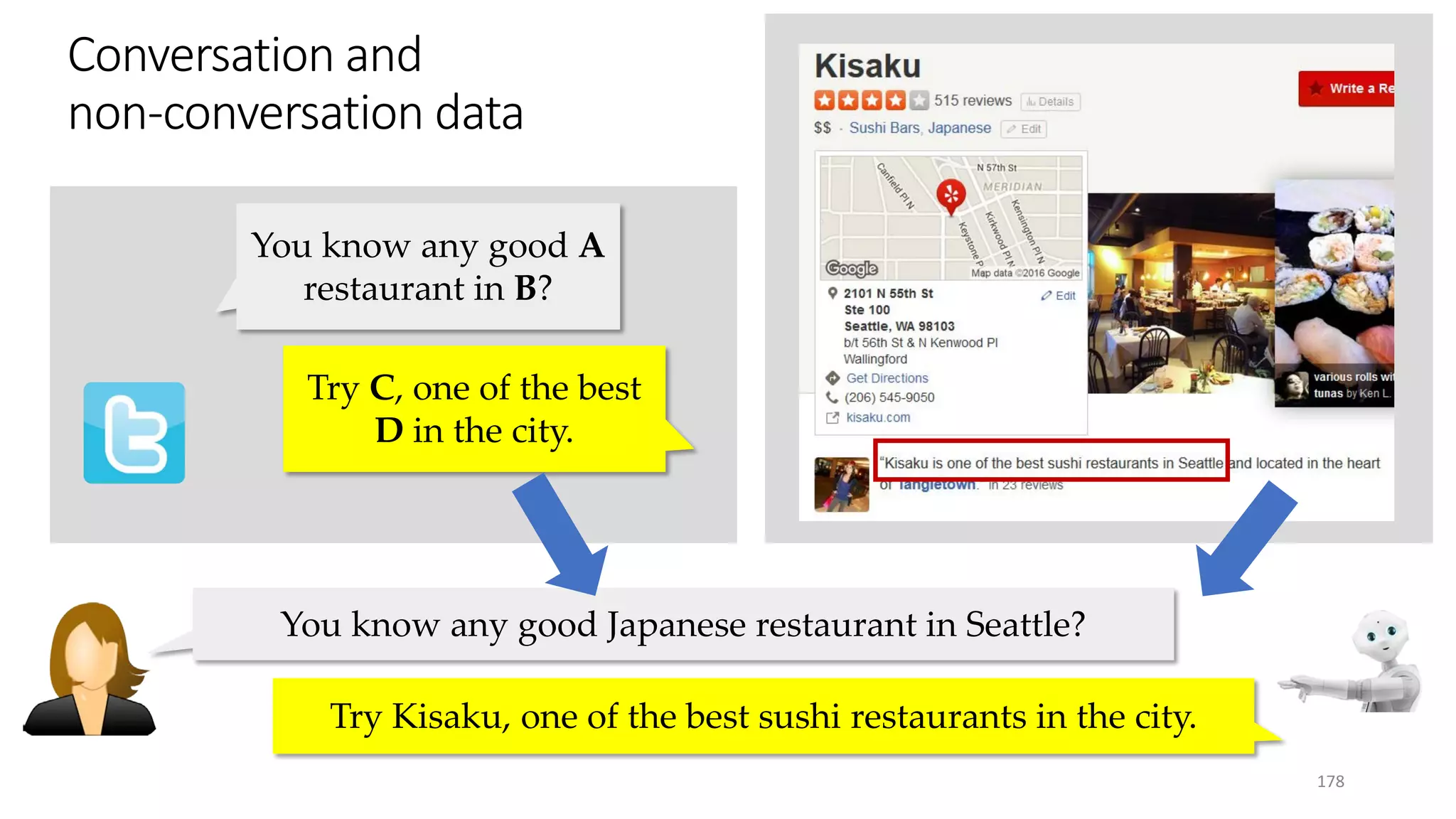
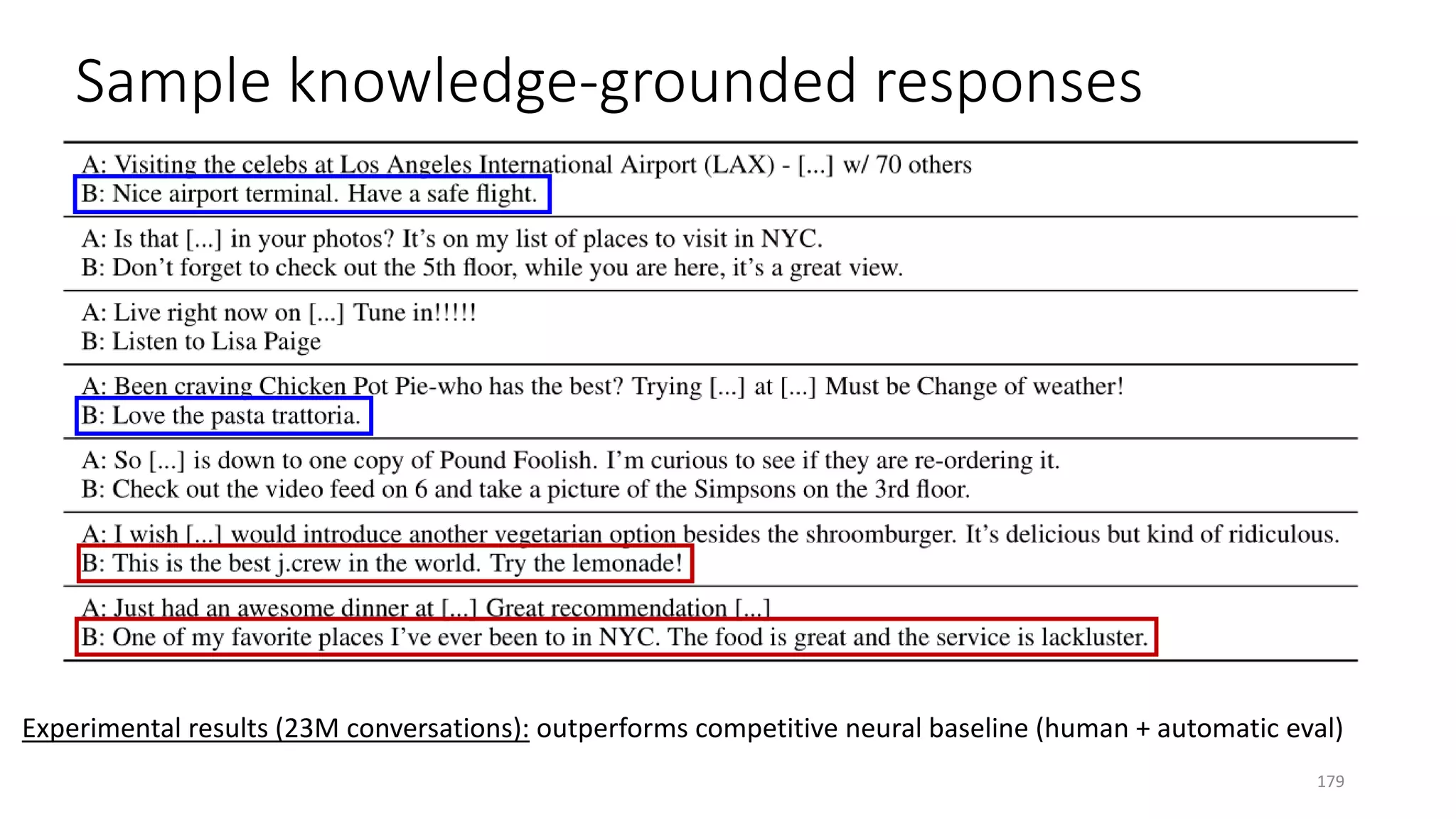
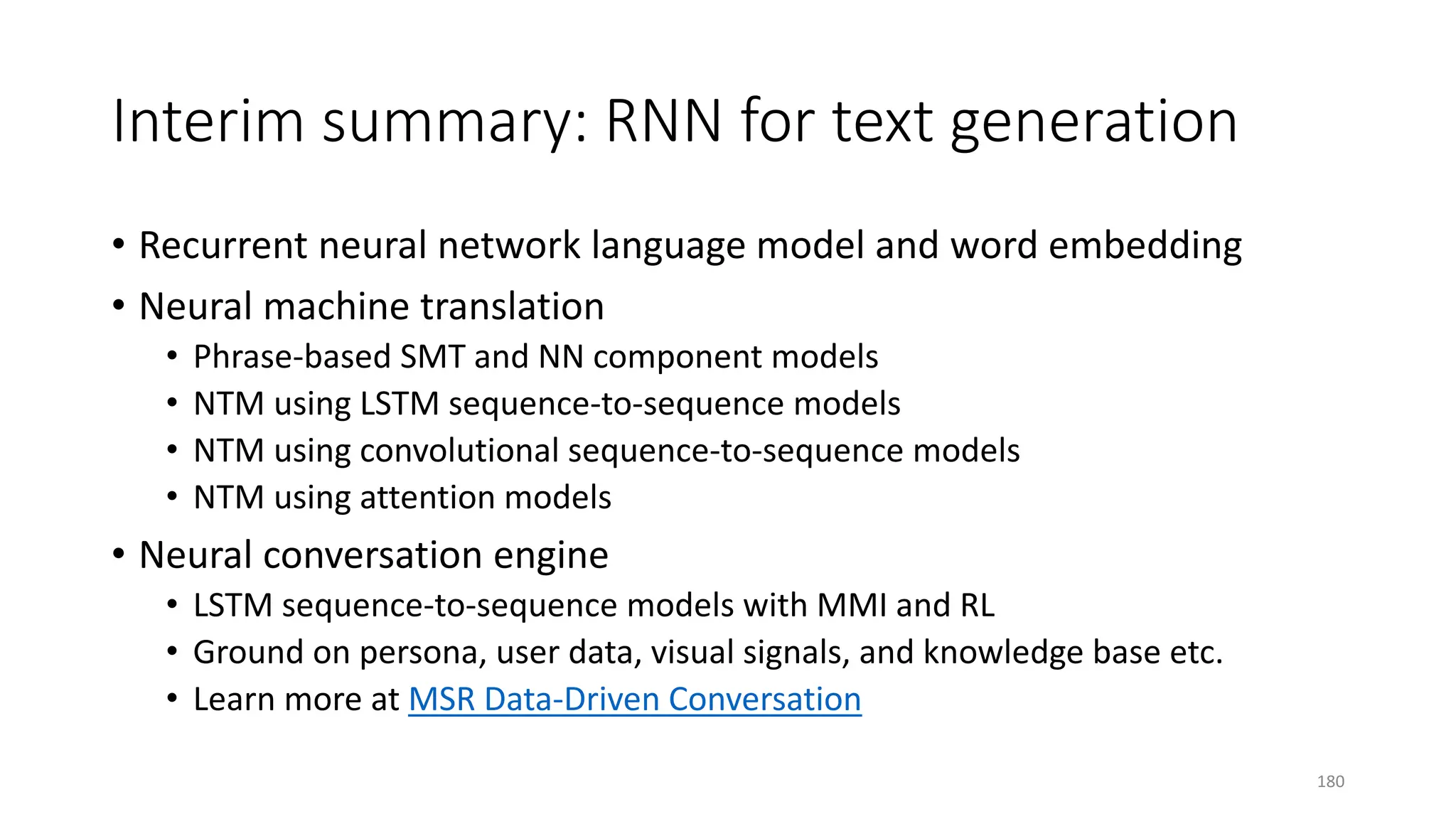
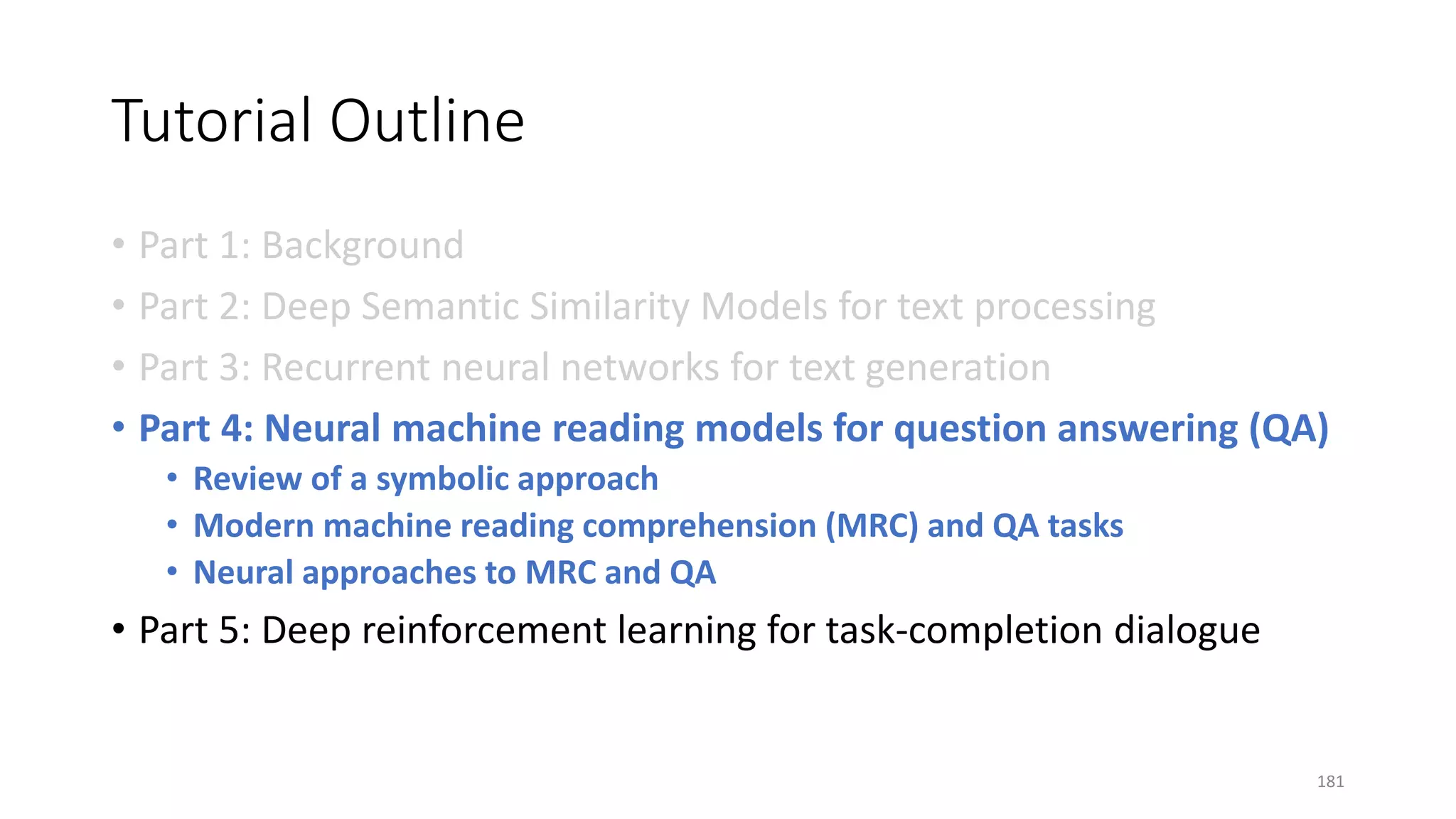
![Symbolic approaches to QA: production system
• Production rules
• condition—action pairs
• Represent (world) knowledge as a graph
• Working memory
• Contains a description of the current state of the world in a reasoning process
• Recognizer-act controller
• Update working memory by searching and firing a production rule
• A case study: MSR MindNet [Dolan+ 93; Richardson+ 98]
182](https://image.slidesharecdn.com/mitqptdarkanz785ioot-signature-233d5c007282b08e62cf0f4d0a5dd88f5ed85398db05a93a193537bbc0db97b6-poli-190707174549/75/BIng-NLP-Expert-Dl-summer-school-2017-jianfeng-gao-v2-182-2048.jpg)
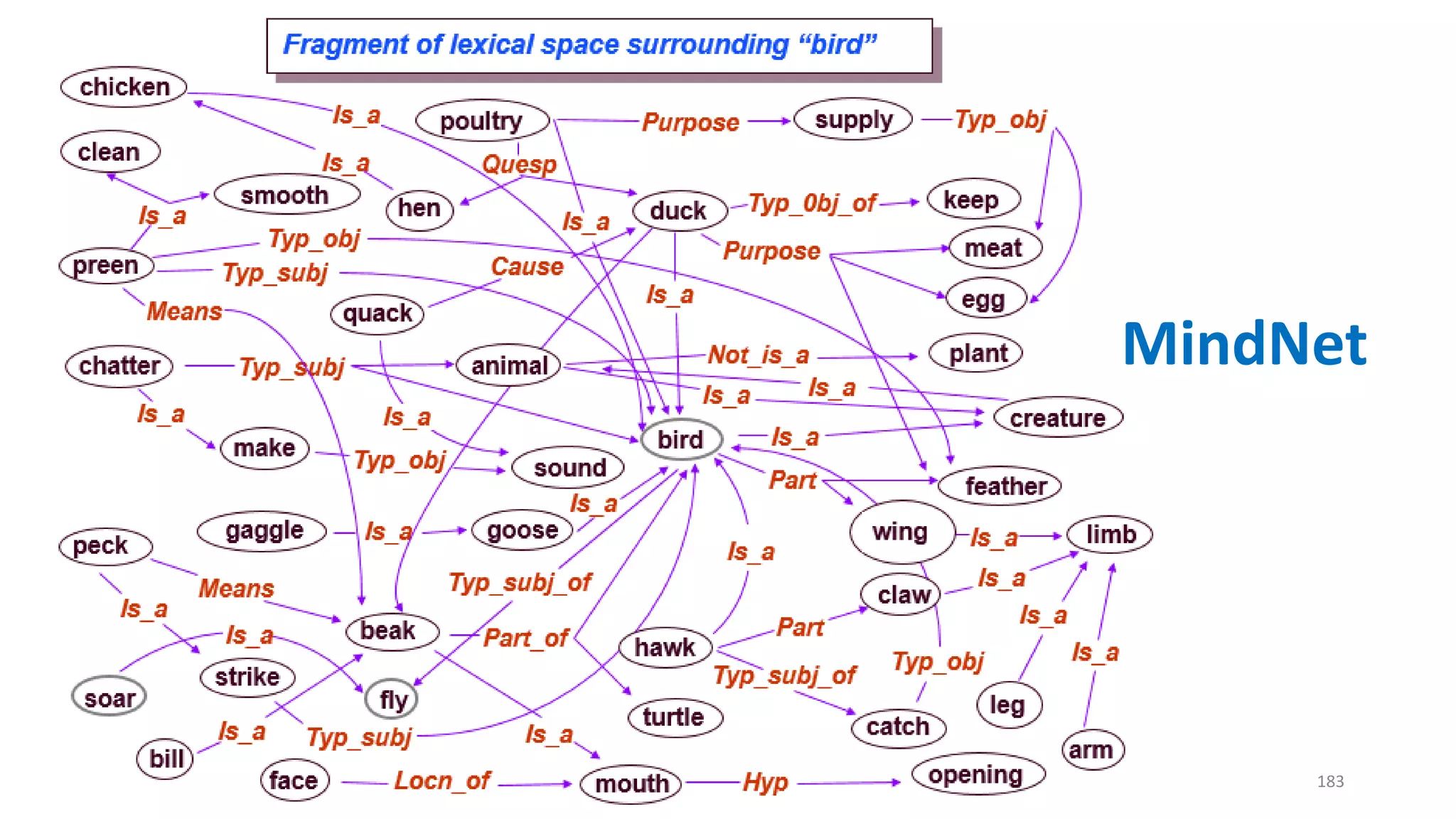
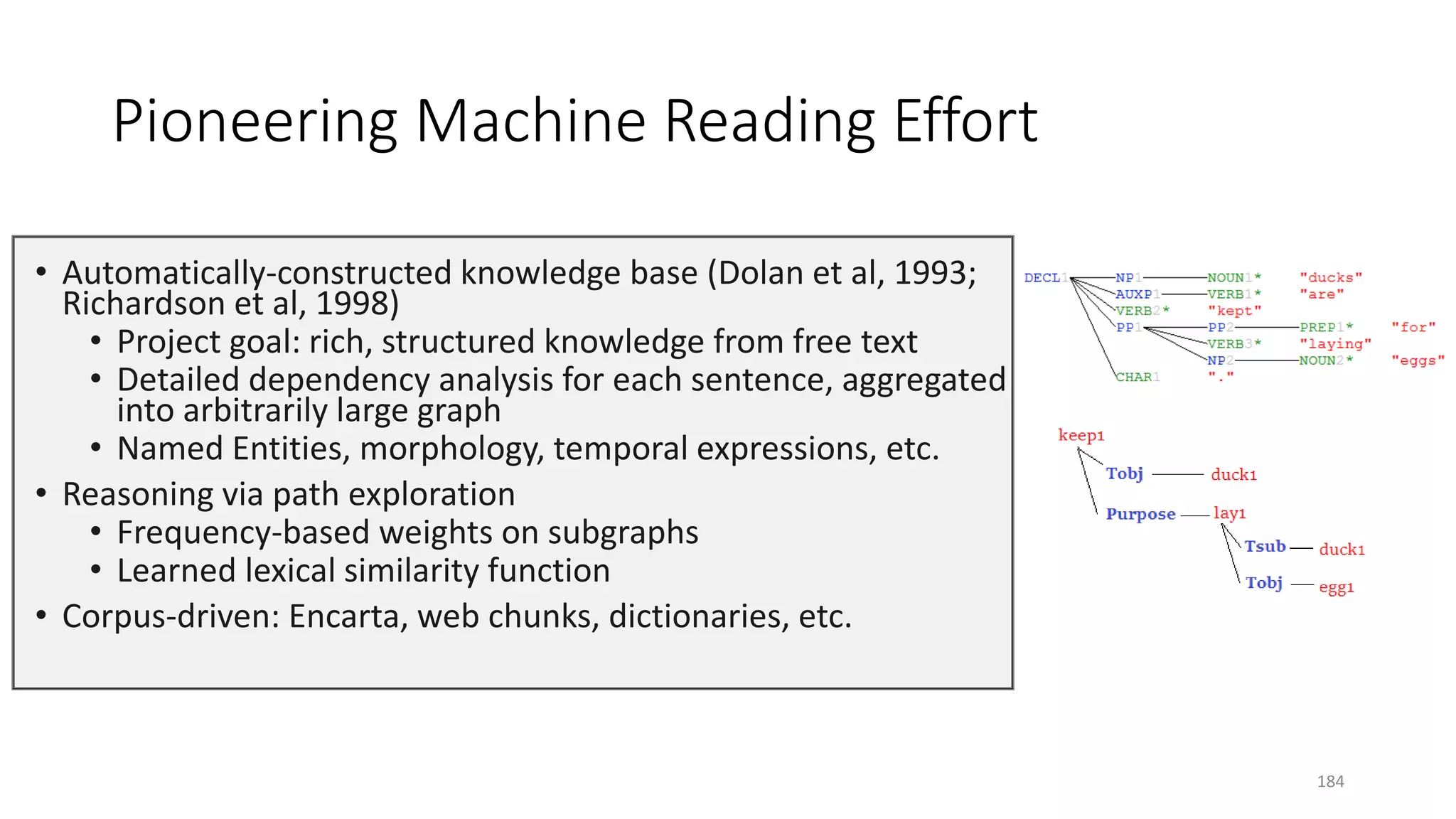
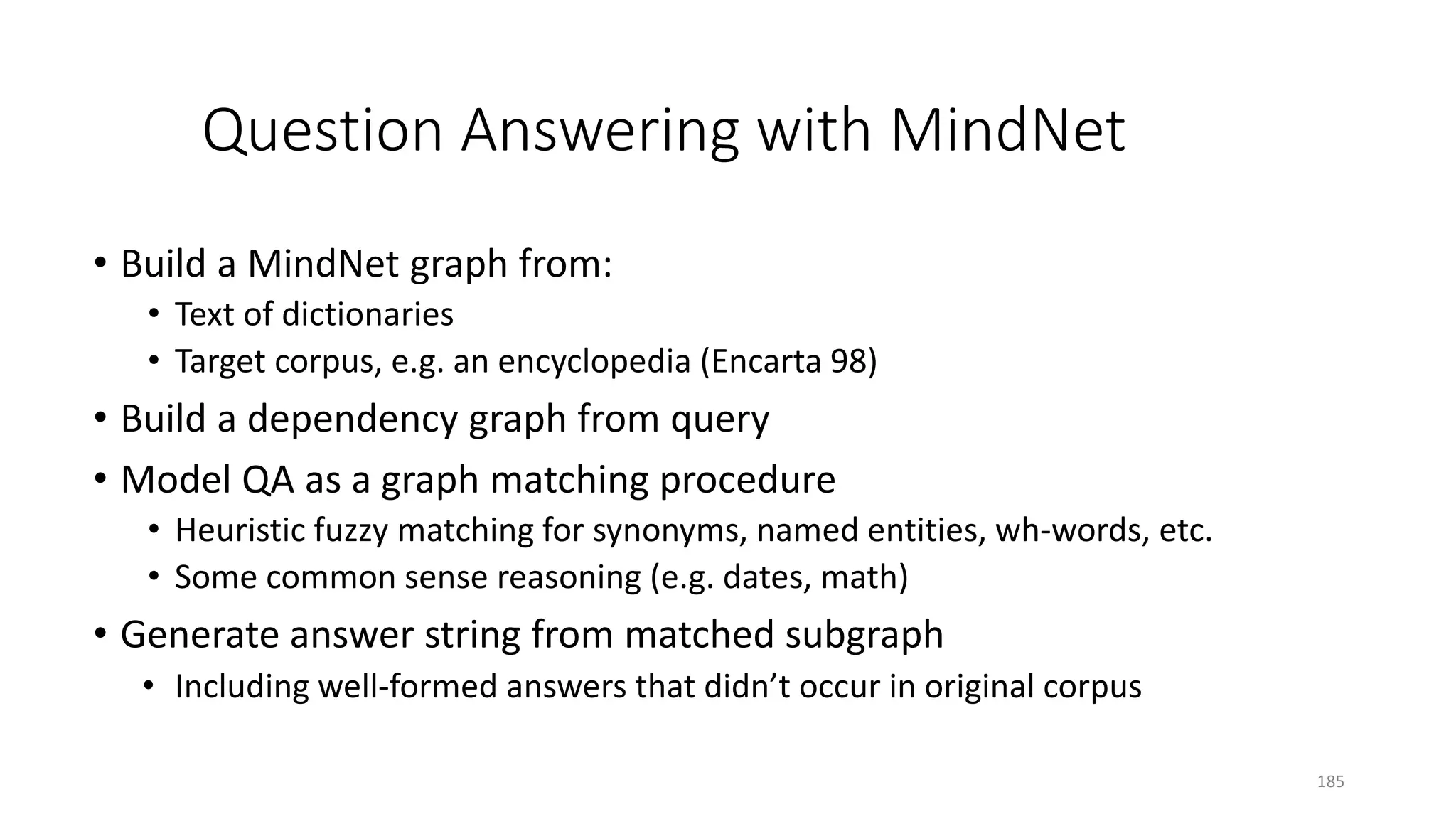
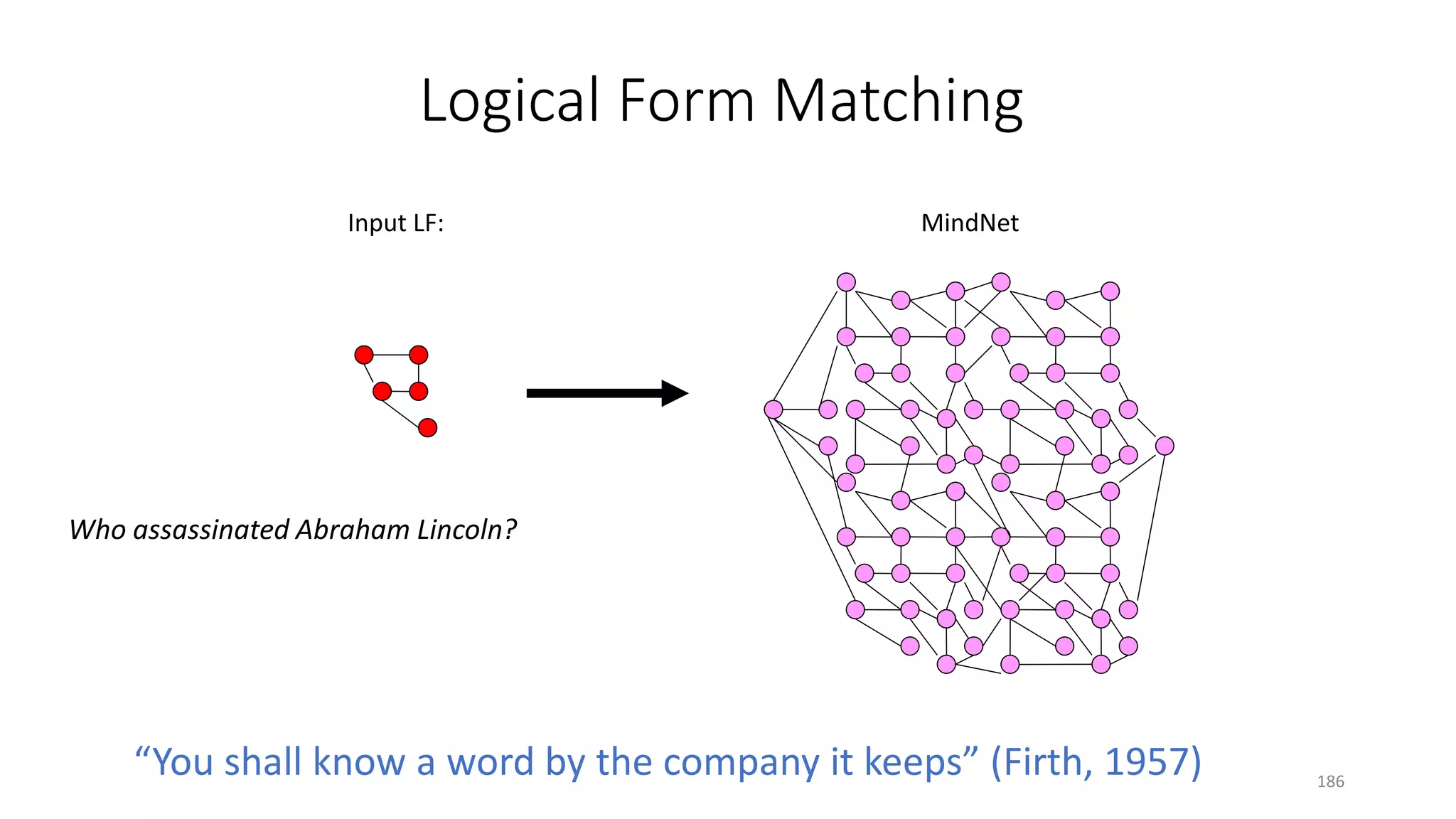
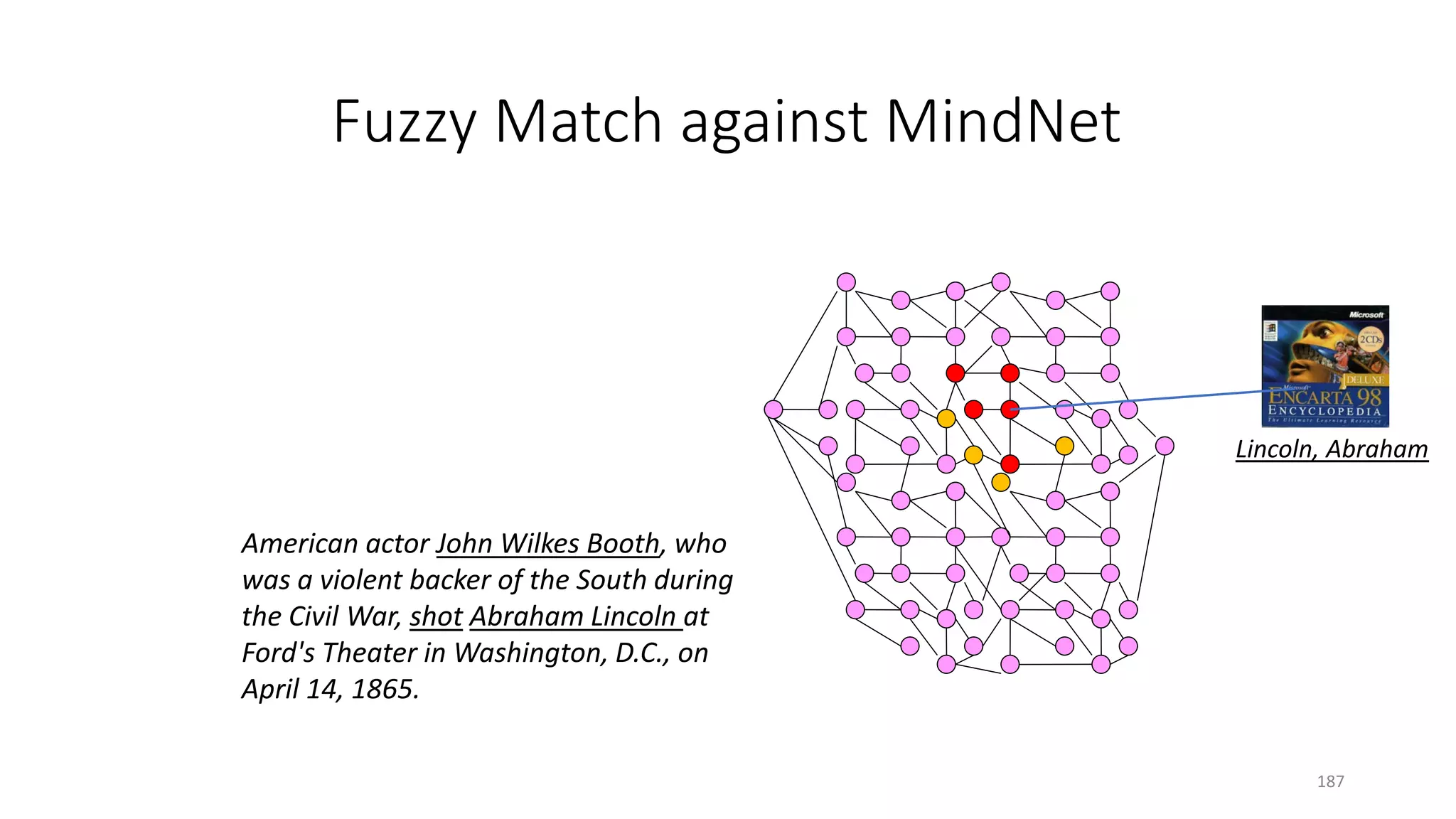
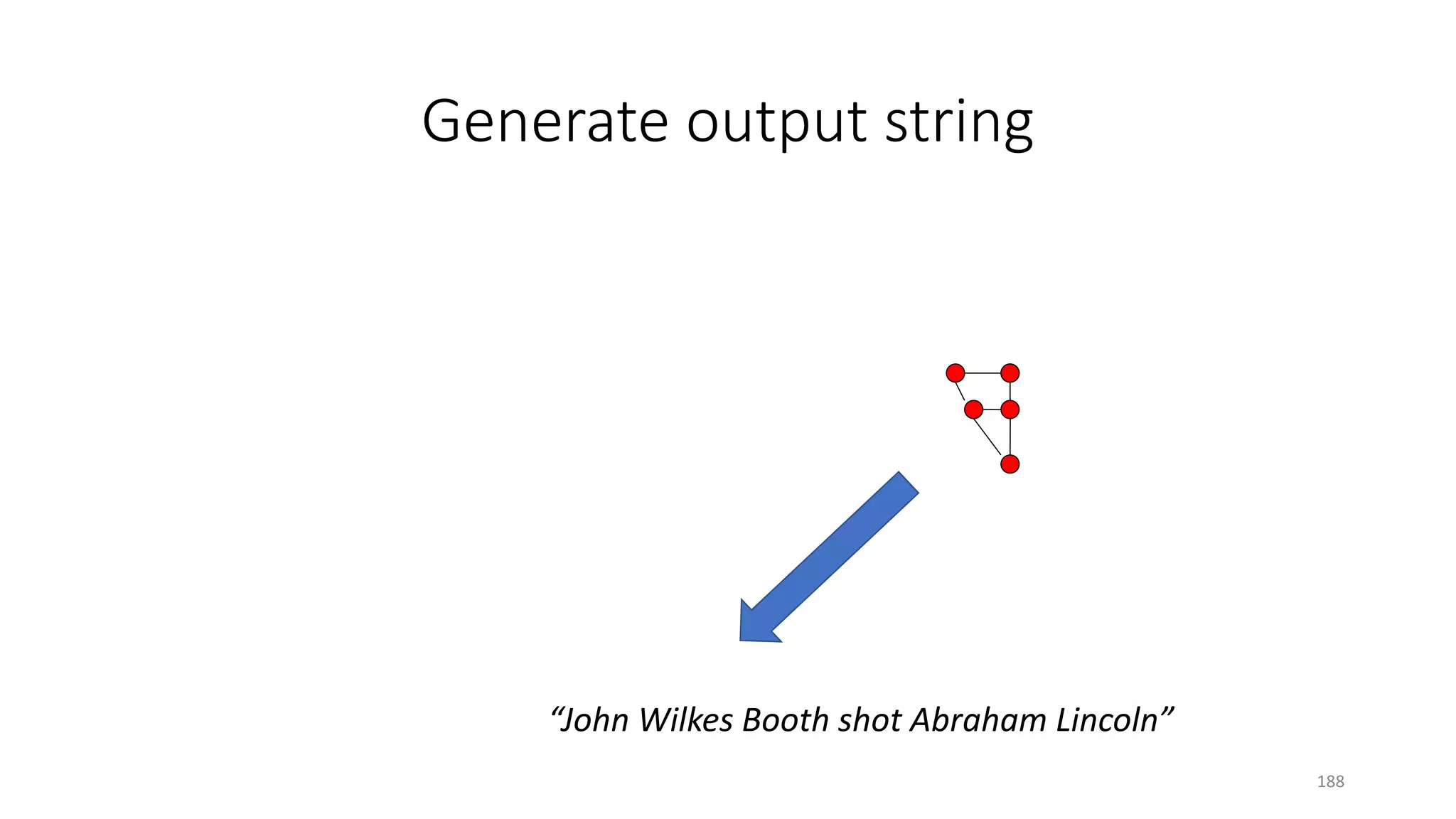

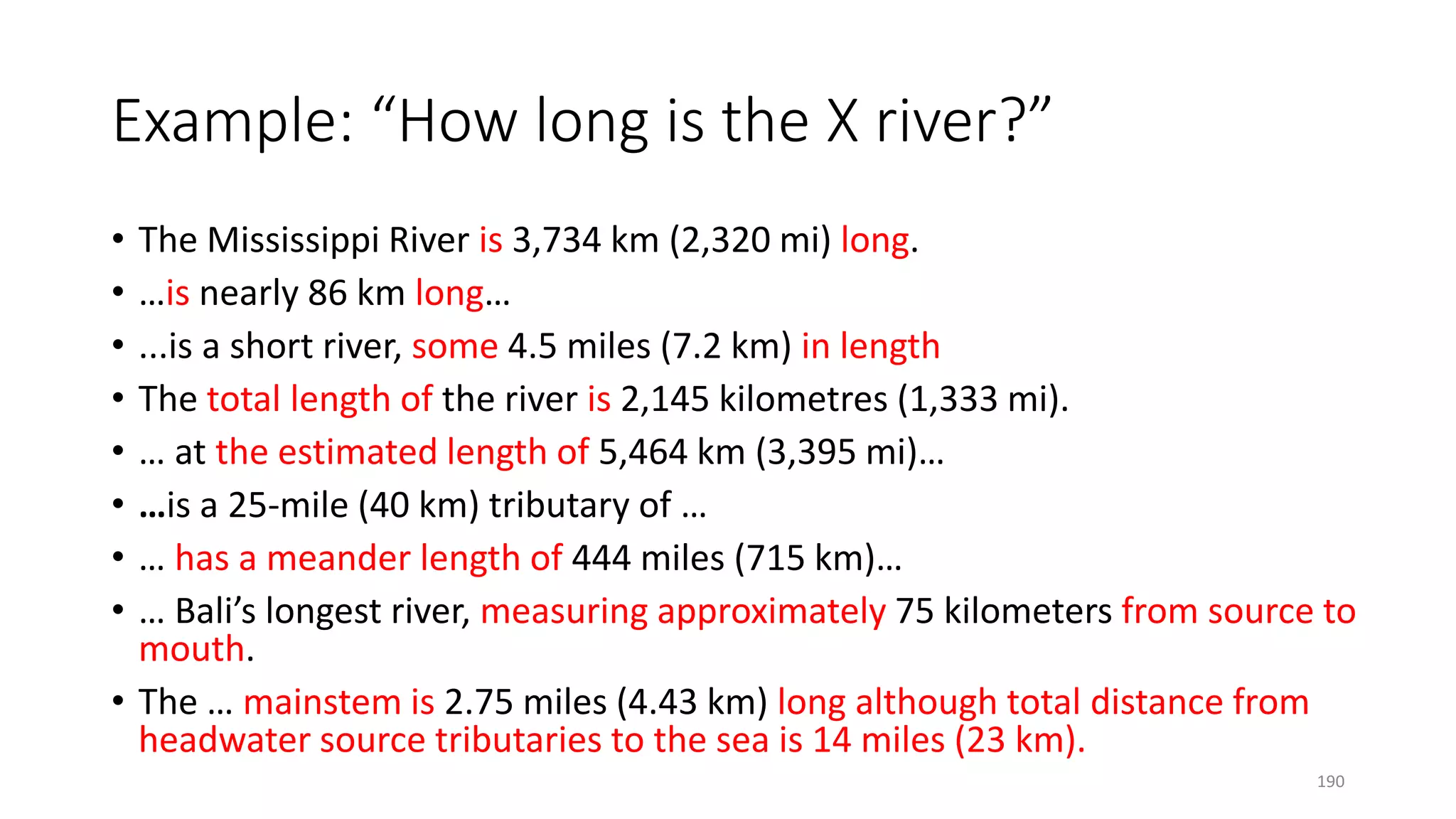
![• …is 314 km long
• …is nearly 86 km long…
• … is a 92-mile (148 km) long tributary of the…
• ...is a short river, some 4.5 miles (7.2 km) in length
• …flows nearly 20 miles (32 km) to the west
• The [river], which is 6,853 km (4,258 miles) long…
• It runs a course of about 105 kilometers
• The 1,450-mile-long (2,330 km) [river] drains…
• ...a 234-mile (377-kilometer) man-made waterway…
• … at the estimated length of 5,464 km (3,395 mi)…
• ... stretches for 2,639 miles (4,247 km).
• …is a 25-mile (40 km) tributary of …
• …starting in and flowing for nearly 160 kilometers through….
• …flows almost 70 stream miles.
• The river runs 184 kilometers before joining…
• … Bali’s longest river, measuring approximately 75 kilometers from
source to mouth.
• …is reported to be anywhere from 5,499 to 6,690 kilometres (3,417
to 4,157 mi). Often it is said to be "about" 6,650 kilometres
(4,130 mi) long.
• ...reaches a length of approximately 25 kilometres
• The length of the Ouse alone is about 52 miles (84 km).
• Measuring a length of 60 kilometers, the [river] flows through
• It has a total length of 925 km (575 mi).
• The total length of the river is 2,145 kilometres (1,333 mi).
• Its length is 209 km…
• …is about 1,180 miles (1,900 km) in length.
• ...the river flows for more than 1,200 km (750 mi)
• …the river proper flows only for 113 km…
• …flows slowly for 900 kilometres (560 mi)…
• … has a meander length of 444 miles (715 km)…
• …is a 350-kilometre (220 mi) long river in …
• it …meanders slowly southwards for 2,320 miles (3,730 km) to …
• The river's main stem is about 71 miles (114 km) long. Its length to
its most distant headwater tributary is about 220 miles (350 km).
• After approximately 30 kilometres (19 mi) of its 78-kilometre
(48 mi) course, it ….
• …is the longest river in the United Kingdom, at about 220 miles
(354 km).
• … is the second-longest river in Central and Western Europe (after
the Danube), at about 1,230 km (760 mi)…
• The … mainstem is 2.75 miles (4.43 km) long although total distance
from headwater source tributaries to the sea is 14 miles (23 km).
• At 320 kilometres (200 mi) (with some estimates ranging up to 596
kilometres (370 mi))...
191](https://image.slidesharecdn.com/mitqptdarkanz785ioot-signature-233d5c007282b08e62cf0f4d0a5dd88f5ed85398db05a93a193537bbc0db97b6-poli-190707174549/75/BIng-NLP-Expert-Dl-summer-school-2017-jianfeng-gao-v2-191-2048.jpg)

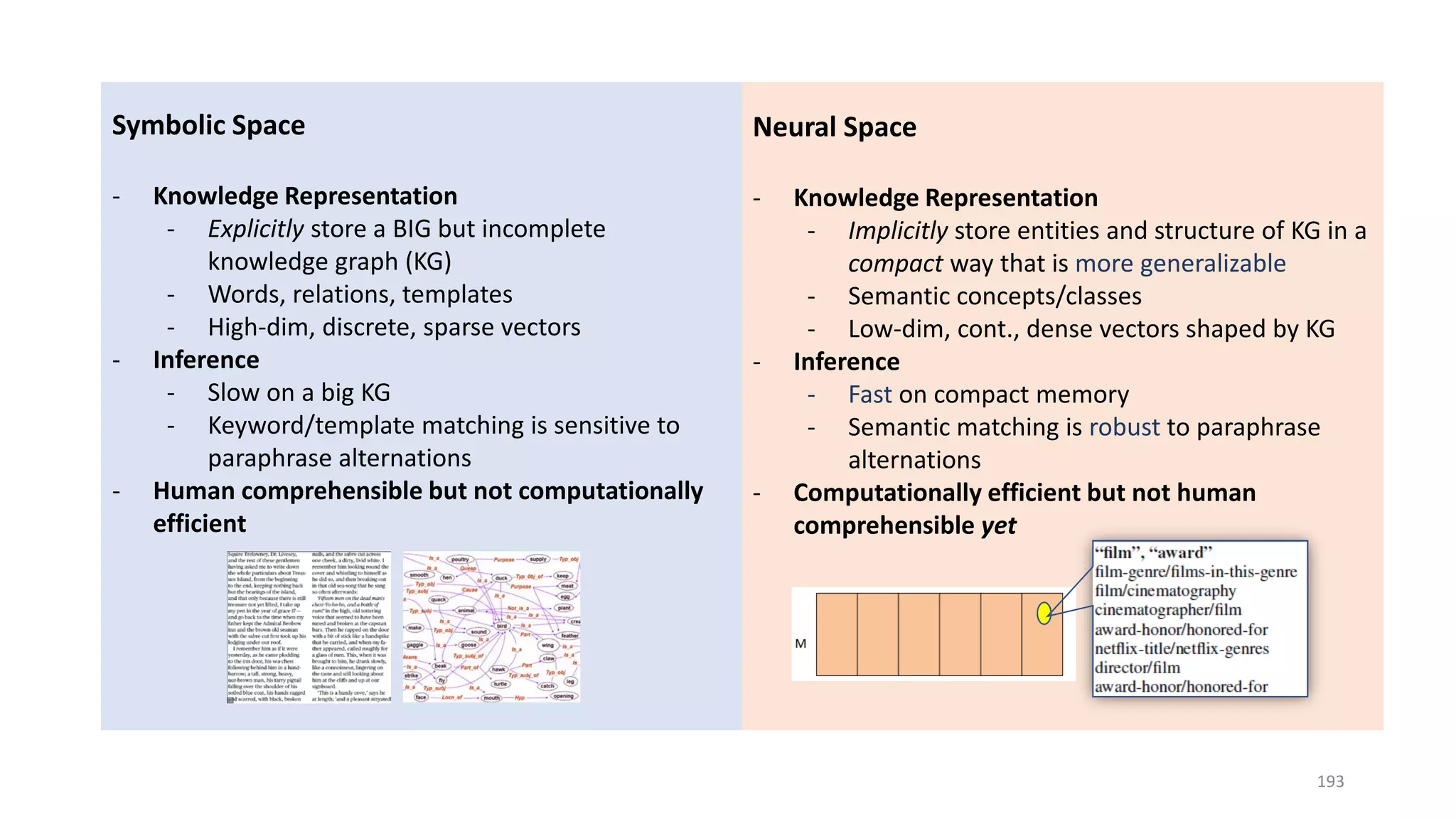
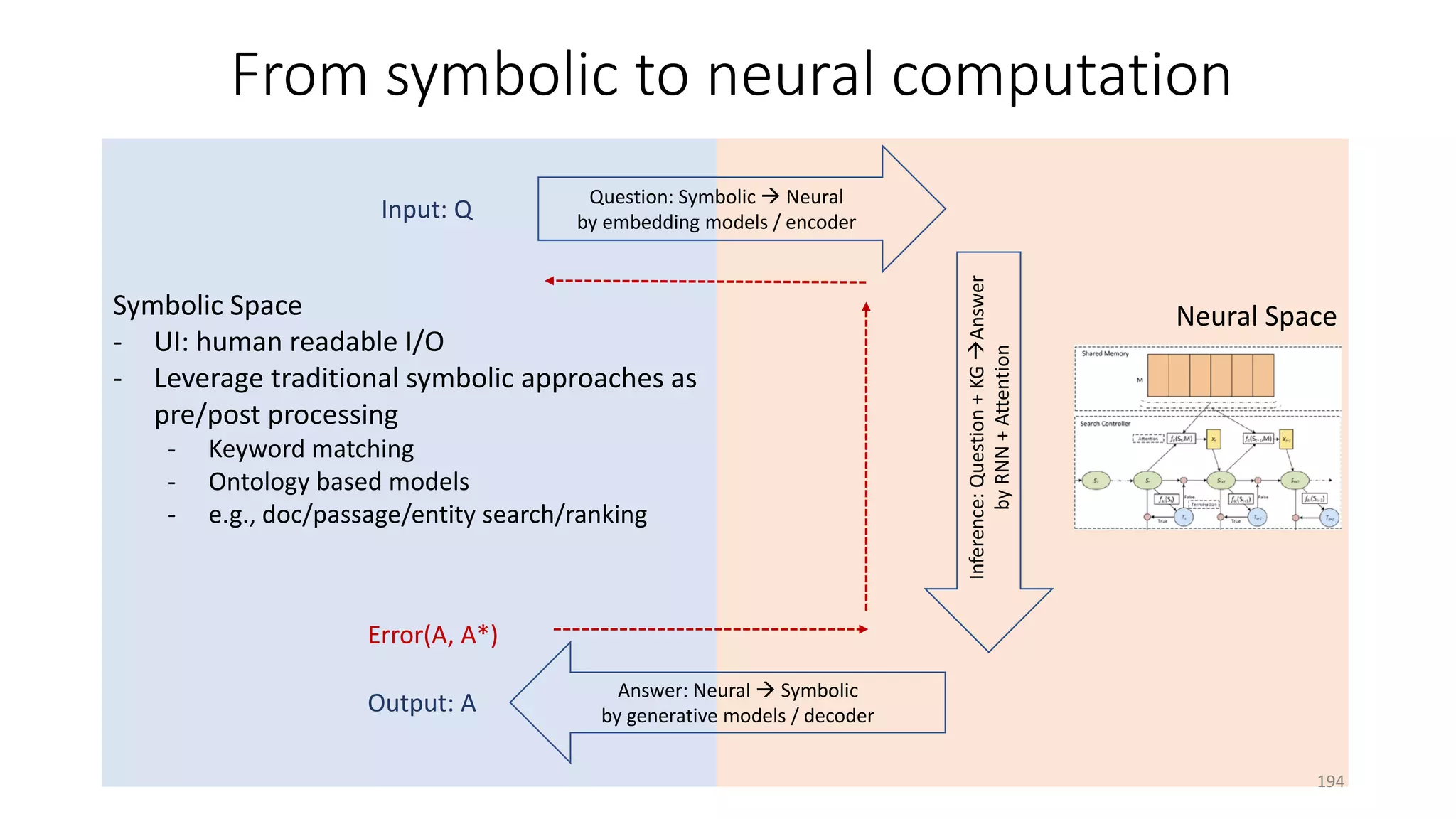
![Case study: ReasoNet with Shared Memory
• Production Rules Shared memory encodes
task-specific knowledge
• Working memory Hidden state 𝑺𝑺𝒕𝒕 Contains
a description of the current state of the world
in a reasoning process
• Recognizer-act controller Search controller
performs multi-step inference to update 𝑆𝑆𝑡𝑡 of
a question using knowledge in shared memory
• Shared memory and search controller are
jointly learned via SL+RL
• Input/output modules are task-specific
[Shen+ 16a]
195](https://image.slidesharecdn.com/mitqptdarkanz785ioot-signature-233d5c007282b08e62cf0f4d0a5dd88f5ed85398db05a93a193537bbc0db97b6-poli-190707174549/75/BIng-NLP-Expert-Dl-summer-school-2017-jianfeng-gao-v2-195-2048.jpg)

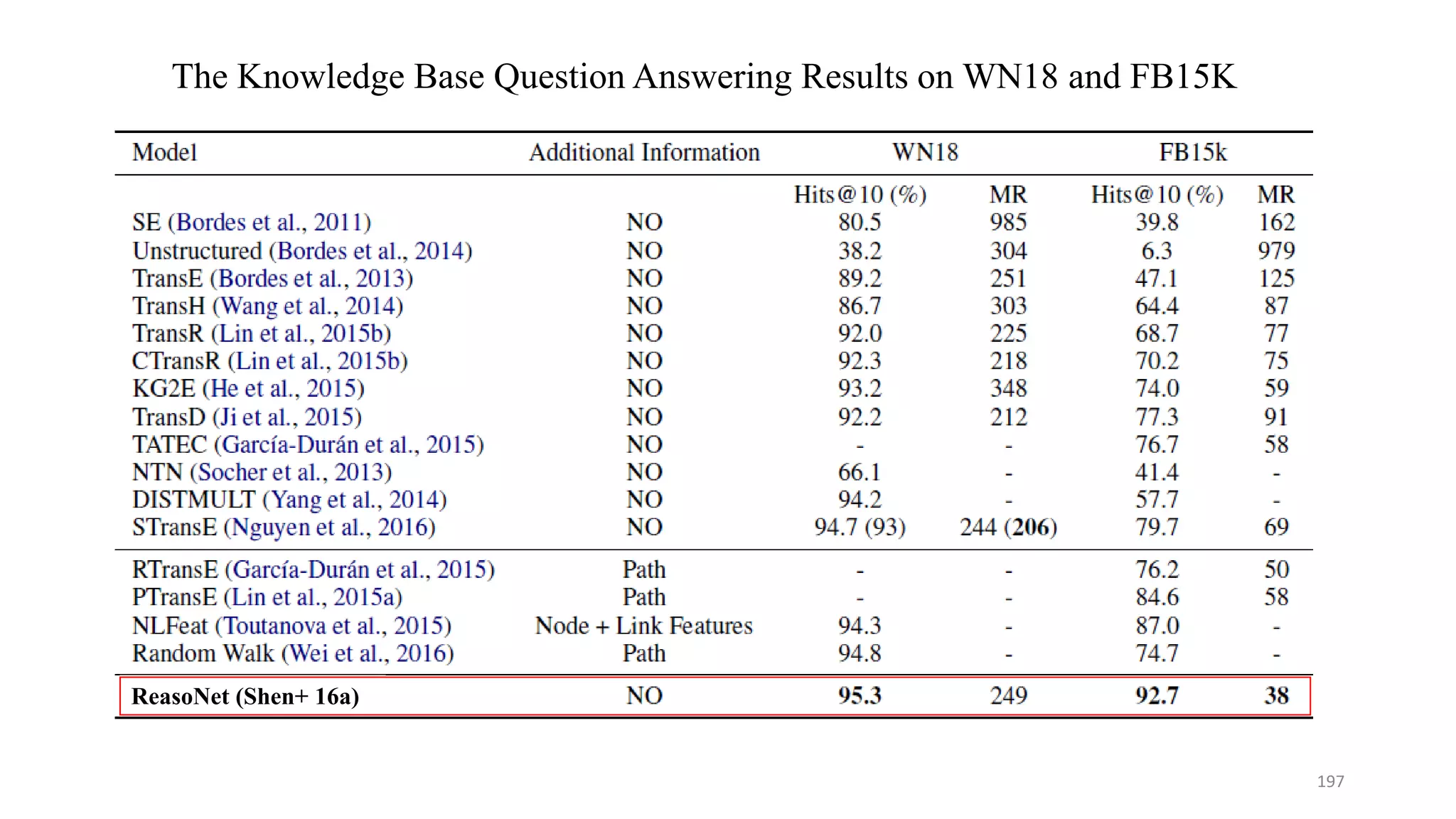
![Text QA and MRC Datasets
Dataset Provider Query Source Answer # Queries # Docs
MC Test
[Richardson+ 13]
Microsoft Crowdsourced Multiple
Choice
2640 660
WikiQA
[Yang+ 15]
Microsoft User Logs Sentence
Selection
3047 29K
sentences
CNN/DailyMail
[Hermann+ 15]
DeepMind Cloze Fill in entity 1.4M 93K CNN,
220K DM
Children’s Book
[Hill+ 15]
Facebook Cloze Fill in the
word
688K 688K
contexts
SQuAD
[Rajpurkat+ 16]
Stanford Crowdsourced Span 100K 536
News QA
[Trischler+ 16]
Maluuba Crowdsourced Span 120K 12K
MS MARCO
[Nguyen+ 16]
Microsoft User Logs Human
Synthesized
100k 1M passages,
200K+ docs
198](https://image.slidesharecdn.com/mitqptdarkanz785ioot-signature-233d5c007282b08e62cf0f4d0a5dd88f5ed85398db05a93a193537bbc0db97b6-poli-190707174549/75/BIng-NLP-Expert-Dl-summer-school-2017-jianfeng-gao-v2-198-2048.jpg)
![Text QA and MRC Datasets
Dataset Provider Query Source Answer # Queries # Docs
MC Test
[Richardson+ 13]
Microsoft Crowdsourced Multiple
Choice
2640 660
WikiQA
[Yang+ 15]
Microsoft User Logs Sentence
Selection
3047 29K
sentences
CNN/DailyMail
[Hermann+ 15]
DeepMind Cloze Fill in entity 1.4M 93K CNN,
220K DM
Children’s Book
[Hill+ 15]
Facebook Cloze Fill in the
word
688K 688K
contexts
SQuAD
[Rajpurkat+ 16]
Stanford Crowdsourced Span 100K 536
News QA
[Trischler+ 16]
Maluuba Crowdsourced Span 120K 12K
MS MARCO
[Nguyen+ 16]
Microsoft User Logs Human
Synthesized
100k 1M passages,
200K+ docs
199](https://image.slidesharecdn.com/mitqptdarkanz785ioot-signature-233d5c007282b08e62cf0f4d0a5dd88f5ed85398db05a93a193537bbc0db97b6-poli-190707174549/75/BIng-NLP-Expert-Dl-summer-school-2017-jianfeng-gao-v2-199-2048.jpg)
![Text QA and MRC Datasets
Dataset Provider Query Source Answer # Queries # Docs
MC Test
[Richardson+ 13]
Microsoft Crowdsourced Multiple
Choice
2640 660
WikiQA
[Yang+ 15]
Microsoft User Logs Sentence
Selection
3047 29K
sentences
CNN/DailyMail
[Hermann+ 15]
DeepMind Cloze Fill in entity 1.4M 93K CNN,
220K DM
Children’s Book
[Hill+ 15]
Facebook Cloze Fill in the
word
688K 688K
contexts
SQuAD
[Rajpurkat+ 16]
Stanford Crowdsourced Span 100K 536
News QA
[Trischler+ 16]
Maluuba Crowdsourced Span 120K 12K
MS MARCO
[Nguyen+ 16]
Microsoft User Logs Human
Synthesized
100k 1M passages,
200K+ docs
200](https://image.slidesharecdn.com/mitqptdarkanz785ioot-signature-233d5c007282b08e62cf0f4d0a5dd88f5ed85398db05a93a193537bbc0db97b6-poli-190707174549/75/BIng-NLP-Expert-Dl-summer-school-2017-jianfeng-gao-v2-200-2048.jpg)
![Text QA and MRC Datasets
Dataset Provider Query Source Answer # Queries # Docs
MC Test
[Richardson+ 13]
Microsoft Crowdsourced Multiple
Choice
2640 660
WikiQA
[Yang+ 15]
Microsoft User Logs Sentence
Selection
3047 29K
sentences
CNN/DailyMail
[Hermann+ 15]
DeepMind Cloze Fill in entity 1.4M 93K CNN,
220K DM
Children’s Book
[Hill+ 15]
Facebook Cloze Fill in the
word
688K 688K
contexts
SQuAD
[Rajpurkat+ 16]
Stanford Crowdsourced Span 100K 536
News QA
[Trischler+ 16]
Maluuba Crowdsourced Span 120K 12K
MS MARCO
[Nguyen+ 16]
Microsoft User Logs Human
Synthesized
100k 1M passages,
200K+ docs
201](https://image.slidesharecdn.com/mitqptdarkanz785ioot-signature-233d5c007282b08e62cf0f4d0a5dd88f5ed85398db05a93a193537bbc0db97b6-poli-190707174549/75/BIng-NLP-Expert-Dl-summer-school-2017-jianfeng-gao-v2-201-2048.jpg)
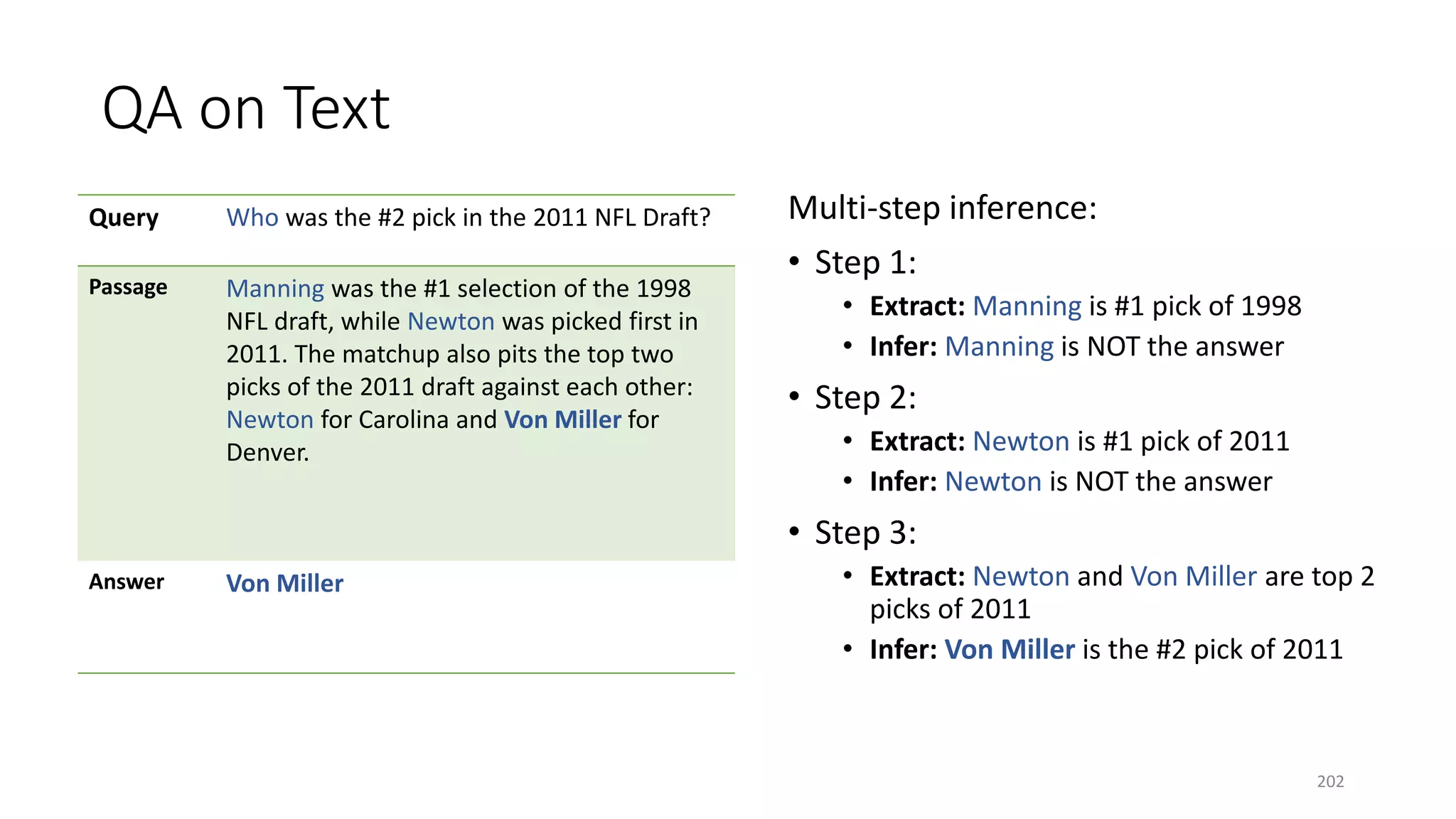
![The Text QA Results using MRC models
Models CNN Daily Mail SQuAD (EM/F1) MS MARCO
G/DeepMind: Attentive Reader [Hermann+ 15] 63.0 69.0
IBM: Attention Sum Reader [Kadlec+ 16] 69.5 73.9
Stanford AR [Chen+ 16] 72.4 75.8
(MS) Maluuba: Iterative AR [Sordoni+ 16] 73.3 -
(MS) Maluuba: EpiReader [Trischler+ 16] 74.0 -
CMU: GA Reader [Dhingra+ 16] 73.8 75.7
MSR: ReasoNet [Shen+ 16] (Sep 17 2016) 74.7 76.6
Google/UW: RaSoR [Lee+ 16] (Nov 4 2016) - - 69.6 / 77.7
AI2/UW: BiDAF [Seo+ 16] (Nov 5 2016) 77.1 78.3 73.7 /81.5
MSR: ReasoNet [Shen+ 16] (Mar 2017) - - 75.0 / 82.6
MSRA: R-net [Wang+ 17] (Jun 2017) - - 77.7 / 84.7
https://rajpurkar.github.io/SQuAD-explorer/
203](https://image.slidesharecdn.com/mitqptdarkanz785ioot-signature-233d5c007282b08e62cf0f4d0a5dd88f5ed85398db05a93a193537bbc0db97b6-poli-190707174549/75/BIng-NLP-Expert-Dl-summer-school-2017-jianfeng-gao-v2-203-2048.jpg)
![Model Attention (Embedding) Inference
Maluuba: EpiReader [Trischler+ 16] Attention sum reader Single-step
Maluuba: Iterative AR [Sordoni+ 16] Attention sum reader Multi-step, step size is predefined
BiDAF [Seo+ 16] Co-attention Single-step
MSR: ReasoNet [Shen+ 16b] Co-attention Dynamic multi-step (step size is determined
based on complexity of queries on the fly)
MSRA: R-net [Wang+ 17] Gated attention + self matching Single-step
S1 St St+1 St+2
QueryQuery
Xt
Tt Tt+1
ftg(θtg) ftg(θtg)False
True
fa(θa)
True
at
fa(θa)
at+1
fatt(θx) Xt+1fatt(θx)
False
Passage
Termination
Answer
Attention
Controller
Attention(embedding)
Inference
ReasoNet
204](https://image.slidesharecdn.com/mitqptdarkanz785ioot-signature-233d5c007282b08e62cf0f4d0a5dd88f5ed85398db05a93a193537bbc0db97b6-poli-190707174549/75/BIng-NLP-Expert-Dl-summer-school-2017-jianfeng-gao-v2-204-2048.jpg)
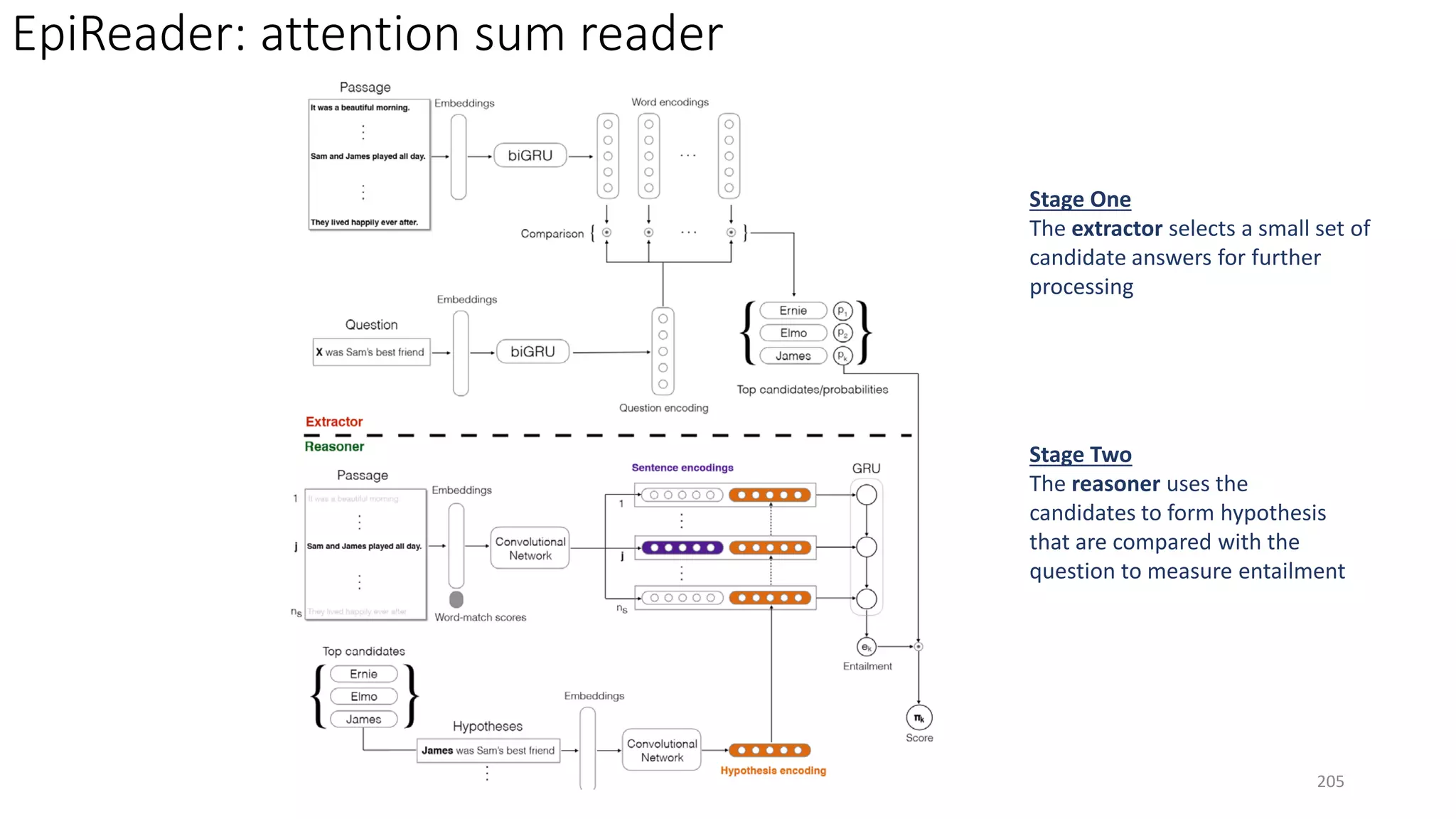
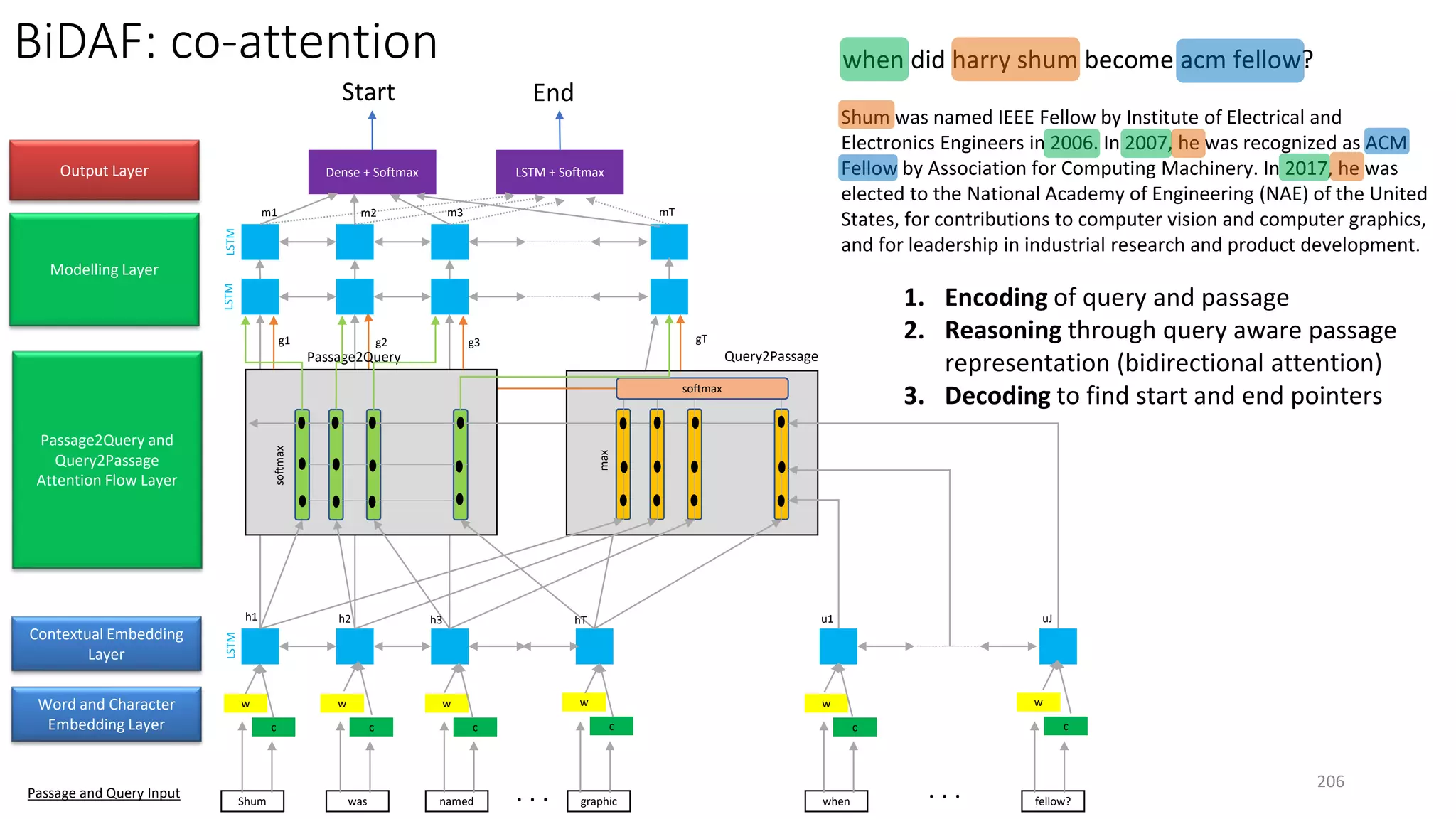
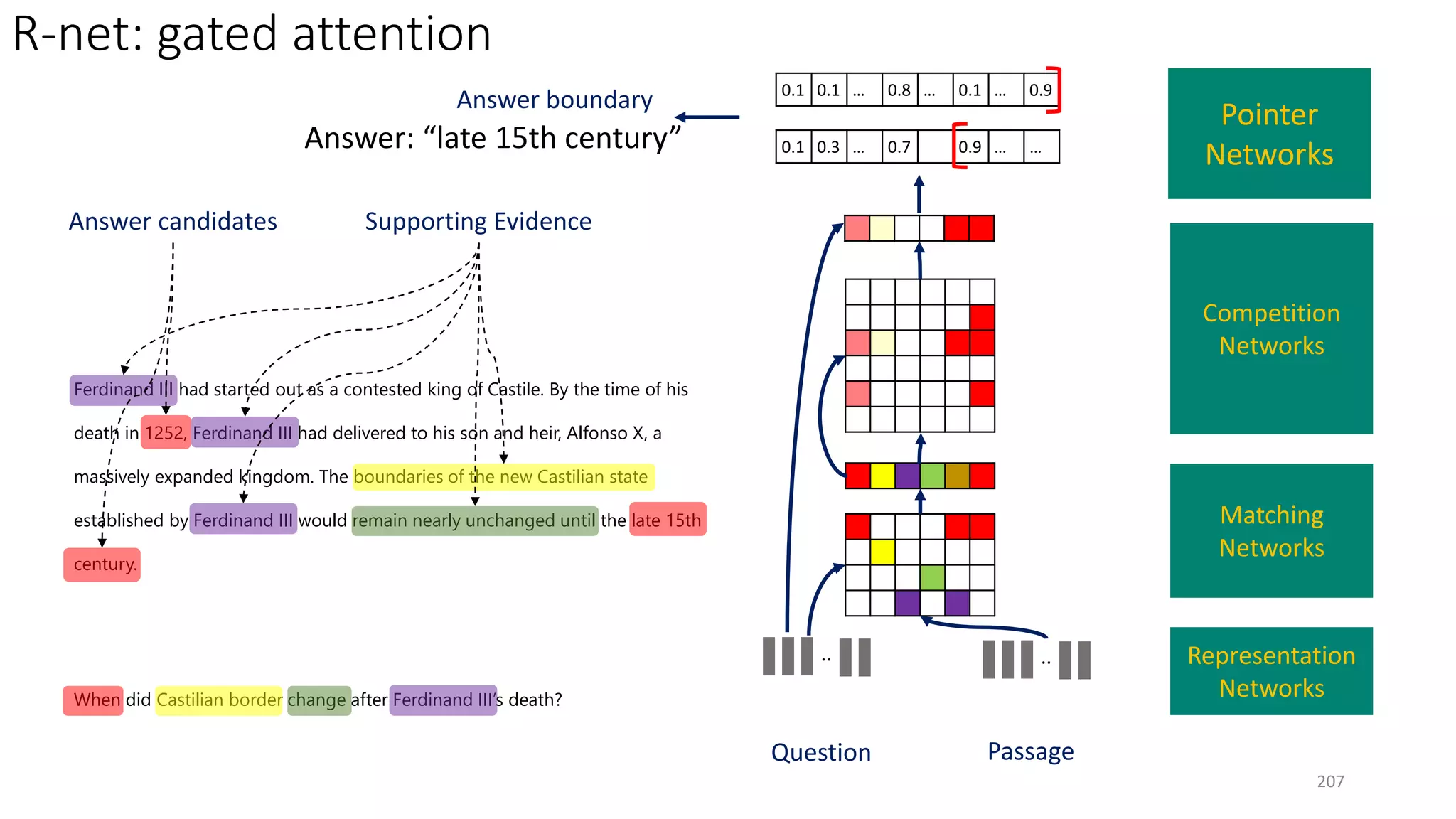
![ReasoNet with Shared Memory
• Shared memory encodes task-specific
knowledge (e.g., passage or KB)
• Search controller performs multi-step
inference to generate answer of a
question using knowledge in shared
memory
• Shared memory and search controller
are jointly learned via SL+RL
• Input/output modules are task-specific
[Shen+ 16a]
208](https://image.slidesharecdn.com/mitqptdarkanz785ioot-signature-233d5c007282b08e62cf0f4d0a5dd88f5ed85398db05a93a193537bbc0db97b6-poli-190707174549/75/BIng-NLP-Expert-Dl-summer-school-2017-jianfeng-gao-v2-208-2048.jpg)
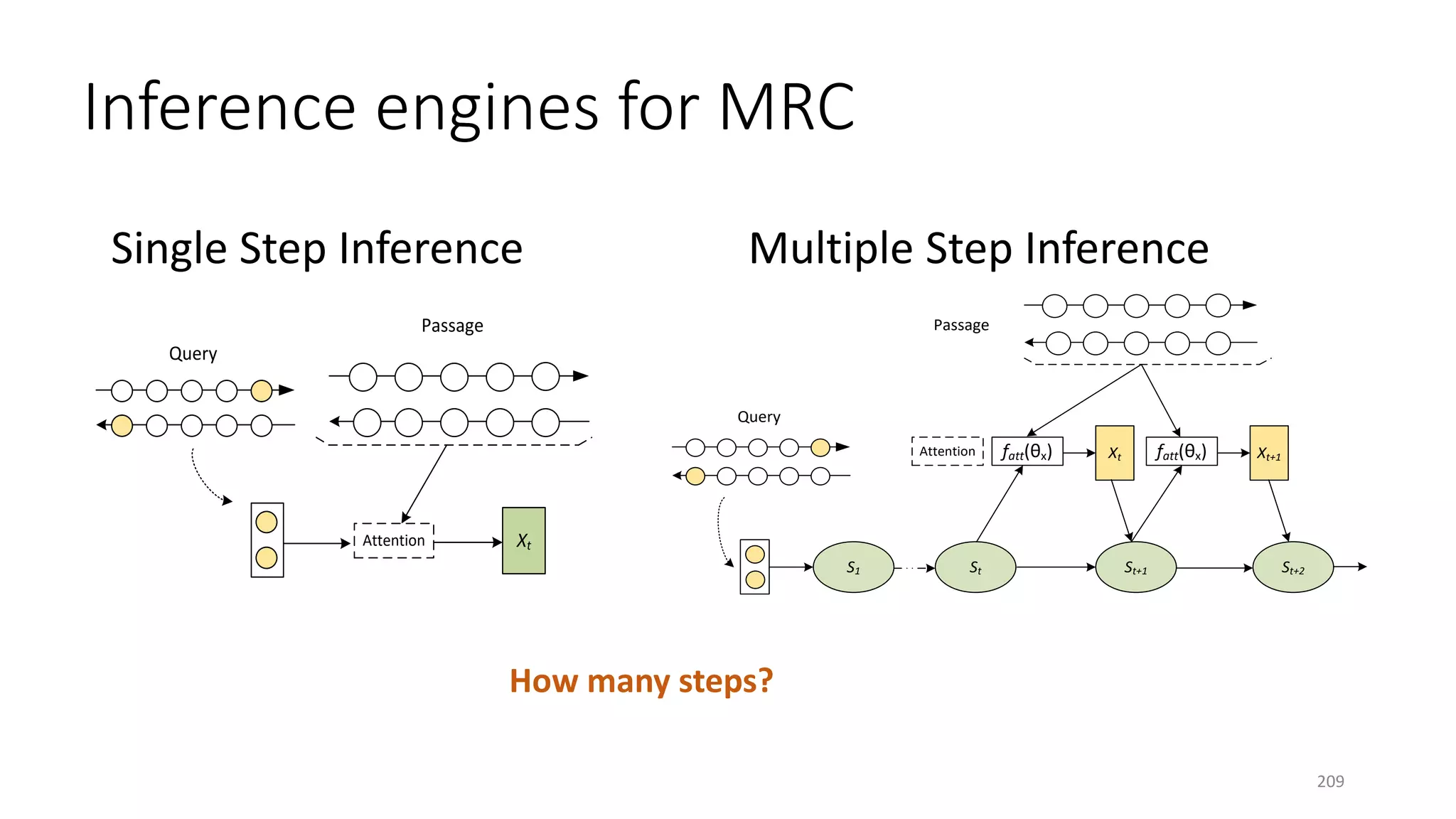
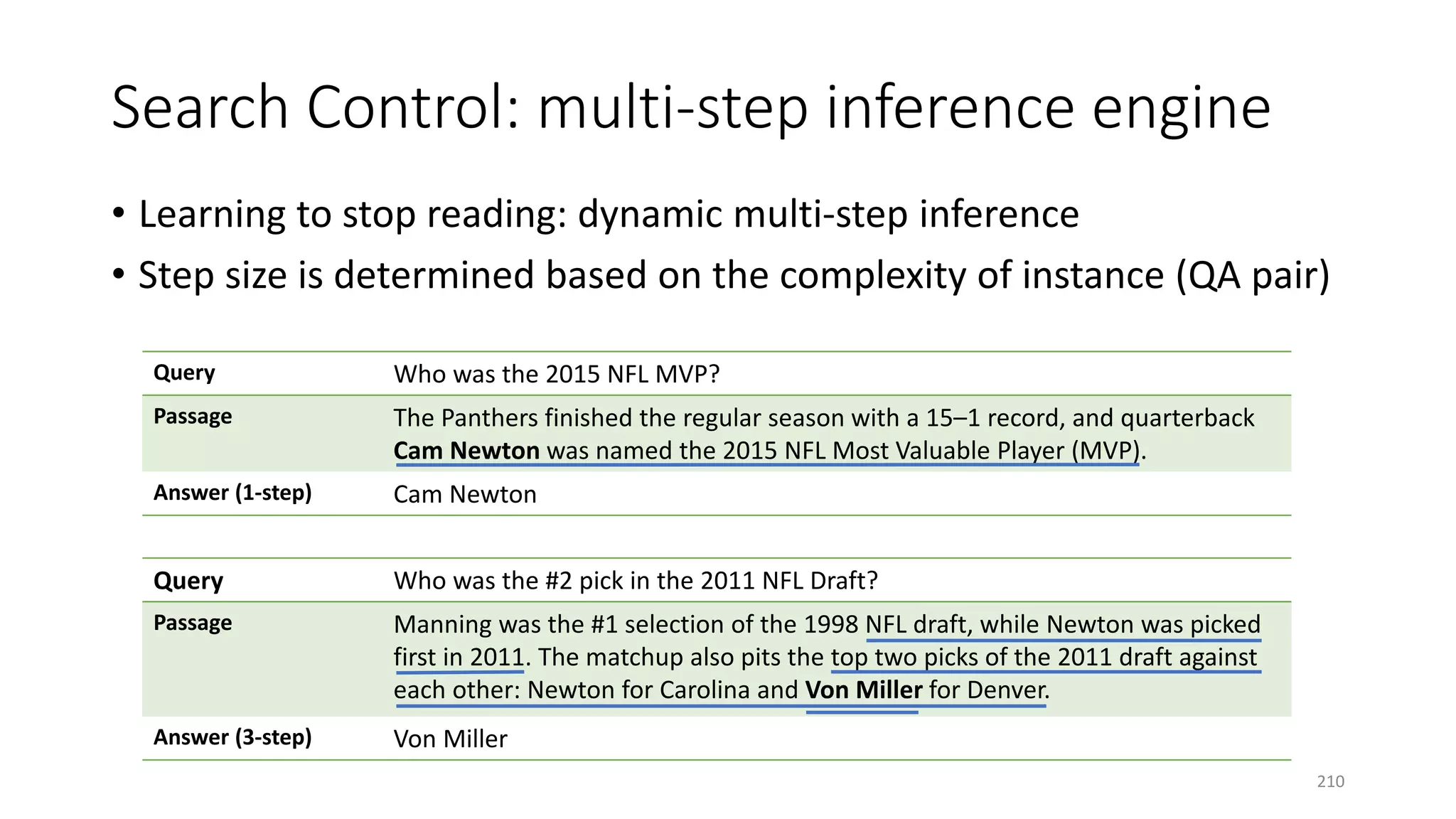
![ReasoNet: Learn to Stop Reading
Keep gathering information (encoded in
internal state) until a good answer is formed
1. Given a set of docs in memory: 𝐌𝐌
2. Start with query: 𝑆𝑆
3. Identify info in 𝐌𝐌 that is related to 𝑆𝑆 :
𝑋𝑋 = 𝑓𝑓𝑎𝑎(𝑆𝑆, 𝐌𝐌)
4. Update internal state: 𝑆𝑆 = RNN(𝑆𝑆, 𝑋𝑋)
5. Whether a satisfied answer 𝑂𝑂 can be
formed based on 𝑆𝑆: 𝑓𝑓𝑡𝑡𝑡𝑡(𝑆𝑆)
6. If so, stop and output answer 𝑂𝑂 = 𝑓𝑓𝑜𝑜(𝑆𝑆);
otherwise return to 3.
[Shen+ 16b]
211](https://image.slidesharecdn.com/mitqptdarkanz785ioot-signature-233d5c007282b08e62cf0f4d0a5dd88f5ed85398db05a93a193537bbc0db97b6-poli-190707174549/75/BIng-NLP-Expert-Dl-summer-school-2017-jianfeng-gao-v2-211-2048.jpg)
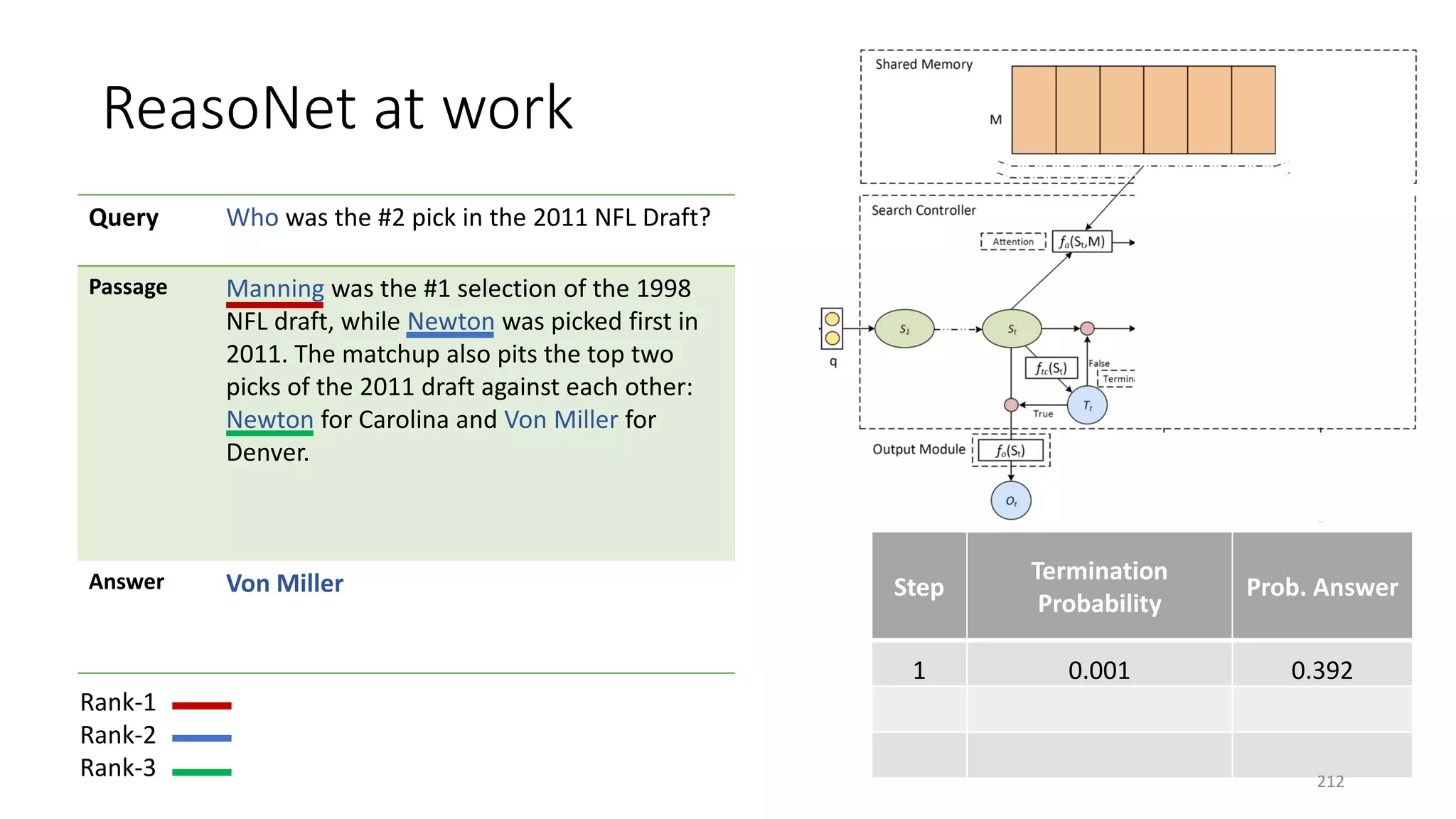
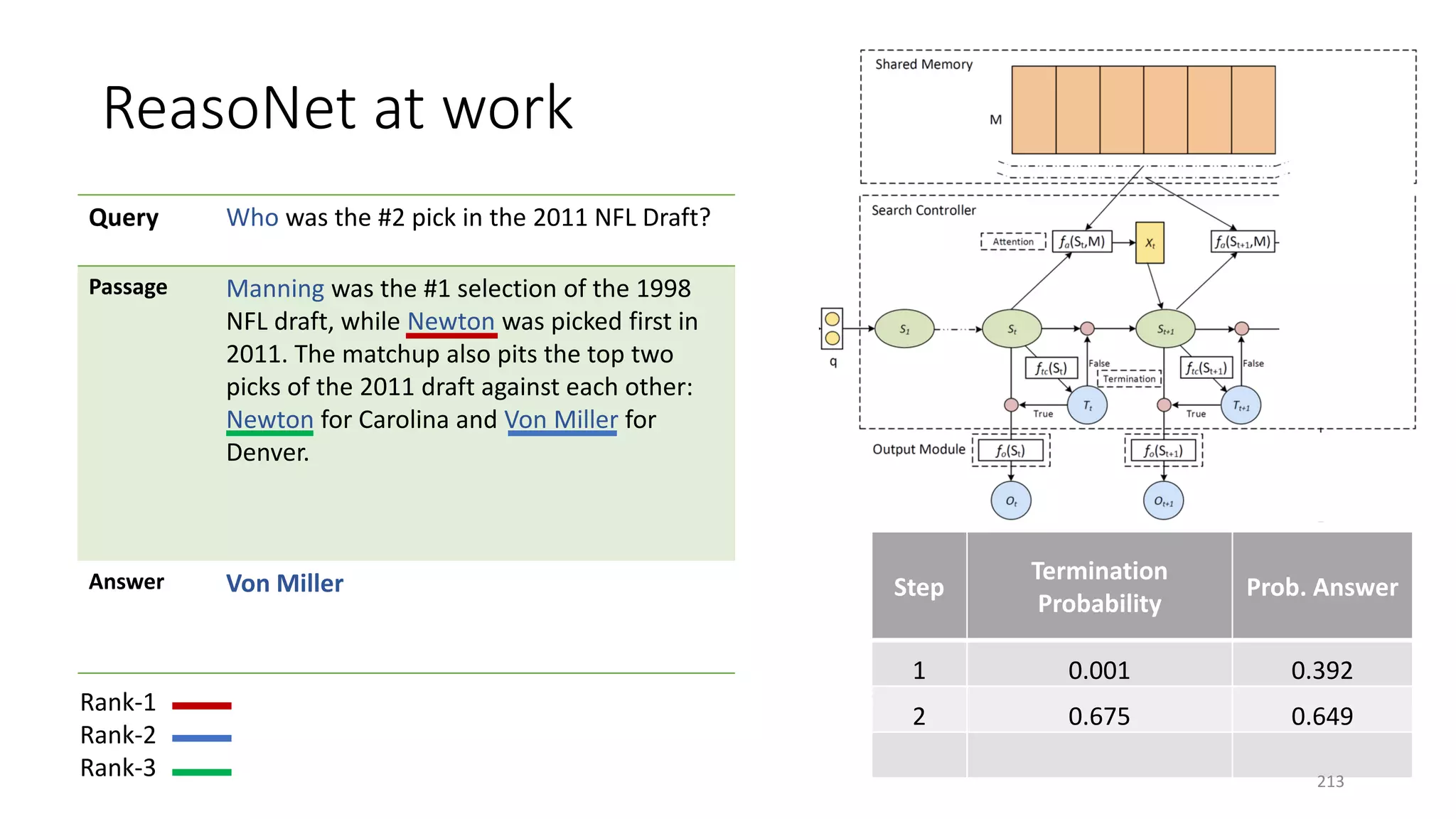
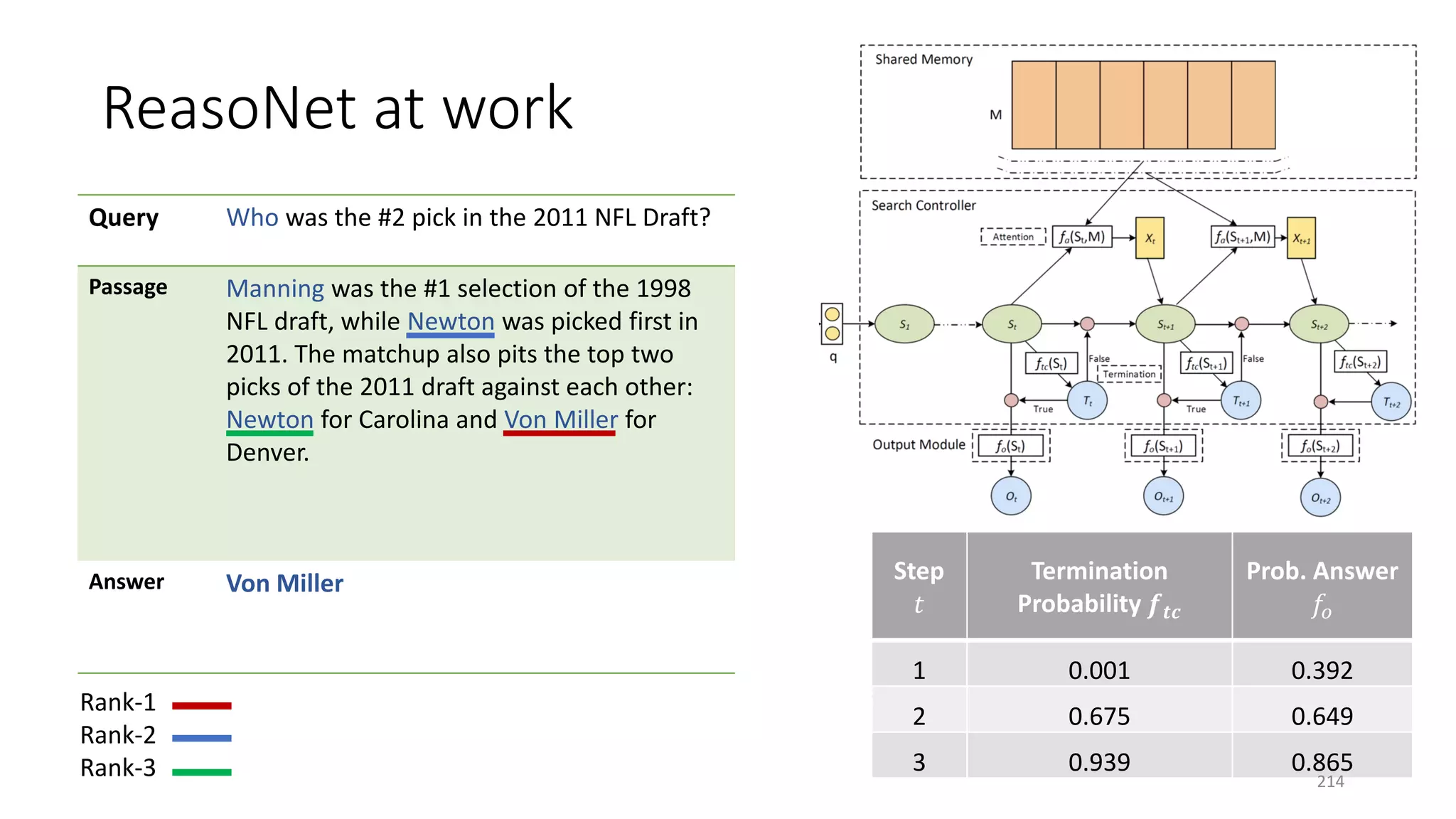
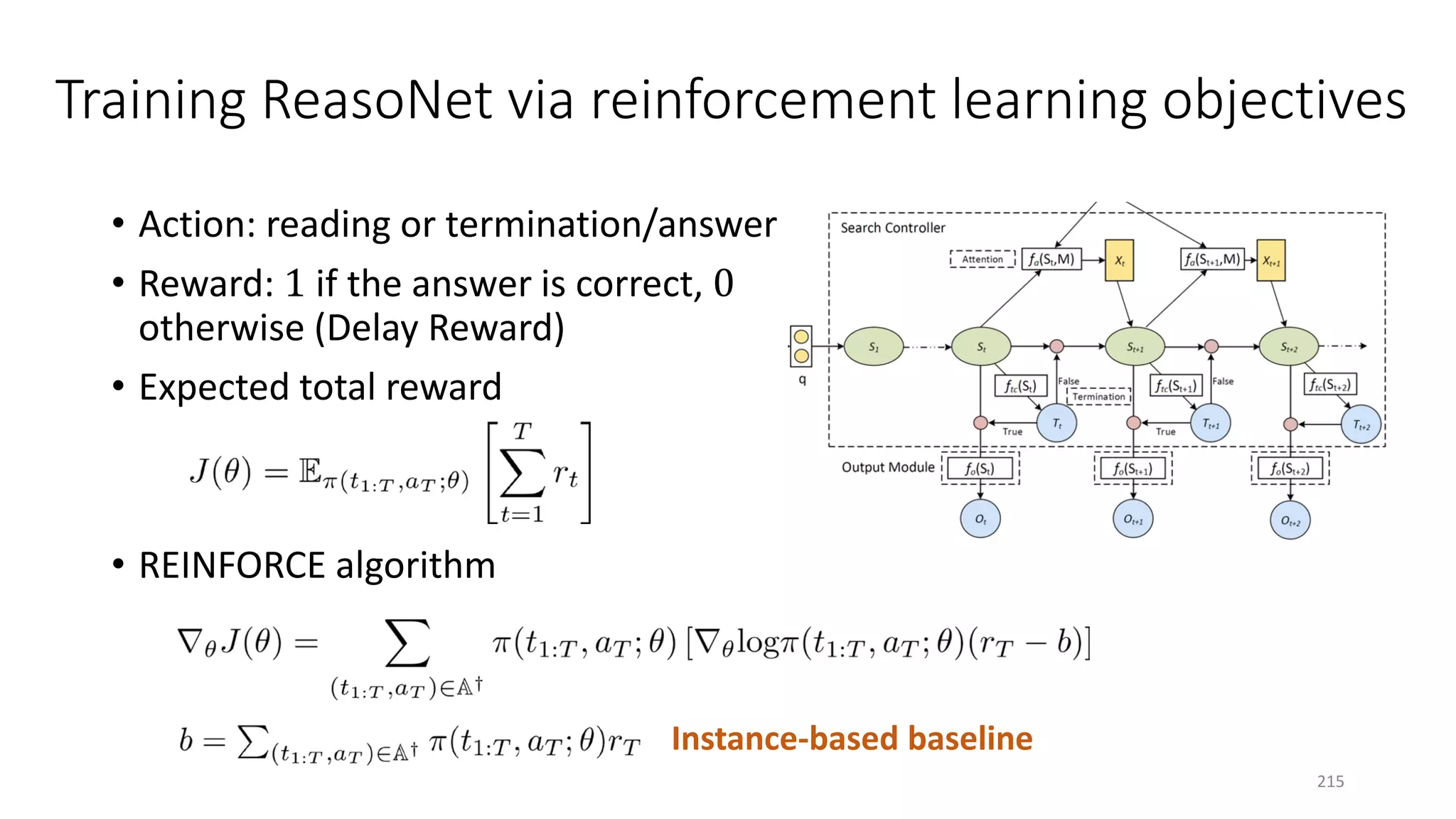
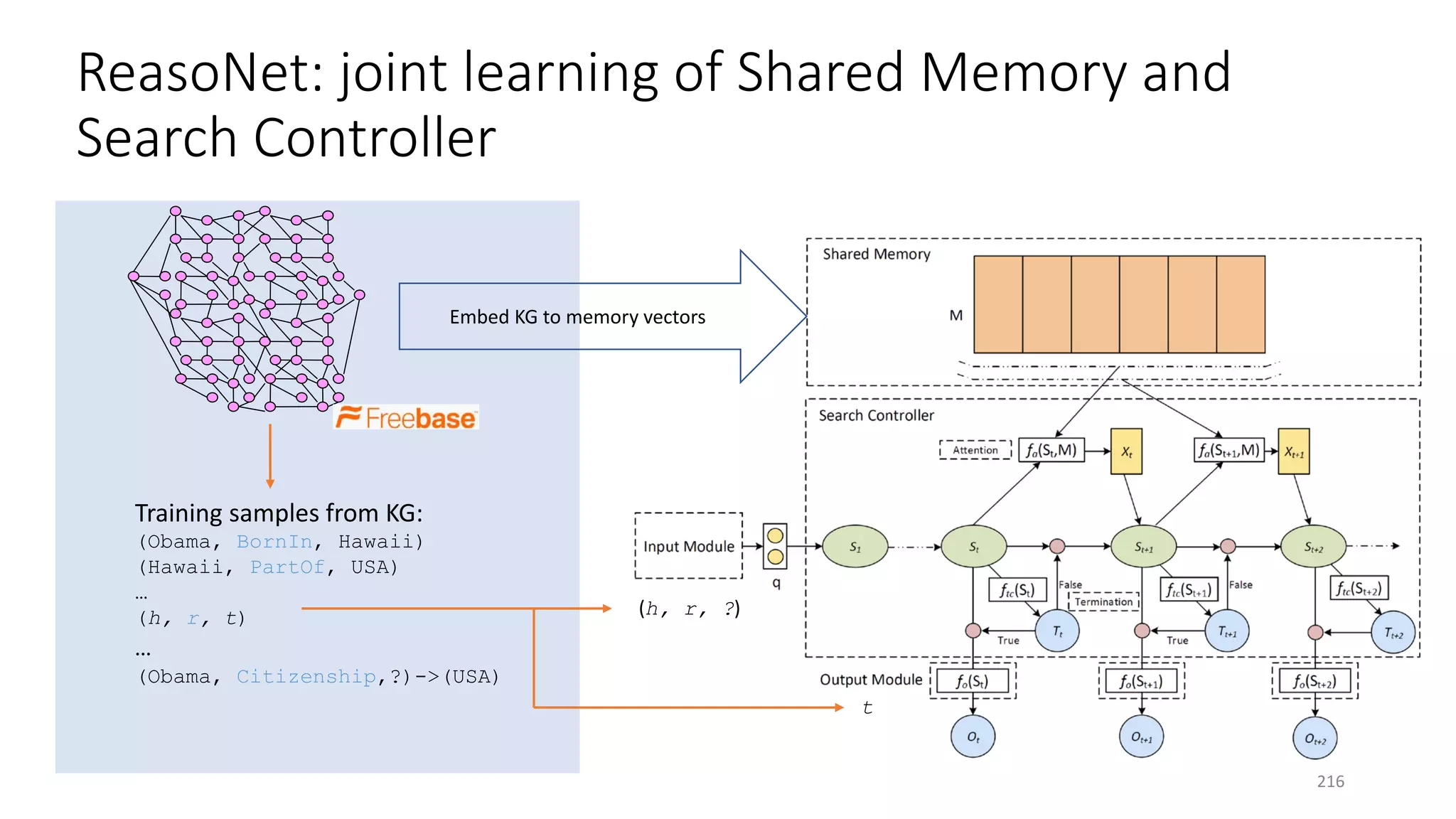
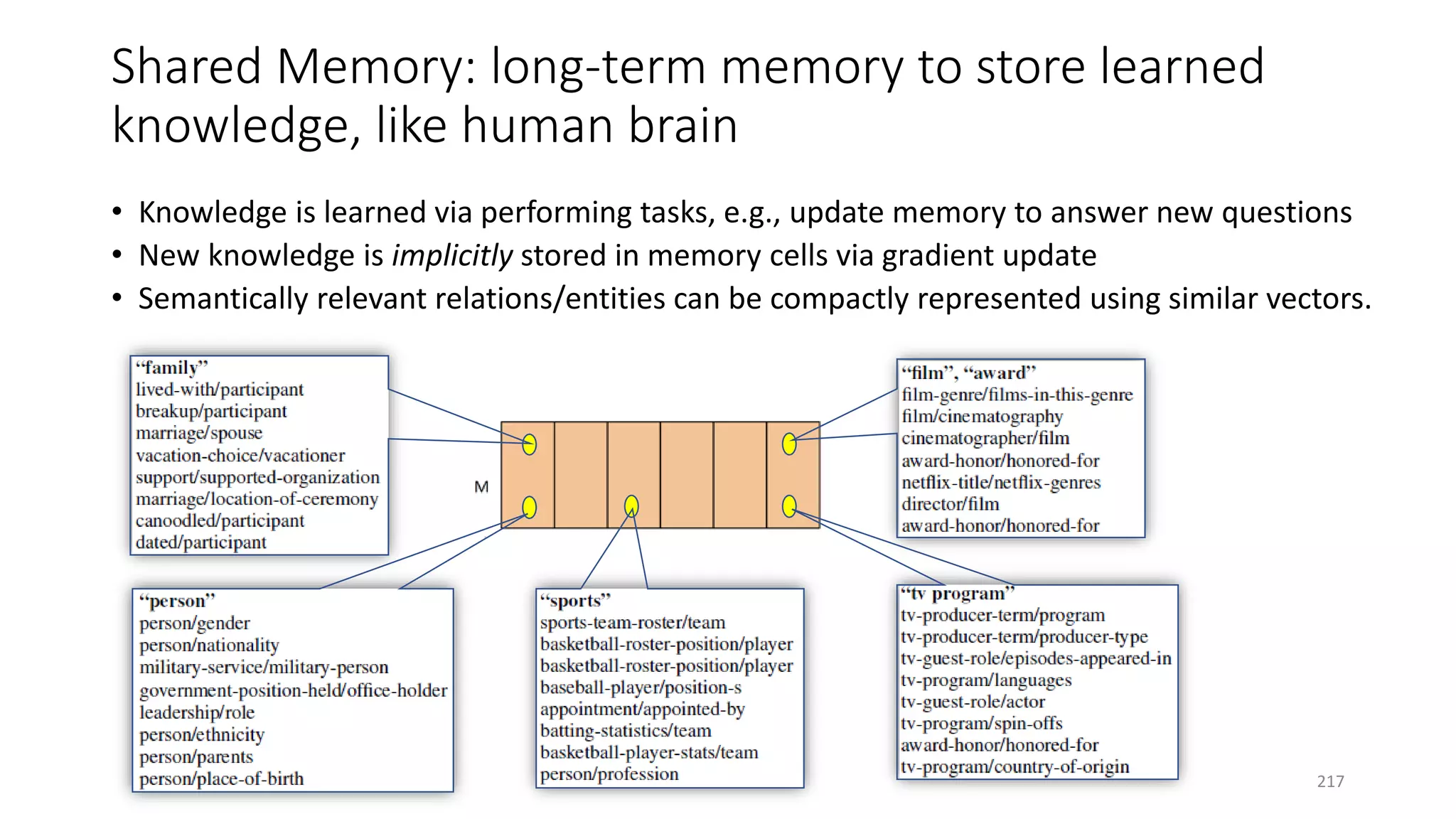
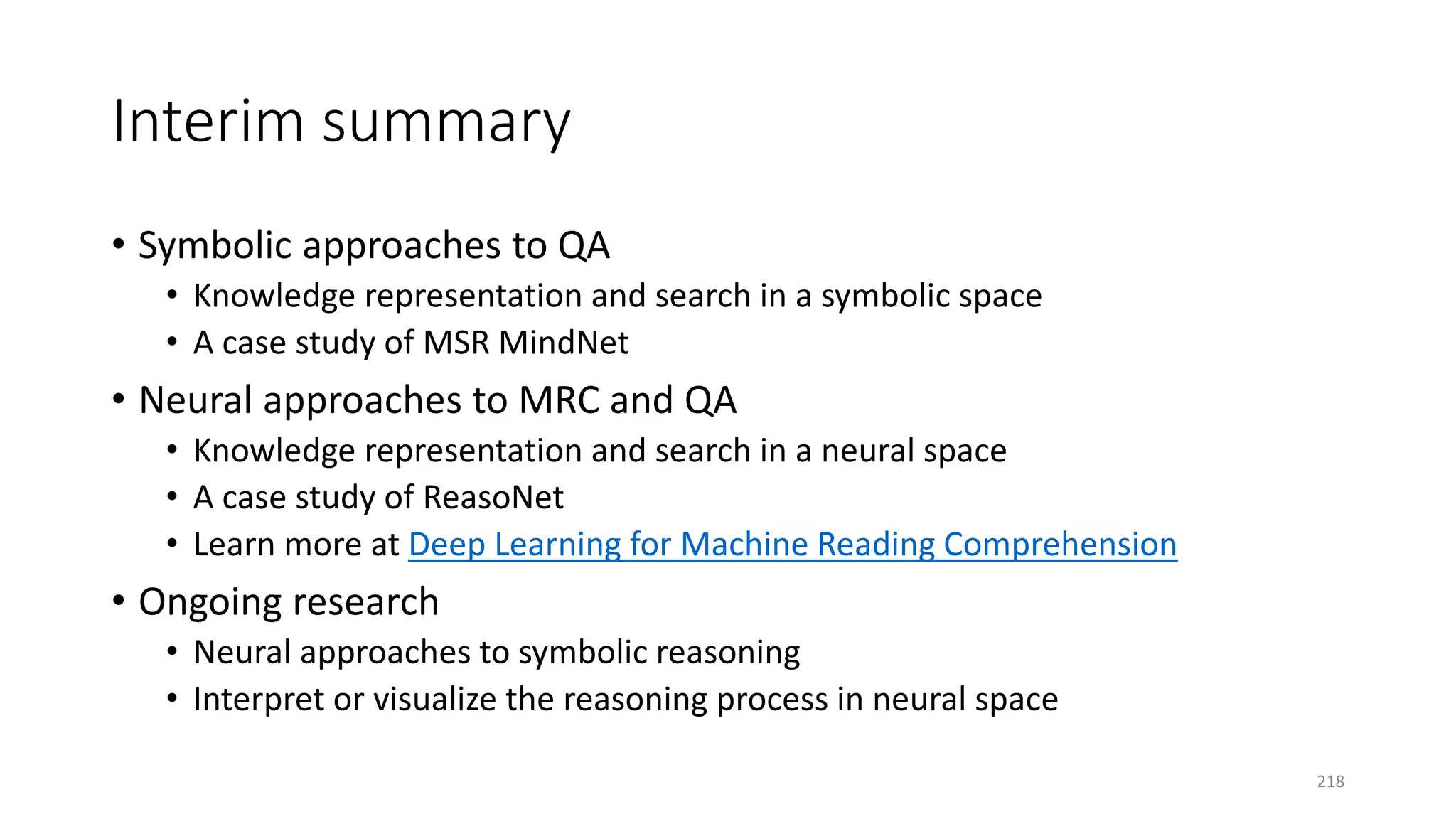
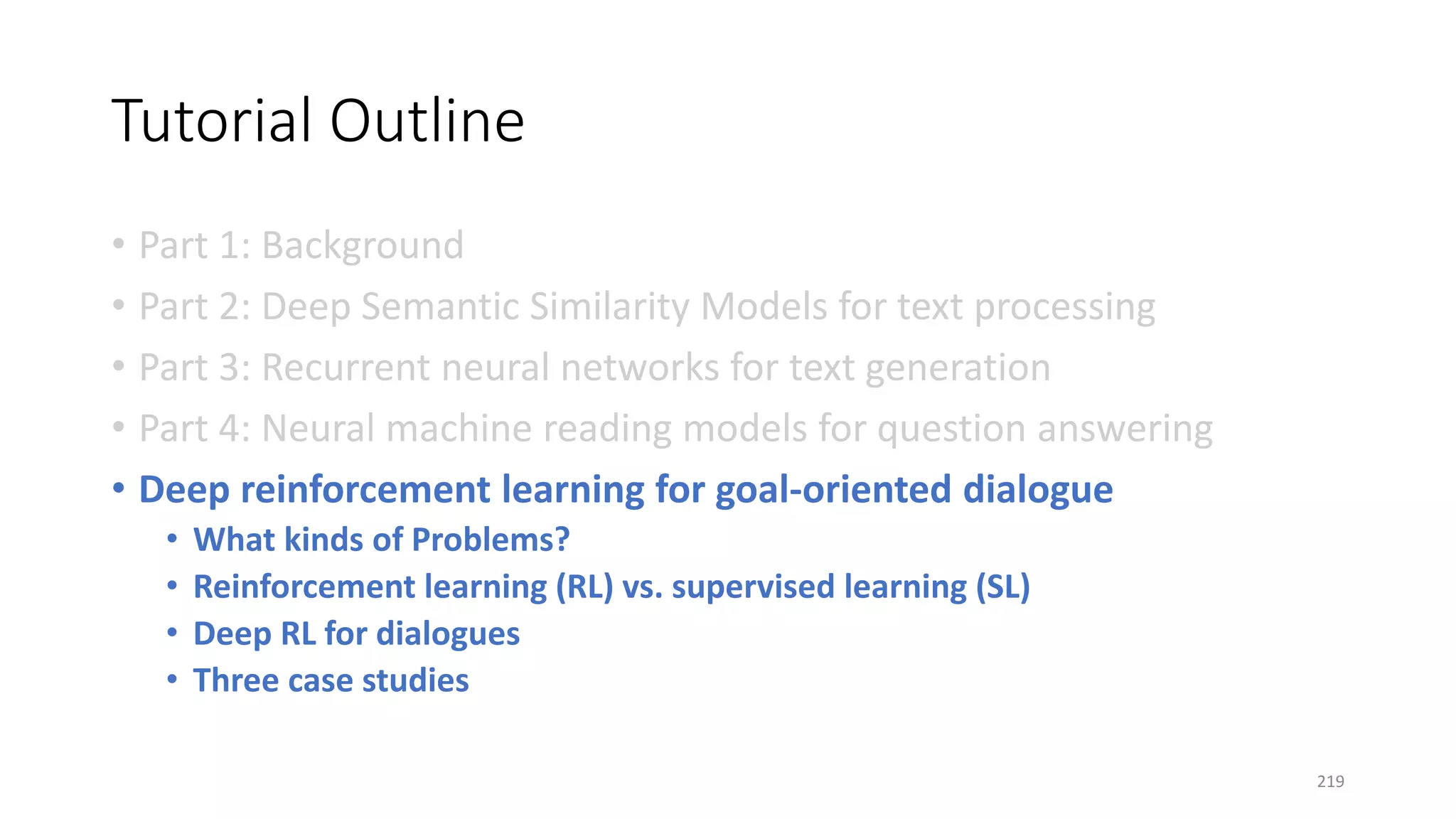
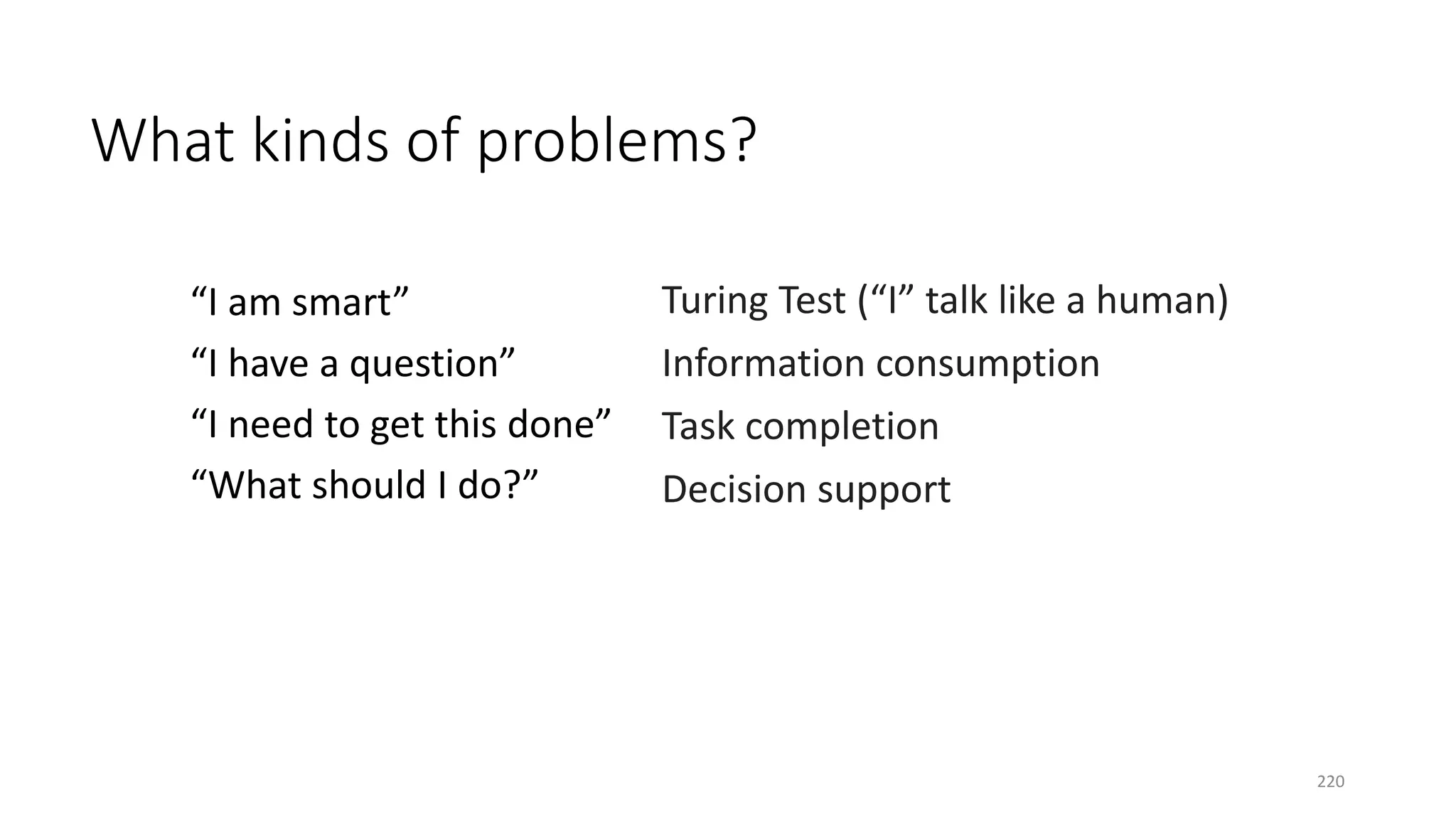
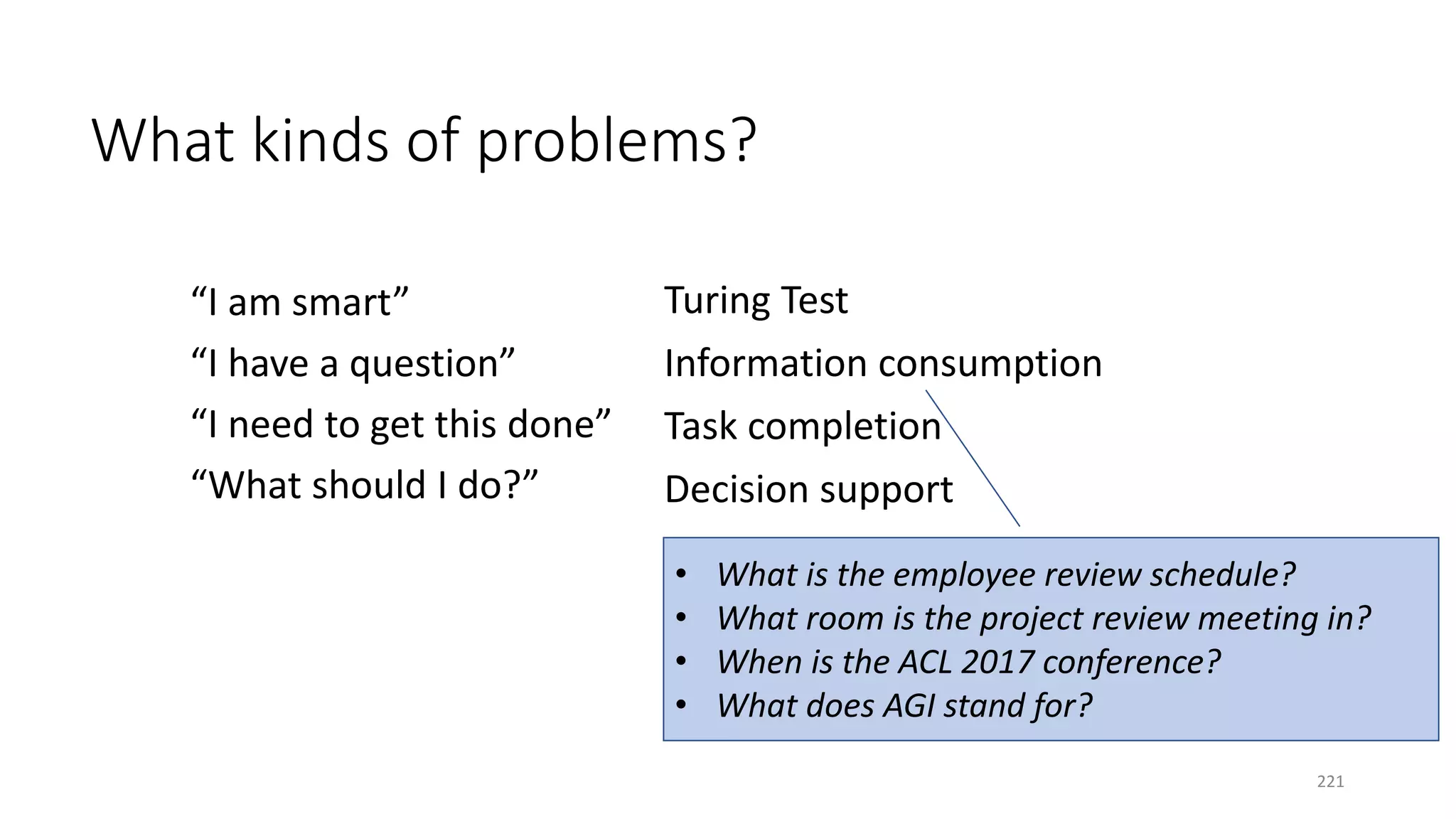
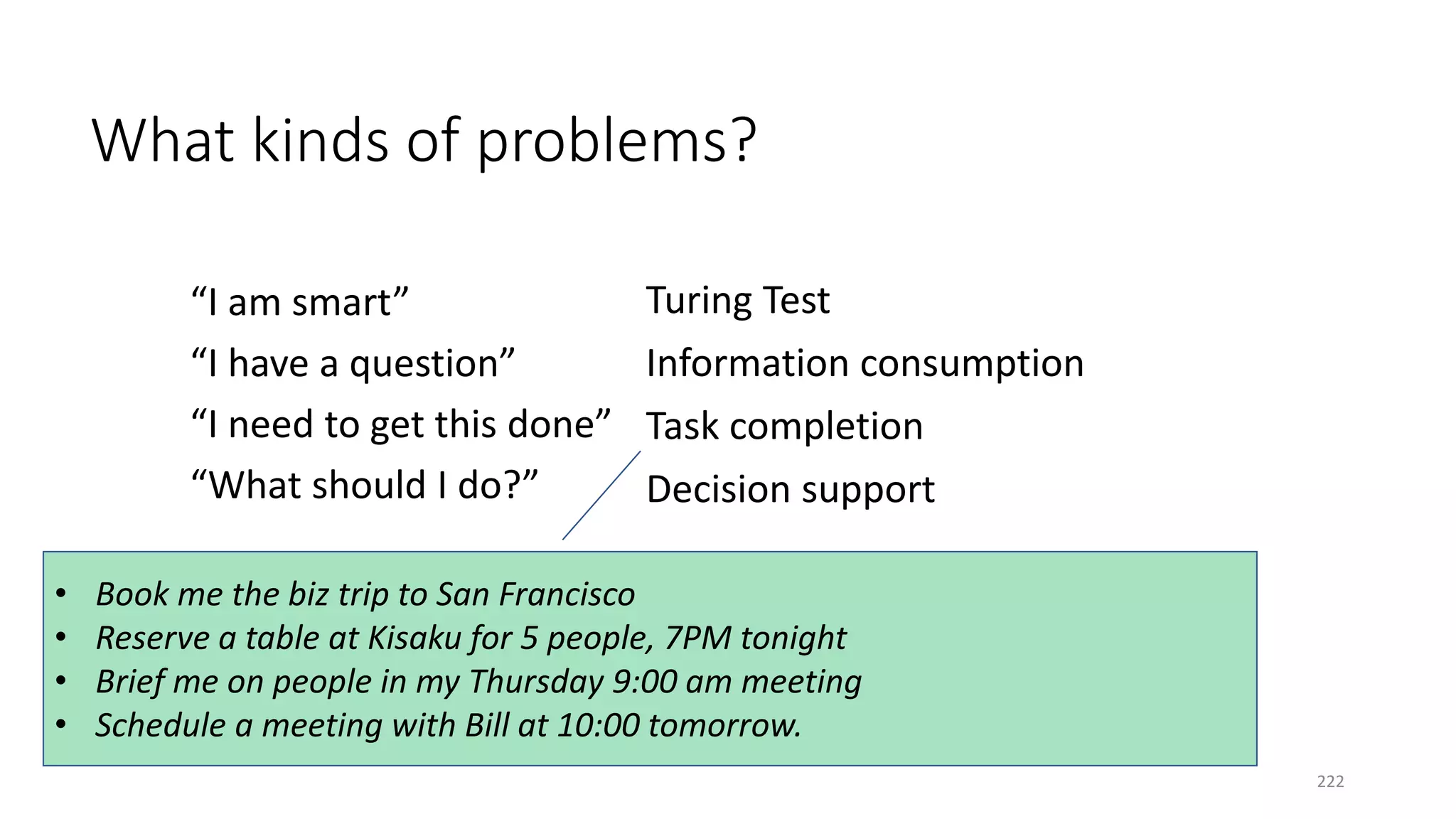
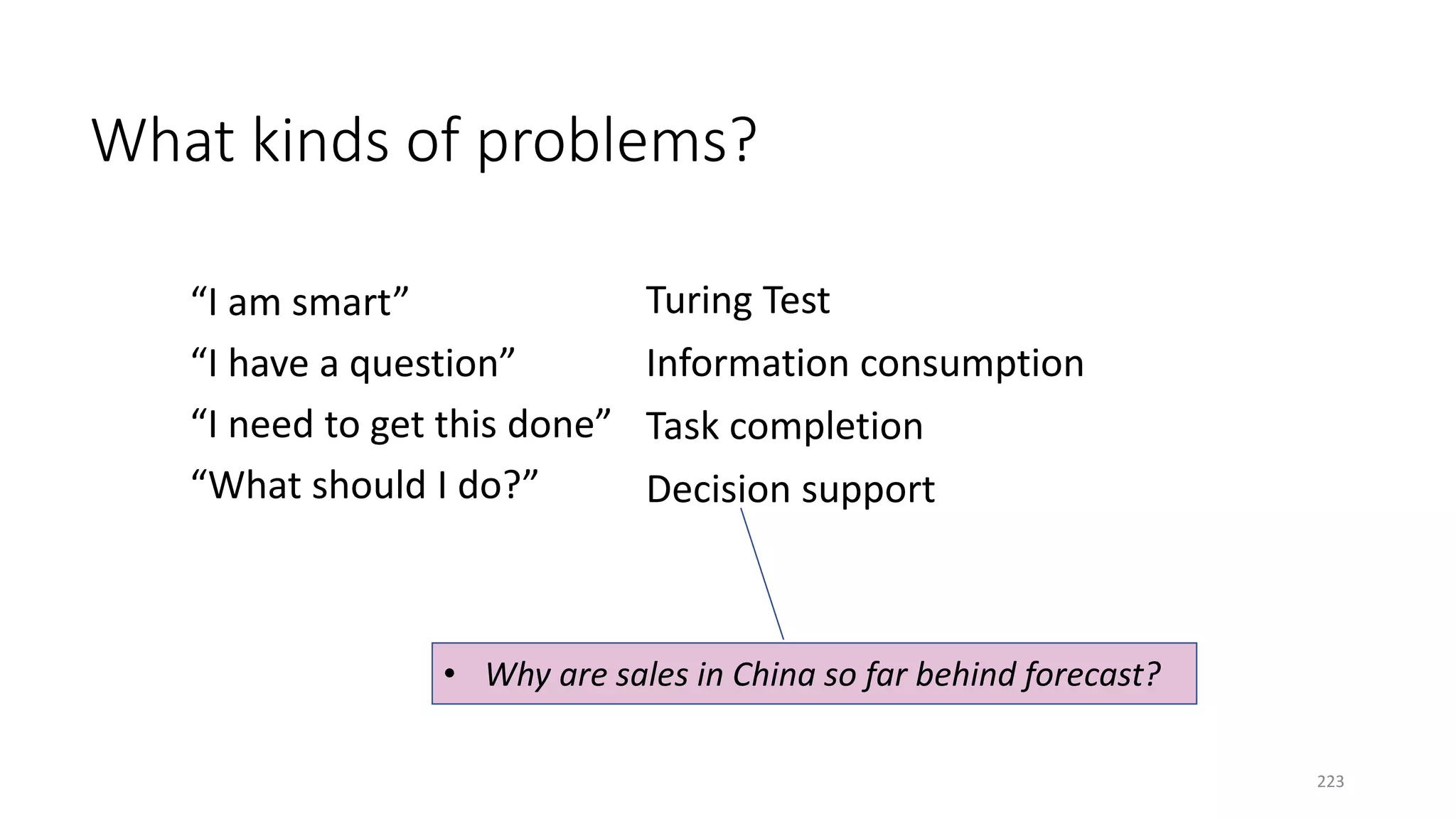
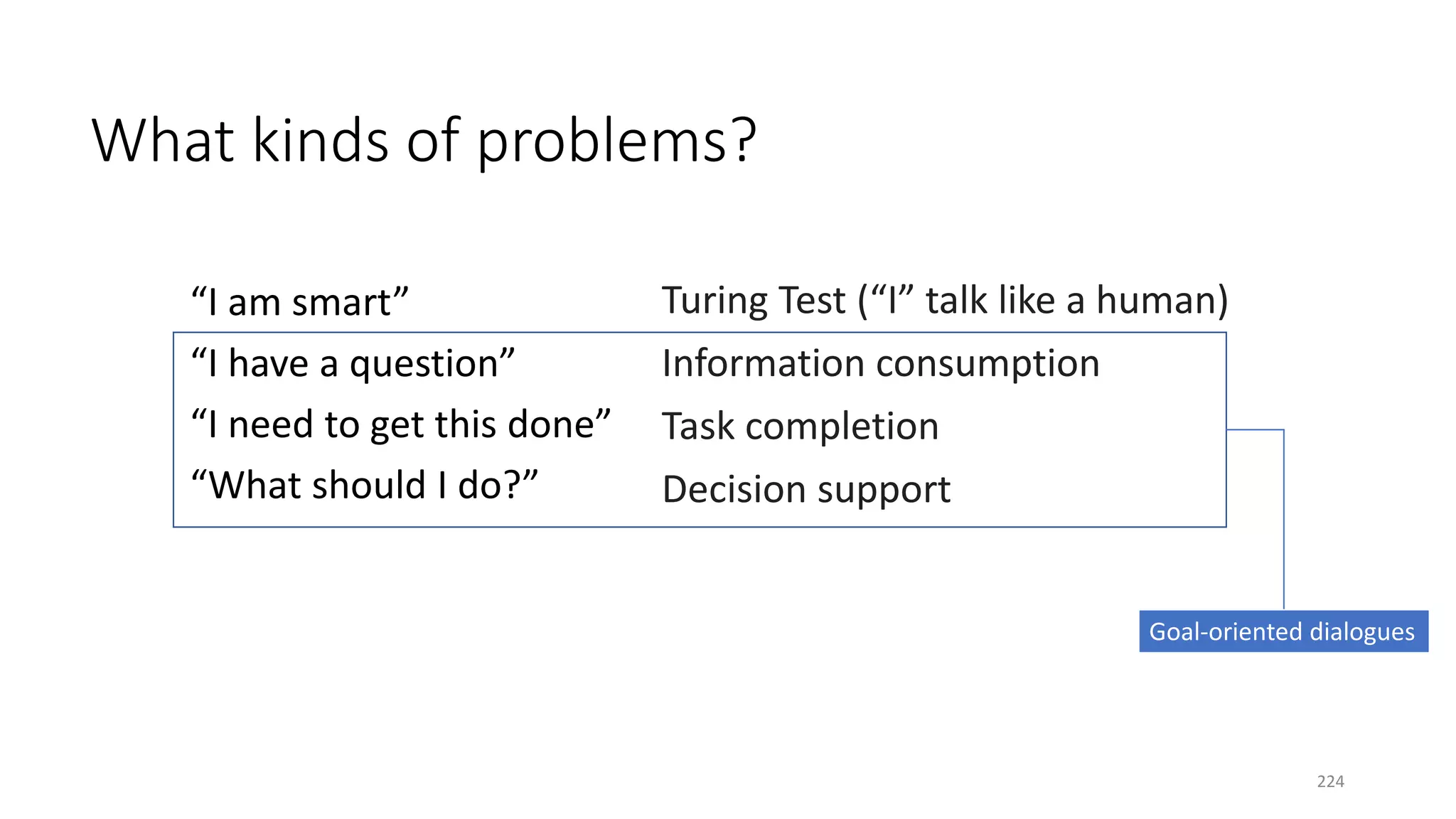

![Aspirational Goal:
Enterprise Assistant
Where are sales lagging behind our
forecast?
The worst region is [country], where sales
are XX% below projections
Do you know why?
The forecast for [product] growth was
overly optimistic
How can we turn this around?
Here are the 10 customers in [country]
with the most growth potential, per our
CRM model
Can you set up a meeting with the CTO of
[company]?
Yes, I’ve set up a meeting with [person
name] for next month when you’re in
[location]
Decision Support
Task Completion
Info Consumption
Task Completion Thanks 226](https://image.slidesharecdn.com/mitqptdarkanz785ioot-signature-233d5c007282b08e62cf0f4d0a5dd88f5ed85398db05a93a193537bbc0db97b6-poli-190707174549/75/BIng-NLP-Expert-Dl-summer-school-2017-jianfeng-gao-v2-226-2048.jpg)
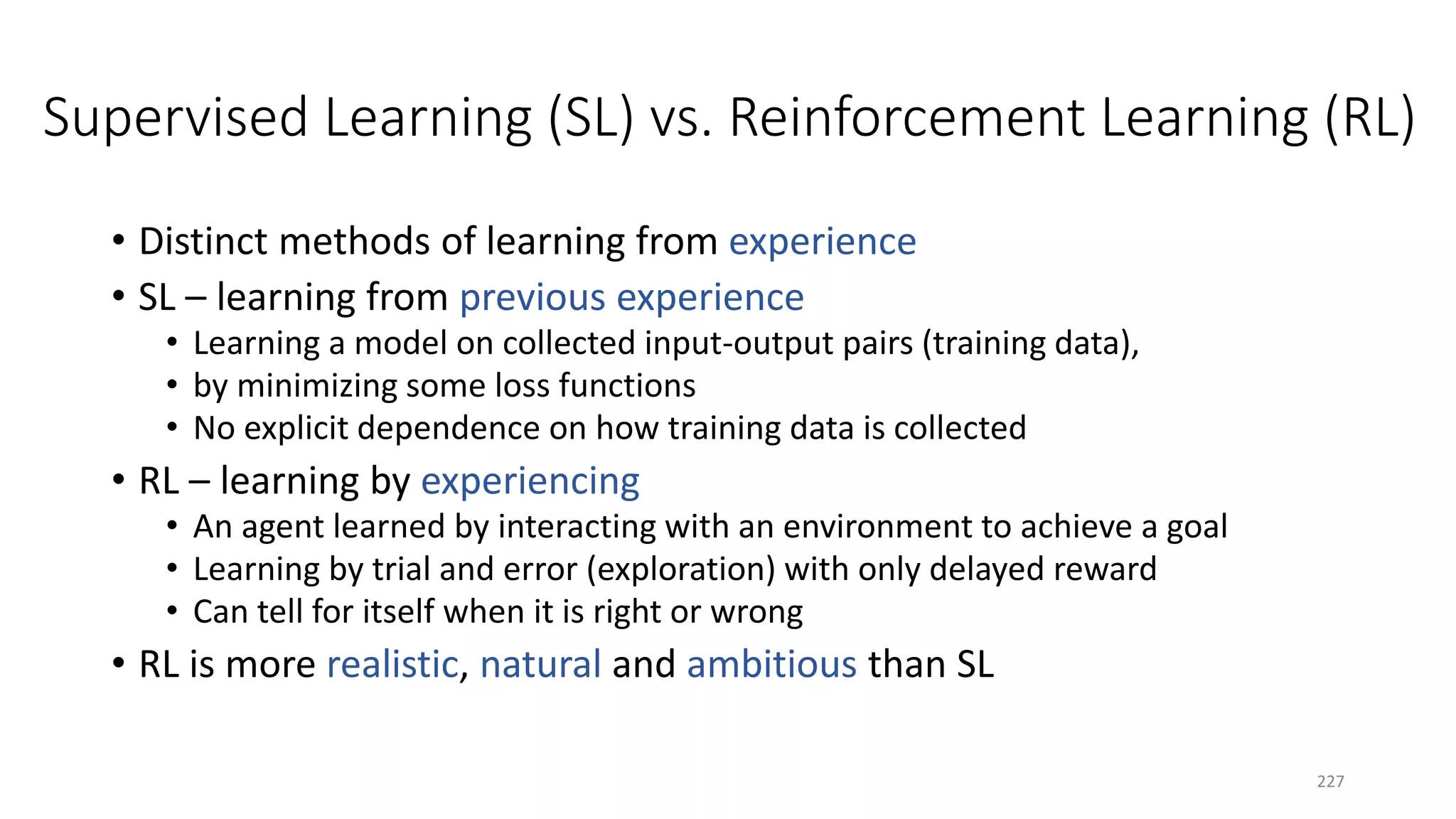
![SL vs. RL
RL’ Define
reward, if not
obvious
Create a
simulation of the
environment
Optimize policy by
interaction with
simulated environment
Corpus
with labels
Define
objective
Deploy
model
Train
modelSL
Automatic improvement
possible if labels occur
naturally
Define
reward, if not
obvious
Obtain access to
the target
environment
Optimize policy by
interaction with target
environment
RL
Automatic improvement
possible if reward signal
occurs naturally
Collect a corpus of
input patterns and
assign labels
RL’’ Define
reward, if not
obvious
Collect a corpus of
interactions with
the environment
Optimize policy on the
corpus
Corpus of
interactions
Corpus and solution
methods must have
specific properties
[Slide from Lihong Li and Jason Williams]
228](https://image.slidesharecdn.com/mitqptdarkanz785ioot-signature-233d5c007282b08e62cf0f4d0a5dd88f5ed85398db05a93a193537bbc0db97b6-poli-190707174549/75/BIng-NLP-Expert-Dl-summer-school-2017-jianfeng-gao-v2-228-2048.jpg)
![The RL Interface
• Environment may be unknown, nonlinear, stochastic and complex
• Learning to best represent the state-action space
• Agent learns a policy mapping states to actions, 𝑎𝑎 = 𝜋𝜋(𝑠𝑠)
• So as to maximize its cumulative reward in the long run, 𝑅𝑅 = ∑𝑡𝑡 𝛾𝛾𝑡𝑡−1 𝑟𝑟𝑡𝑡
[Sutton & Barto 98]
𝑠𝑠𝑡𝑡
𝑎𝑎𝑡𝑡
𝑟𝑟𝑡𝑡
229](https://image.slidesharecdn.com/mitqptdarkanz785ioot-signature-233d5c007282b08e62cf0f4d0a5dd88f5ed85398db05a93a193537bbc0db97b6-poli-190707174549/75/BIng-NLP-Expert-Dl-summer-school-2017-jianfeng-gao-v2-229-2048.jpg)
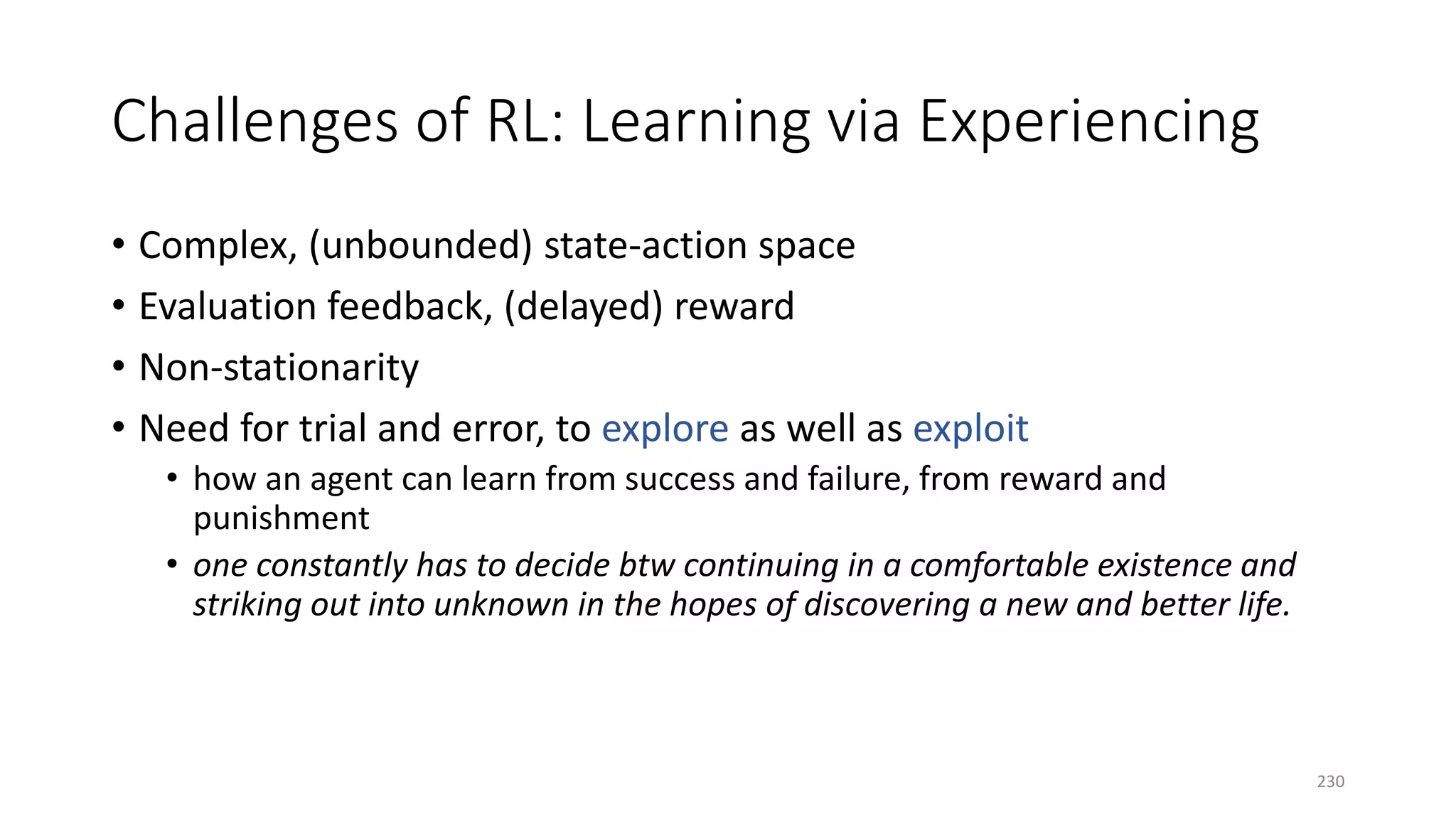
![A Finite Markov Decision Process (MDP)
• Discrete time 𝑡𝑡 = 1,2,3, …
• A finite set of states, 𝑠𝑠
• A finite set of actions, 𝑎𝑎
• A finite set of rewards, 𝑟𝑟
• Life is a trajectory: … 𝑠𝑠𝑡𝑡, 𝑎𝑎𝑡𝑡, 𝑟𝑟𝑡𝑡+1, 𝑠𝑠𝑡𝑡+1, 𝑎𝑎𝑡𝑡+1, 𝑟𝑟𝑡𝑡+2, 𝑠𝑠𝑡𝑡+2 …
• RL task: search for a policy 𝜋𝜋,
• according to which the agent chooses each action 𝑎𝑎𝑡𝑡 = 𝜋𝜋(𝑠𝑠𝑡𝑡),
• so as to maximize the long-term rewards (discounted sum of future rewards):
𝜋𝜋∗ = argmax
𝜋𝜋
𝐄𝐄 ∑𝑡𝑡 𝛾𝛾𝑡𝑡−1 𝑟𝑟𝑡𝑡 |𝜋𝜋
[Howard 60; Sutton & Barto 98]
231](https://image.slidesharecdn.com/mitqptdarkanz785ioot-signature-233d5c007282b08e62cf0f4d0a5dd88f5ed85398db05a93a193537bbc0db97b6-poli-190707174549/75/BIng-NLP-Expert-Dl-summer-school-2017-jianfeng-gao-v2-231-2048.jpg)
![RL algorithms: A simplified overview
Model is known
(aka “planning”)
Model is unknown
(Access to environment/corpus, but not 𝑷𝑷 or 𝑹𝑹)
Value-function based
(learn 𝑄𝑄∗ first, then
𝜋𝜋∗)
Value iteration
Policy iteration
Linear programming
Monte Carlo tree search
Approx. value iteration (Q-learning, Sarsa, …)
Approx. policy iteration (LSPI, …)
Monte Carlo estimation
…
Direct policy search
(learn 𝜋𝜋∗ directly)
Policy gradient
…
[Slide from Lihong Li and Jason Williams]
232](https://image.slidesharecdn.com/mitqptdarkanz785ioot-signature-233d5c007282b08e62cf0f4d0a5dd88f5ed85398db05a93a193537bbc0db97b6-poli-190707174549/75/BIng-NLP-Expert-Dl-summer-school-2017-jianfeng-gao-v2-232-2048.jpg)
![Action-value function, 𝑄𝑄(𝑠𝑠, 𝑎𝑎)
• 𝑄𝑄(𝑠𝑠, 𝑎𝑎): the value of taking action 𝑎𝑎 in state 𝑠𝑠
• Given the optimal 𝑄𝑄∗(𝑠𝑠, 𝑎𝑎) for all 𝑠𝑠, 𝑎𝑎 , the optimal policy is
𝜋𝜋∗ 𝑠𝑠 = argmax
𝑎𝑎
𝑄𝑄∗(𝑠𝑠, 𝑎𝑎)
• Bellman expectation equation:
𝑄𝑄 𝑠𝑠, 𝑎𝑎 = 𝐸𝐸 𝑟𝑟𝑡𝑡+1 + 𝛾𝛾𝑟𝑟𝑡𝑡+2 + 𝛾𝛾2 𝑟𝑟𝑡𝑡+3 + ⋯ 𝑠𝑠𝑡𝑡 = 𝑠𝑠, 𝑎𝑎𝑡𝑡 = 𝑎𝑎
= 𝐸𝐸[𝑟𝑟𝑡𝑡+1 + 𝛾𝛾𝛾𝛾(𝑠𝑠𝑡𝑡+1, 𝑎𝑎𝑡𝑡+1)|𝑠𝑠𝑡𝑡 = 𝑠𝑠, 𝑎𝑎𝑡𝑡 = 𝑎𝑎]
• Bellman optimality equation:
𝑸𝑸∗
𝒔𝒔, 𝒂𝒂 = 𝑬𝑬[𝒓𝒓𝒕𝒕+𝟏𝟏 + 𝜸𝜸 𝐦𝐦𝐦𝐦𝐦𝐦
𝒂𝒂′
𝑸𝑸∗
𝒔𝒔𝒕𝒕+𝟏𝟏, 𝒂𝒂′
|𝒔𝒔𝒕𝒕 = 𝒔𝒔, 𝒂𝒂𝒕𝒕 = 𝒂𝒂]
Q-learning’s target for 𝑄𝑄(𝑠𝑠, 𝑎𝑎) 233](https://image.slidesharecdn.com/mitqptdarkanz785ioot-signature-233d5c007282b08e62cf0f4d0a5dd88f5ed85398db05a93a193537bbc0db97b6-poli-190707174549/75/BIng-NLP-Expert-Dl-summer-school-2017-jianfeng-gao-v2-233-2048.jpg)
![Q-Learning
• Assume 𝑄𝑄(𝑠𝑠, 𝑎𝑎) for all 𝑠𝑠, 𝑎𝑎 can be represented in a table
1. Initialize an array 𝑄𝑄(𝑠𝑠, 𝑎𝑎) arbitrarily
2. Choose actions based on 𝑄𝑄 such that all actions are taken in all
states (infinitely often in the limit)
3. On each time step, update one element of the array:
∆𝑄𝑄 𝑠𝑠𝑡𝑡, 𝑎𝑎𝑡𝑡 = 𝛼𝛼 𝑟𝑟𝑡𝑡+1 + 𝛾𝛾 max
𝑎𝑎′
𝑄𝑄(𝑠𝑠𝑡𝑡+1, 𝑎𝑎′) − 𝑄𝑄 𝑠𝑠𝑡𝑡, 𝑎𝑎𝑡𝑡
• Model-free learning:
• Learning long-term optimal behavior without model of the environment
• All we need is the sample set of (𝑠𝑠𝑡𝑡, 𝑎𝑎𝑡𝑡, 𝑟𝑟𝑡𝑡+1, 𝑠𝑠𝑡𝑡+1)
Q-learning’s target for 𝑄𝑄(𝑠𝑠, 𝑎𝑎)
[Sutton & Barto 98]
234](https://image.slidesharecdn.com/mitqptdarkanz785ioot-signature-233d5c007282b08e62cf0f4d0a5dd88f5ed85398db05a93a193537bbc0db97b6-poli-190707174549/75/BIng-NLP-Expert-Dl-summer-school-2017-jianfeng-gao-v2-234-2048.jpg)

![Q-Learning for Deep Q-Network
• Issue: learning becomes unstable
• Correlations present in the sequence of states
• Small updates to 𝑄𝑄 leads to significant change of policy and data distribution
• Correlations btw the to-be-learned 𝑄𝑄 and the target value 𝑟𝑟 + max
𝑎𝑎′
𝑄𝑄(𝑠𝑠, 𝑎𝑎′)
• Solution
• Experience replay: randomize training samples (𝑠𝑠, 𝑎𝑎, 𝑟𝑟, 𝑠𝑠′)
• Use a separate 𝑄𝑄 function to compute targets 𝑦𝑦
[DeepMind 15]
236](https://image.slidesharecdn.com/mitqptdarkanz785ioot-signature-233d5c007282b08e62cf0f4d0a5dd88f5ed85398db05a93a193537bbc0db97b6-poli-190707174549/75/BIng-NLP-Expert-Dl-summer-school-2017-jianfeng-gao-v2-236-2048.jpg)
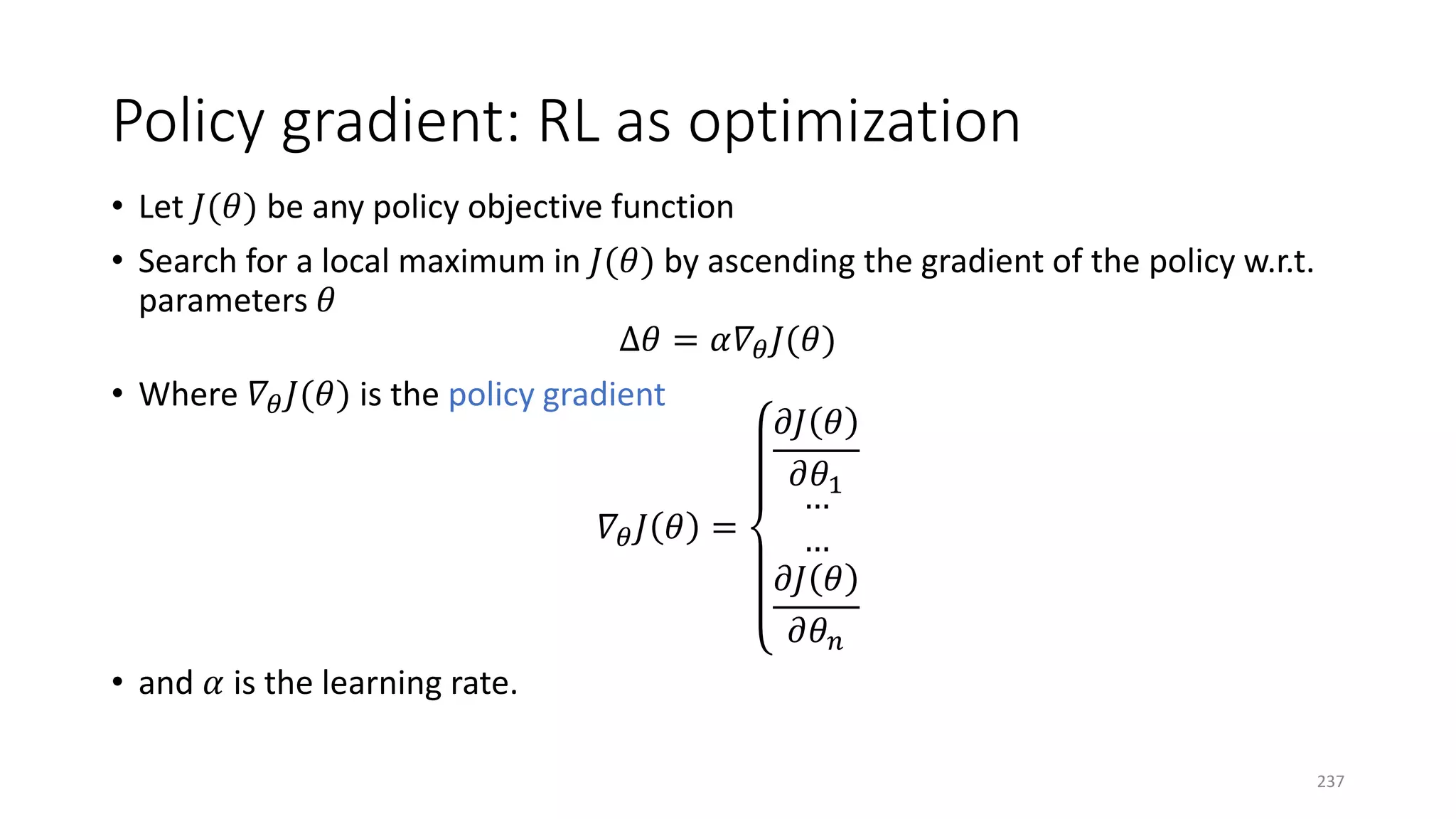
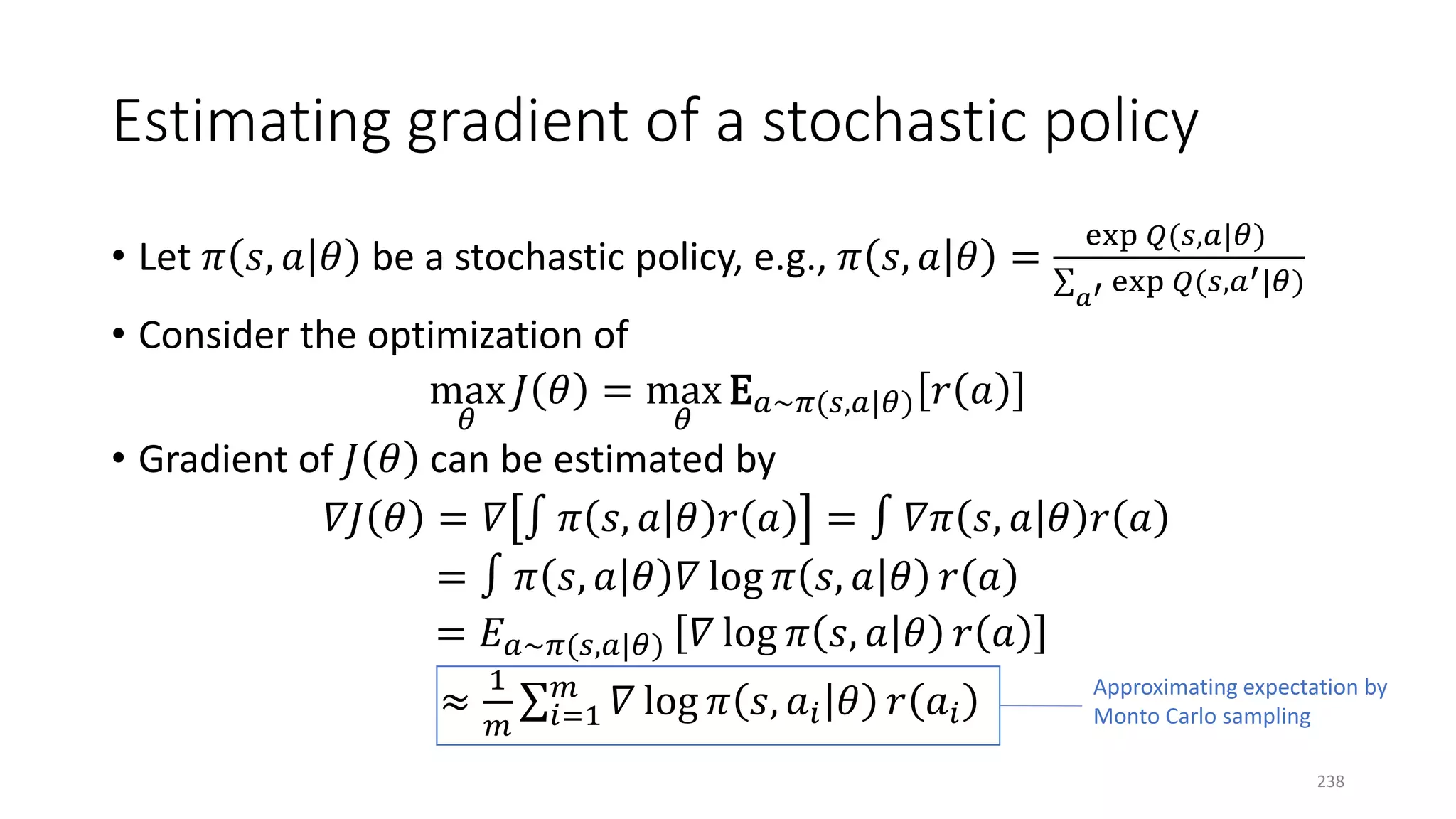
![Demo: Natural Selection and Deep RL [Shen+ 16]
Shrimp (as dots) have short life
span.
In order to survive, fish need to
eat enough shrimp when they
are alive.
The two fish are competing for
territories and food.
Purple fish: deep neural net
Blue fish: linear model
Green shrimps are toxic (-0.6)
Red shrimps are healthy (+0.8)
239](https://image.slidesharecdn.com/mitqptdarkanz785ioot-signature-233d5c007282b08e62cf0f4d0a5dd88f5ed85398db05a93a193537bbc0db97b6-poli-190707174549/75/BIng-NLP-Expert-Dl-summer-school-2017-jianfeng-gao-v2-239-2048.jpg)
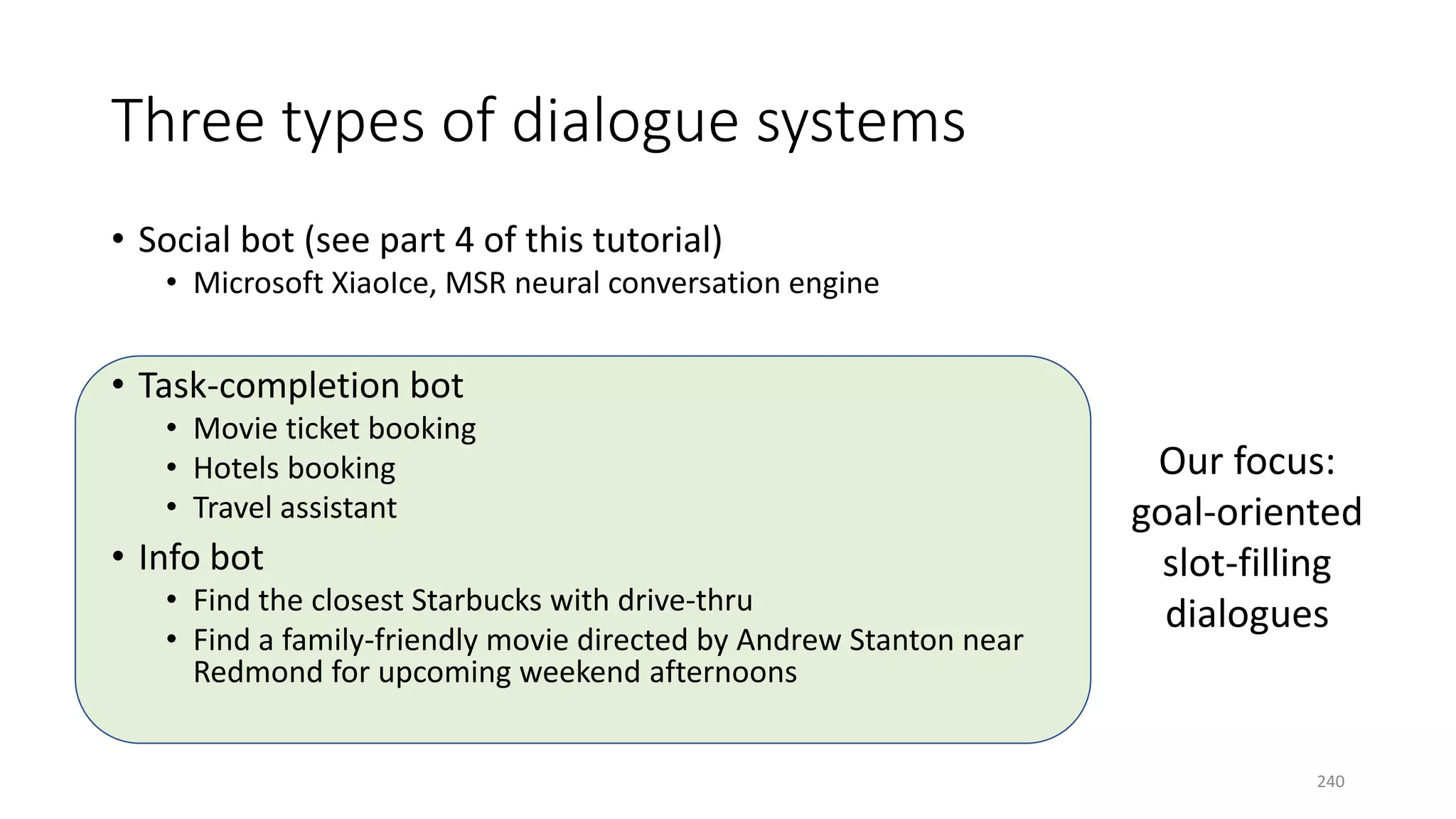
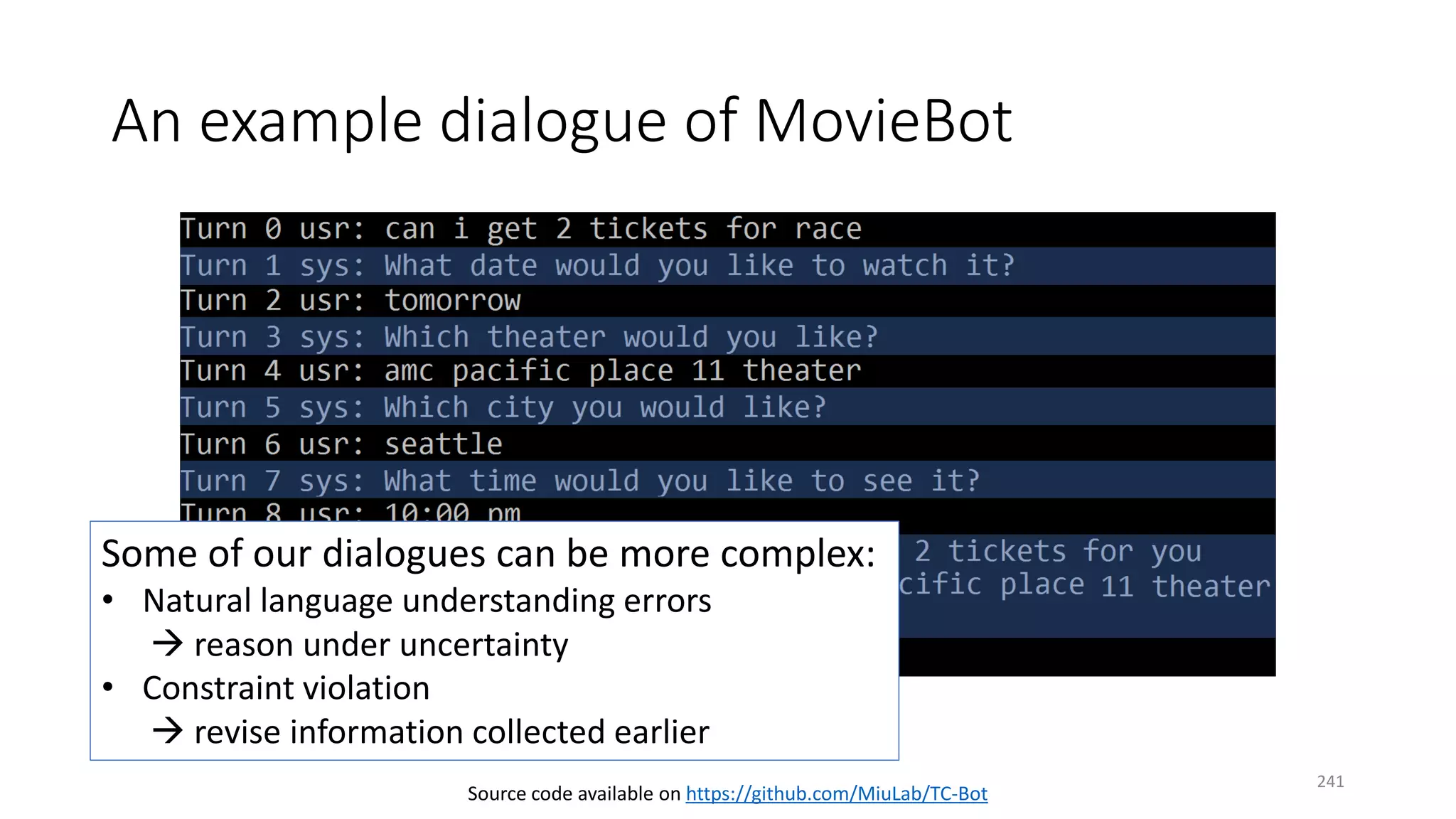
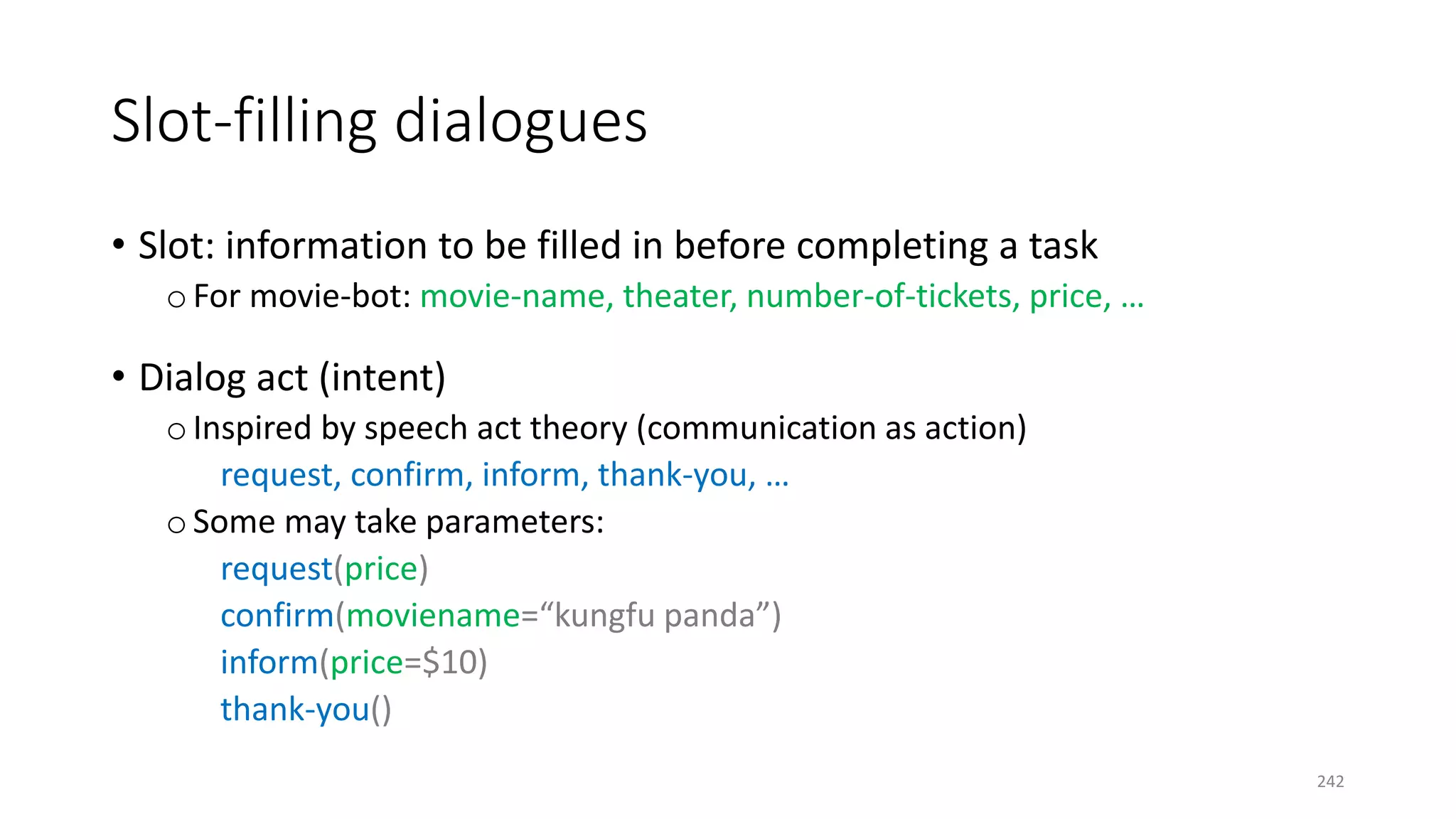
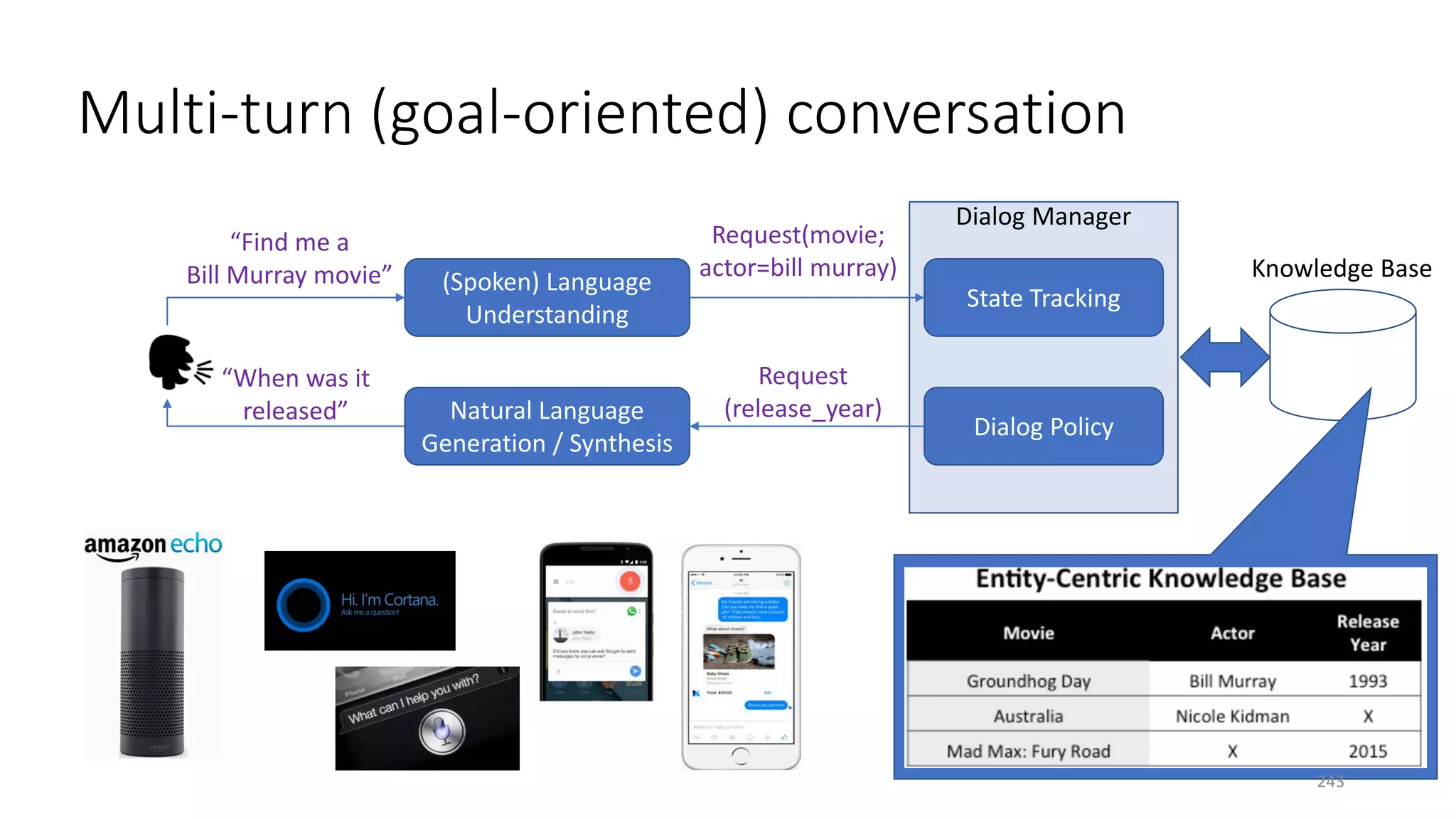
![Conversation as RL
• Observation / action
oRaw utterance (natural language form)
oSemantic representation (dialog-acts)
• Reward
o+10 upon termination if succeeded
o−10 upon termination if failed
o−1 per turn
• State
oExplicitly defined (POMDP-based, …)
oImplicitly defined (RNNs)
semanticraw
Earlier examples: [Levin+ 00; Singh+ 02; Williams & Young 07]
244](https://image.slidesharecdn.com/mitqptdarkanz785ioot-signature-233d5c007282b08e62cf0f4d0a5dd88f5ed85398db05a93a193537bbc0db97b6-poli-190707174549/75/BIng-NLP-Expert-Dl-summer-school-2017-jianfeng-gao-v2-244-2048.jpg)
![Dialogue policy learning and evaluation
• Common metrics (reflected by reward function)
o Task completion rate
o Average #turns per dialogue
• But online learning on humans is too expensive
• Offline evaluation is very difficult [Liu+ 16]
Our approach:
1. Build a user simulator
E.g., agenda-based simulator [Schatzmann & Young 09]
2. Policy learning against the simulator
3. Policy metric evaluation against humans (e.g., on M. Turk)
4. Online incremental policy learning after deployment to product
245](https://image.slidesharecdn.com/mitqptdarkanz785ioot-signature-233d5c007282b08e62cf0f4d0a5dd88f5ed85398db05a93a193537bbc0db97b6-poli-190707174549/75/BIng-NLP-Expert-Dl-summer-school-2017-jianfeng-gao-v2-245-2048.jpg)
![A user simulator
• Robustness: automatic action
selection based on uncertainty
by RL
• Flexibility: allow user-initiated
behaviors
• Reproducibility: a R&D setting
that allows consistent
comparisons of competing
methods
[Li+ 17] https://github.com/MiuLab/TC-Bot
246](https://image.slidesharecdn.com/mitqptdarkanz785ioot-signature-233d5c007282b08e62cf0f4d0a5dd88f5ed85398db05a93a193537bbc0db97b6-poli-190707174549/75/BIng-NLP-Expert-Dl-summer-school-2017-jianfeng-gao-v2-246-2048.jpg)
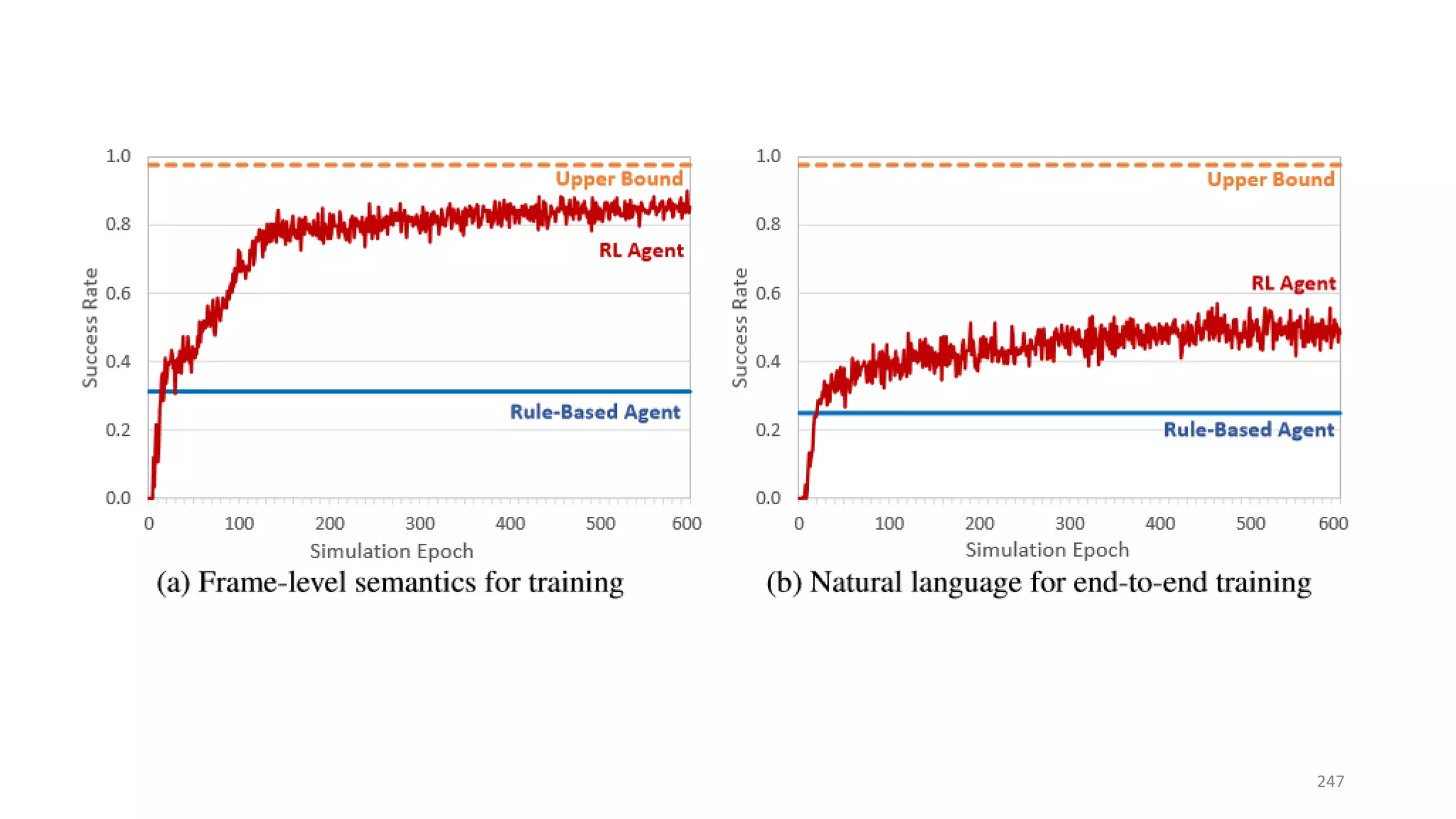
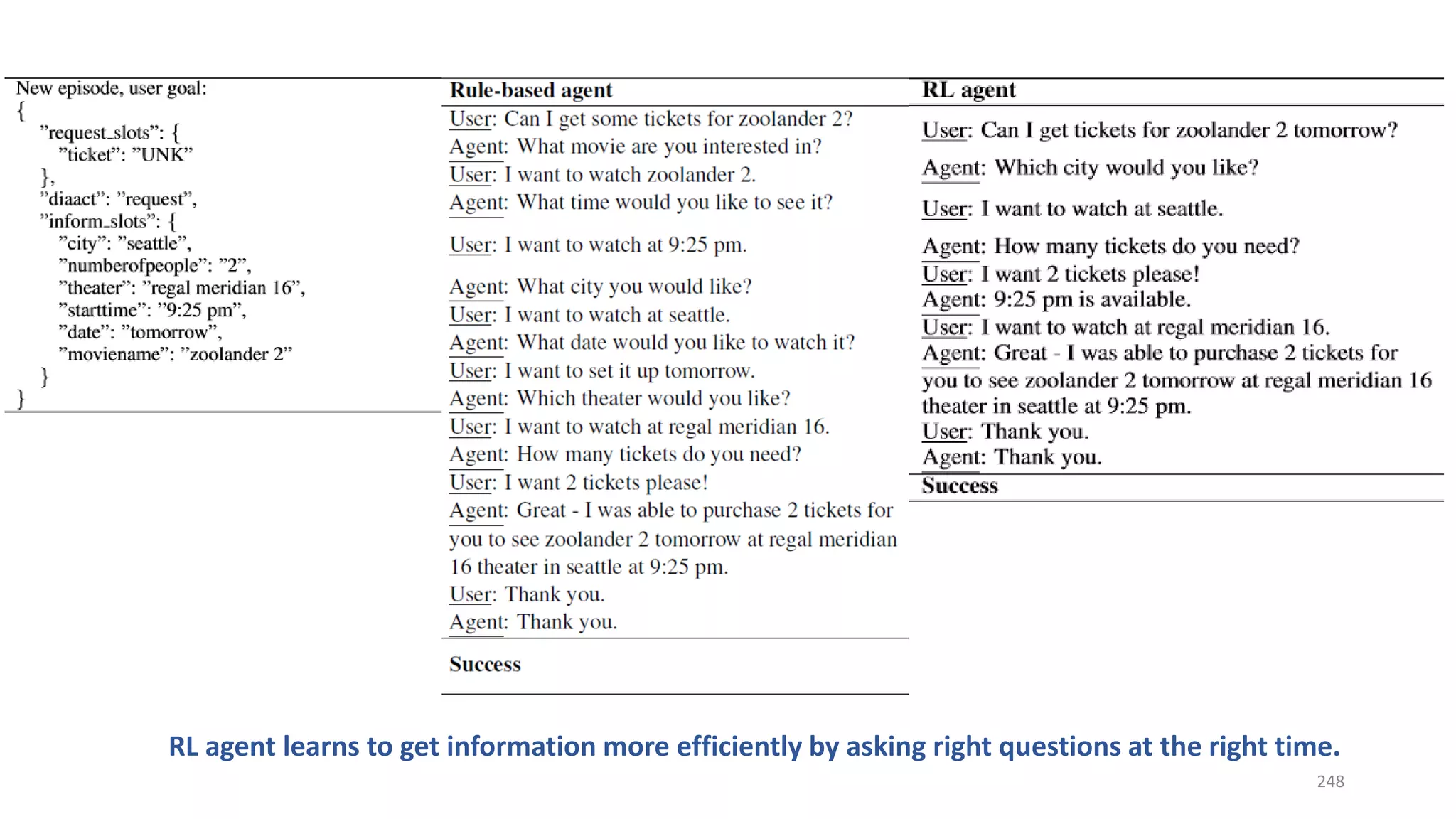
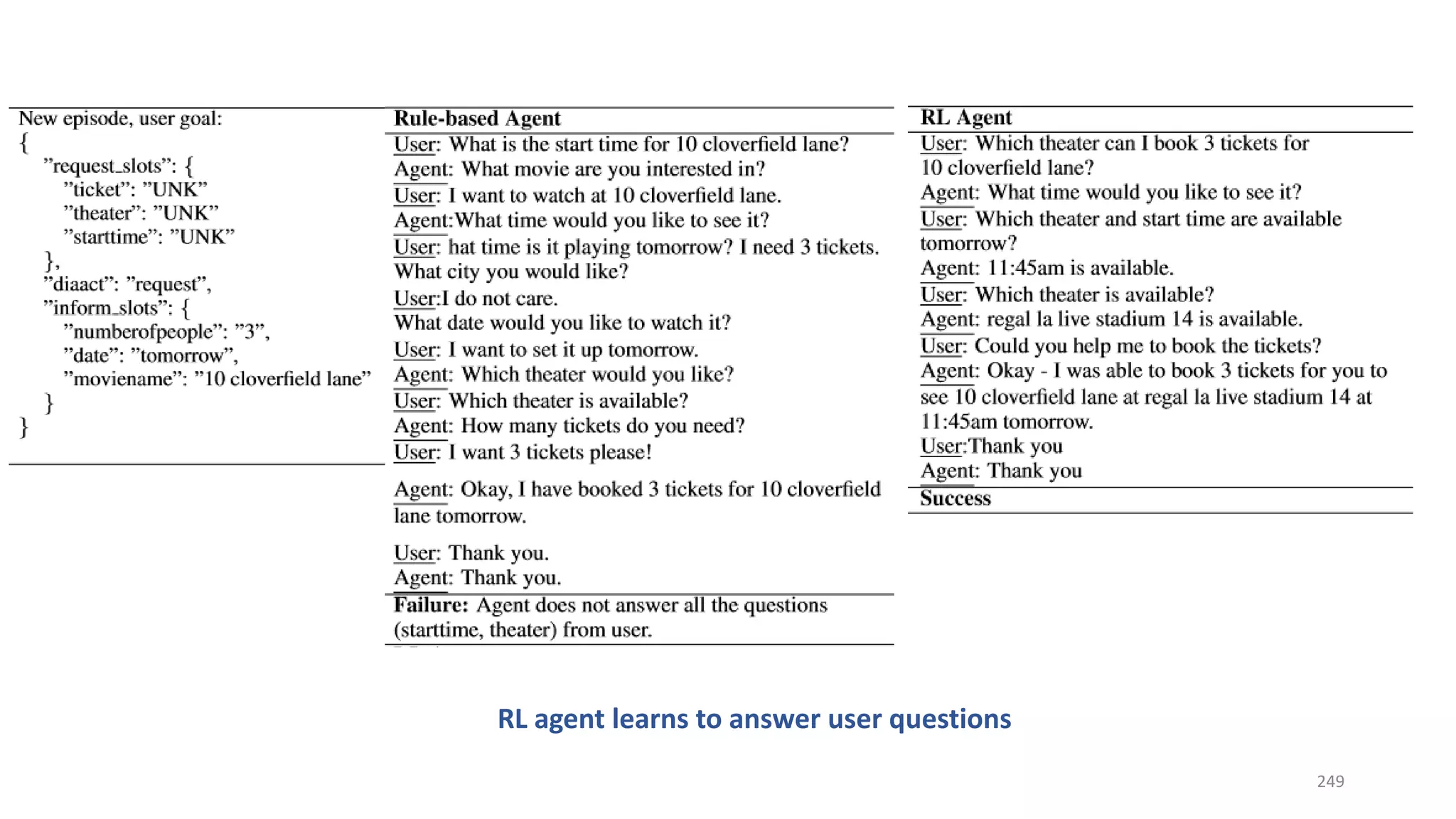
![Three case studies
• Info bot: end-to-end training with non-differentiable knowledge base
[Dhuwan+ 17]
• Task-completion bot: efficient exploration for domain extension
[Zachary+ 17]
• Composite task completion bot with Hierarchical RL [Peng+ 17]
250](https://image.slidesharecdn.com/mitqptdarkanz785ioot-signature-233d5c007282b08e62cf0f4d0a5dd88f5ed85398db05a93a193537bbc0db97b6-poli-190707174549/75/BIng-NLP-Expert-Dl-summer-school-2017-jianfeng-gao-v2-250-2048.jpg)

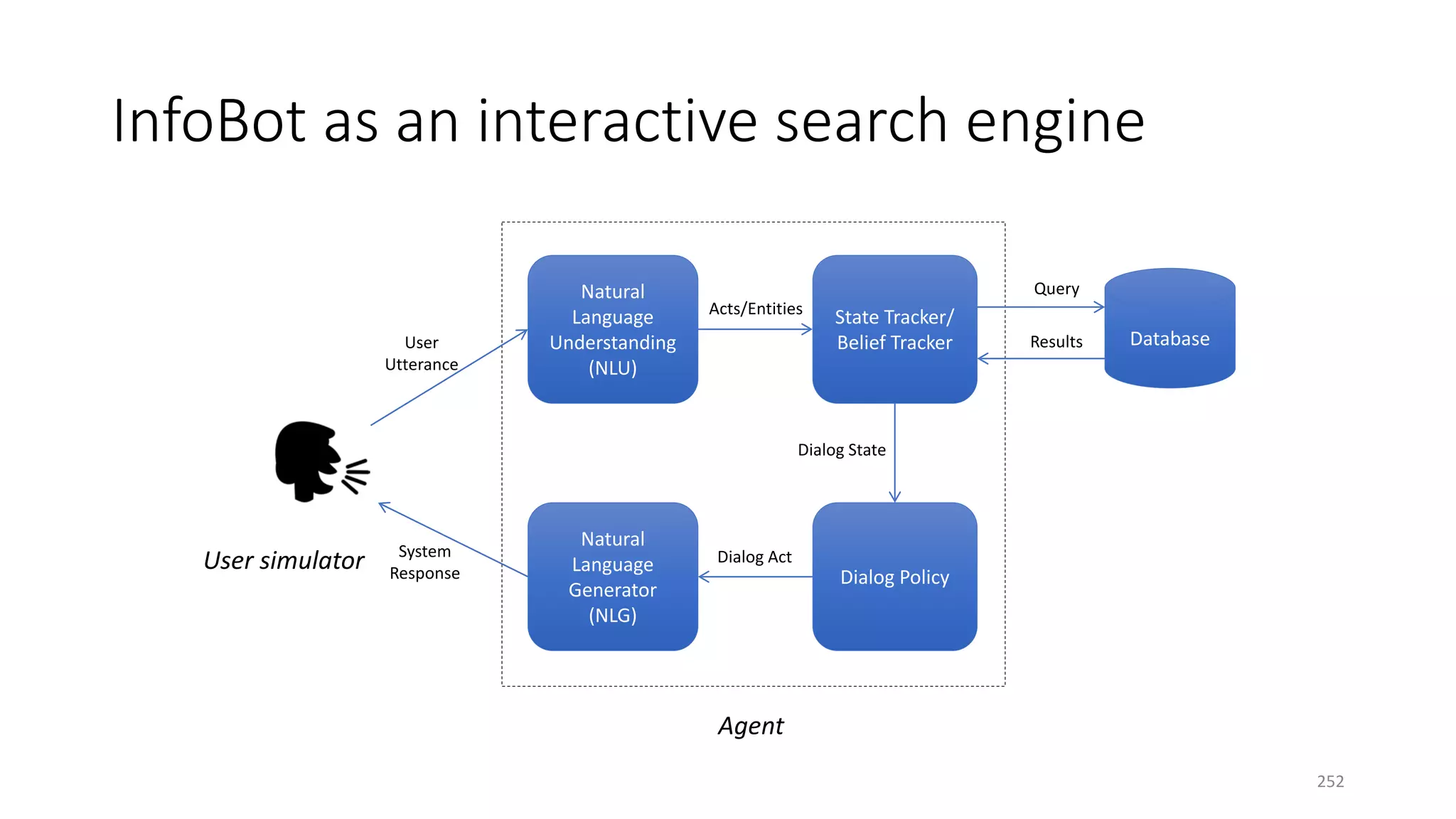
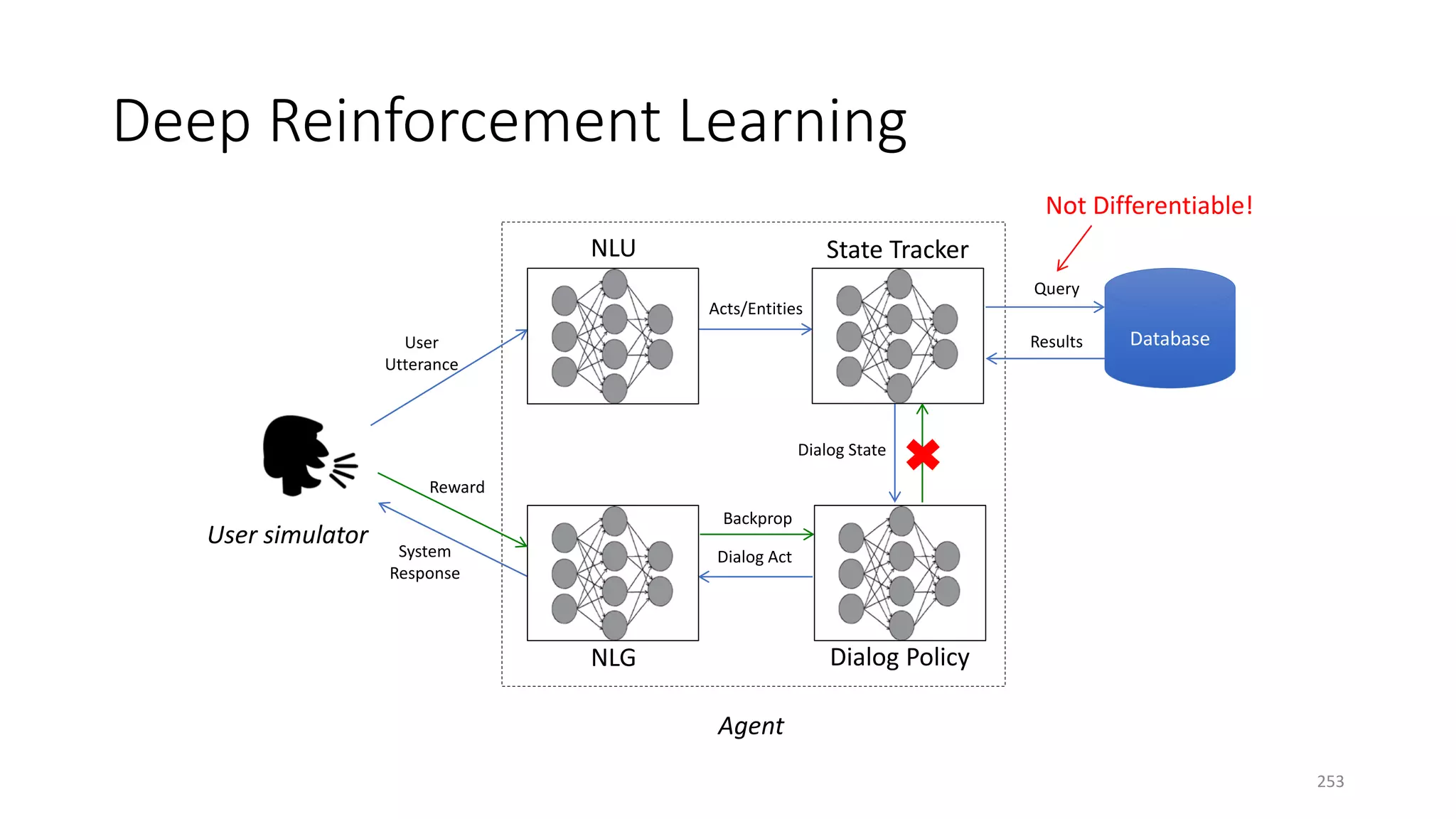
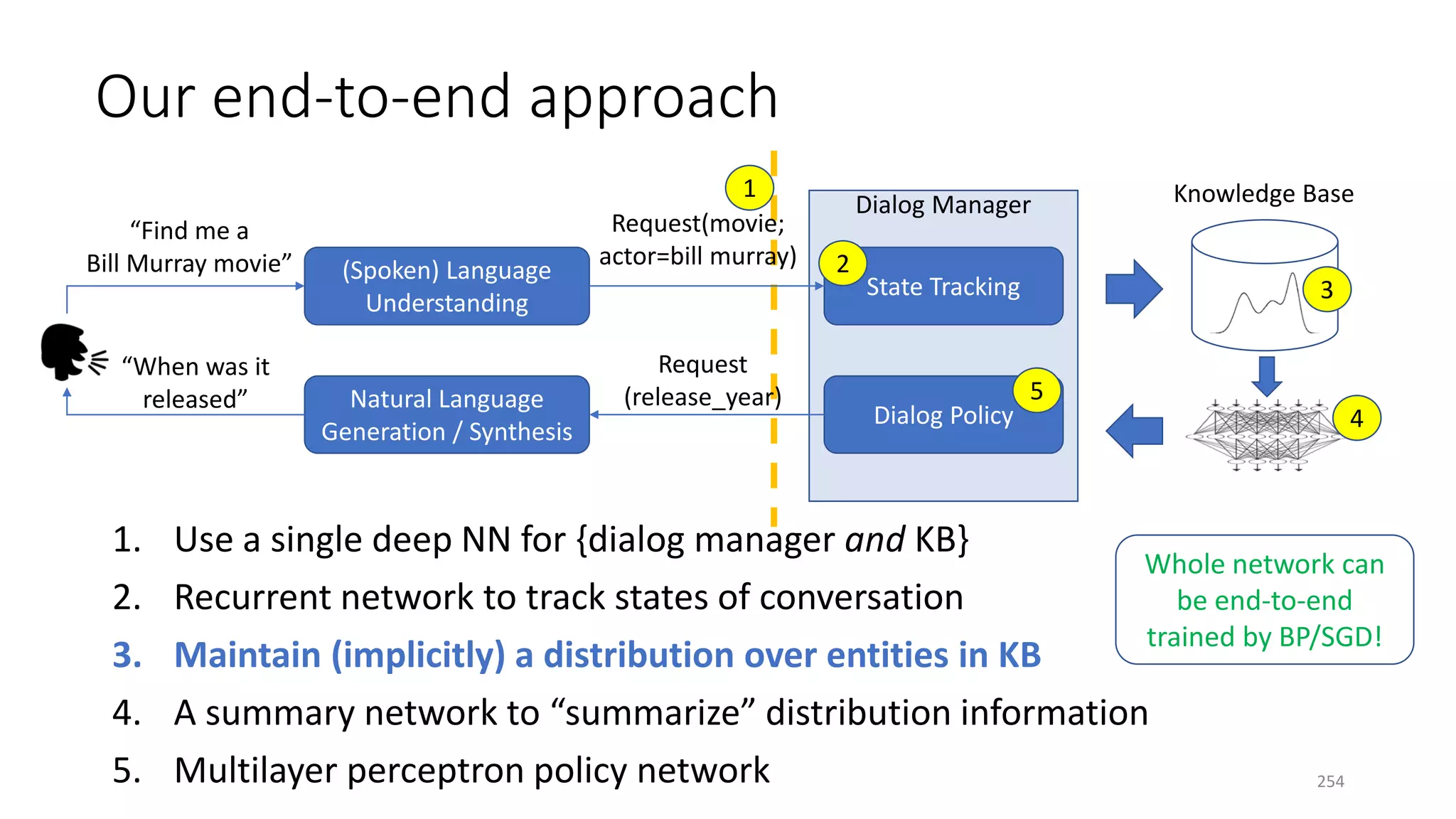
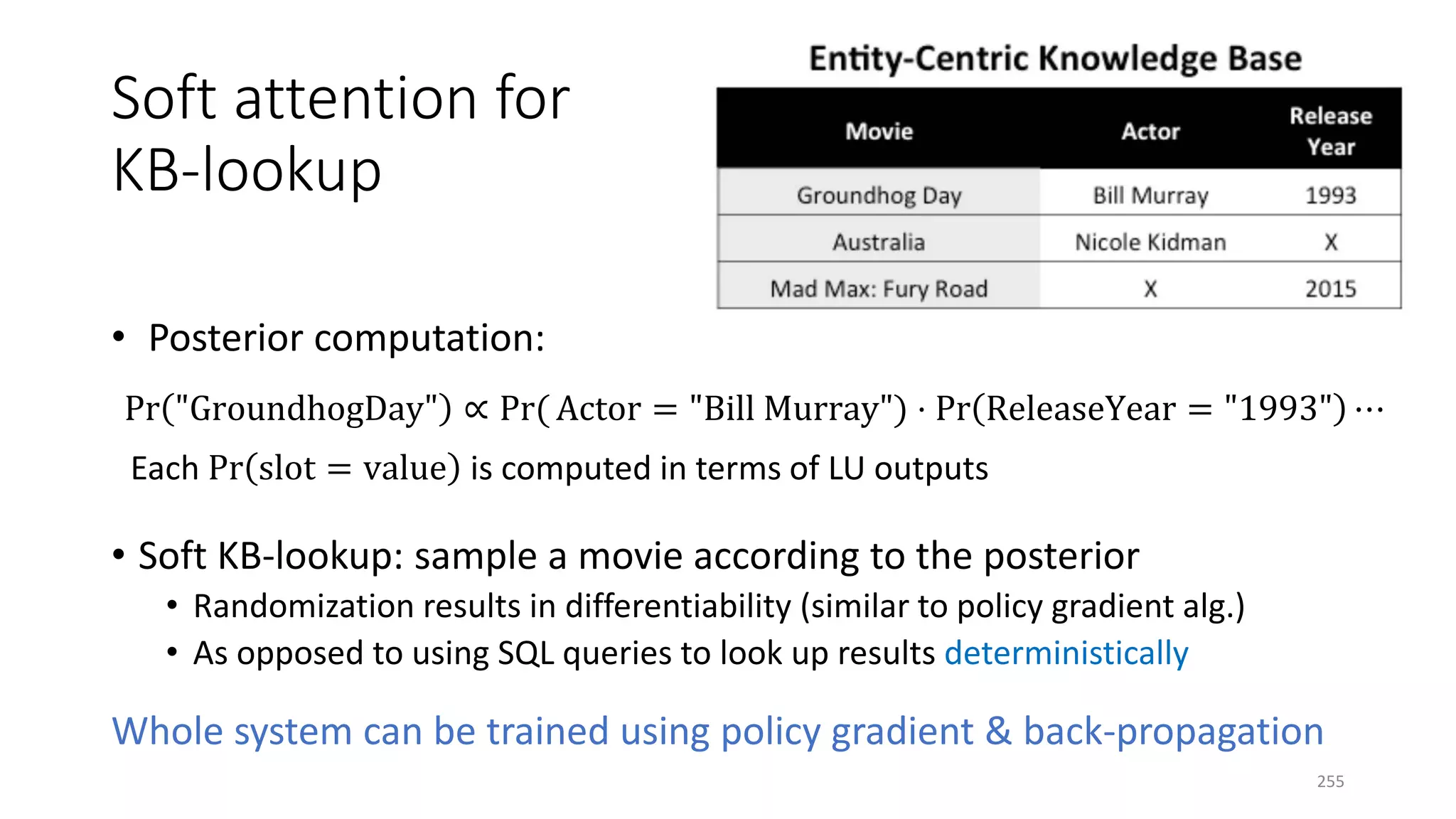
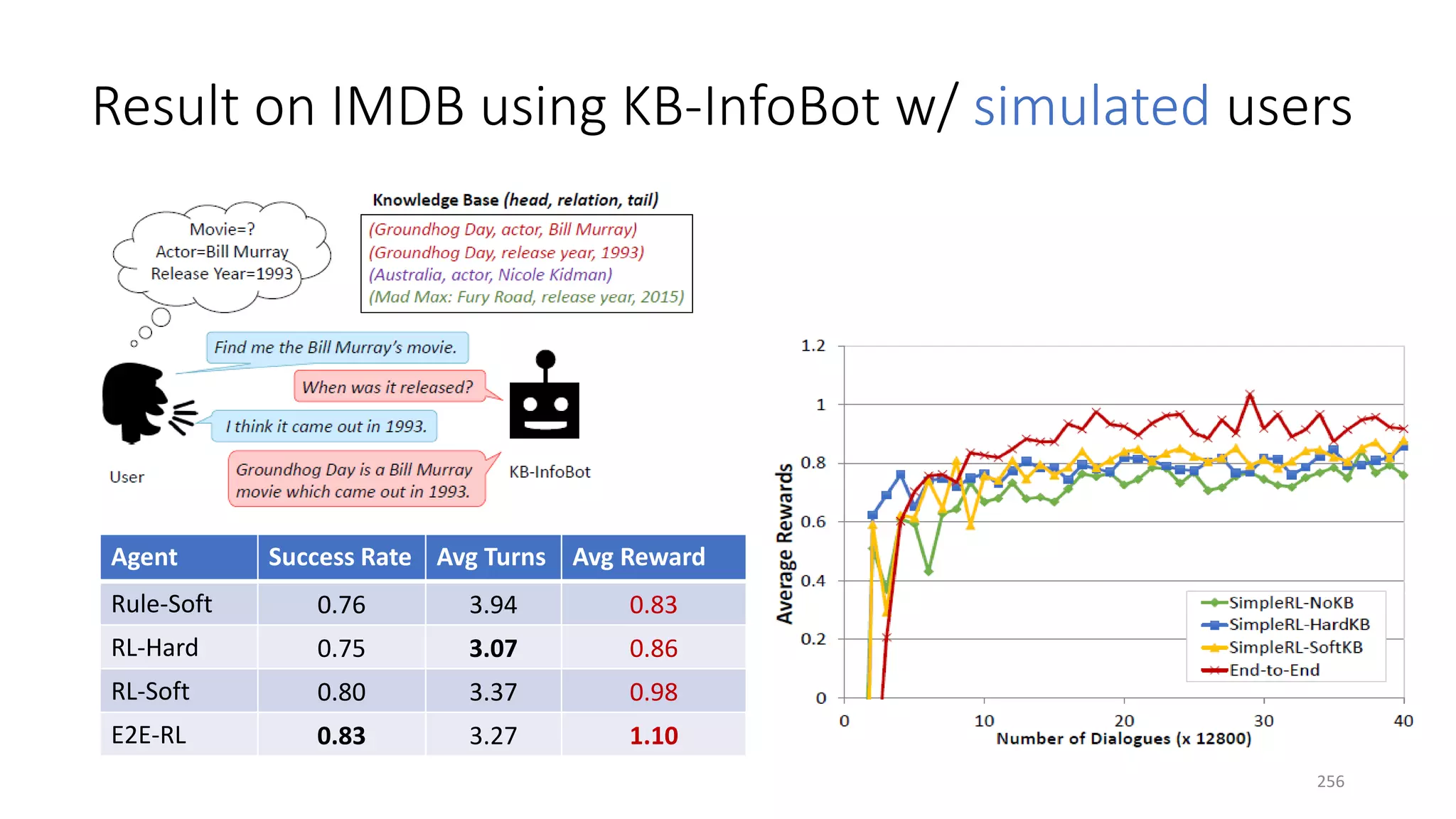

![Three case studies
• Info bots: end-to-end training with non-differentiable knowledge base
• Task-completion bots: efficient exploration for domain extension
[Zachary+ 17]
• Composite task completion bots with Hierarchical RL [Peng+ 17]
258](https://image.slidesharecdn.com/mitqptdarkanz785ioot-signature-233d5c007282b08e62cf0f4d0a5dd88f5ed85398db05a93a193537bbc0db97b6-poli-190707174549/75/BIng-NLP-Expert-Dl-summer-school-2017-jianfeng-gao-v2-258-2048.jpg)
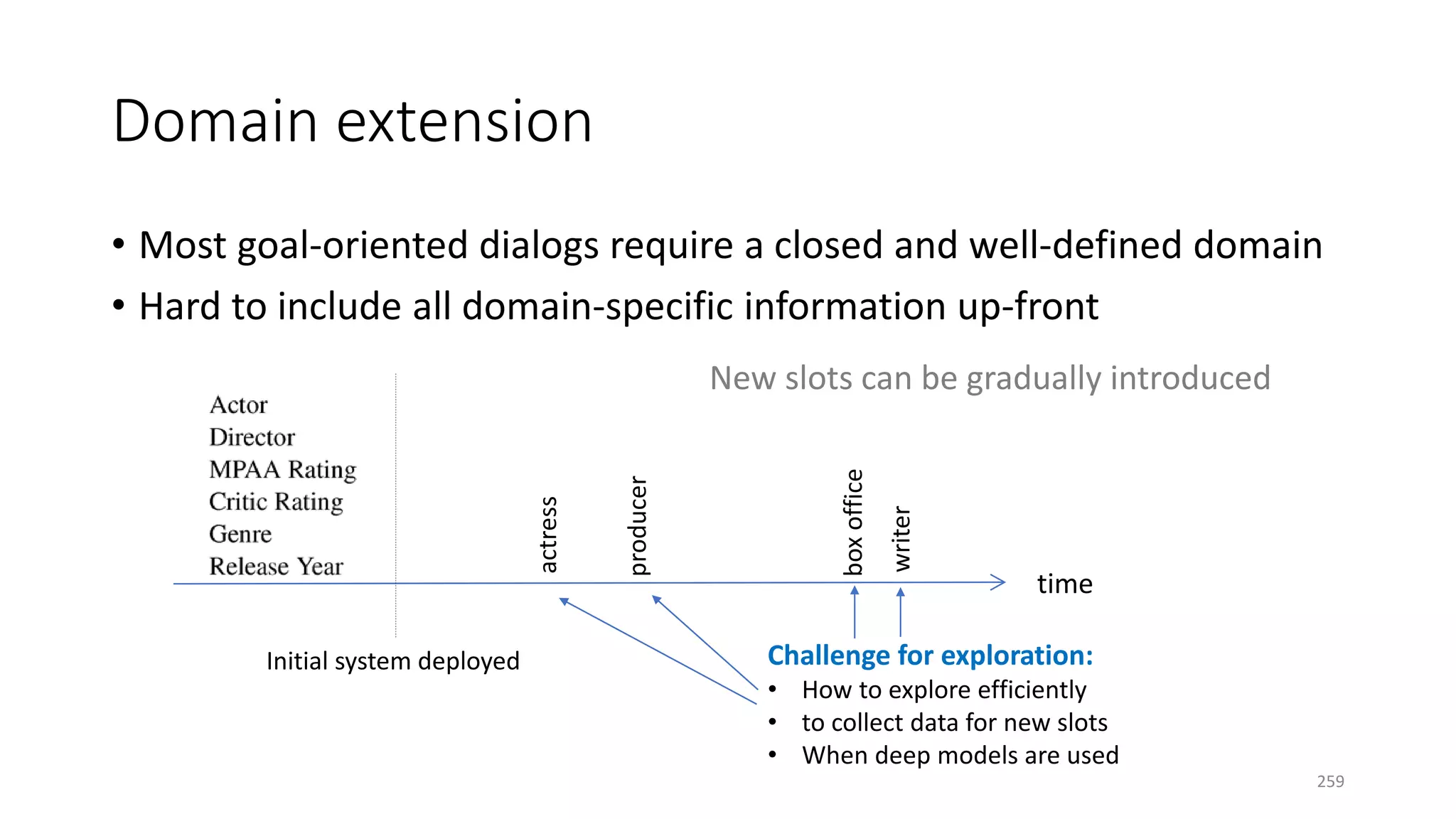

![Deep Bayes-by-Backprop Q Network
(Deep BBQ Networks)
• Construct a BBQN w. Gaussian variational dist. and Gaussian prior
• Explore by Thompson sampling, drawing Monte Carlo (MC) samples
from a stochastic neural net
• At train time draw one MC sample from BBQN and update by BP,
using the re-parameterization trick [Kingma & Welling 13]
261](https://image.slidesharecdn.com/mitqptdarkanz785ioot-signature-233d5c007282b08e62cf0f4d0a5dd88f5ed85398db05a93a193537bbc0db97b6-poli-190707174549/75/BIng-NLP-Expert-Dl-summer-school-2017-jianfeng-gao-v2-261-2048.jpg)
![Deep Q-network (DQN)
state
Q-values
[DeepMind 15]
DQN-learning of network weights 𝜃𝜃: apply SGD to solve
�𝜃𝜃 ← arg min
𝜃𝜃
�
𝑡𝑡
𝑟𝑟𝑡𝑡+1 + 𝛾𝛾 max
𝑎𝑎
𝑄𝑄𝑇𝑇 𝑠𝑠𝑡𝑡+1, 𝑎𝑎 − 𝑄𝑄𝐿𝐿 𝑠𝑠𝑡𝑡, 𝑎𝑎𝑡𝑡
2
“Target network” to
synthesize regression target
“Learning network” whose
weights are to be updated
262](https://image.slidesharecdn.com/mitqptdarkanz785ioot-signature-233d5c007282b08e62cf0f4d0a5dd88f5ed85398db05a93a193537bbc0db97b6-poli-190707174549/75/BIng-NLP-Expert-Dl-summer-school-2017-jianfeng-gao-v2-262-2048.jpg)
![Bayes-by-Backprop Q (BBQ) network
BBQ-learning of network params 𝜃𝜃 = 𝜇𝜇, 𝜎𝜎2 :
�𝜃𝜃 = arg min
𝜃𝜃𝐿𝐿
KL 𝑞𝑞 𝐰𝐰 𝜃𝜃𝐿𝐿 | 𝑝𝑝(𝐰𝐰|𝐷𝐷𝐷𝐷𝐷𝐷𝐷𝐷
state
Q-values
Still use “target network” 𝜃𝜃𝑇𝑇
to synthesize regression target
• Parameter learning: solve for ̂𝜃𝜃 with Bayes-
by-backprop [Blundell+ 15]
• Params 𝜃𝜃 quantifies uncertainty in Q-values
• Action selection: use Thompson sampling
for exploration
263](https://image.slidesharecdn.com/mitqptdarkanz785ioot-signature-233d5c007282b08e62cf0f4d0a5dd88f5ed85398db05a93a193537bbc0db97b6-poli-190707174549/75/BIng-NLP-Expert-Dl-summer-school-2017-jianfeng-gao-v2-263-2048.jpg)
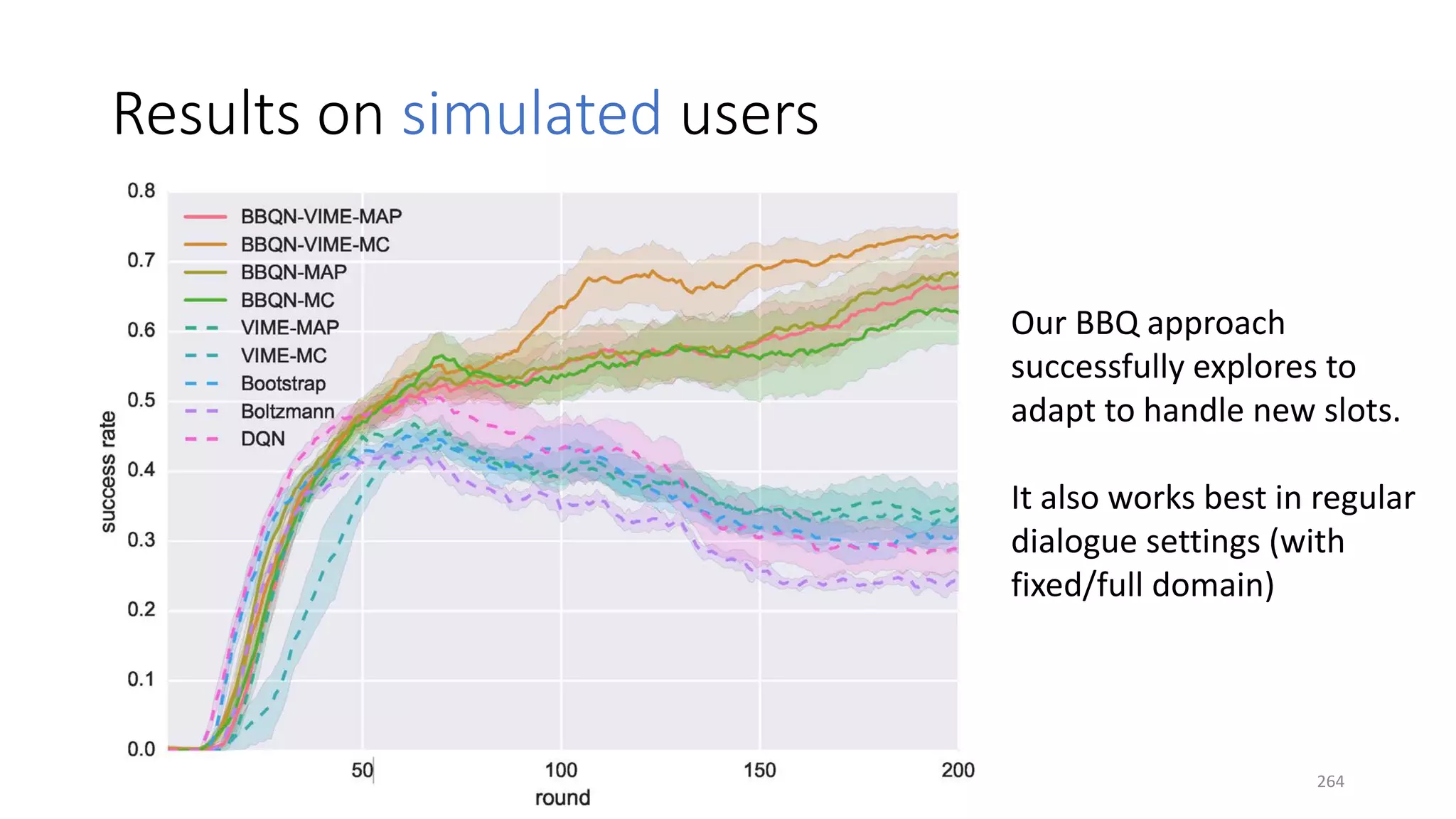
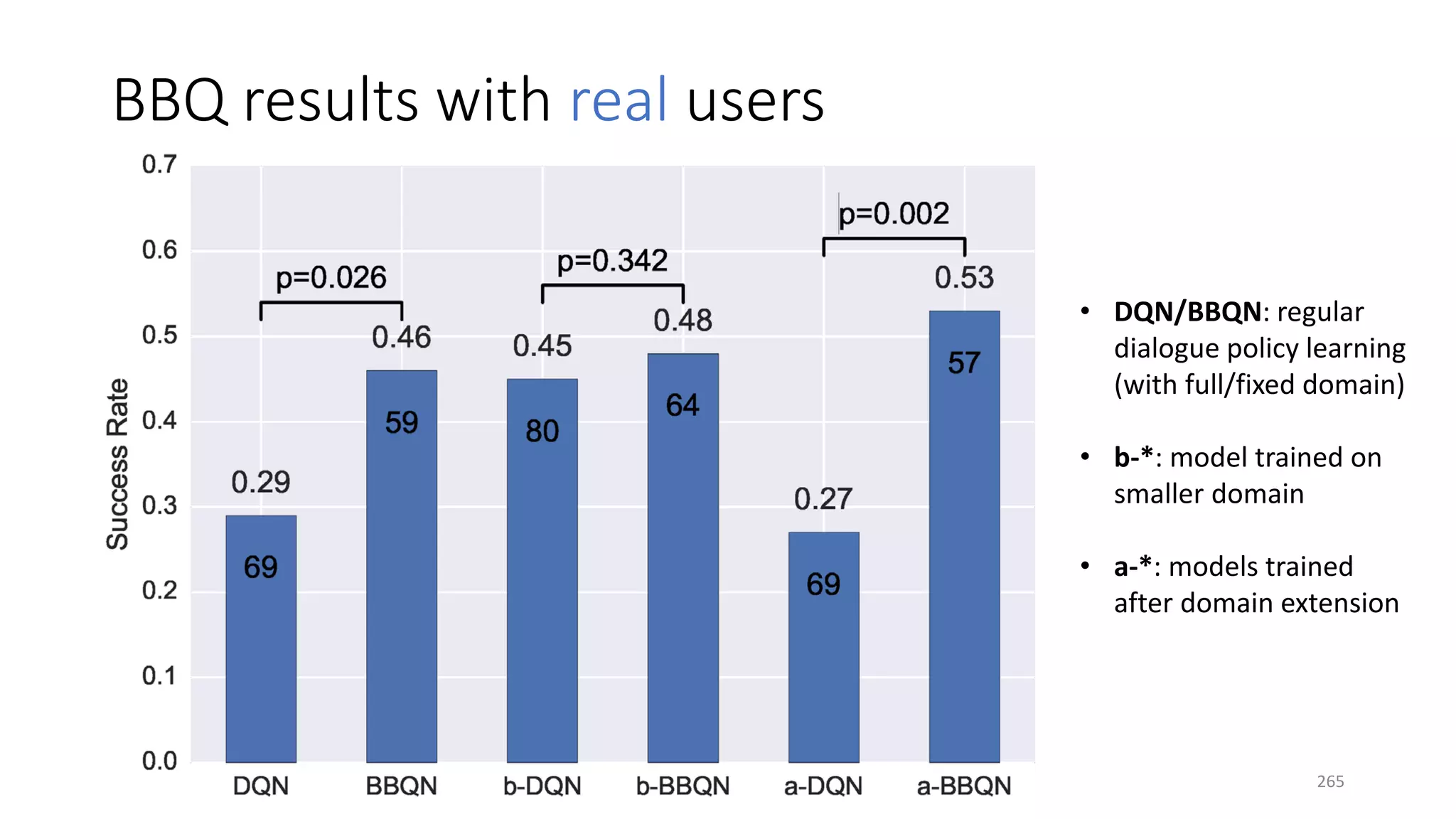
![Three case studies
• Info bots: end-to-end training with non-differentiable knowledge base
• Task-completion bots: efficient exploration for domain extension
• Composite task completion bots with Hierarchical RL [Peng+ 17]
266](https://image.slidesharecdn.com/mitqptdarkanz785ioot-signature-233d5c007282b08e62cf0f4d0a5dd88f5ed85398db05a93a193537bbc0db97b6-poli-190707174549/75/BIng-NLP-Expert-Dl-summer-school-2017-jianfeng-gao-v2-266-2048.jpg)
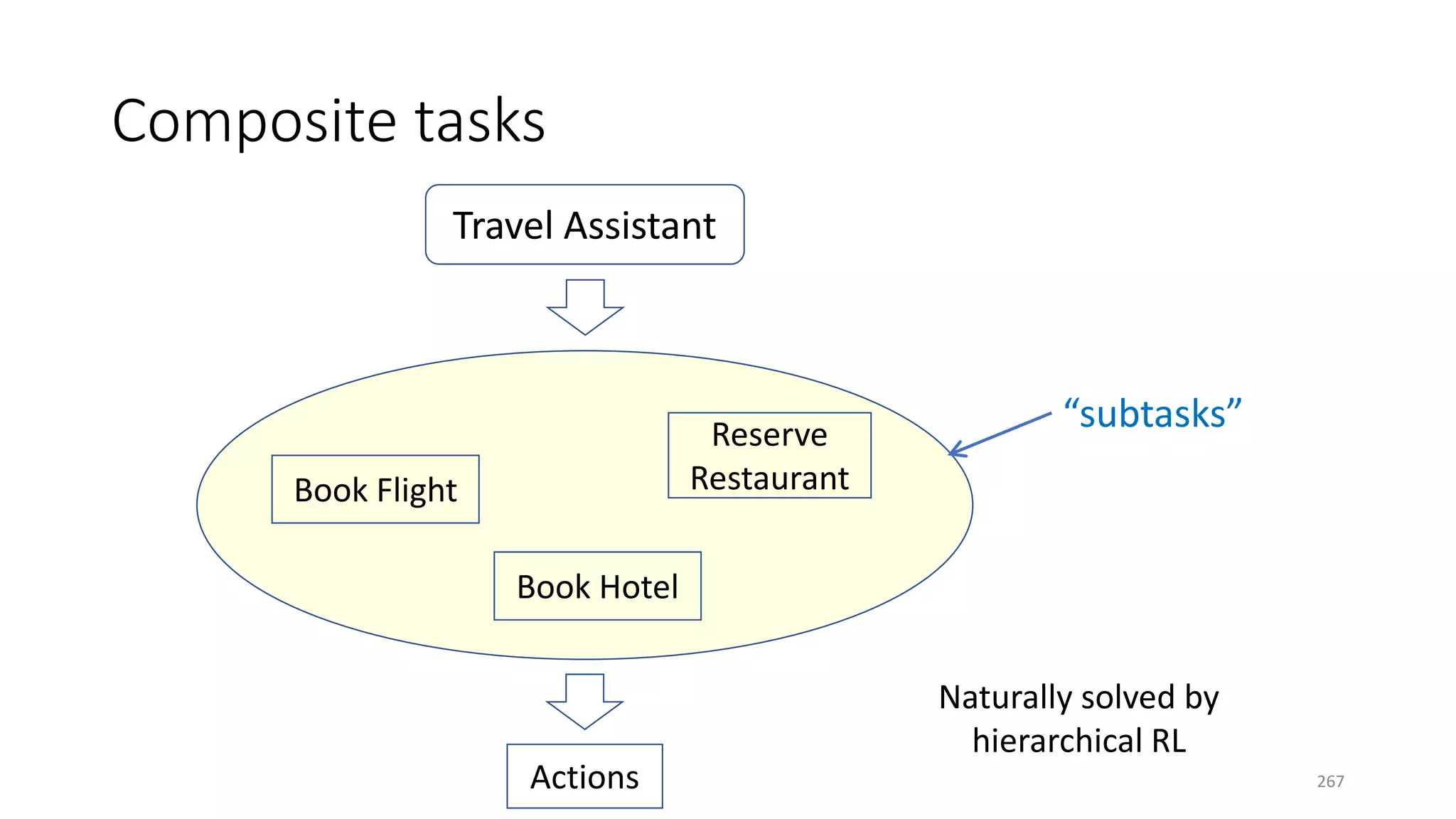
![A hierarchical policy learner
Similar to HAM [Parr & Russell 98] and hierarchical DQN [Kulkarni+ 16]
268](https://image.slidesharecdn.com/mitqptdarkanz785ioot-signature-233d5c007282b08e62cf0f4d0a5dd88f5ed85398db05a93a193537bbc0db97b6-poli-190707174549/75/BIng-NLP-Expert-Dl-summer-school-2017-jianfeng-gao-v2-268-2048.jpg)
